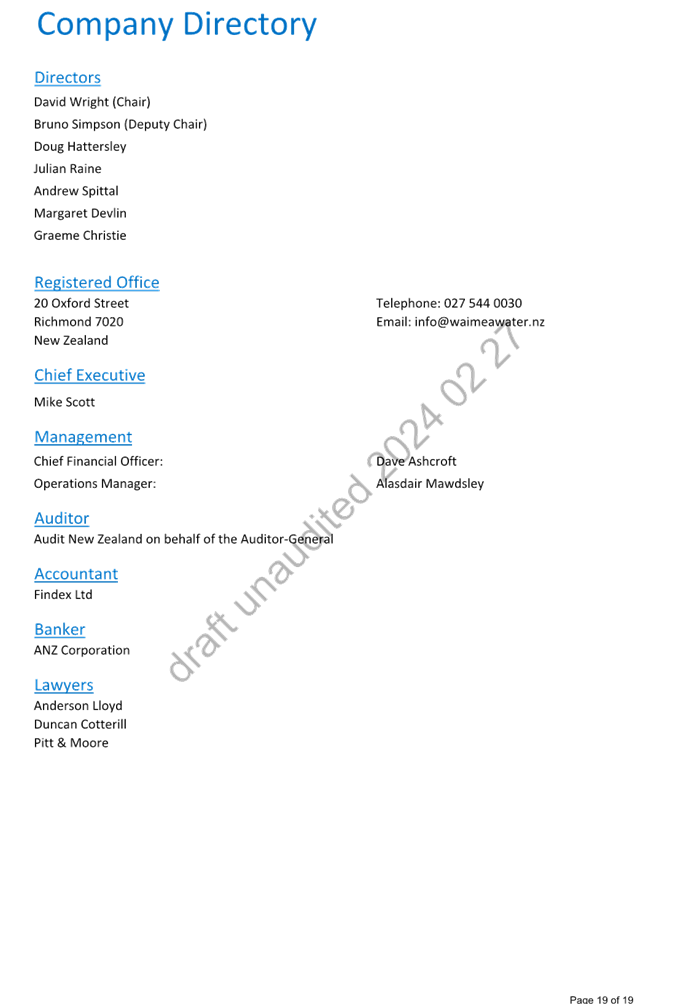Notice
is given that an ordinary meeting of the Tasman District Council will be held
on:
|
Date:
Time:
Meeting
Room:
Venue:
Zoom
conference link:
Meeting ID:
Meeting Passcode:
|
Thursday 28 March 2024
9:30 am
Tasman Council Chamber
189 Queen Street, Richmond
https://us02web.zoom.us/j/82606593992?
826 0659 3992
173320
|
|
Tasman
District Council
Kaunihera
Katoa
AGENDA
|
MEMBERSHIP
|
Mayor
|
Mayor T King
|
|
|
Deputy Mayor
|
Deputy Mayor S Bryant
|
|
|
Councillors
|
Councillor C Butler
|
Councillor M Kininmonth
|
|
|
Councillor G Daikee
|
Councillor C Mackenzie
|
|
|
Councillor B Dowler
|
Councillor K Maling
|
|
|
Councillor J Ellis
|
Councillor B Maru
|
|
|
Councillor M Greening
|
Councillor D Shallcrass
|
|
|
Councillor C Hill
|
Councillor T Walker
|
(Quorum 7 members)
|
|
|
Contact Telephone: 03 543 8400
Email: Robyn.Scherer@tasman.govt.nz
Website: www.tasman.govt.nz
|
Tasman District
Council
Agenda – 28 March 2024
AGENDA
1 Opening, Welcome, KARAKIA
2 Apologies
and Leave of Absence
|
Recommendation
That apologies be accepted.
|
3 Public
Forum
3.1 Welcoming Communities Advisory Group............................................................... 5
4 Declarations
of Interest
5 LATE
ITEMS
6 Confirmation
of minutes
|
That the minutes of
the Tasman District Council meeting held on Thursday,
15 February 2024, be confirmed as a true and correct record of the meeting.
|
|
That the confidential
minutes of the Tasman District Council meeting held on Thursday, 15 February
2024, be confirmed as a true and correct record of the meeting.
|
7 Reports
7.1 Waimea Water Limited Update................................................................................ 6
7.2 Waimea Water Limited - Half Year Report 31
December 2023.............................. 7
7.3 Waimea Water Ltd - Draft Statement of
Intent 2024/25........................................ 50
7.4 Referral from Motueka Community Board -
increase to eight-week Tasman Resource Management Plan rule for temporary
housing...................................................... 90
7.5 2023/24 Financial Year End Forecast................................................................... 98
7.6 Richmond Athletic Association Football Club
- Request for Funding................. 108
7.7 Coastal Erosion Protection Structures on
Council Reserve Land Policy........... 119
7.8 Coastal Protection Policy Confirmation............................................................... 215
7.9 Draft Policy for Consultation - Dangerous
Dams, Earthquake-prone
Dams and Flood-prone Dams............................................................................. 224
7.10 Delegations to the Chief Executive Officer and Staff.......................................... 242
7.11 Local Government Funding Agency - Draft Statement of
Intent 2024-2027...... 260
7.12 Local Government Funding Agency - Half Year Report 31
December 2023..... 282
7.13 Machinery Resolutions Report............................................................................ 307
7.14 Chief Executive's Report..................................................................................... 309
7.15 Mayor's Activity Update....................................................................................... 312
8 Confidential
Session
8.1 Procedural
motion to exclude the public............................................................. 339
8.2 Strategic Property Purchase for Reserve................................................................ 4
9 CLOSING
KARAKIA
Tasman District
Council
Agenda – 28 March 2024
3 Public
Forum
3.1
Welcoming
Communities Advisory Group
|
Report
To:
|
Tasman
District Council
|
|
Meeting
Date:
|
28
March 2024
|
|
Report
Author:
|
Elaine
Stephenson, Team Leader - Democracy Services
|
|
Report
Number:
|
RCN24-03-4
|
1. Public
Forum / Te Matapaki Tūmatanui
Sally Carlton, on behalf of Tasman District
Council Welcoming Communities Advisory Group, will speak in public forum
regarding Diversity in the Tasman region.
Nil
Tasman District
Council
Agenda – 28 March 2024
7 Reports
7.1
Waimea Water
Limited Update
|
Report
To:
|
Tasman
District Council
|
|
Meeting
Date:
|
28
March 2024
|
|
Report
Author:
|
Robyn
Scherer, Executive Assistant and Advisor to the Mayor
|
|
Report
Authorisers:
|
Leonie
Rae, Acting Chief Executive Officer
|
|
Report
Number:
|
RCN24-03-5
|
1. Presentation
/ Whakatakotoranga
Waimea Water Limited Board Chairman, David
Wright and Chief Executive Officer, Mike Scott will provide an update on the
Waimea Community Dam.
Nil
Tasman District
Council
Agenda – 28 March 2024
7.2 Waimea Water Limited - Half Year Report 31
December 2023
Information Only - No Decision
Required
|
Report
To:
|
Tasman
District Council
|
|
Meeting
Date:
|
28
March 2024
|
|
Report
Author:
|
Mike
Drummond, Group Manager - Finance
|
|
Report
Authorisers:
|
Leonie
Rae, Chief Executive Officer
|
|
Report
Number:
|
RCN24-03-6
|
1. Summary
/ Te Tuhinga Whakarāpoto
1.1 The
Waimea Water Ltd (WWL) Half Year Report ended 31 December 2023 to shareholders
was delivered on 27 February 2024. The Half Year Report is attached as Attachment
1.
1.1 The Half Year
Report has been published on Waimea Water Ltd’s website and is available
to the public.
1.2 Te Kurawai o Pūhanga (the dam)
construction progress is set out on Section 5 (page 9) and costs and risks in
Section 7 (page 18). The estimated cost to complete remains at $198.2 million
as was forecast in February 2023. As of 31 December 2023, the project
spend to date was $185.7 million.
1.3 The SOI notes that WWL was preparing for
dam operations in early 2024, following replacement of the temporary facilities
and commissioning of the permanent facilities. In the report, WWL updated that
estimate and noted that it was preparing for dam operations from March 2024,
following replacement of the temporary facilities and commissioning of the
permanent facilities for water discharges.
1.4 On Sunday, January 21, 2024, the dam
reached its full capacity, and the spillway started flowing. This was a
milestone event for the project.
1.5 Since the receipt of the report, the
company has commenced release of water from the dam to augment river flows.
This release has resulted in the removal of the water restrictions in place at
the time benefitting all water users.
1.6 The company will be attending this Council
meeting to present an update. It is recommended that the Council take advantage
of that opportunity to ask the company any questions they may have in relation
to this Half Yearly report.
1.7 There are no new matters reported that
staff need to bring to the Council’s attention.
2. Recommendation/s
/ Ngā Tūtohunga
That the
Tasman District Council
1. receives the Waimea Water Limited - Half Year Report 31 December
2023 report, RCN23-03-6; and
2. notes the
receipt of the Half Year Report for the period ended 31 December 2023 from
Waimea Water Ltd; and
3. notes the
Waimea Water Ltd Half Year Report (or a link to the report) will be published
on the Council’s website within seven (7) days of this meeting.
3.1 To
formally receive the Waimea Water Ltd Half Year Report for the period ended
31 December 2023.
4. Background and Discussion
4.1 The
Company is required under the terms of its Statement of Intent (and Section 66
of the Local Government Act 2002) to provide half year reports to shareholders.
These reports are also made available to the public via both the Council and
the Waimea Water Ltd websites.
4.2 The
report provides information regarding:
4.2.1 A commentary on the results for the period.
4.2.2 Health, safety and wellbeing;
4.2.3 Update on construction progress;
4.2.4 Update on operational readiness;
4.2.5 Update on the project performance;
4.2.6 Update on expected cost and risk;
4.2.7 Statement of comprehensive revenue and expense,
disclosing actual and comparative figures;
4.2.8 Statement of financial position at the end of the
period; and
4.2.9 Statement of cashflows.
4.3 The dam construction progress
is set out on Section 5 (page 9) and costs and risks in Section 7 (page 18).
The estimated cost to complete remains at $198.2 million as forecast in
February 2023. At December 2023, the spend to date was $185.7 million.
4.3.1 Under the SOI, WWL was preparing for dam operations in
early 2024, following replacement of the temporary facilities and commissioning
of the permanent facilities. The report notes that WWL had updated that
estimate and was prepared for dam operations from March 2024, following
replacement of the temporary facilities and commissioning of the permanent
facilities.
4.4 The
report identified the key significant residual risks. Shareholders have a
particular interest in these risks which due to their nature do not have a
monetary estimate. These are:
· Commercial
risks associated with an unexpected outcome from the Contractor-initiated
arbitration and adjudication that differs from the decisions of both the
engineer and adjudication. WWL continues to prepare for both arbitration and
adjudication.
· Greater
embankment settlement than expected could put the dam face mechanical systems
out of alignment. Greater seepage than expected may also require post
construction intervention. In such eventualities, WWL would plan to lower the
dam in the winter 2024 to address any issues. To date, engineering analysis and
verification at the hold points has not indicated any significant issues.
5. December Company update to the Council
5.1 The
Company has provided the required half year update. The information in the
update is in line with the presentation made to the Council 13 December
2023.
6.1 Staff
will provide a link to the report on the Council’s website within seven
days of this meeting.
|
1.⇩
|
Waimea
Water Limited - Half Year Report ended 31 December 2023
|
10
|
Tasman District
Council
Agenda – 28 March 2024


































Tasman District Council Agenda – 28 March 2024
7.3 Waimea Water Ltd - Draft Statement of Intent 2024/25
Decision Required
|
Report
To:
|
Tasman
District Council
|
|
Meeting
Date:
|
28
March 2024
|
|
Report
Author:
|
Mike
Drummond, Group Manager - Finance
|
|
Report
Authorisers:
|
Leonie
Rae, Acting Chief Executive Officer
|
|
Report
Number:
|
RCN24-03-7
|
1. Purpose
of the Report / Te Take mō te Pūrongo
1.1 To
present to the Council the Waimea Water Ltd (WWL) draft Statement of Intent
2024-2025 and to provide shareholder comment (if any) on the draft SOI to the
Company.
2. Summary
/ Te Tuhinga Whakarāpoto
2.1 The
Waimea Water Ltd initial draft Statement of Intent was provided to shareholders
on
27 February 2024 (Attachment 1).
2.2 The
statement of Intent is a shareholder matter that requires agreement between
both Tasman District Council and Waimea Irrigators Ltd as shareholders. The
draft Statement of Intent (SOI) remains sensitive while the Council undertakes
any negotiations with Waimea Irrigators Ltd (WIL) and ultimately with Waimea
Water Ltd (WWL) in the case any material changes are requested either by the
Council or by WIL.
2.3 The
SOI has been reviewed by staff for compliance with the Local Government Act
(LGA).
2.4 The Council takes the lead on
responding to the draft SOI. Feedback to the company on the draft SOI is
required from both shareholders as this is a shareholder matter. Staff have
approached the Board of Waimea Irrigators Ltd to confirm it has considered the
draft SOI and has obtained the following feedback “WIL are comfortable
with the draft SOI and would encourage the re-evaluation of retrofitting hydro
generation capability to the Dam.”
2.5 If
the Council wishes to make material changes to the draft SOI that will require
negotiations with WIL and WWL. For any discussion of these material changes and
the Council’s negotiating position, the meeting should move into a public
excluded session.
2.6 Following
the staff review of the draft SOI there are no specific matters outside of the
forecast increase in water charges that staff need to bring to the
Council’s attention. The estimated cost to complete the project has not
changed from the $198.2 million previously. The company has provided draft
financial estimates as of February 2024. These estimates will be updated for
the final SOI. These estimates include increases in the operating and financing
costs consistent with the current business environment. The Council’s
share of financing and operating costs is forecast to be c$3,429,000 for the
2024/25 year. This is an increase of $502,000 on the $2,927,000 forecast for
2024/25 in last year’s SOI.
2.7 The
SOI assumes that there will be no change to the company ownership structure
arising from the Local Water Done Well reforms. This is the correct approach
given the uncertainty surrounding the reforms and if the Council’s
interest, rights, and responsibilities will transfer and, if so, in what form
to a Water Services CCO.
2.8 Waimea
Water Ltd staff will attend the meeting to present their regular update. This
is the opportunity for the Council to engage the company over any matters or
ask any questions on the draft SOI.
2.9 It
is recommended that the Council consider the draft SOI as a whole and provide
commentary (if any) to WWL for consideration in its drafting the final
2024-2025 SOI.
3. Recommendation/s
/ Ngā Tūtohunga
That the Tasman
District Council
1. receives
the Waimea Water Ltd - Draft Statement of Intent 2024/25 report, RCN24-03-7;
and
2. notes
that the final 2024-34 Long Term Plan will be updated to reflect the increased
Council water charges (financing and operating costs) from Waimea Water Ltd;
and
3. provides the following comments and feedback to the
Waimea Water Ltd Board –
3.1 that the Statement of Intent (Attachment 1 to the
agenda report) meets Tasman District Council’s shareholder expectations;
or
3.2 requests
the Board considers the following matters before providing shareholders with
the final Statement of Intent;
… (to be determined at the meeting)
4.1 Waimea
Water Ltd (WWL), along with other Council Controlled Organisations (CCOs), is
required to complete an SOI by 30 June each year. The draft SOIs are required
to be delivered to shareholders by 1 March each year. The WWL draft SOI was
received by the Council within the statutory timeframe. This draft SOI covers
the period from 1 July 2024 to 30 June 2025. It also includes prospective
financial information for the three years out to June 2027.
4.2 Shareholders
issued a Statement of Expectation (SoE) to the company in December 2023.
(Attachment 2) The SoE sets out the shareholders expectation on the
matters to be included in the draft SOI. The general matters in the SoE are
consistent across all the Councils CCO’s. The draft SOI addresses the
matters raised in the SoE.
4.3 The
purpose of an SOI is set out in the Local Government Act 2002 Schedule 8. This
purpose is repeated here as a background for the Council’s discussion on
the draft SOI presented by WWL.
Purpose of statement of intent
4.4 The
purpose of the Statement of Intent is to:
(a) state publicly the
activities and intentions of a council-controlled organisation for the year and
the objectives to which those activities will contribute; and
(b) provide an
opportunity for shareholders to influence the direction of the organisation;
and
(c) provide a basis for
the accountability of the directors to their shareholders for the performance
of the organisation.
4.5 The
SOI has been checked for compliance with the statutory requirements and there
are no matters to bring to the Council’s attention.
4.6 The
company will continue to provide quarterly, mid-year and annual results on the
same timeline as in the past.
5. Analysis
and Advice / Tātaritanga me ngā tohutohu
5.1 Prior
to the commencement of the period covered by this SOI the construction of the
project will be completed and the with dam provisions in the TRMP will be in
force. The contractor will still be in the defects period where they are
responsible for necessary repairs related to teething issues.
5.2 WWL
will during the first year continue to develop and implement is operating
systems and processes. It is expected that these processes will evolve
over time.
5.3 While
the draft SOI includes estimates for operating costs post dam completion, these
matters are still being finalised between the company and its shareholders, due
to 2024/25 being a final transitional year. This is a shareholder reserved
matter requiring a shareholder resolution supported by both Waimea Irrigators
Ltd (WIL) and the Council. These matters are expected to be settled by 30 June
2024.
5.4 Waimea
Water Ltd have advised that the proposed operating costs will evolve before
they submit their final SOI as they procure operating services and insurances.
Also, the financing costs will also evolve before they submit their final SOI
as they agree the new terms and lock in the refinanced shareholder advance loan
rates.
5.5 Operating costs and
project costs are defined within the project funding agreements. The two biggest operational items are Council rates and
Insurance.
5.6 The
Council is undertaking its three yearly rating re-valuations. These are
undertaken by Quotable Value (QV) and audited by the Office of the
Valuer-General (OVG). The valuations will be as of September 2023. The updated
valuations will be issued late March 2024 and will establish the updated rating
valuation for the dam. The new valuation will impact rates from the 2024/25
rating year which commences on 1 July 2024.
5.7 As
with the Council, the company has seen a dramatic increase in its insurance
costs. The company is undertaking a risk and insurance strategy to understand
options around risk and insurance mitigation. In the draft SOI it has reduced
its estimated insurance costs by $329,000 on the 2025 estimate in last
year’s SOI. To meet this reduction, it is likely that shareholders will
be asked to approve a reduced insurance cover.
5.8 The
company operates on a cost recovery basis. The company recovers its financing
costs and operating costs through the water charges to the Council and Waimea
Irrigators Ltd. Waimea Irrigators will be using the $3 million
shareholder advance facility C to smooth their water charges.
5.9 The
forecast finance and operating costs have increased 14.3% from previous
estimates. This increase sees the Council’s share of financing and
operating costs increase to c$3,429,000 for the 2024/25 year. This is an
increase of $502,000 on the $2,927,000 forecast for 2024/25 in last
year’s final SOI.
5.10 There
are increases in operating costs across most categories compared to last
year’s SOI estimates including a significant increase in the cost of dam
operations. A direct analysis is difficult due to changes in the overview
provided and the classification of expenses.
5.11 These
updated estimates of WWL water charges (financing and operating costs) detailed
in the draft SOI will be incorporated in to the final 2024-34 Long Term Plan.
5.12 Waimea
Irrigators Ltd, as the other shareholder, have been approached for any feedback
or comments on the draft SOI. The company has advised that the draft SOI has
been briefly reviewed and “WIL are comfortable with the draft SOI and
would encourage the re-evaluation of retrofitting hydro generation capability
to the Dam.”
5.13 While the further increase in WWL water charges
over last year’s forecast for 2024/25 is challenging, the Council has a
limited ability to influence those charges. It is recommended that the draft
SOI be accepted.
6.1 The options are outlined in the
following table:
|
Option
|
Advantage
|
Disadvantage
|
|
1.
|
Option 1 -
To formally refer the SOI back to the WWL Board with comments on the areas of
the SOI that need attention prior to reconsideration of the final SOI by the
shareholders.
|
Allows shareholder concerns in relation to the SOI to be
considered by the WWL Board.
|
None
|
|
2.
|
Option 2
– to accept the draft SOI and advise the company that the Council has
no specific changes it wishes them to consider in drafting the final SOI.
|
If there are no material changes required, this is the
appropriate response.
|
If there are material shareholder concerns, then this does
not allow for those concerns in relation to the SOI to be considered by the
WWL Board.
|
6.2 Option 2 is recommended.
7.1 A
Council Controlled Organisation (CCO) must have an SOI that complies with
clauses 7 to 10 of schedule 8 of the Local Government Act 2002 (LGA).
7.2 The
principal objective of a CCO is set out in Section 59 (1) of the LGA.
7.3 SOIs
must not be inconsistent with the CCO’s Constitution.
7.4 Draft
SOIs must be delivered to the Council on or before 1 March each year.
Shareholders may extend the deadline for a period or periods not exceeding one
calendar month.
7.5 The
LGA Schedule 8(2) requires the Board to consider any comments on the draft SOI
that are made to it by the first of May and deliver a completed SOI to
Shareholders on or before 30 June each year.
7.6 Section
65 (2) of the LGA requires the Council, as soon as practicable after receiving
a statement of intent for a CCO, to agree to the SOI or, if it does not agree,
to take all practicable steps under clause 6 of schedule 8 of the LGA to
require the SOI to be modified.
7.7 If
an agreement with the Board of WWL on the SOI is not reached, the shareholders
will need to consider imposing a modification of the SOI by resolution of the
shareholders using their powers under the LGA schedule 8 (6). This would be a
last resort approach as it would signal a breakdown in the relationship between
the shareholders and the WWL Board.
8. Iwi
Engagement / Whakawhitiwhiti ā-Hapori Māori
8.1 No engagement with wider iwi has taken
place on this routine matter. However, Ngāti Koata are involved in the SOI
process by virtue of their seat on the Waimea Water Ltd Board.
9. Significance
and Engagement / Hiranga me te Whakawhitiwhiti ā-Hapori Whānui
9.1 The
adoption of the SOI for Waimea Water Ltd is considered of low significance to
ratepayers. The SOI is consistent with arrangements entered into at financial
close in December 2018. The project and the formation of WWL have been
consulted on through formal engagement and consultation processes. The Council
has been updated on the progress of the project at this Council meeting. The
public has also been provided with an update on the project through the
presentation to the Council and the issue of the company’s mid-year
report. Further engagement, other than with WIL, on the draft SOI is not
required.
|
|
Issue
|
Level of
Significance
|
Explanation of
Assessment
|
|
1.
|
Is there a high level
of public interest, or is decision likely to be controversial?
|
Low
|
The project is of a
moderate to high public interest, but the completion of the SOI is largely an
administrative matter.
|
|
2.
|
Are there impacts on
the social, economic, environmental or cultural aspects of well-being of the
community in the present or future?
|
No
|
|
|
3.
|
Is there a
significant impact arising from duration of the effects from the decision?
|
No
|
|
|
4.
|
Does the decision
relate to a strategic asset? (refer Significance and Engagement Policy for
list of strategic assets)
|
Yes, the investment
in the Waimea Community Dam.
|
|
|
5.
|
Does the decision
create a substantial change in the level of service provided by Council?
|
No
|
|
|
6.
|
Does the proposal,
activity or decision substantially affect debt, rates or Council finances in
any one year or more of the LTP?
|
No
|
|
|
7.
|
Does the decision
involve the sale of a substantial proportion or controlling interest in a CCO
or CCTO?
|
No
|
|
|
8.
|
Does the
proposal or decision involve entry into a private sector partnership or
contract to carry out the deliver on any Council group of activities?
|
No
|
|
|
9.
|
Does the proposal or
decision involve Council exiting from or entering into a group of
activities?
|
No
|
|
|
10.
|
Does the proposal
require particular consideration of the obligations of Te Mana O Te Wai
(TMOTW) relating to freshwater and Affordable Waters services?
|
No
|
|
10. Communication
/ Whakawhitiwhiti Kōrero
10.1 Following feedback to WWL and WIL, the draft SOI
will be made available on the Council’s website. This decision is
considered routine and of low public interest.
11. Financial
or Budgetary Implications / Ngā Ritenga ā-Pūtea
11.1 There
are no financial or budgetary implications arising from this decision.
11.2 Any
changes to projected operating costs (from previous estimates) have not been
provided for in the draft LTP 2024-2034. These will be updated in the final
Long Term Plan 2024-34 prior to adoption by the Council.
11.3 The
costs of the review of the draft SOI and engagement with WWL and WIL are met
from within the Finance Group’s existing budgets.
12.1 There
is no identified change in risks associated with the WWL operations and this
draft SOI.
12.2 The
company will provide a six-monthly update presentation at today’s Council
meeting. This will cover financial, administration and project activity, and
provide an opportunity to cover off the issues arising with the construction
project and the transition into operations. In addition, the briefing will also
cover the revised estimate of the cost to complete the project and the
completion and commissioning dates.
12.3 There
is a risk that the relationship between the shareholders and WWL could be
significantly damaged if there is a failure of WWL and both shareholders to
agree on the 2024-2025 SOI.
12.4 As
WWL is a joint venture partnership with WIL, the Council will need to consider
the views and preferences of WIL in providing feedback to the company.
13. Climate
Change Considerations / Whakaaro
Whakaaweawe Āhuarangi
13.1 There are no climate change considerations relevant
to this decision.
14. Alignment
with Policy and Strategic Plans / Te Hangai ki ngā aupapa Here me ngā
Mahere Rautaki Tūraru
14.1 Decisions on CCO Statements of Intent are a Council
matter.
15. Conclusion
/ Kupu Whakatepe
15.1 The
draft WWL SOI was received in accordance with the statutory timeframe. The
draft SOI meets statutory requirements. The Council should turn its mind to the
matters included in the SOI and determine what, if any, comment needs to be
provided to the WWL and the WIL Boards.
16. Next
Steps and Timeline / Ngā Mahi Whai Ake
16.1 Staff
will communicate the Council’s decision and comments to Waimea Irrigators
Limited and to the Waimea Water Ltd Board.
16.2 A
link to the draft SOI will be placed on the Council’s website within
seven days.
16.3 On
receipt of a revised (final) SOI, it will be presented to the shareholders for
formal review and adoption.
|
1.⇩
|
Waimea
Water Limited Draft Statement of Intent 2024-2025
|
57
|
|
2.⇩
|
Letter of
Expectations - Waimea Water Limited
|
86
|
Tasman District
Council
Agenda – 28 March 2024
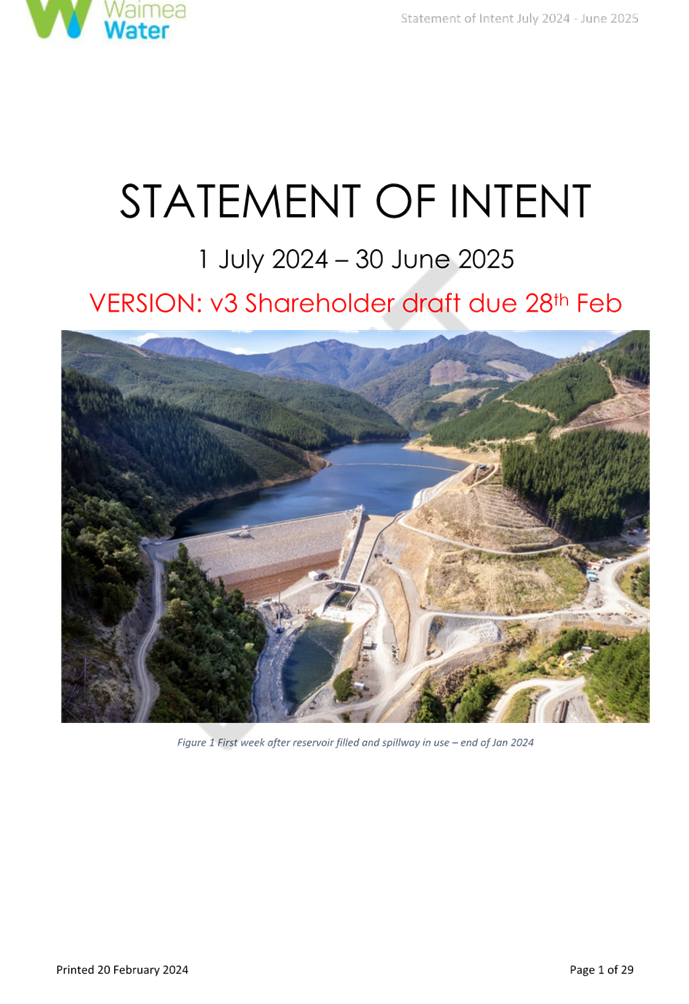


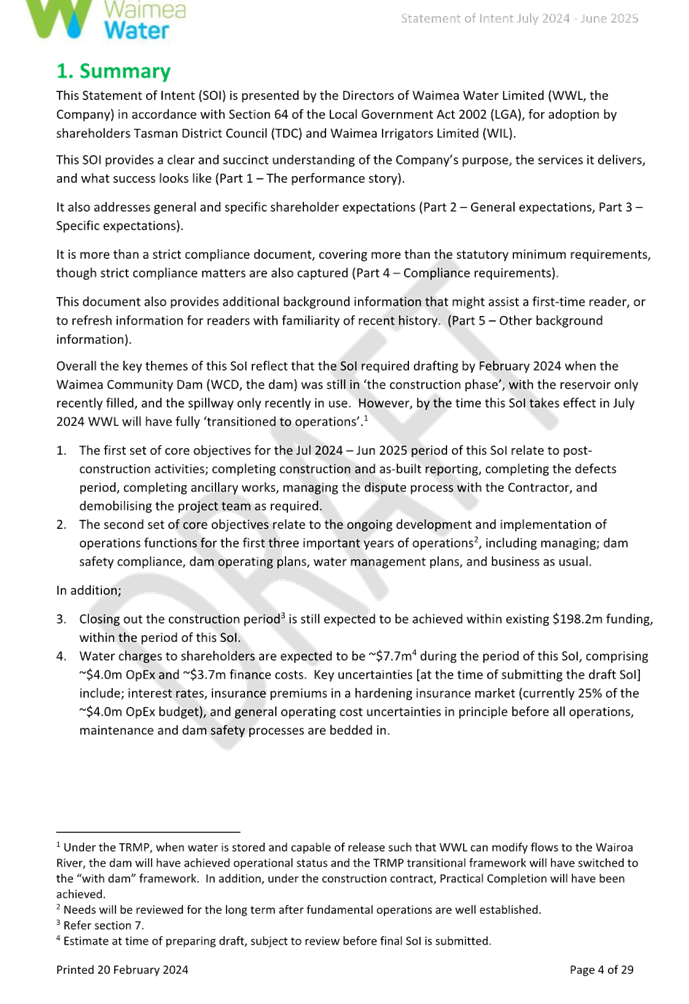


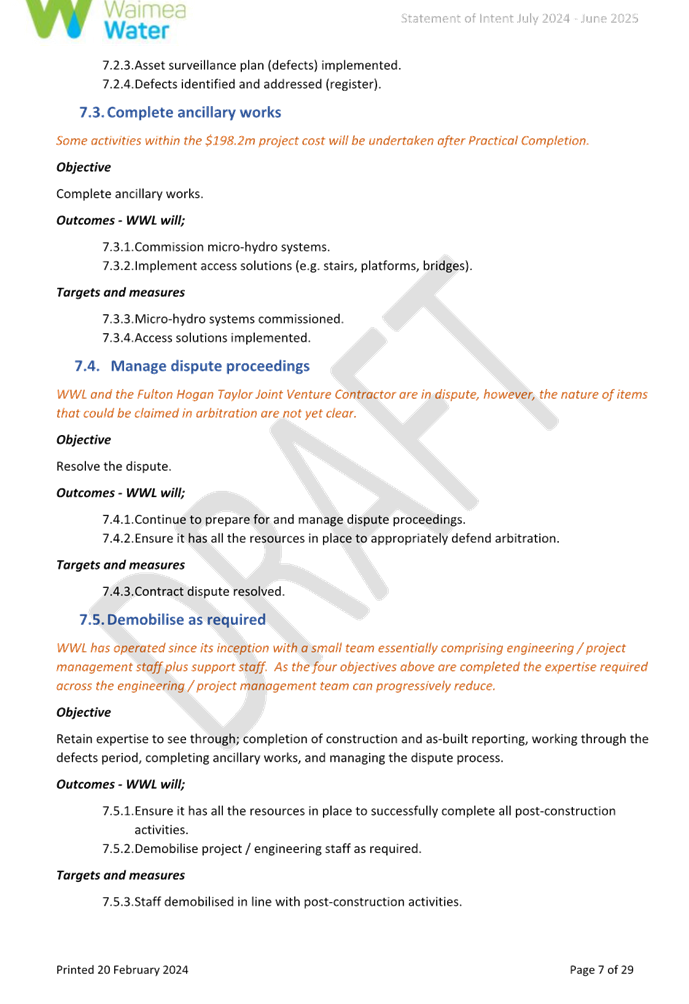

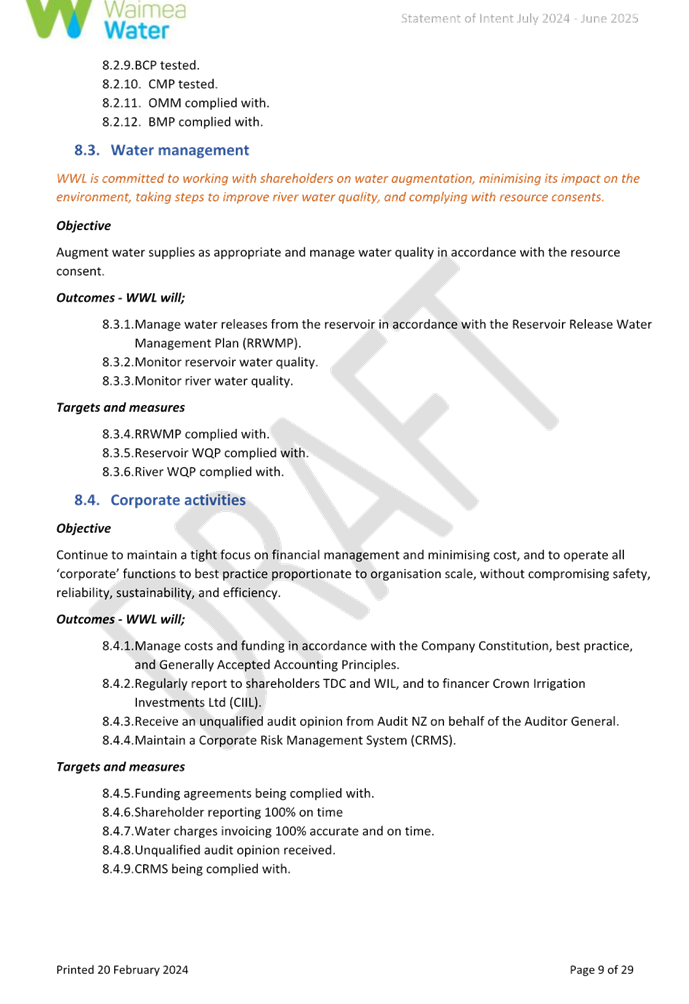

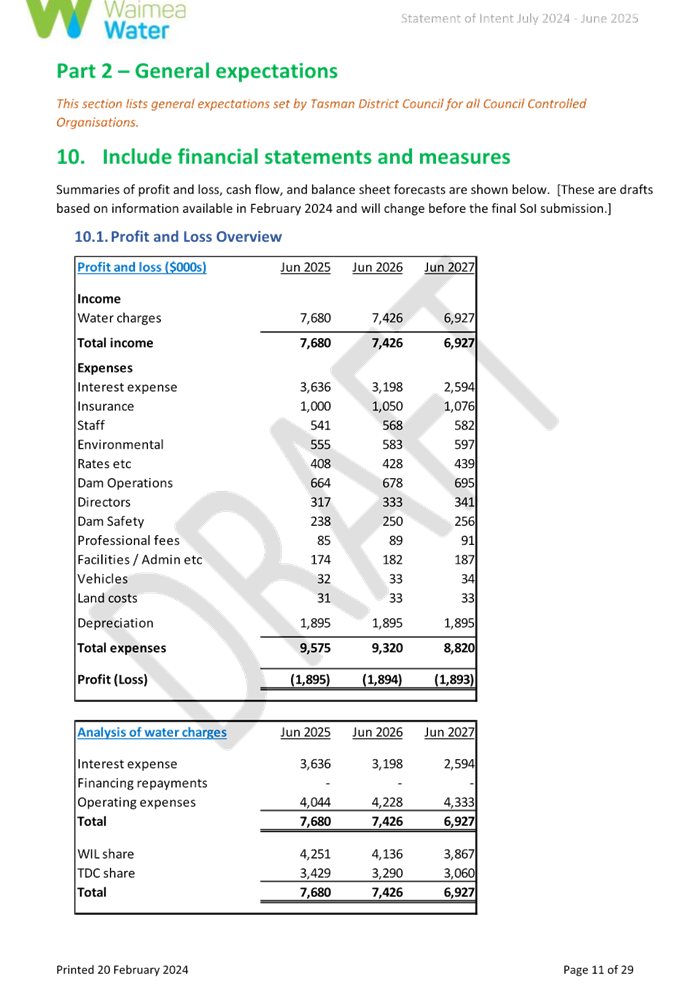
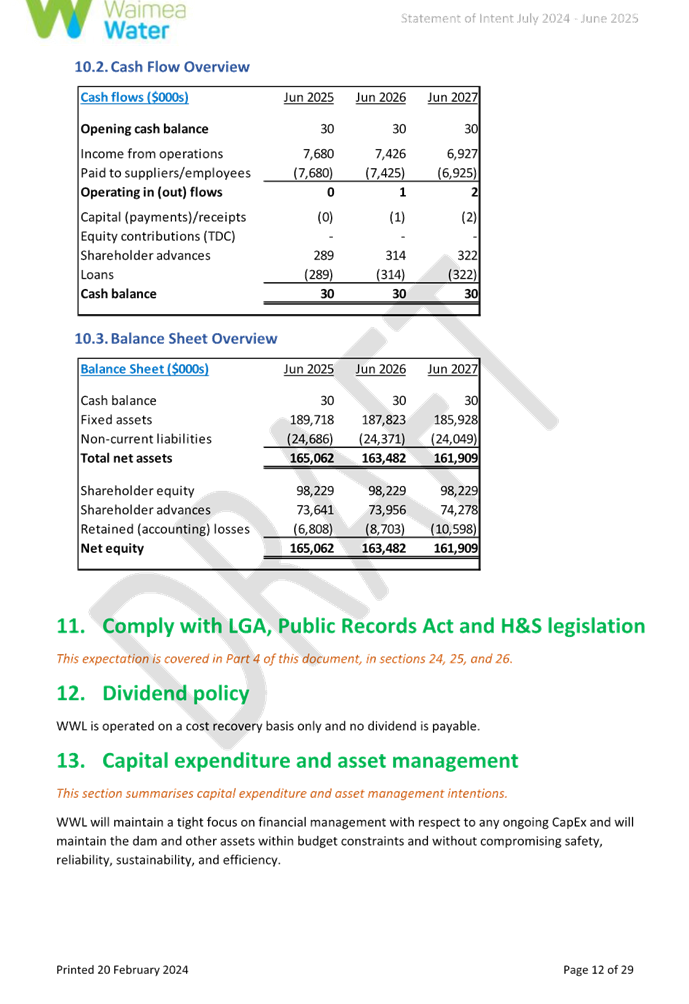

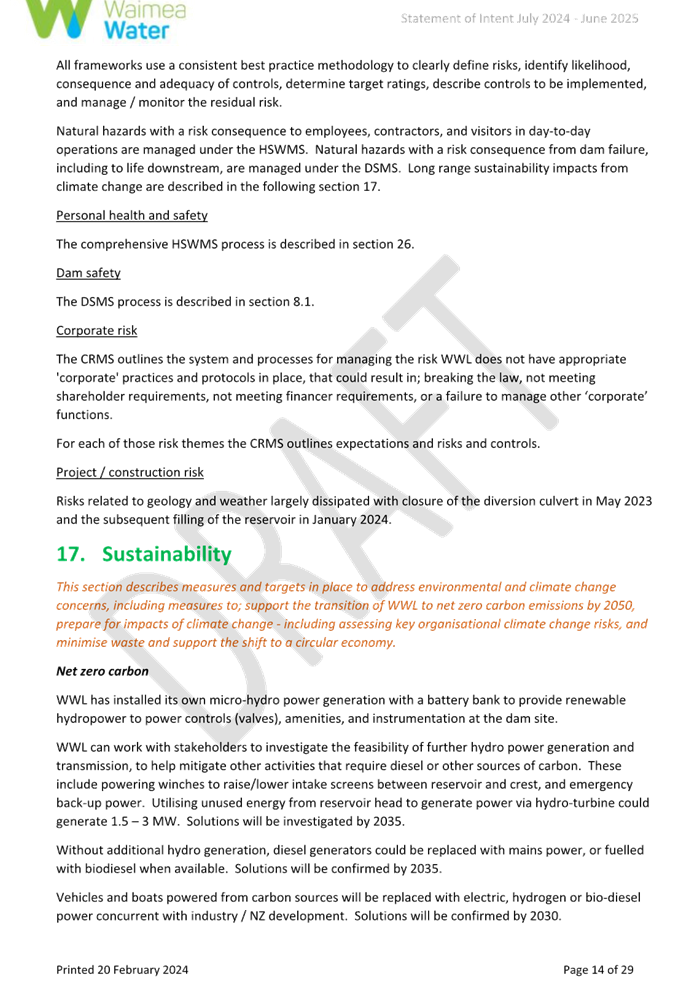
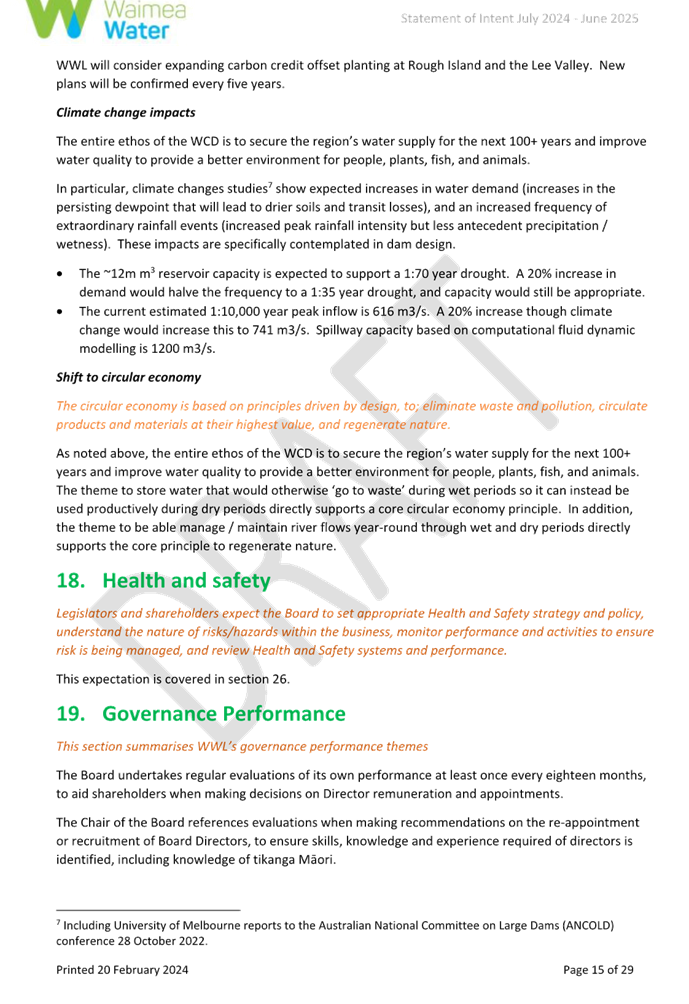
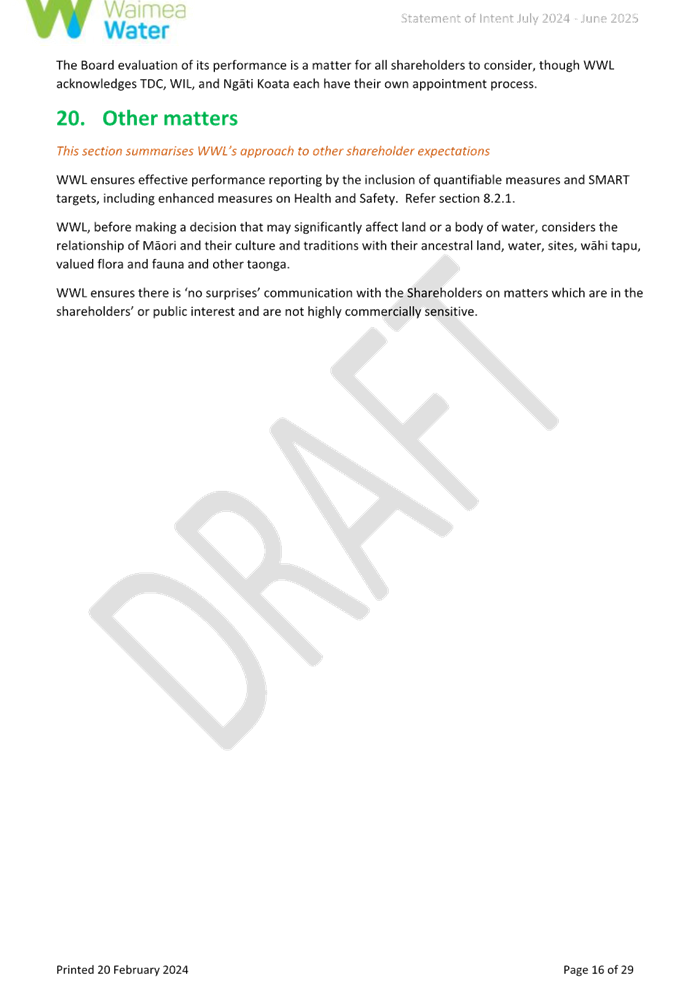
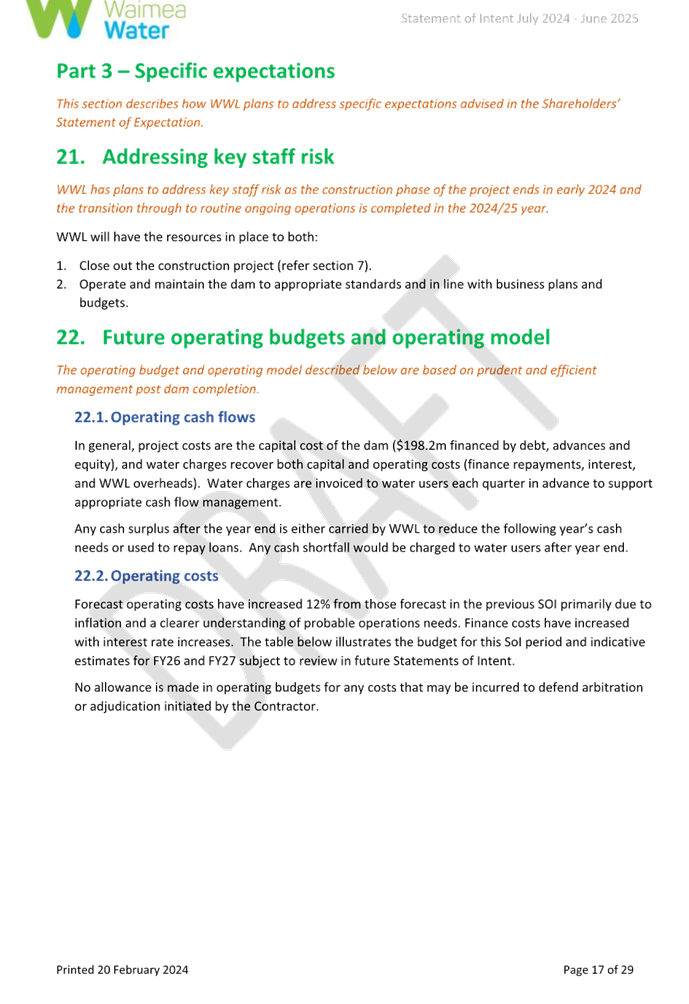


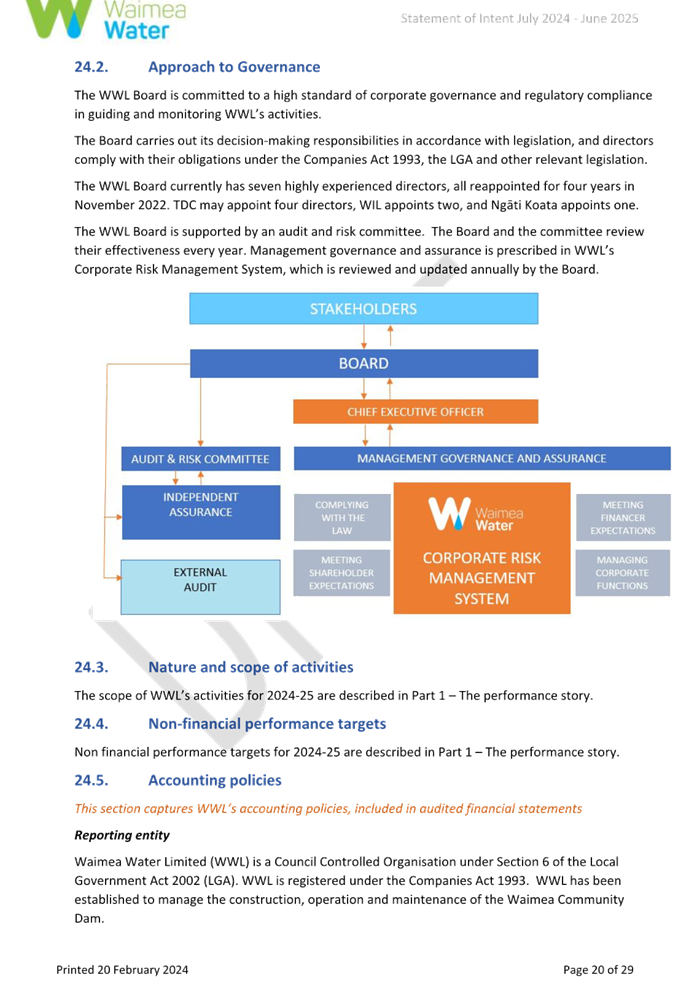
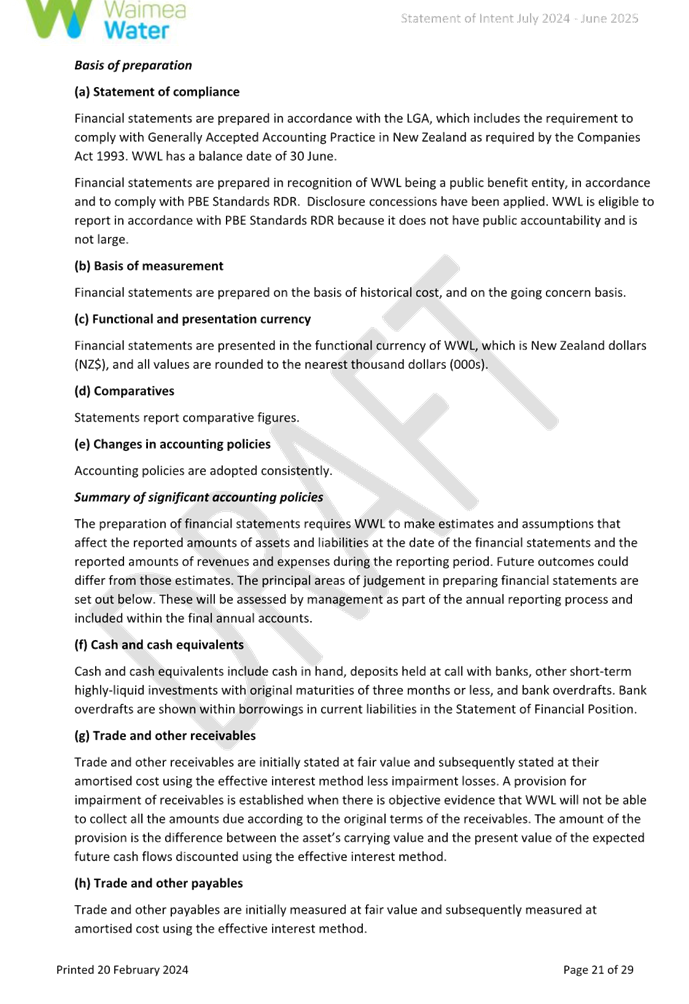
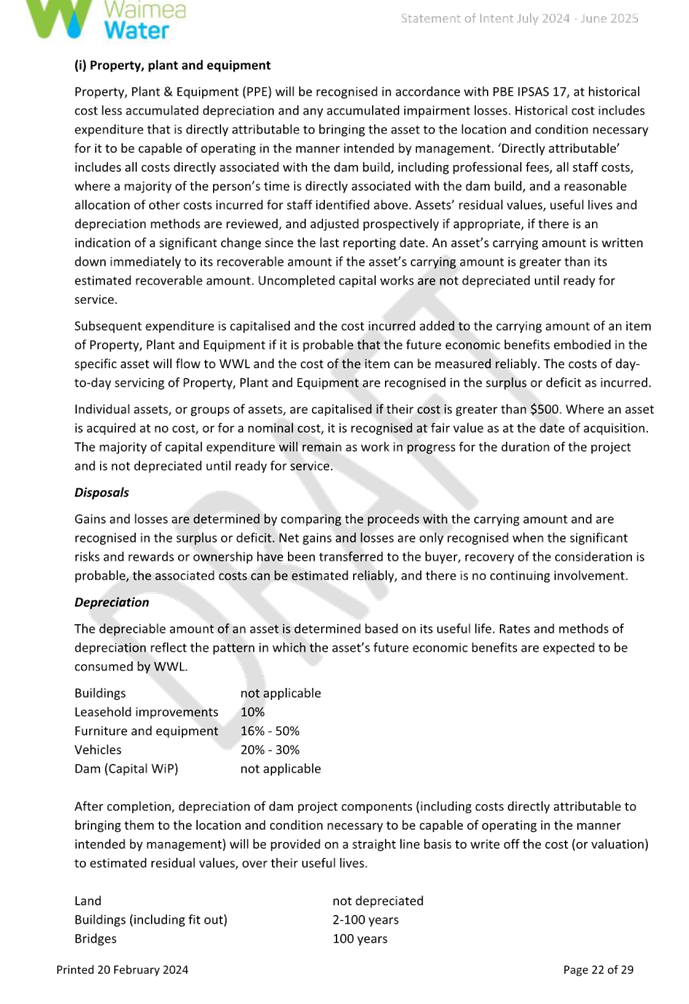
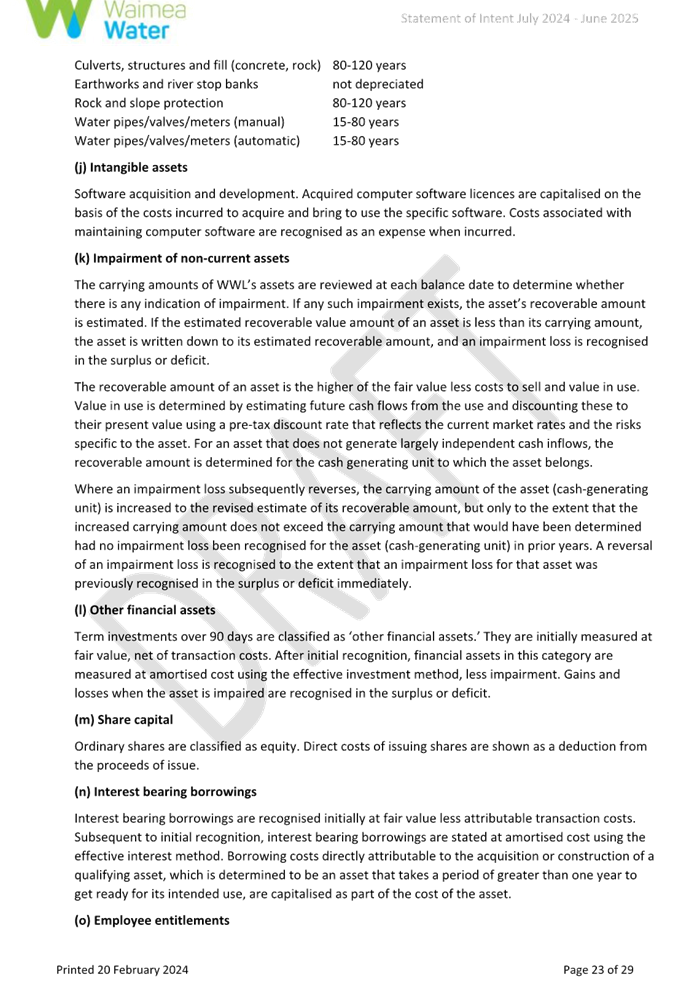
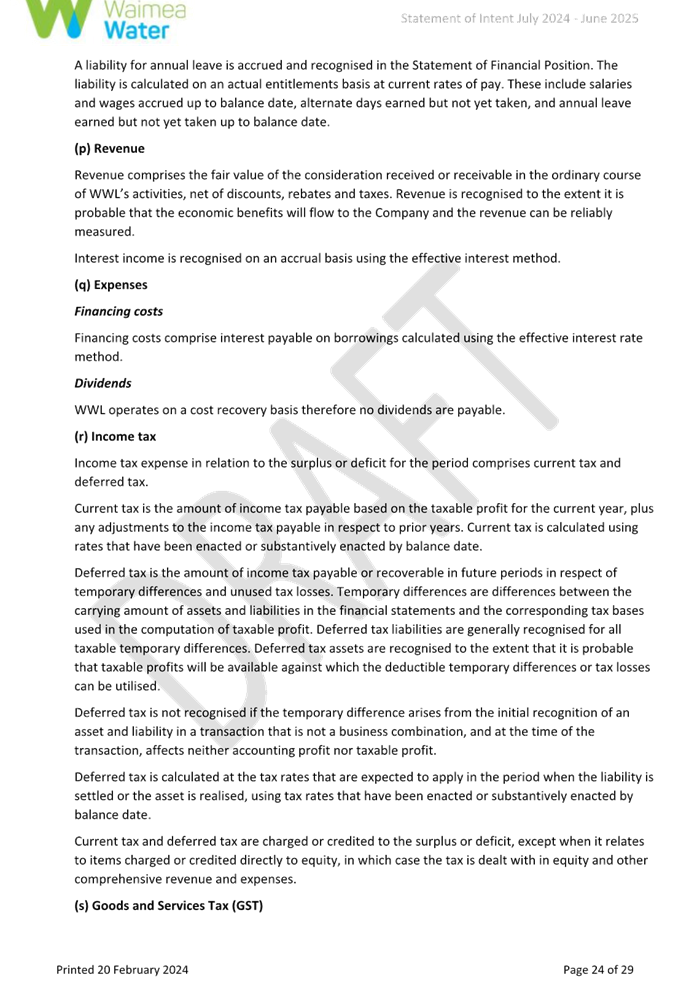
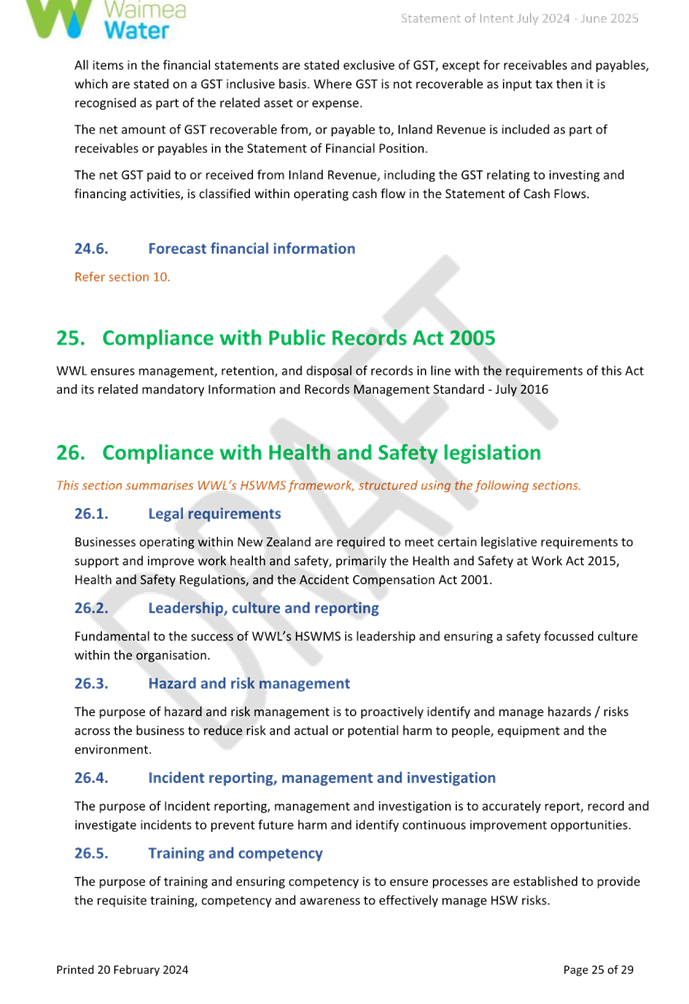
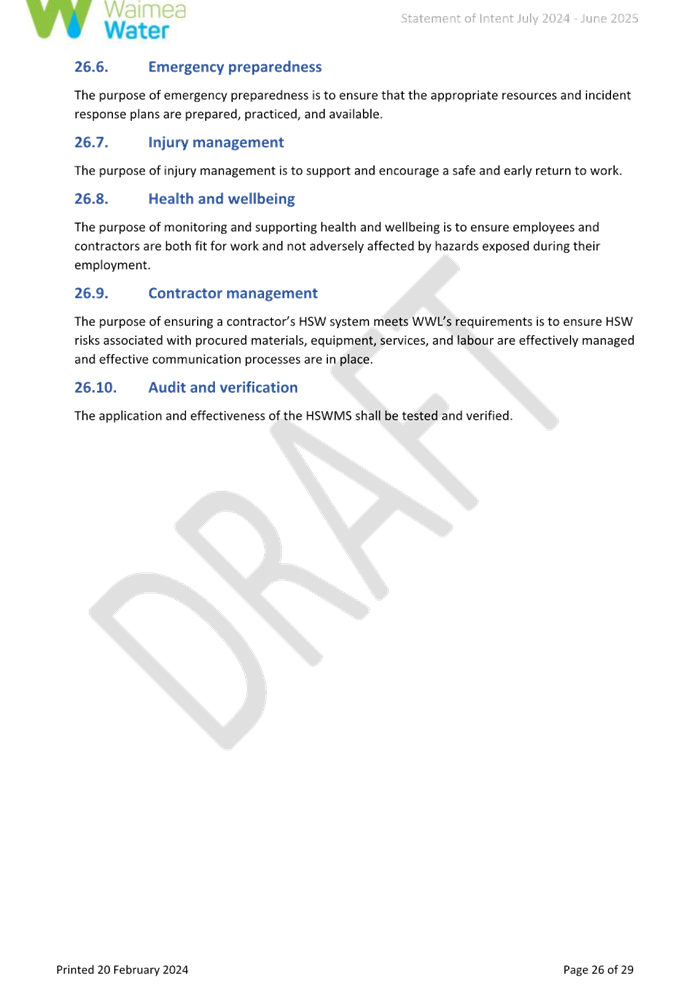
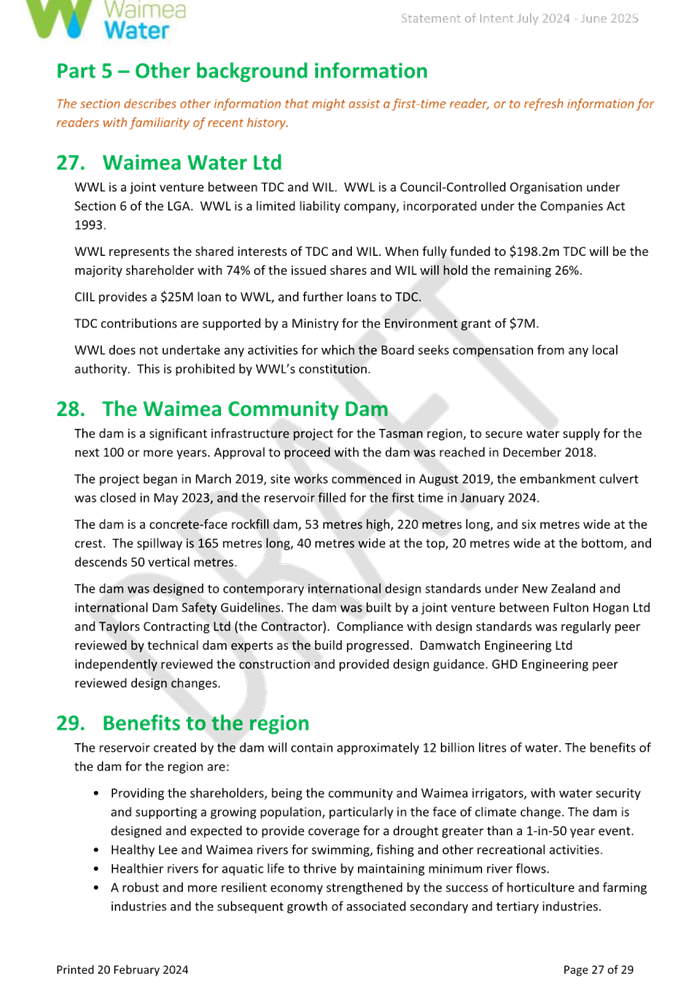
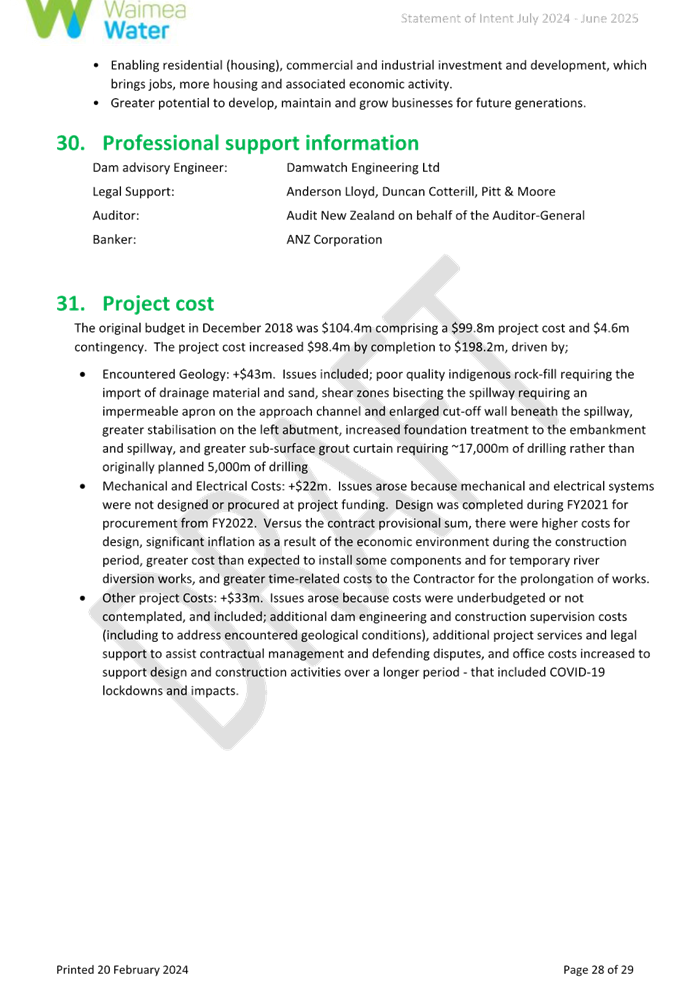
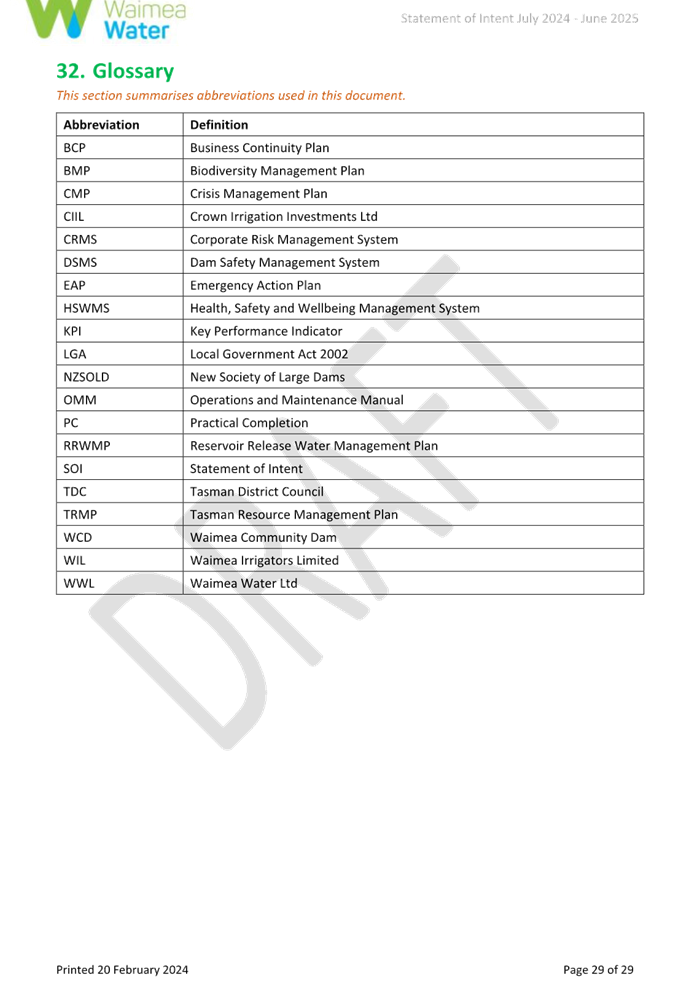
Tasman District Council Agenda – 28 March 2024
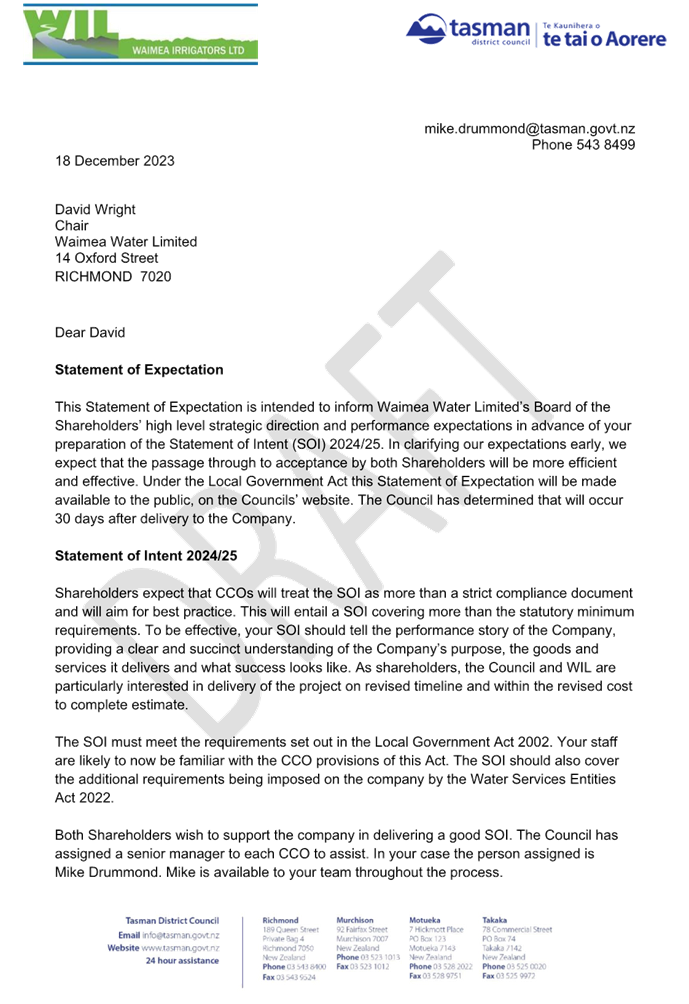
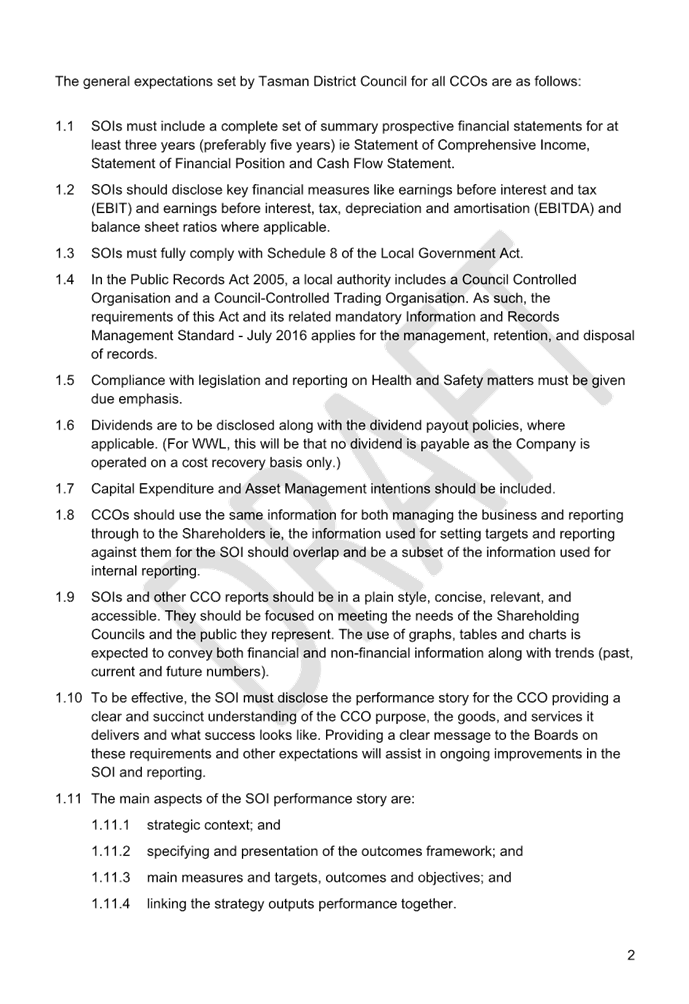
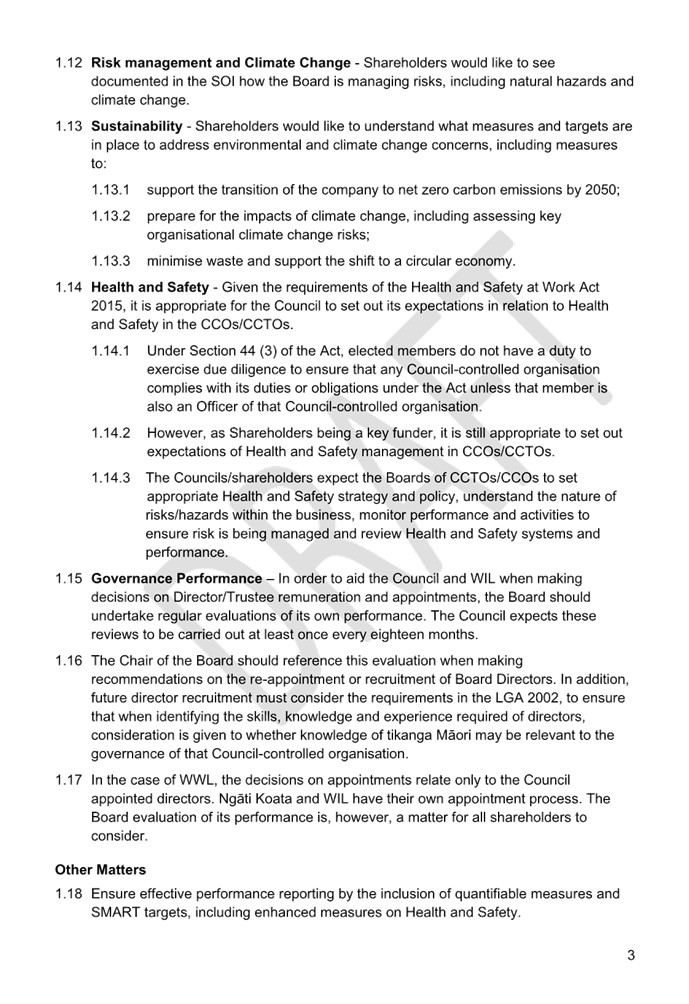

Tasman District Council Agenda – 28 March 2024
7.4 Referral from Motueka Community Board -
increase to eight-week Tasman Resource Management Plan rule for temporary
housing
|
Report
To:
|
Tasman
District Council
|
|
Meeting
Date:
|
28
March 2024
|
|
Report
Author:
|
Jeremy
Butler, Team Leader - Urban and Rural Policy; Mary Honey, Senior Policy
Planner; Barry Johnson, Environmental Policy Manager
|
|
Report
Authorisers:
|
Dwayne
Fletcher, Strategic Policy Manager; John Ridd, Group Manager - Service and
Strategy
|
|
Report
Number:
|
RCN24-03-8
|
1. Purpose
of the Report / Te Take mō te Pūrongo
1.1 To
provide a recommendation to the Council from the 20 February 2024 Motueka
Community Board meeting regarding increasing the TRMP 8-week rule to 108 weeks
relating to temporary housing.
2. Summary
/ Te Tuhinga Whakarāpoto
2.1 At
its 20 February 2024 meeting, the Motueka Community Board made a recommendation
to the Council:
That the
Motueka Community Board
1. recommends that the Council increases the TRMP
8-week rule to 108 weeks for the benefit of inhabitants in temporary housing
which refers to anything that is lived in for more than 8-weeks is deemed a
dwelling and therefore requires resource consent.
2.2 This recommendation was an item (7) in
the Chair’s report (Attachment 1) from Board Member Hughes
and was not supported by an agenda report to satisfy the decision-making
requirements in Section 6, clause 76 of the Local
Government Act 2002.
Context and clarification
2.3 It is important to clarify the
“8-week rule” as this, as stated in the recommendation above, is a
misnomer. The reference to eight weeks – or more correctly “two
calendar months” – appears in the definition of a Building.
2.4 The TRMP provides a definition of a
Building as:
Building – means any
structure (as defined in the Act) or part of a structure whether temporary or
permanent, movable, or immovable, including accessory buildings but does not
include:
(a) coastal
protection structures
(b) any
scaffolding or falsework erected temporarily for maintenance or construction
purposes;
(c) fences,
walls or retaining walls of up to 1.8 metres in height, not used for
advertising or for any purpose other than as a fence or wall;
(d) structures
that are both less than five square metres in area and less than 1.2 metres in
height, except where such structures are for the purposes of damming,
diverting, taking, or using water;
(e) free-standing
masts, towers, pylons, poles, radio and television aerials (excluding dish
antennae for receiving satellite television), less than 10 metres above mean
ground level;
(f) fan
blades of any tower-mounted frost protection device;
(g) any vehicle, trailer, tent, caravan or
boat whether fixed or movable, unless it is used as a place of long term
accommodation (for two calendar months or more in any year), business or
storage;
(h) overhead
lines;
(i) in
relation to any building setback requirement, any eaves, spouting, or bay
windows projecting 1 metre or less from any exterior wall.
2.5 Therefore, this discussion only relates
to vehicles, trailers, tents, caravans, and boats. Any structure that is not
one of those (and not excluded by another condition in the definition) is a
building. For any of those specified structures, if it is lived in for more
than two months, then it is defined as a building and therefore a dwelling and
therefore triggers the building and construction rules in the TRMP.
2.6 As a dwelling it may trigger the need
for a resource consent and reserve financial contributions under the
TRMP.
Workshops
2.7 Council staff will provide background on
the origins and implications of the two-calendar month trigger at a future
workshop. This will enable discussion of the request and help to clearly
identify the problem the request is seeking to address, prior to any
decision-making on the matter.
2.8 For staff to provide more specific and
helpful advice, it is recommended that clarification is sought from the Motueka
Community Board as to the nature of the problem that the request is trying to
solve.
2.9 Staff propose two workshops to work
through the request. The first, currently scheduled for 18 April 2024, will
focus on the background to the “8 week rule” and working with the Council
and Community Board members to clearly define the problem and the outcomes that they are seeking to achieve. The
second workshop (not yet scheduled) can then provide advice on options and any
recommended interventions to achieve those outcomes.
2.10 The Motueka Community Board and Golden Bay
Community Board will be invited to attend the workshops alongside the Council.
2.11 Under the Resource Management Act (RMA), rules in a
plan such as the TRMP are considered regulations. Any change to rules
regardless of size must follow the process set out in the RMA. In summary, that
process requires:
1..1 Public notification of a proposed change and
call for submissions (at least 20 working days).
1..2 Release of a summary of submission and call
for further submissions (10 working days).
1..3 Usually, a hearing so submitters can present
and hearing panel can consider the change and submissions.
1..4 Hearing panel’s decision has to be
adopted by the Council.
1..5 Decision is publicly notified and open to
appeals to the Environment Court if any submitter doesn’t agree with the
decision (30 working days).
1..6 If no appeals, the change becomes legally
operative.
2.12 The process up to release of a decision takes
between six months and two years. If there are environment court appeals, then
the process can take considerably longer.
3. Recommendation/s
/ Ngā Tūtohunga
That the Tasman
District Council
1. receives
the Referral from Motueka Community Board - increase to eight-week Tasman
Resource Management Plan rule for temporary housing report RCN24-03-8; and
2. notes that two Council workshops are proposed to
clearly define the problem and the outcomes that the request is seeking to
achieve and to provide advice on options and any recommended interventions to
achieve those outcomes.
|
1.⇩
|
Motueka
Community Board Chair's Report 20 February 2024
|
93
|
Tasman District
Council
Agenda – 28 March 2024
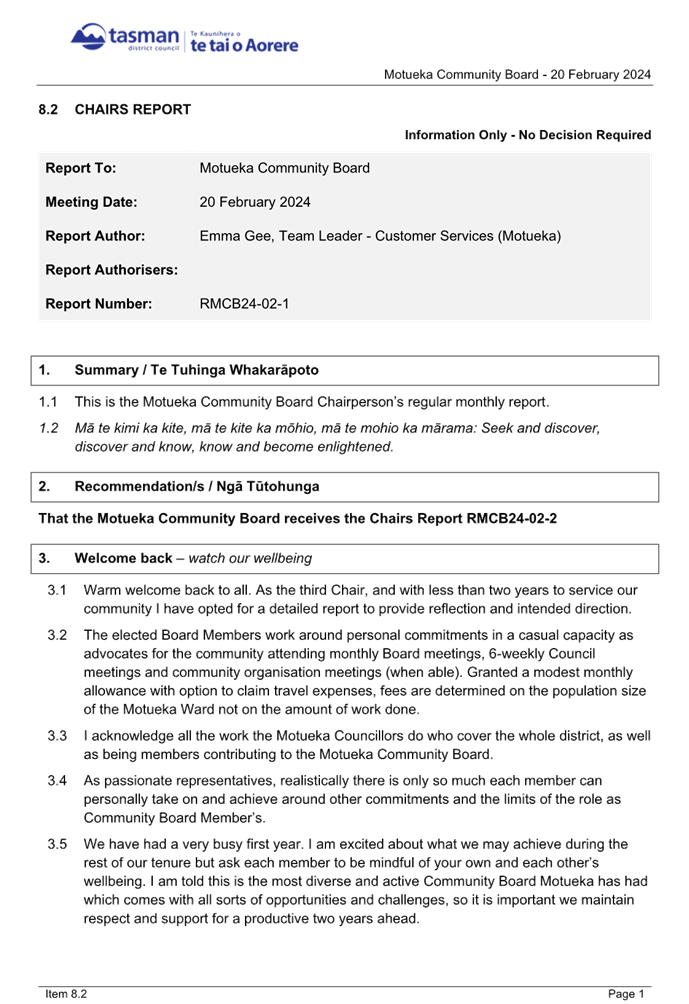
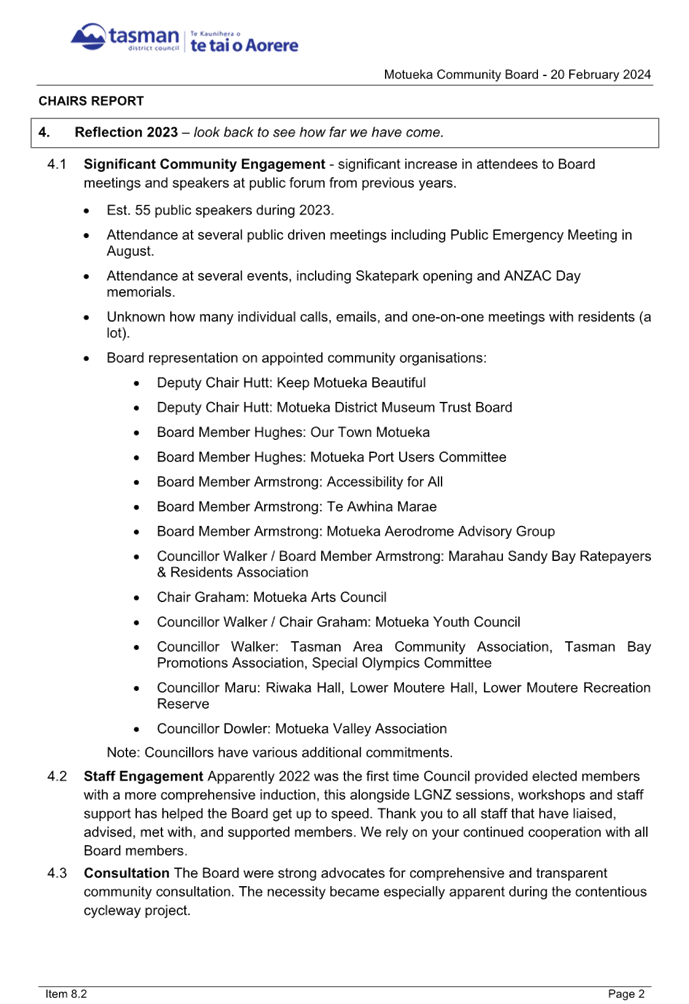
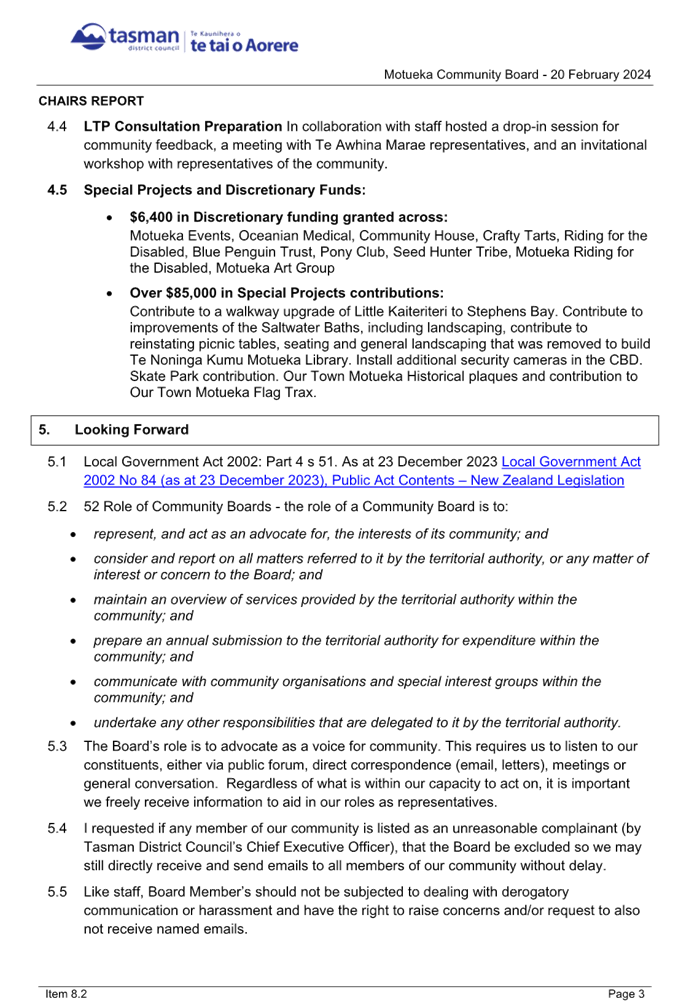
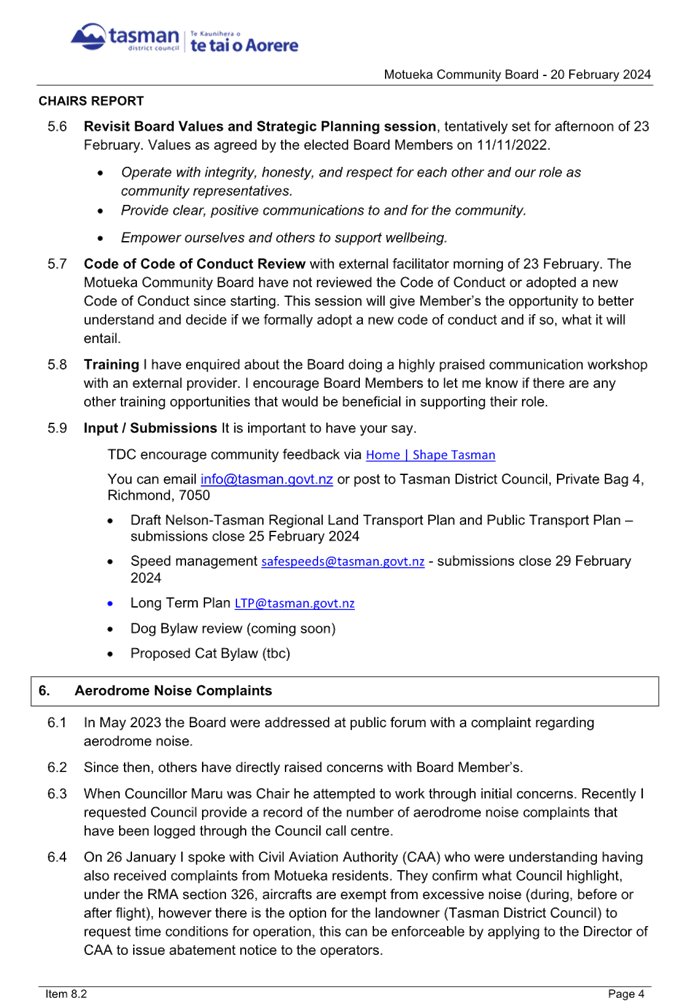
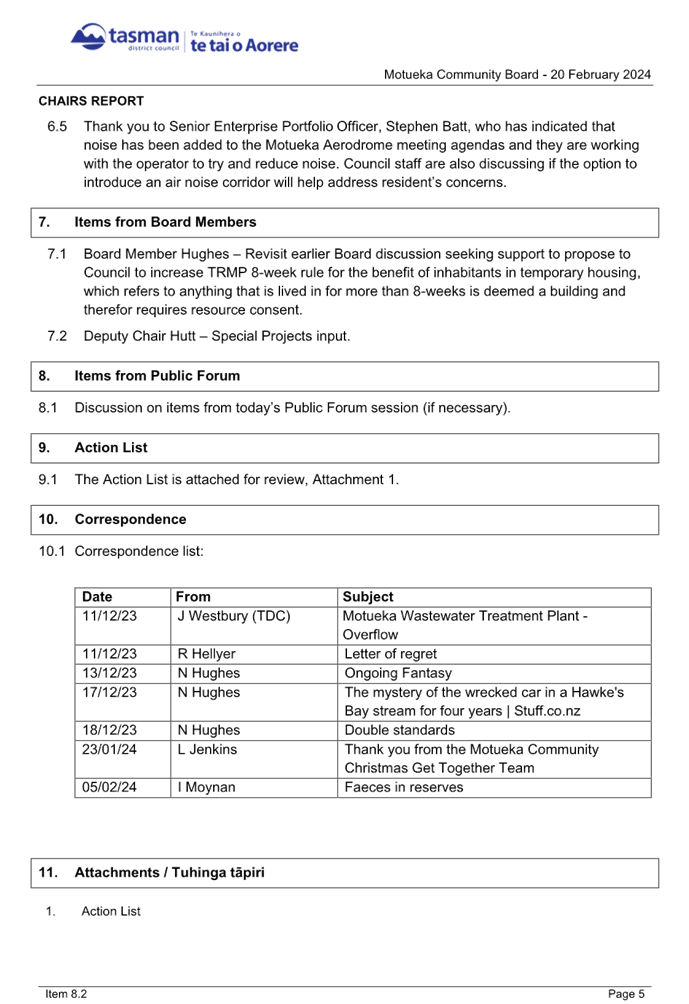
Tasman District Council Agenda – 28 March 2024
7.5 2023/24 Financial Year End Forecast
Information Only - No Decision
Required
|
Report
To:
|
Tasman
District Council
|
|
Meeting
Date:
|
28
March 2024
|
|
Report
Author:
|
Mike
Drummond, Group Manager - Finance; Paul Egan, Management Accounting Manager
|
|
Report
Authorisers:
|
Leonie
Rae, Chief Executive Officer
|
|
Report
Number:
|
RCN24-03-9
|
1. Summary
/ Te Tuhinga Whakarāpoto
1.1 This report
provides a forecast of the Council’s Financial Performance and Position
to
30 June 2024. It is based on the seven months actual results to 31 January
2024, and forecasts the remaining five months through to 30 June 2024.
1.2 The Councils
projected financial position raises several concerns as financial pressures and
unbudgeted expenditure impact on the Council. The Council, when considering
requests for additional unbudgeted expenditure, will need to carefully consider
the financial impacts this will have on the Council.
1.3 The Council’s borrowing position,
compliance with covenants and projected debt levels are covered at a summary
level in this report.
1.4 Capital expenditure and forecast carry
forwards to the 2024/25 year are included at a summary level.
1.5 Additional capital expenditure budget
authorised during the year by the Council is described.
1.6 Joint ventures and certain other items
whose value can only be confirmed at year end are included at budget.
1.7 The report includes some additional
definition and descriptive detail to make it more accessible for readers with
less familiarity with local government finances.
1.8 The results of this forecast will be
used to inform the opening position for the final 2024-34 Long Term (LTP) financials,
including incorporating the forecast capital projects carried into
year 1 of the LTP.
1.9 This will necessitate some re
prioritisation and timing changes for the current draft LTP capital works
programme and revising the opening debt and activity balances.
1.10 The first reference point when making decisions
should be the Council’s Financial Strategy.
1.11 The Executive Leadership Teams further commitment
to transparency, fiscal prudence, and strategic leadership will pave the way
forward and help the Council respond to these financial challenges.
1.12 The Council, as community guardians, will need to
play a pivotal role during these tough financial times. Your active engagement
with the Executive Leadership Team is crucial for steering through these fiscal
challenges. Constructive debate on fiscal matters, critical assessment of
funding proposals, and a shift toward sustainable solutions are essential.
Supporting the Executive Leadership Team’s focus on efforts to enhance
income and control spending is vital.
2. Summary
of Forecast Results / Te Tuhinga Whakarāpoto
2.1 The forecast Accounting Surplus in the
Statement of Comprehensive Revenue and Expense of the Council for the year
ended 30 June 2024 is behind budget. This includes “controllable”
and “non-controllable” elements.
2.2 The forecast
Accounting Surplus after tax is $14.4 million compared to $31.6 million full
year budget, with the controllable Surplus/Deficit being $5.9 million
unfavourable to budget.
2.3 The Forecast Net Debt position is $250.5
million compared to the budget of $249.9 million against the Treasury policy
net debt cap of $250 million. Careful management will be required to prevent a
breach of the cap.
2.4 The Council is forecast to remain within
its external Local Government Funding Agency (LGFA) debt compliance
requirements.
2.5 Forecast capital expenditure is at a
high for recent years, at $95.7 million.
2.6 Capital expenditure of $9.4 million has
been forecast to be carried forward to future years and will need to be
incorporated into the final 2024-34 Long Term Plan.
2.7 Additional capital expenditure to the
Annual Plan approved to date by the Council this financial year is $15.9
million. This has been included in the capital expenditure budget amounts.
3. Recommendation/s
/ Ngā Tūtohunga
That the Tasman District Council
1. receives the 2023/24 Financial Year End Forecast report, RCN23-03-9;
and
2. notes the forecast net debt position when considering decisions
proposing un-forecast additional expenditure in the remainder of the financial
year
4.1 The purpose of
this report is to inform the Council on the forecast financial results for the
financial year ended 30 June 2024, providing a further update to the half year
financial report presented at the Council meeting on 15 February 2024.
5. Statement Of Comprehensive Income
5.1 The Statement of
Financial Performance follows.

5.2 The forecast Accounting Surplus for the
year is $14.3 million vs a budget of $31.6 million, creating an unfavourable
variance of $17.3 million – this can be broken into
“controllable” and “non-controllable” portions.
5.3 Major variance items in the Statement of
Comprehensive Revenue and Expense include:
5.3.1 Capital subsidies and grants
– impacted by cuts to Government externally funded capital projects.
5.3.2 Fees and charges –
impacted by lower economic activity, especially in the building and industrial
sectors.
5.3.3 Fair value gain on revaluation
– impacted by lower than budgeted unrealised gains on interest rate swaps
used to hedge interest rate costs.
5.3.4 Finance income and expense
– higher interest rates have led to higher interest on both deposits for
prefunding loan renewals, and on borrowings.
5.3.5 Employee related expense –
forecast is lower than budget, as several budgeted roles have not been hired,
providing a partial offset to cost overruns elsewhere.
Controllable and Non-controllable Surplus/Deficit
|
|
Forecast 2024
$000
|
Budget 2024
$000
|
Variance
$000
|
|
Accounting Surplus
|
14,316
|
31,588
|
(17,271)
|
|
Non-controllable Surplus
|
46,840
|
58,218
|
11,377
|
|
Controllable Deficit
|
(32,524)
|
(26,630)
|
(5,894)
|
5.4 The forecast controllable deficit is
$5.9 million, due largely to increased maintenance costs, and reduced fees and
charges.
5.5 Non-controllable items are certain types
of transaction which the Council has little influence over due to their
dependency on the market, or decisions of other parties. These include
development contributions, and market revaluations.
5.6 Controllable items are everything else,
most of which the Council can at least strongly influence, and include, rates,
fees and charges, and most operating expenditure including reactive
maintenance.
5.7 Though the forecast Controllable Deficit
is less than budget or last year, it firmly illustrates that the surplus in
forecast and recent years is dependent on income from non-controllable
items, which tend to be either:
5.7.1 Non-cash items (eg revaluations,
movement in swap values, vested assets)
5.7.2 For capital expenditure.
5.7.3 Maintenance
has been impacted by ongoing roading maintenance costs to repair damage from
weather related events in previous years, higher costs. This includes items
such as landslips where damage was done by a past weather event, and a small
trigger event later releases the landslip. Water supply was the other area
where there were many breakages and much reactive work required.
6. Statement of Financial Position
6.1 The Statement of
Financial Position follows.
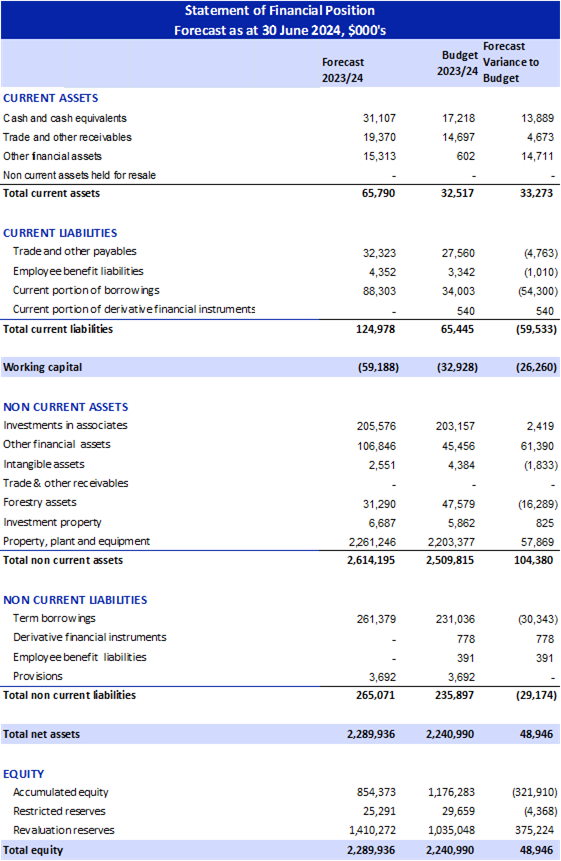
7.1 This section describes the forecast net
debt position of the Council, the role of treasury management, and Activity
Balances/Reserve funds.
7.2 The focus of the
commentary in relation to the Council’s debt position is net debt, the
range of facilities that the Council uses in its treasury management and
funding.
7.3 The Council
undertakes treasury management, the accepted approach to minimise the overall
financing costs associated with operating a local authority. This includes:
7.3.1 Income received from all sources is kept in/applied to
deposit, and debt facilities.
7.3.2 While the income and expenses are tracked, and are
reportable, if it is often of a special nature to specific purpose funds, the
cash itself is received into and paid out of the central bank facilities.
7.3.2.1 This means that Development
Contributions, closed account balances, past profits from forestry, and other
activity balances, while accounted for, are not held in separate cash
reserves.
7.3.2.2 When received the cash is
absorbed into the treasury facilities and is used for operating expenditure,
capital expenditure, and debt repayments.
7.3.2.3 The overall cash and net debt
position of the Council is budgeted, including expenditure drawing on the
reserves mentioned above.
7.3.2.4 This means that when
unbudgeted expenditure drawing on these funds is made it means additional
unbudgeted borrowing is required (other things being equal).
7.3.2.5 If the abovementioned reserves
were to be pulled out of the centralised treasury facility and held in
ring-fenced cash accounts, this would require additional borrowing to provide
the cash to set up the ring-fenced accounts, and higher borrowing costs overall
for ratepayers.
7.3.3 The facilities available to the
Council are reviewed when budgets are approved, and a mix of different
facilities are put in place to balance availability of cash with minimising net
borrowing costs in line with that budget.
7.3.4 Unbudgeted capital expenditure
of $15.9 million has been approved year to date. Though not all of this
has/will be spent this financial year, this unbudgeted expenditure has at times
resulted in pressure on borrowing facilities, causing higher cost short-term
borrowing to have to be used at times.
7.4 Net
Debt is forecast to be $250.5 million at 30 June 2024, compared to a full-year
budget of $249.9 million. Based on forecast, a breach of the self-imposed net
debt cap of $250 million is expected, though whether this occurs, and the
actual amount will depend on factors such as transaction timing and whether
there are further unplanned expenditures.
· Opening
Net Debt July 2023 $201.4 million
· Net
Debt 30 September 2023 $207.4 million
· Net
Debt 31 December 2023 $225.4 million
· Budgeted
Net Debt June 2024 per 2023/24 Annual Plan $249.9 million
· Forecast Net Debt
30 June 2024 $250.5 million
7.4.1 The forecast net debt has been impacted by unbudgeted
capital and additional operating expenditure (particularly maintenance), and
reduced income year to date.
7.5 A
breach of the net debt cap would draw Standard and Poors (S&P) attention to
the Council which has recently had its credit outlook reduced from stable to
negative. S&P has raised its concerns over the sector as a whole that
includes current and projected debt levels in relation to rates income.
7.6 A
breach of the net debt cap would need to be explained in the 2023/24 Annual
Report. It may also draw further discussion with our auditor over the Councils
view on financial prudence and sustainability.
8.1 Capital
expenditure is presented in the tables below. Analysis of the capital
expenditure is provided, both including and excluding joint ventures.
8.2 Due to the
multi-year nature of some projects, carry forwards and budget movements between
years, and the Council’s ability to approve additional capital
expenditure (including budget) a reconciliation between the annual plan capital
budget and the updated capital budget is provided.
8.3 Analysis of the
capital expenditure is provided, both including and excluding joint ventures.

8.4 The forecast expenditure is less than
previously expected due to the reduction in scope of the Transport Choices
programmes for Richmond and Motueka, as the Government funding for this was
reduced by $9 million post-election.
8.5 The amount
forecast to be carried forward is $9.4 million.
8.5.1 This amount is less than actual
gross carry forwards of $27.4 million in 2022/23, and $21.7 million in the
2021/22 year.
8.5.2 While capital expenditure year
to date is ahead of the three-year average, the budget is higher this year. It
must be noted that the higher expenditure is partially due to additional items
including property approved and purchased in the current year.
8.6 The additional
capital expenditure approved year to date is summarised below.
|
Material
Additional Capital Expenditure
|
Amount
Authorised
|
|
Port Tarakohe Phase 2 funded by Kanoa Loan (Part 2024/25)
|
$
6,000,000
|
|
Strategic Land Purchase – Motueka
|
$
5,100,000
|
|
Commercial Property Development on Existing Enterprise
Land
|
$
1,043,726
|
|
Land Purchases for Roading
|
$
850,000
|
|
Port Tarakohe Phase 1 Additional Scope
|
$
836,000
|
|
Port Tarakohe Temporary Toilet block
|
$
210,000
|
|
Waimea Water Strategy items
|
$
500,000
|
|
Murchison Road Maintenance Depot Improvements
|
$
464,000
|
|
Other
|
$
926,031
|
|
TOTAL ADDITIONAL CAPITAL EXPENDITURE AUTHORISED*
|
$
15,929,757
|
8.7 Of the $6 million Port Tarakohe Phase 2
capital expenditure approved, approximately
$3 million was planned from the outset to be spent in the 2024/25 financial
year.
9.1 The Executive Leadership Team are
regularly working to remain within the current fiscal envelope. This involves
robust discussions with the whole organisation as some past practices cannot be
sustained in this more challenging fiscal environment.
9.2 We will be running a larger than
budgeted deficit, which must be cash funded. This places even greater
pressure on our net debt cap and on the long term plan opening position for the
LTP. Management is focused on where we may be able to increase income streams,
improve debt collection and trim non-essential expenditure.
9.3 The recent re-structuring of the
Finance department is assisting staff focus on improving our forecasting and
budgeting systems including improved cash flow management. Despite the
limitations posed by an outdated FMIS, we believe that with additional training
and focus, our teams can achieve ongoing improvements.
9.5 We are working to improve current
practices that are creating a lack of transparency in our funding and over our
financial standards. Historically, operating in departmental
silos has obscured the complete financial landscape. These improvements
are focused on each Leader (ELT/SLT) running their unit more efficiently and
effectively. This approach will assist in making more informed decisions on how
we can be more financially effective as an organisation.
10.1 As the Mayor and Councillors are guardians of our
community’s wellbeing, your role is pivotal during these increasingly
challenging financial times. The organisation looks to you for leadership and
support. By actively engaging with the Executive Leadership Team, you can help
steer us through these turbulent financial waters.
10.2 In our perspective our Council meetings should see
more attention to and constructive debate on financial matters. These
discussions are not just formalities; they are the lifeblood of effective
governance. We are looking for a renewed focus on fiscal matters including
budgets, additional funding requests and exploring innovative solutions.
10.3 Our financial decisions should be framed by the
Financial Strategy including maintaining our operations within the fiscal
envelope and balancing current and future demands on ratepayers.
10.4 We will continue to see numerous Council funding
proposals in these more difficult times. For every good idea, there’s a
scarcity of available funds. As a Council your critical assessment of these
requests is essential. That involves regular and robust discussions. We
need to move away from past practices and toward financially sustainable
solutions.
10.5 The Council needs to critically access requests for
funding or additional expenditure. You will receive many more good ideas for
funding then we have funds available. Regular and robust discussions on these
requests are pivotal as we navigate through this challenging fiscal
environment, where adherence to past practices and approaches is no longer
viable.
10.6 The Executive Leadership Team’s attention is
directed toward identifying opportunities to augment income, enhance debt
collection, and curtail non-essential spending. These efforts will impact
various groups within our communities. Your support will be crucial when the
resultant lobbying begins.
11. Assumptions and Forecasting Limitations
11.1 The reforecasting process
relies on many assumptions and inputs, some of the more material ones are
listed below:
11.1.1 Interest rates stay
close to levels disclosed in the last Treasury report.
11.1.2 There is no
material additional expenditure not previously budgeted.
11.1.3 Open staff
vacancies remain around current levels.
11.1.4 Operating subsidy
rates from NZTA / Waka Kotahi remain at the same levels, despite higher than
budgeted maintenance expenditure.
11.1.5 Capital budgets are
expended in line with forecast.
11.1.6 Timing of receipt
of capital subsidies is not materially mismatched with the related capital
expenditure.
11.1.7 Joint venture related revenue and
expenditure has been included at budget.
11.1.8 Share of JV and
Associates Surplus / Deficit has not been included.
11.1.9 There is no
significant weather related or emergency events in the remainder of the
forecast period.
11.1.10 There are no significant
legislative changes not already signalled that impact the Council operations or
funding in the remainder of the forecast period.
11.1.11 These forecast financial
statements have not been subject to audit or external review.
12.1 There are two reports that
are normally completed after financial year end, the Carry Forwards report, and
the Activity Balances report. These reports identify two main things:
12.1.1 Budget items that
need to be moved between years – for example a capital project that is
not yet complete, and needs its remaining budget moved to the next financial
year where it will be competed. The Council resolving to do this is necessary
to add these to the annual plan budget.
12.1.2 Activity balances
for different activities the Council undertakes. Legislation requires the
Council to track equity relating to certain activities, especially when they
have targeted funding.
12.2 These
reports can only be done definitively when the financial year is complete, so
are usually reported to the Council in September.
12.3 It
is proposed to prepare an initial report for a Council decision on the Capital
Carry Forwards, and some Activity Balances items in July 2024. This will allow
key decisions to be included in the Annual Report
financials.
Nil
Tasman District
Council
Agenda – 28 March 2024
7.6 Richmond Athletic Association Football Club - Request
for Funding
Decision Required
|
Report To:
|
Tasman District Council
|
|
Meeting Date:
|
28 March 2024
|
|
Report Author:
|
Grant Reburn, Reserves and Facilities Manager
|
|
Report Authorisers:
|
Leonie Rae, Chief Executive Officer
|
|
Report Number:
|
RCN24-03-10
|
1. Purpose
of the Report / Te Take mō te Pūrongo
1.1 This purpose of this report is to
request funding for the Richmond Athletic Association Football Club (RAAFC) for
new changing rooms and clubrooms upgrade of $650,000 with the Council’s
contribution being two-thirds or $435,000.
2. Summary
/ Te Tuhinga Whakarāpoto
2.1 The Richmond Athletic Association
Football Club has a ground lease on an area of Jubilee Park, Richmond for their
existing Clubrooms. This is a community lease at a nominal rental.
2.2 The club has approached the Council requesting funding for new
changing rooms, toilets, and a clubroom upgrade. The current facilities are
poorly located within the clubrooms, inadequate for the number of teams and in
need of upgrading. The clubrooms and any upgraded facilities would be owned by
the club.
2.3 The
Council currently has $12.6 million in its Richmond Ward Reserves Financial
Contributions account. It is proposed that this funding comes from that fund.
2.4 The
current Annual Plan included $1.062 million for the Joint Cemetery property purchases. While this fund was
earmarked for the Joint Cemetery that is not likely to occur in this financial
year. It is proposed that this funds the $435,000 Council contribution.
2.5 The
Council can only use RFC funds for capital projects linked to growth.
Councillors need to satisfy themselves that there is sufficient nexus between
this project and population growth in Richmond.
3. Recommendation/s
/ Ngā Tūtohunga
That the Tasman District Council
1. receives the Richmond Athletic Association Football Club - Request
for Funding report RCN24-03-10; and
2. approves grant funding from the Richmond Reserves Financial
Contributions budget of $435,000, towards the cost of new changing rooms and a
clubroom upgrade at the Richmond Athletic Association Football Club facilities
at Jubilee Park, Richmond, subject to the Richmond Athletic Association
Football Club raising the balance of $215,000 for the upgraded facility prior
to any release of Council funding; and
3. requests staff to draft and authorise the Chief Executive Officer to
enter into a formal written funding agreement with the club that covers the
approved Council funding and also provides the terms and conditions including
undertakings, reporting and conditions precedent to any funding payments prior
to any release of Council funding; and
4. authorises the payment of the Council funding over time and
commensurate with the agreed stages of the new changing rooms and a clubroom
upgrade at Jubilee Park being completed; and
5. notes that this project funding was not included in the 2023/24
Annual plan and further notes that additional capital expenditure will need to
be included in the 2024-34 Long Term Plan to accommodate the Joint Cemetery
property purchases if this grant proceeds; and
6. notes the term of the intended ground lease renewal referred to in
this report could be from currently offered standard five (5) years to the
maximum term of 33 years permitted under the Reserves Act 1977.
4.1 The Richmond Athletic Association
Football Club (RAAFC) shares its Jubilee Park clubrooms with Waimea Toi Toi
United Cricket Club.
4.2 The football club was established in
1964 and the existing clubrooms, an old timber farmhouse, was moved to Jubilee
Park around the same time.
4.3 The RAAFC currently has a membership of
over 570 comprising 270 senior and 300 junior players.
4.4 There is now a new women’s league
with 85 members as well as walking football with 60 playing. In terms of the
cricket club membership there are six teams comprising 150 players.
4.5 Based on demographic projections, the
club has ascertained that there could be an increase of 308 people who play
football in the next decade. This is potentially an increase of 20 new teams.
4.6 Because of the current and future
projected growth of the football club it has started preparing plans in the
past few years for additional changing rooms, toilets and an upgrade of the
clubrooms building.
4.7 The club presented their proposal for
clubrooms and changing room facilities at the Operations Committee meeting on 7
December 2023. It was well received by elected members and since then
Council’s the Chief Executive Officer sent a letter of support for the
club to use for its external funding applications.
4.8 The club advised in January 2024 that it
has since been successful with an application and has received confirmation of
$50,000 in funding from Pub Charity Ltd that needs to be spent on the build and
within three months. We understand this is being used to fund the detailed
design drawings which are almost completed.
4.9 So that the club does not lose the
funding already secured, it has requested that the Council confirm whether it
will contribute to the project. In considering that request, the Council must
balance this request against the other requests for funding received from other
community and sports groups that have been either approved or turned
down.
4.10 The club has confirmed that it currently has two
additional external funding applications being considered.
4.11 The club leases reserve land from the Council that
the building is located on and if a building extension was to occur the lease
area would also need to be extended.
4.12 The current lease which expired in December 2023
has been rolled over on a month-to-month basis while a new lease is being
negotiated. As part of the new lease, it is proposed that the
‘footprint’ of the lease be extended to accommodate the proposed
building extension. Staff have written to the club offering the standard a
5-year lease term. This term is not likely to be acceptable to the club given
the investment proposed and we expect they will respond with a request for a
longer term.
5. Analysis
and Advice / Tātaritanga me ngā tohutohu
5.1 The Council has been approached by the
RAAFC and requested a two third funding contribution toward the cost of the
clubrooms upgrade. The contribution would need to be in line with the
Council’s Community Funding Policy. The Policy currently has clubs or
community groups contributing one third cost and the Council two thirds towards
new developments.
5.2 The club had the total cost of the
extension including scope risk recently assessed at $650,000.
5.3 Based on this project costing, the
Council maximum two-thirds contribution would be $435,000 on condition that the
club has raised the $215,000 balance before the Council advances any funds. It
is proposed that the Council contribution is funded from Richmond Reserves
Financial Contributions.
5.4 There is the potential to create a
community ‘hub’ at Jubilee Park and encourage the sports clubs to
appeal to wider audiences and allow their facilities to be used more frequently
by many diverse community groups. At the same time this will enable the clubs
to be more financially resilient and enterprising. This ‘community
hub’ could be a cost-effective opportunity for the Council to meet the
growing needs of the community and complement existing Council facilities such
as the Richmond Town Hall and Library.
5.5 Jubilee Park has several ageing
facilities and given the residential development occurring in the adjacent
Berryfields and Meadows subdivisions, it would make sense to ensure that these
facilities are future-proofed and meet the needs of the community.
5.6 Should the building extension proceed,
the facilities would be available for club members and visiting teams and the
club would be responsible for future maintenance and cleaning.
5.7 The club has advised that it has members
with strong project management and construction experience who would be
responsible for project management of the proposed build.
5.8 The existing public toilets will remain
at Jubilee Park and are reasonably well used by the public.
5.9 There is currently a new Richmond Ward
Reserves Management Plan being prepared, however the Jubilee Park section has
not yet been drafted.
5.10 The existing Reserves Management Plan allows for
the RAAFC clubrooms but does not specifically address expansion of buildings on
the reserve.
5.11 This application aligns with Council’s Parks
and Facilities Activity Management Plan, the Richmond Ward Reserves Management
Plan, and the Reserves General Policies for the use of reserves.
6.1 The options are outlined in the
following table:
|
Option
|
Advantage
|
Disadvantage
|
|
1.
|
Approve the funding
|
Would provide for a future-proofed
clubrooms with changing rooms, toilets, and storage for two clubs that
already provide good community benefits.
The reserve is an appropriate location
for new changing rooms and a clubrooms upgrade on a reserve that is a hub for
other recreational activities.
|
Adds additional building area to the
reserve. Additional maintenance and operating costs must be met.
|
|
2.
|
Decline the funding
|
Allows the available RFC funds to be
utilised for other projects.
|
The club will potentially struggle to
grow membership and become more established without adequate facilities.
Risks players leaving with the inadequate clubroom facilities. Less
opportunity for the wider community for meeting/community space
|
6.2 Option 1 is recommended.
7.1 There are no specific legislative
requirements associated with this decision. The Council has the delegated
authority to approve the contribution from the Reserves Financial Contributions
provided it is satisfied that the funding request is capital in nature and has
a sufficient nexus to population growth.
7.2 The Council
should not advance funding without drafting and entering into a formal written
agreement with the club that covers the approved funding and also provides the
terms and conditions including undertakings, reporting and conditions precedent
to any funding payments.
8. Iwi
Engagement / Whakawhitwhit ā-Hapori Māori
8.1 Given there is currently a clubroom
building on site and any building extension would be considered a relatively
minor change, no wider consultation has taken place.
9. Significance
and Engagement / Hiranga me te Whakawhitiwhiti ā-Hapori Whānui
9.1 The overall significance is considered
low to moderate.
|
|
Issue
|
Level of
Significance
|
Explanation of
Assessment
|
|
1.
|
Is there a high level
of public interest, or is decision likely to be controversial?
|
Moderate
|
There could be a
moderate level of public interest due to the proposed level of funding of the
clubroom extension and a new lease being granted.
|
|
2.
|
Are there impacts on
the social, economic, environmental, or cultural aspects of well-being of the
community in the present or future?
|
Low
|
The activities of the
club provide recreational and social benefits to participants
|
|
3.
|
Is there a
significant impact arising from duration of the effects from the decision?
|
Low to moderate
|
The lease could be
for a term of up to 33-years. A longer-term lease >5 years may be offset
by community benefits generated by the activity.
|
|
4.
|
Does the decision
relate to a strategic asset? (refer Significance and Engagement Policy for
list of strategic assets)
|
No
|
The Council’s
Reserves and Facilities as a whole are a strategic asset, but this proposal
only involves a lease of a small area of reserve for a community use.
|
|
5.
|
Does the decision
create a substantial change in the level of service provided by Council?
|
No
|
No change to level of
service provided by this activity.
|
|
6.
|
Does the proposal,
activity or decision substantially affect debt, rates, or Council finances in
any one year or more of the LTP?
|
No
|
No real impact on
rates, the renewed lease will be subject to a community lease rental.
This decision will
require the deferred funding for the Regional Cemetery land purchase to be
approved in the 2024-34 LTP
|
|
7.
|
Does the decision
involve the sale of a substantial proportion or controlling interest in a CCO
or CCTO?
|
No
|
|
|
8.
|
Does the
proposal or decision involve entry into a private sector partnership or
contract to carry out the deliver on any Council group of activities?
|
No
|
|
|
9.
|
Does the proposal or
decision involve Council exiting from or entering into a group of
activities?
|
No
|
|
|
10.
|
Does the proposal
require consideration of the obligations of Te Mana O Te Wai (TMOTW) relating
to freshwater and Affordable Waters services?
|
No
|
The facility would
require connection to existing water and wastewater services which already
consider TMOTW.
|
10. Communication
/ Whakawhitiwhiti Kōrero
10.1 No formal communication within the community has
been undertaken, however staff have met and consulted with the club.
11. Financial
or Budgetary Implications / Ngā Ritenga ā-Pūtea
Where are we at?
11.1 The
Council is not in a strong position to fund unbudgeted expenditure. In the
current 2023/24 Annual Plan Council debt was budgeted to peak just under the
$250 million net debt cap. We are still forecasting to be just within the Net
Debt cap. The Council is also forecasting to have an operating deficit i.e., an
unbalanced budget in 2023/2024. The funding for this unbudgeted expenditure is
being met by deferring the budgeted land purchase for the Regional Cemetery
project.
11.2 As
we fund the balance sheet as a whole the Reserve Financial Contributions are
not held in cash and any unbudgeted expenditure will directly increase
our debt unless there is budgeted expenditure that is deferred into a future
year. The Council has already authorised unbudgeted capital expenditure of c$15
million this year (2023/24) including strategic land in Motueka $5.5 million,
Port Tarakohe $6 million and Motueka aerodrome developments
$1 million. These additional purchases have put considerable pressure on our
net debt cap and are reliant on offsetting reductions within the wider capital
works programme.
11.3 However,
because there are delays with the creation of a Joint Cemetery, the Council
will be able to prioritise this expenditure and likely remain within the $250
million net debt cap.
11.4 By
reprioritising the 2023/2024 spend there will be flow on impacts to the LTP.
These will be managed, along with other expected carryovers, while the LTP is
out for consultation.
11.5 It
is proposed to fund this unbudgeted grant from Reserve Financial Contributions.
11.6 The Richmond RFC account currently has a $126 million balance as at
March 2024. The draft LTP expects it to have a balance of $18 million at the
end of the ten years. The reprioritisation will reduce this closing balance and
will be reported back when the LTP is adopted.
What does it mean?
11.7 Given
current pressures on the Council including the operational deficit, the Council
could still breach its Net Debt cap of $250 million. Financial caution is
paramount.
11.8 A
breach of the net debt cap will draw Standard and Poors (S&P) attention to
the Council which has recently had its credit outlook reduced from stable to
negative. S&P has raised its concerns over the sector as a whole that
includes current and projected debt levels in relation to rates.
11.9 A
breach of the net debt cap will need to be explained in the 2023/24 Annual
Report. It may also draw further discussion with our auditor over the Councils
view on financial prudence, given their engagement on this in the preparation
of the 2024-34 Long Term Plan Consultation Document.
What do you want to do?
11.10 If the decision to proceed with a grant is one for the Mayor
and Councillors, additional consideration should be given to the financial
implications inherent in providing the grant at this time. While some risks can
be mitigated others could manifest at a future cost to the Council.
12.1 This is a low-moderate risk decision that considers
the use of an existing reserve by a club that has occupied the site for many
years and continues to grow its membership which has wider recreational and
other benefits to the community.
12.2 The risks inherent in the club meeting its
obligations over the proposed funding can be mitigated by ensuring there is an
appropriate funding agreement in place covering the approved Council funding
and also providing the terms and conditions including undertakings, reporting
and conditions precedent to any funding payments prior to any release of
Council funding.
13. Climate
Change Considerations / Whakaaro Whakaaweawe Āhuarangi
13.1 This decision will potentially result in an
increase in greenhouse gas emissions through building materials used in
construction. The club will be encouraged to discuss waste minimisation and try
and select building materials that minimise emissions.
13.2 Providing small local facilities for community
recreation is preferable to people travelling further afield. The nearest
alternative in terms of football and cricket clubs is at Saxton Field. There is
a potentially a small reduction in vehicle emissions from this proposal.
14. Alignment
with Policy and Strategic Plans / Te Hangai ki ngā aupapa Here me ngā
Mahere RautakiTūraru
14.1 The application aligns with the Council’s
Parks and Facilities Activity Management Plan, the Richmond Ward Reserves
Management Plan, and the Reserves General Policies for the use of reserves.
15. Conclusion
/ Kupu Whakatepe
15.1 The RAAFC are seeking funding to extend their
clubrooms building at Jubilee Park. The extension is required to meet
increasing demands from a growing club located close to a large and expanding
residential area.
15.2 The proposed extension is appropriate at the park
and is considered good use of reserve land.
16. Next
Steps and Timeline / Ngā Mahi Whai Ake
16.1 The RAAFC will continue to raise funds for their
proposed building work, complete any detailed design and obtain any necessary
consents. Once the club has reached the funding target it will schedule the
build. Commencement of this work is likely to be within the 2024 calendar year
dependant on funding from the Council and other sources.
|
1.⇩
|
Richmond
RFC Design
|
116
|
Tasman District
Council
Agenda – 28 March 2024


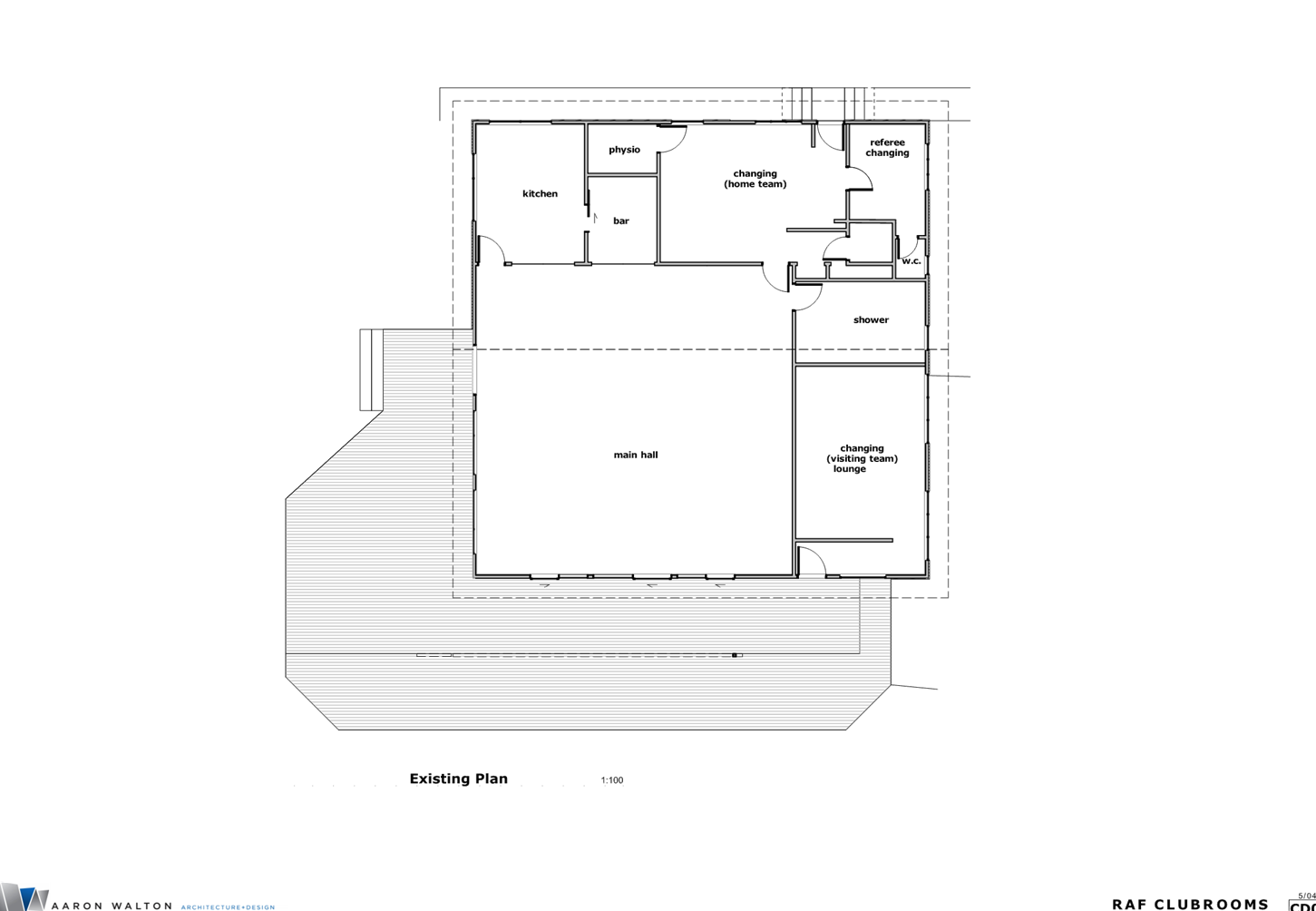
Tasman District Council Agenda – 28 March 2024
7.7 Coastal Erosion Protection Structures on
Council Reserve Land Policy
Decision Required
|
Report
To:
|
Tasman
District Council
|
|
Meeting
Date:
|
28
March 2024
|
|
Report
Author:
|
Marie
Callander, Corporate Counsel; Anna Gerraty, Senior Community & Reserves
Policy Advisor
|
|
Report
Authorisers:
|
Leonie
Rae, Chief Executive Officer
|
|
Report
Number:
|
RCN24-03-11
|
1. Purpose
of the Report / Te Take mō te Pūrongo
1.1 This
report has been prepared to:
1.1.1 provide a summary of, and enable the Council to
undertake deliberations on, all submissions received on the draft Coastal
Erosion Protection Structures on Council Reserve Land Policy (the Draft
Policy) that was publicly notified in late October 2021; and
1.1.2 seek the Council’s agreement to adopt a revised
version of the Coastal Erosion Protection Structures on Council Reserve Land
Policy (the Revised Policy), included as Attachment 1 to
this report. A marked-up version showing the changes from the Draft Policy is
included as Attachment 2 of this report.
2. Summary
/ Te Tuhinga Whakarāpoto
2.1 A
report on the Draft Policy was discussed at the Council meeting on 23 September
2021 (RCN21-09-4).
2.2 The
Draft Policy was publicly notified on the Council’s website in late
October 2021 and an article advertising the consultation opportunity was
published in Newsline on 12 November 2021. Submissions were open between 29
October and 26 November 2021.
2.3 Five
written submissions were received by the closing date. A copy of all
submissions is included as Attachment 3 to this report.
2.4 Although
the Council had resolved to form a Hearings Panel at its meeting in 2021
(RCN21-09-4), no hearing was held following receipt of the submissions.
2.5 This
report provides a summary of the submissions received on the Draft Policy and
discusses the few matters raised.
2.6 Matters
raised by submitters included:
2.6.1 Recognition of the need for, and
value of, adoption and implementation of a policy addressing the issue.
2.6.2 Opposition to the
Council’s preferred approach of soft engineering solutions and
suggestions that Council land is protected by hard structures such as rock
walls.
2.6.3 Opposition to the inference that
approval is unlikely to be granted
if the sole purpose of a coastal erosion structure is to protect property.
2.6.4 A request for an explanation of how the proposed policy would
apply to specific situations at Pakawau and Awaroa where the esplanade reserve
has eroded away.
2.6.5 A suggestion that landowners be required to pay a bond to
cover the costs of removing any structures that fail, and that the size of the
bond reflects the likely costs over time.
2.6.6 A request that Appendix 1
contains “as much as
practicable to satisfy most applications” (i.e. clearly specify all
matters that applicants need to address) and an indication of likely processing
time.
2.6.7 A request that, if the Council is at any time considering
coastal erosion protection work, the safety of little penguins/Korora is
ensured and that the protection works be notified for public
consultation.
2.7 The
Draft Policy has now been amended to include a requirement for a bond (or other
security arrangement) and generally updated to:
2.7.1 reflect changes to some of the
reserve management plans referred to in the Appendices; and
2.7.2 more clearly distinguish the
Council’s landowner role (as owner or administrator of Council reserves)
from its regulatory role; and
2.7.3 recommend that applicants
seeking to construct a coastal erosion protection structure on reserve land
seek the Council’s landowner approval before incurring the costs of
seeking any necessary resource consent.
2.8 The
Revised Policy (see Attachment 1) clarifies the wording of the document
and incorporates the request from a submitter to require landowners to provide
a bond.
2.9 Given
that:
2.9.1 no hearing was held after
submissions were received;
2.9.2 one member of the Hearings Panel
appointed in September 2021 is no longer an elected member;
2.9.3 Tasman District’s
extensive coastline is subject to coastal erosion and rising sea levels,
causing concerns for seaside communities; and
2.9.4 the consequent need for the
Council to have a Coastal Erosion Protection Structures on Council Reserve Land
policy in place to guide:
· potential applicants seeking to construct coastal erosion protection
structures on Council reserve land; and
· Council decision making when processing these applications,
staff recommend
that the Council as a whole takes on the role of the Hearing Panel to consider
and deliberate on all submissions received on the Draft Policy, and the amended
wording proposed by staff in response, before adopting the Revised Policy.
3. Recommendation/s
/ Ngā Tūtohunga
That the Tasman
District Council
1. receives
the Coastal Erosion Protection Structures on Council Reserve Land Policy
report, RCN24-03-11; and
2. notes
that, under resolutions 4 to 6 of agenda item RCN21-09-4, a Hearing Panel was
delegated the task of considering and deliberating on submissions received on
the Draft Policy and reporting recommended changes to the Draft Policy back to
Council; and
3. notes
that this Hearing Panel was never convened, no submitters requested to be
heard, and no hearing has been held on the Draft Policy; and
4. agrees
the Council as a whole will now take on the role of the Hearing Panel; and
5. considers
all submissions received on the Draft Policy, included as Attachment 3 to this
report; and
6. notes
the summary of all submissions received on the Draft Policy and recommended
response to these matters outlined in sections 4 and 5 of this report; and
7. deliberates
on the submissions received and the amended wording that has been incorporated
into the Revised Policy presented in Attachment 1 of this report; and
8. agrees
to adopt the Revised Policy [as presented in Attachment 1 of this report] OR
[subject to staff revising the policy wording as follows ….]
as the final Coastal Erosion Protection Structures on Council Reserve
Land Policy; and
9. requests staff to publish the final Policy on the
Council’s website.
Development
a draft Coastal Erosion Protection Structures on Council Reserve Land Policy
4.1 A
report on this topic, with the Draft Policy appended, was discussed at the
Council meeting on 23 September 2021 (RCN21-09-4). That report is available to
view online at: https://tasman.infocouncil.biz/Open/2021/09/CN_20210923_AGN_4005_AT_WEB.htm.
4.2 The
report, authored by Mr Hollier (the Council’s former Reserves &
Facilities Manager), noted that:
i. The Council has, for several years, been
grappling with the issue of whether, from a landowners’ perspective,
coastal erosion protection structures can be established on reserve land.
ii. This is an incredibly complicated area for the
Council, with many competing factors to be considered.
iii. There have been requests from many landowners to
build structures on Council reserves, to protect these reserves from further
coastal erosion – thereby protecting adjacent private property from
coastal erosion.
iv. A draft Coastal Erosion Protection Structures on Council
Reserve Land Policy (the Draft Policy) was developed to provide some
clarity for both the Council, in its role as decision maker, and for applicants
on how to apply (and the information required as part of an application so that
applicants may put their best foot forward).
v. The landowner approval process needs to consider
several factors – some of these are matters of law and fact and others
are matters of policy. Not all these matters are aligned and so a hierarchy of
factors that need to be considered has been developed so that legalities can be
considered before considering matters of policy.
4.3 The
complexity identified by Mr Hollier, and the varying situations of the
applicants for landowner approval, mean that it is essential that the Council
has an appropriate policy in place and that the policy is followed by those
making decisions on applications, to reduce the risk for the Council of its
decisions being challenged in the courts.
4.4 The
minutes of the Council meeting held on 23 September 2021 (RCN21-09-4) state:
Moved Cr
Hill/Cr Butler
CN21-09-7
That the
Full Council
1. receives the draft Coastal
erosion protection structures on Council Reserve Land Policy RCN21-09-4 report;
and
2. adopts the draft Coastal
Erosion Protection Structures on Council Reserve Land Policy contained in
Attachment 1 to this report dated March 2021 as a draft for community
consultation; and
3. agrees to publicly notify the
draft policy for a period of four (4) weeks; and
4. delegates the task of hearing
and considering submissions on the draft policy to a Hearings Panel; and
5. appoints a Hearings Panel
consisting of Councilors Maling (Chair), Hill and, Mackenzie and Ogilvie plus a
mātauranga Māori representative appointed by the Mayor, with the
Chair having the ability to appoint another Councilor should a member of the
panel be unavailable; and
6. agrees that the Hearing Panel
will report back to the Council with recommendations on changes to the draft
policy, for a decision around its adoption.
CARRIED
4.5 The
Draft Policy was publicly notified on the Council’s website in late
October 2021 and an article advertising the consultation opportunity was
published in Newsline on 12 November 2021. Submissions were open between 29
October and 26 November 2021.
4.6 Although
the Council had resolved to form a Hearings Panel at its meeting in 2021
(RCN21-09-4), no hearing was held following receipt of the submissions.
Summary of submissions
4.7 Five
written submissions were received by the closing date. A copy of all
submissions received is included as Attachment 3 to this report.
4.8 Matters
raised by submitters included:
4.8.1 Recognition of the need for, and
value of, adoption and implementation of a policy addressing the issue.
4.8.2 Opposition to the
Council’s preferred approach of soft engineering solutions and
suggestions that Council land is protected by hard structures such as rock
walls.
4.8.3 Opposition to the inference that
approval is unlikely to be granted
if the sole purpose of a coastal erosion structure is to protect property.
4.8.4 A request for an explanation of how the proposed policy would
apply to specific situations at Pakawau and Awaroa where the esplanade reserve
has eroded away.
4.8.5 A suggestion that landowners be required to pay a bond to
cover the costs of removing any structures that fail, and that the size of the
bond reflects the likely costs over time.
4.8.6 A request that the relevant
appendix to the policy contains “as much as practicable to satisfy most applications”
(i.e. clearly specify all matters that applicants need to address) and an
indication of likely processing time.
4.8.7 A request that, if the Council is at any time considering
coastal erosion protection work, the safety of little penguins/Korora is
ensured and that the protection works be notified for public
consultation.
4.9 Staff
have analysed these submission points and prepared recommended responses to
these for the the Council’s consideration in section 5 of this report.
5. Analysis
and Advice / Tātaritanga me ngā tohutohu
5.1 One
submitter opposed the Council’s preferred approach of soft engineering
solutions and requested this wording be deleted from the policy, as they
believe such an approach is unlikely to be effective. Staff do not recommend
that this change be made, as it would be inconsistent with the New Zealand
Coastal Policy Statement and other plans and policies of Council relating to
coastal erosion which specify that soft engineering solutions are preferred.
5.2 The
same submitter also requested that the policy include examples of how the
policy would be applied to specific situations such as at Pakawau and Awaroa.
Given the variation, complexity and constant changing nature of our coastline,
staff do not recommend that this change be made as each application for
landowner consent must be treated individually on its own merits and in its own
context. The Revised Policy cannot anticipate all possibilities, so it would be
unsafe to set out examples that may apply in one context but set an
inappropriate precedent for how the Revised Policy would be applied in another
context.
5.3 The
submitter suggestion that a bond requirement be added into the Draft Policy has
been actioned (see Step 6 Liability and Risk on page 16 of the Revised Policy
in Attachment 1). Staff recommend adopting this suggestion to ensure that
there is a fund available to cover any maintenance and or claims made against
the Council due to end wall effects that may arise as a result of the
construction of a coastal erosion protection structure being constructed or
failing. The Draft Policy provided for the landowners constructing a coastal
erosion protection structure to be liable for any damage caused by such a
structure and to indemnify Council against any such claims. However, the Draft
Policy did not provide for any security to support that indemnity. Where the
landowners cannot or will not pay, the Council/ratepayers could be exposed to
significant costs in the future if a coastal erosion protection structure
failed or caused harm to other properties (especially if those properties are
high value properties).
5.4 Another
submitter emphasised the importance of the Appendix (by which we take the
submitter to be referring to Appendix 2 which contains the application form)
containing as much as practicable to satisfy most applications, hence avoid the
need for requests for further information. As part of updating the Revised
Policy, we have reviewed Appendix 2 and made some changes to improve clarity,
but the uniqueness of each application is likely to mean that there will be
requests for further information as we cannot anticipate the level/standard of
information that will be provided by each applicant or all of the unique issues
that each particular location and context may raise.
5.5 That
submitter also requested an indication of how long it would take for Council
staff to process an application be included in the policy. Given the complexity
of information that may be required, and the limited number of landowner
consent applications for coastal erosion protection structures that are
received, it is not possible to predict a likely/reasonable processing time.
Accordingly, staff recommend that such an indication not be included.
5.6 Two
submitters requested that the policy ensures protection of Korora/little blue
penguins, and one requested that any application for landowner consent be
notified for public consultation. Step 4 on page 12 of the Revised Policy (see
Attachment 1) sets out the requirement to consider potential adverse effects,
which may include any impacts on penguins. The Local Government Act 2002 (LGA)
principles govern whether the Council should undertake a consultation process
(see Step 8 of the Revised Policy in Attachment 1). Any decision to undertake
consultation will need be taken on a case-by-case basis in accordance with
those LGA principles. Accordingly, staff do not recommend that the policy
include a requirement to consult on every application for landowner consent as
that may not be consistent with the LGA principles.
5.7 Based
on the analysis of submissions, staff have amended the Draft Policy to include
a requirement for a bond (or other security arrangement). The document text has
also been updated to:
5.7.1 reflect changes to some of the
reserve management plans referred to in the Appendices;
5.7.2 more clearly distinguish
Council’s landowner role (as owner or administrator of Council reserves)
from its regulatory role; and
5.7.3 recommend that applicants
seeking to construct a coastal erosion protection structure on reserve land
seek the Council’s landowner approval before incurring the costs of
seeking any necessary resource consent.
5.8 To
summarise, the Revised Policy (see Attachment 1) clarifies the wording
of the document and incorporates the request from a submitter to require
landowners to provide a bond.
6.1 Given
that:
6.1.1 no hearing was held after
submissions were received;
6.1.2 one member of the Hearings Panel
appointed in September 2021 is no longer an elected member;
6.1.3 Tasman District’s
extensive coastline is subject to coastal erosion and rising sea levels,
causing concerns for seaside communities; and
6.1.4 the consequent need for the Council
to have a Coastal Erosion Protection Structures on Council Reserve Land policy
in place to guide:
· potential applicants seeking to construct coastal erosion protection
structures on Council reserve land; and
· Council decision making when processing these applications,
staff recommend
that the Council as a whole takes on the role of the Hearing Panel to consider
and deliberate on all submissions received on the Draft Policy, and the amended
wording proposed by staff in response, before adopting the Revised Policy.
6.2 The options are outlined in the
following table:
|
Option
|
Advantage
|
Disadvantage
|
|
1.
|
That the Council as a whole takes on the
role of the Hearing Panel to consider and deliberate on all submissions
received on the Draft Policy, and the amended wording proposed by staff in
response, before adopting the Revised Policy. Note that the Revised Policy contains amended wording recommended by staff based on
submissions, and to deal with the changes in reserve management plans and to
provide greater clarity around Council’s role as landowner.
|
A policy will be adopted and implemented,
providing much-needed guidance to both applicants and Council staff
responsible for processing and decision-making on applications for
construction of coastal erosion protection structures on Council reserve land.
|
None. Given the few submissions received
on the Draft Policy, adoption of the Revised Policy which incorporates
submitter feedback and updates and clarifies content, providing consistency
with relevant reserve management plans, is necessary and appropriate.
|
|
2.
|
That the Council delegates the task of
considering and deliberating on submissions received on the Draft Policy and
reporting recommended changes to the Draft Policy back to Council to a
Hearing Panel. Note that one member of the original Hearing Panel is no
longer an elected member, hence a new panel would need to be appointed.
|
This would align with the resolutions of
the Council made in September 2021.
|
This would delay adoption of a final
policy and increase the risk of challenge to the Council decision making
around coastal erosion protection structures on Council reserve land.
|
|
3.
|
Not adopt the Draft Policy
|
None
|
Increased risk of challenge to the
Council decision making around coastal erosion protection structures on
Council reserve land.
|
6.3 Option 1 is recommended.
7.1 The Reserves Act 1977 governs activities
on Council owned/administered reserves and the LGA sets out requirements for
Council decision making.
7.2 The Revised Policy has been prepared to
reflect the requirements of the Reserves Act and the LGA.
8. Iwi
Engagement / Whakawhitiwhiti ā-Hapori Māori
8.1 Iwi were contacted around the time of
the public notification of the Draft Policy and those who responded were
supportive of the Draft Policy since it specifically provides for their active
involvement in relation to each application for Council’s landowner
consent.
9. Significance
and Engagement / Hiranga me te Whakawhitiwhiti ā-Hapori Whānui
9.1 The significance of engagement is
generally low but may be greater for some coastal communities.
|
|
Issue
|
Level of
Significance
|
Explanation of Assessment
|
|
1.
|
Is there a high level
of public interest, or is decision likely to be controversial?
|
low
|
Only five submissions
were received. There will be greater interest in coastal communities (e.g.
some residents of Pakawau and Awaroa).
|
|
2.
|
Are there impacts on
the social, economic, environmental or cultural aspects of well-being of the
community in the present or future?
|
low
|
|
|
3.
|
Is there a
significant impact arising from duration of the effects from the decision?
|
No
|
|
|
4.
|
Does the decision
relate to a strategic asset? (refer Significance and Engagement Policy for
list of strategic assets)
|
No
|
|
|
5.
|
Does the decision
create a substantial change in the level of service provided by Council?
|
No
|
|
|
6.
|
Does the proposal,
activity or decision substantially affect debt, rates or Council finances in
any one year or more of the LTP?
|
No
|
|
|
7.
|
Does the decision
involve the sale of a substantial proportion or controlling interest in a CCO
or CCTO?
|
No
|
|
|
8.
|
Does the
proposal or decision involve entry into a private sector partnership or
contract to carry out the deliver on any Council group of activities?
|
No
|
|
|
9.
|
Does the proposal or
decision involve Council exiting from or entering into a group of
activities?
|
No
|
|
|
10.
|
Does the proposal
require particular consideration of the obligations of Te Mana O Te Wai
(TMOTW) relating to freshwater and Affordable Waters services?
|
No
|
|
10. Communication
/ Whakawhitiwhiti Kōrero
10.1 Once the Revised Policy is adopted, staff will add
details into the document about the process used to create and adopt the policy
as contemplated on page 23 of the Revised Policy. It will then be published on
the Council’s website and have immediate effect.
11. Financial
or Budgetary Implications / Ngā Ritenga ā-Pūtea
11.1 The costs associated with public notification and
receiving submissions were absorbed within the Reserves & Facilities
budget.
11.2 There are no financial or budgetary implications
of adopting the Revised Policy.
12.1 Adopting
the Revised Policy is a low-risk decision which will assist in mitigating the
risks posed for the Council due to sea level rise.
12.2 Tasman
District’s extensive coastline means that, without a policy in place
around coastal erosion protection structures on Council reserve land:
12.2.1 if the Council makes any decision not to
give its landowner consent to construct coastal erosion protection structures
or to impose conditions on such consent that the applicants find unacceptable,
the Council is more likely to be exposed to challenges from landowners; and
12.2.2 if any landowner challenge to a Council
involved judicial review proceedings, the Council would be in a much safer
position if it has a policy in place and it can show that it has followed that
policy in its decision-making.
13. Climate
Change Considerations / Whakaaro
Whakaaweawe Āhuarangi
13.1 The Revised Policy is a direct response to the need
to deal with the implications of climate change on sea levels and inundation
and erosion of coastal reserves.
14. Alignment
with Policy and Strategic Plans / Te Hangai ki ngā aupapa Here me ngā
Mahere Rautaki Tūraru
14.1 The Revised Policy is consistent with the TRMP and
takes account of relevant reserve management plans.
14.2 The process of approving the Draft Policy for
consultation, and public consultation on that Draft Policy, was undertaken in
accordance with the Reserves Act 1977 and the Local Government Act 2002.
15. Conclusion
/ Kupu Whakatepe
15.1 Staff recommend that the Council as a whole takes
on the role of the Hearing Panel to consider and deliberate on all submissions
received on the Draft Policy, and the amended wording proposed by staff in
response, before adopting the Revised Policy.
16. Next
Steps and Timeline / Ngā Mahi Whai Ake
16.1 Once the Revised Policy is adopted, staff will finalise the Revised
Policy document in accordance with the resolutions of this meeting and publish
it on the Council’s website.
|
1.⇩
|
Revised
Policy
|
129
|
|
2.⇩
|
Revised
Policy (marked up version)
|
168
|
|
3.⇩
|
Submissions
received on draft Coastal Erosion Protection Structures on Council Reserve
Land Policy (2021)
|
209
|
Tasman District
Council
Agenda – 28 March 2024
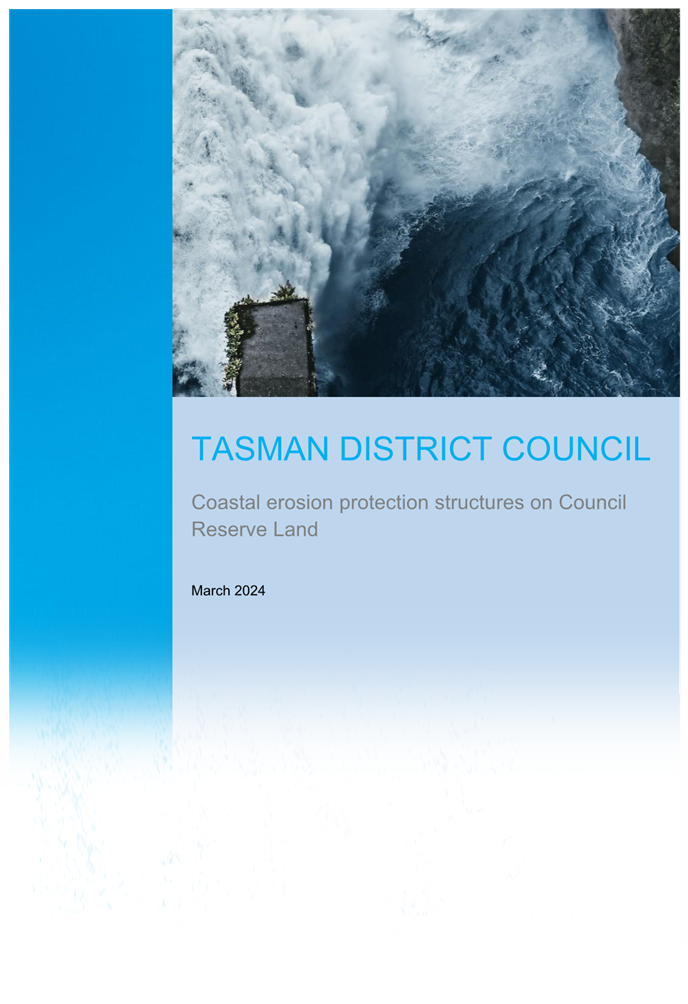
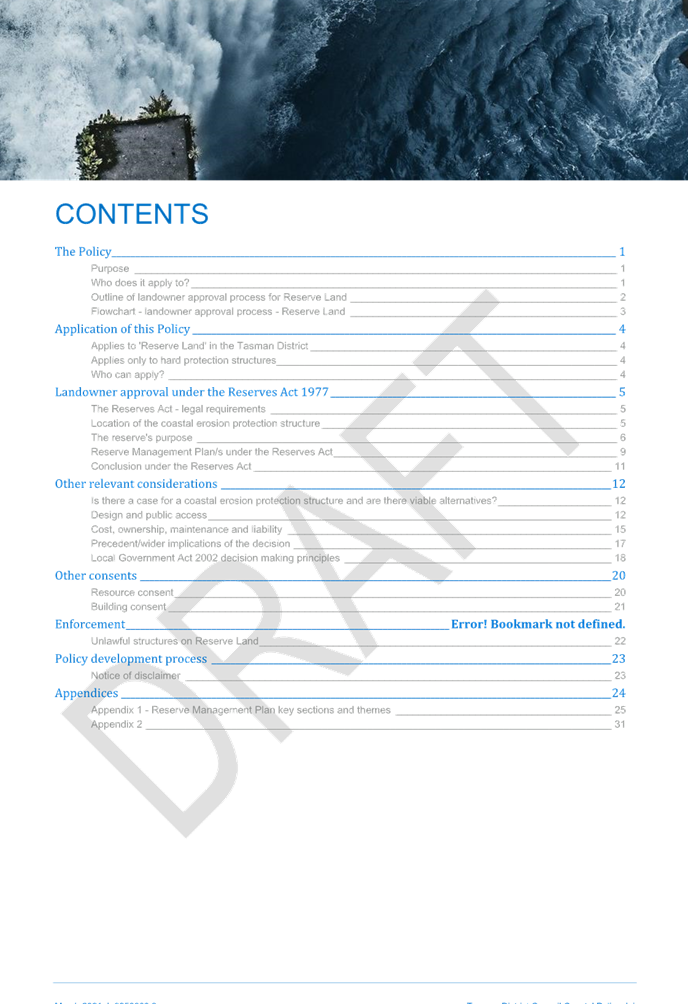
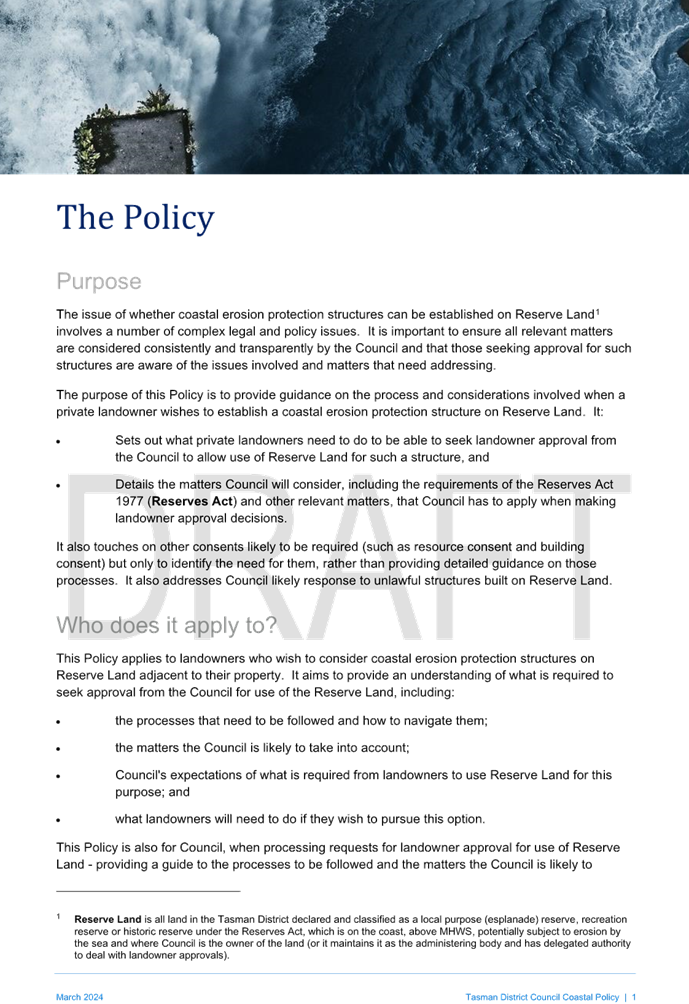
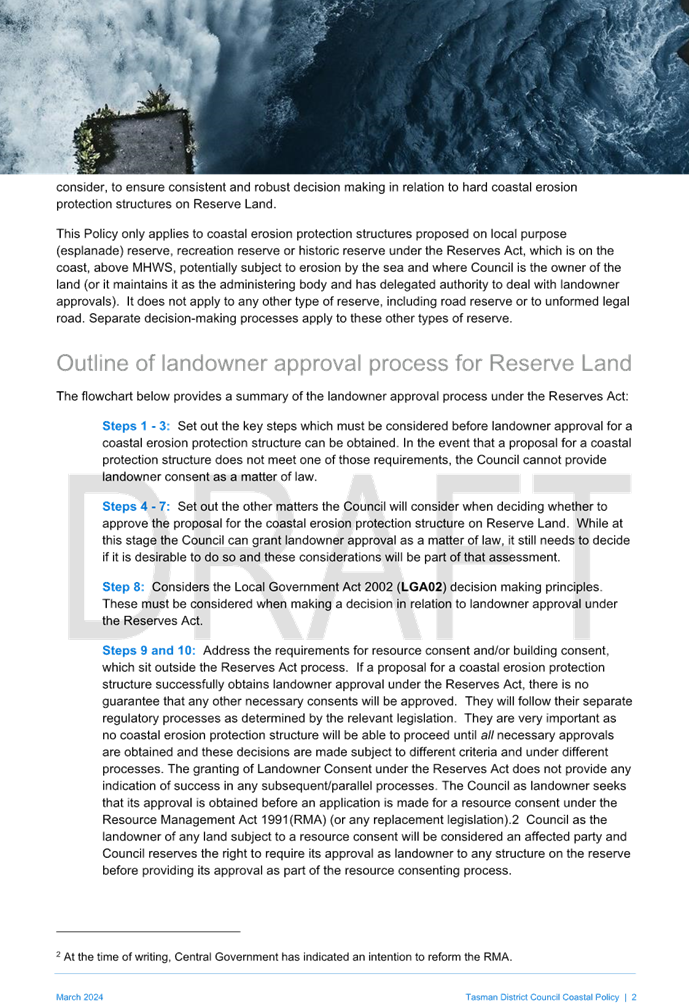
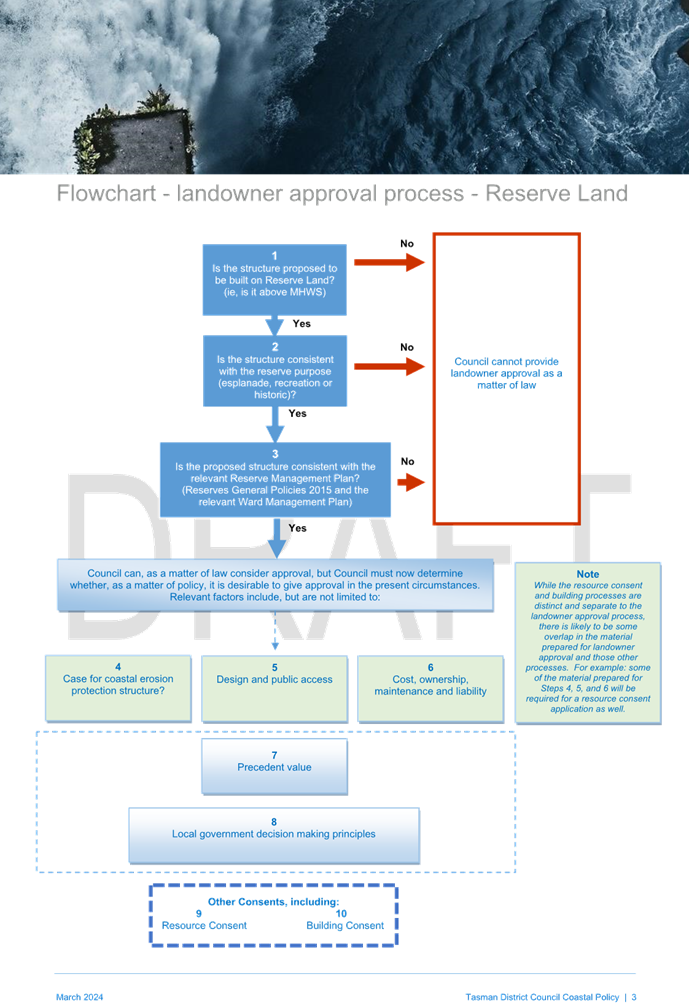



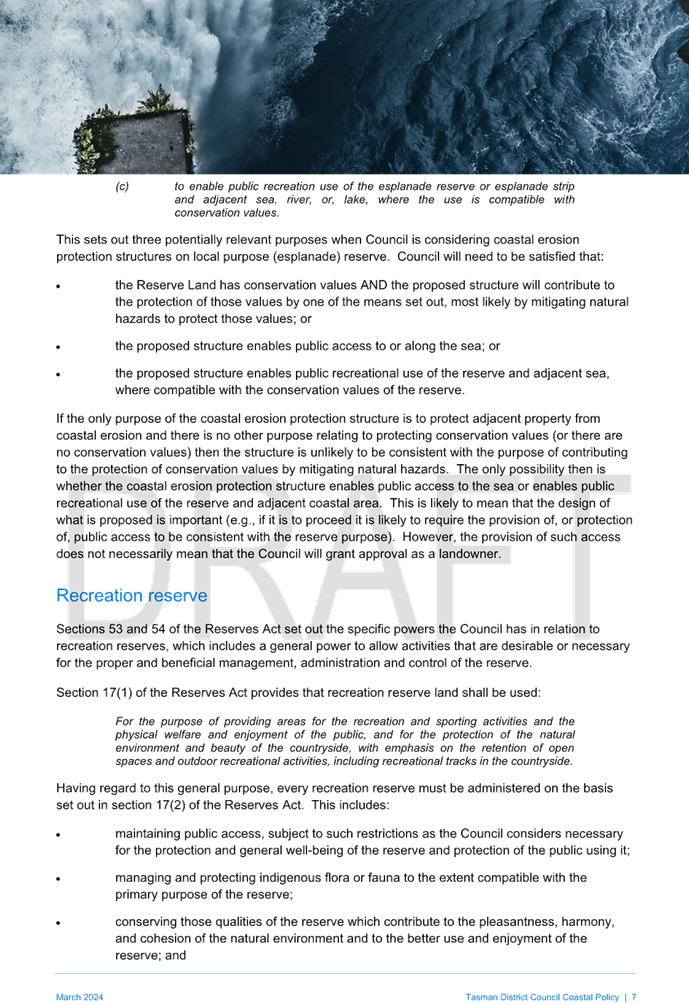

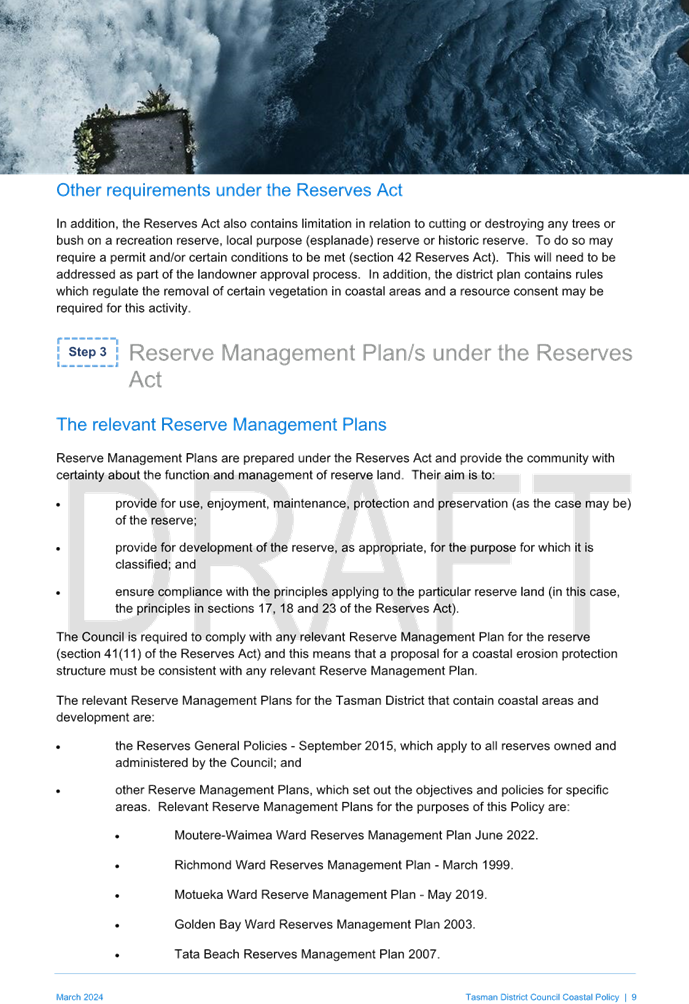
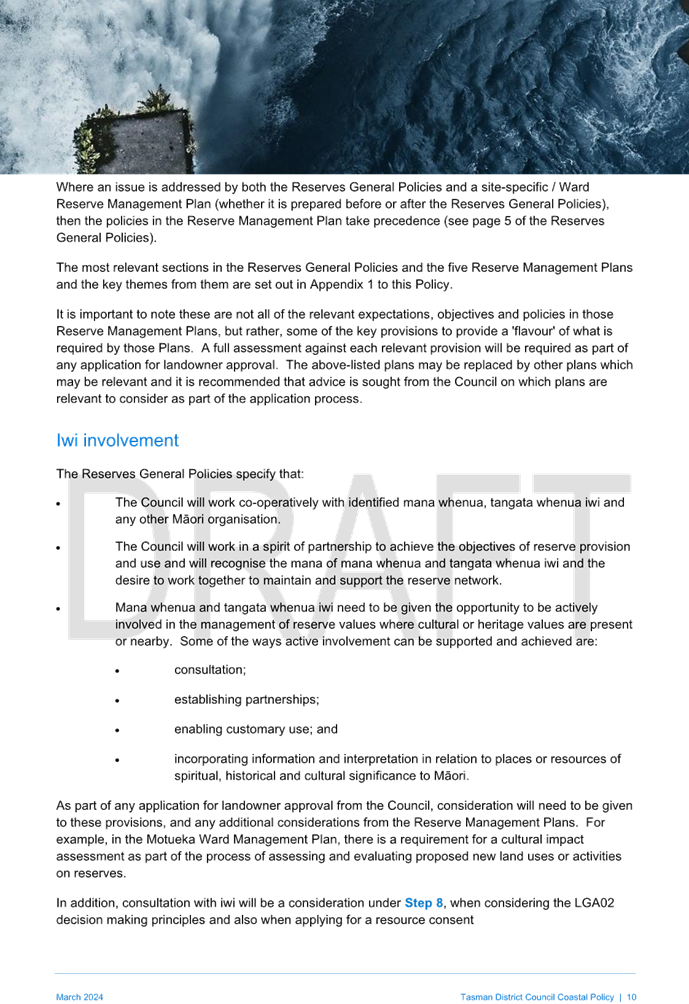
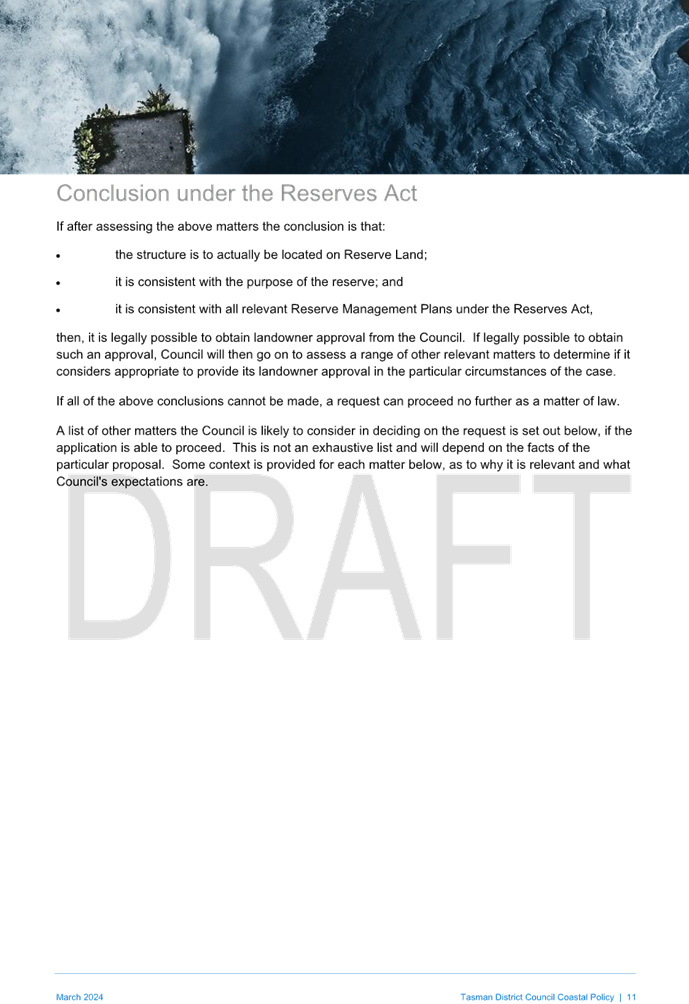

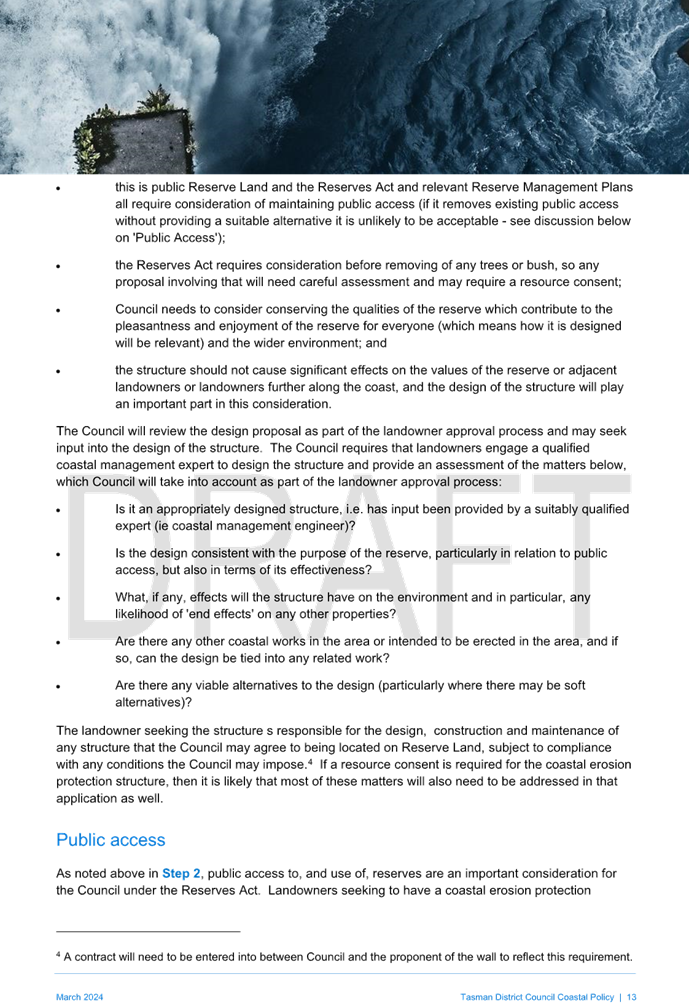
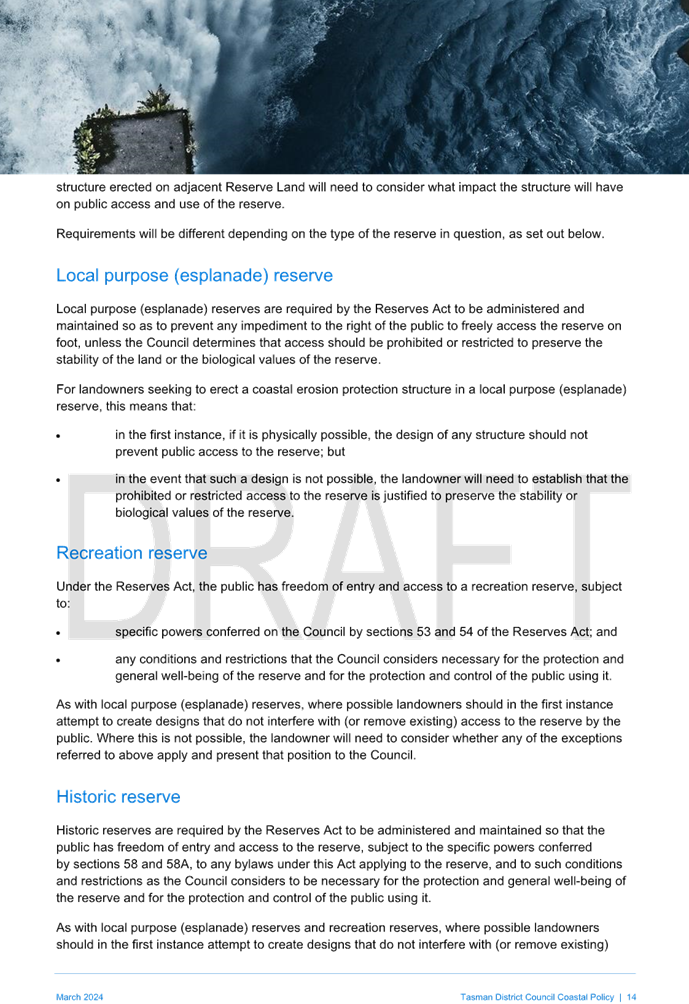
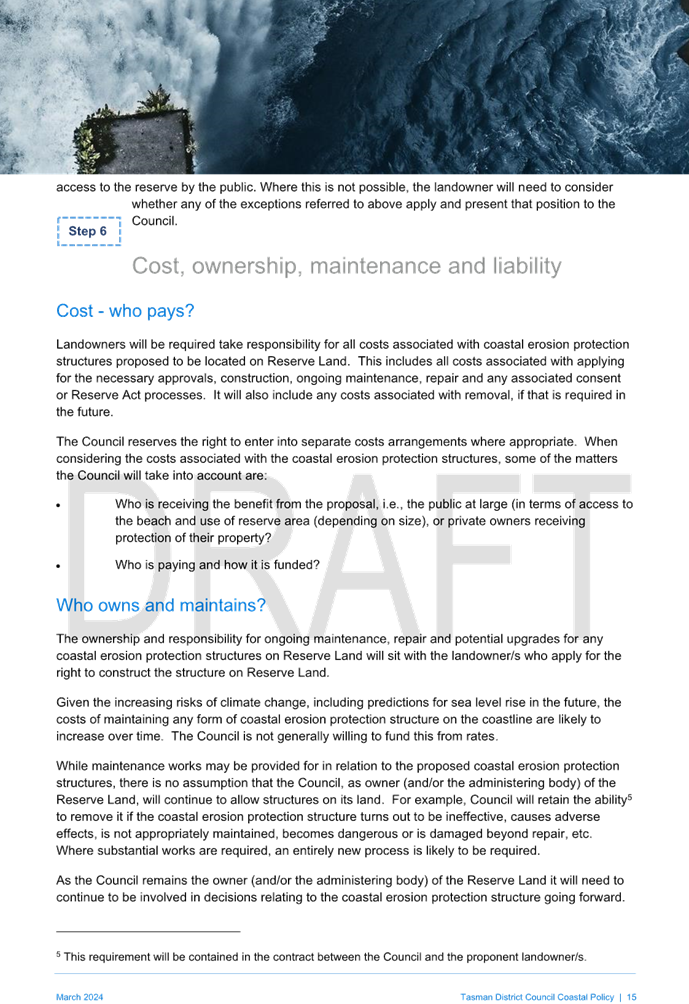
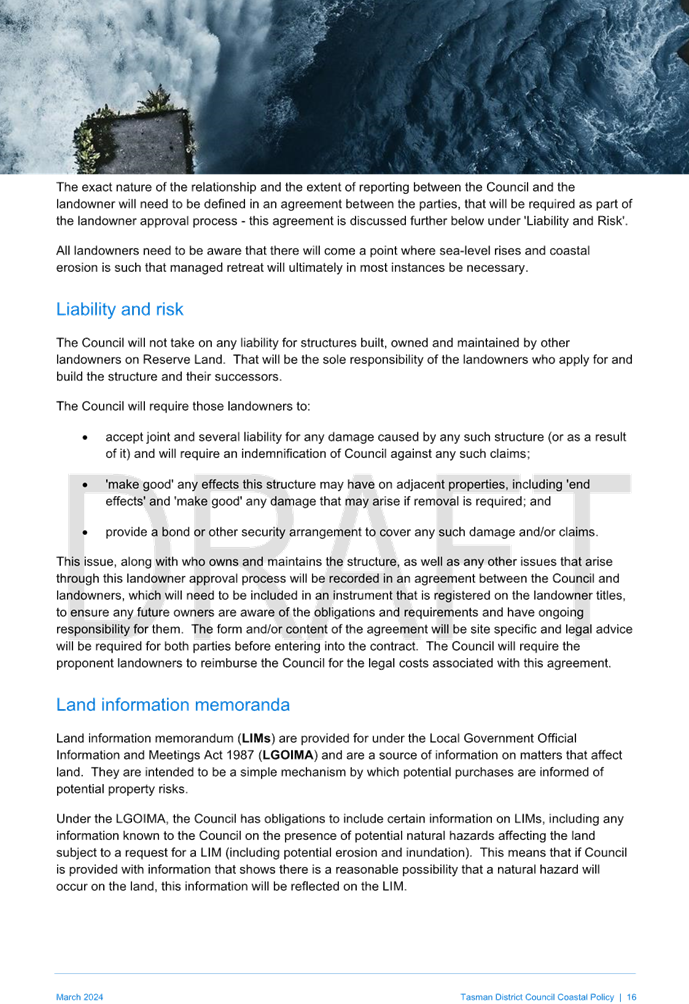
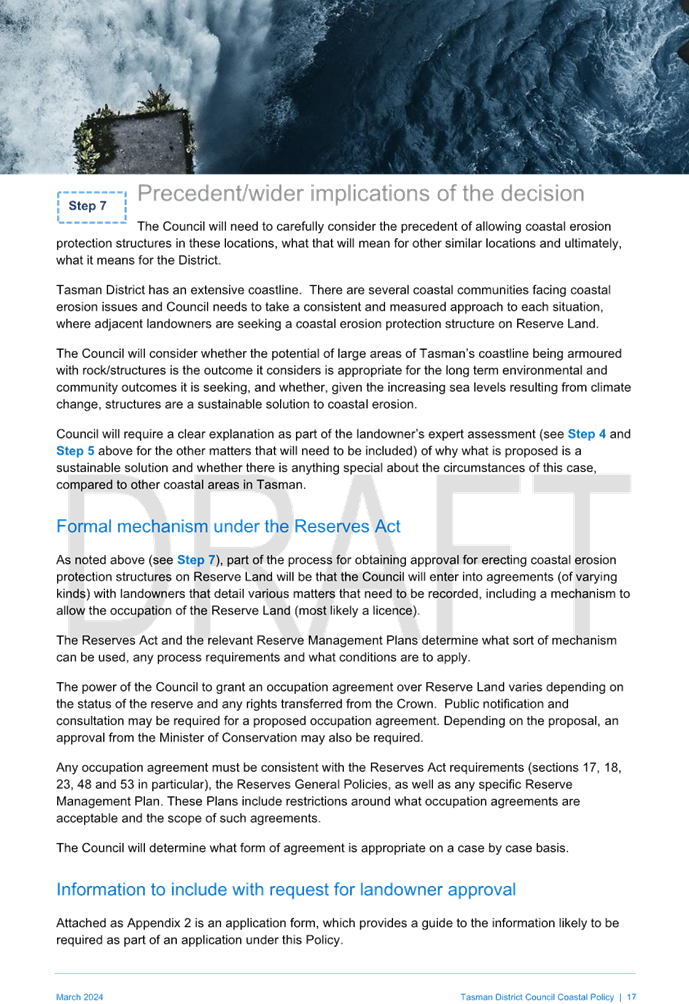

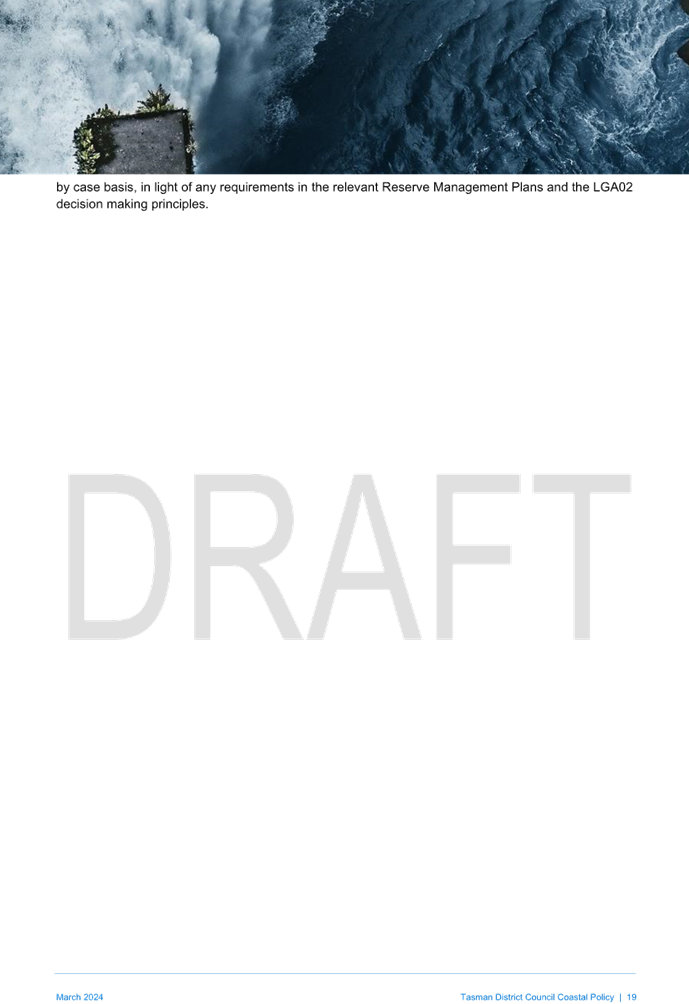
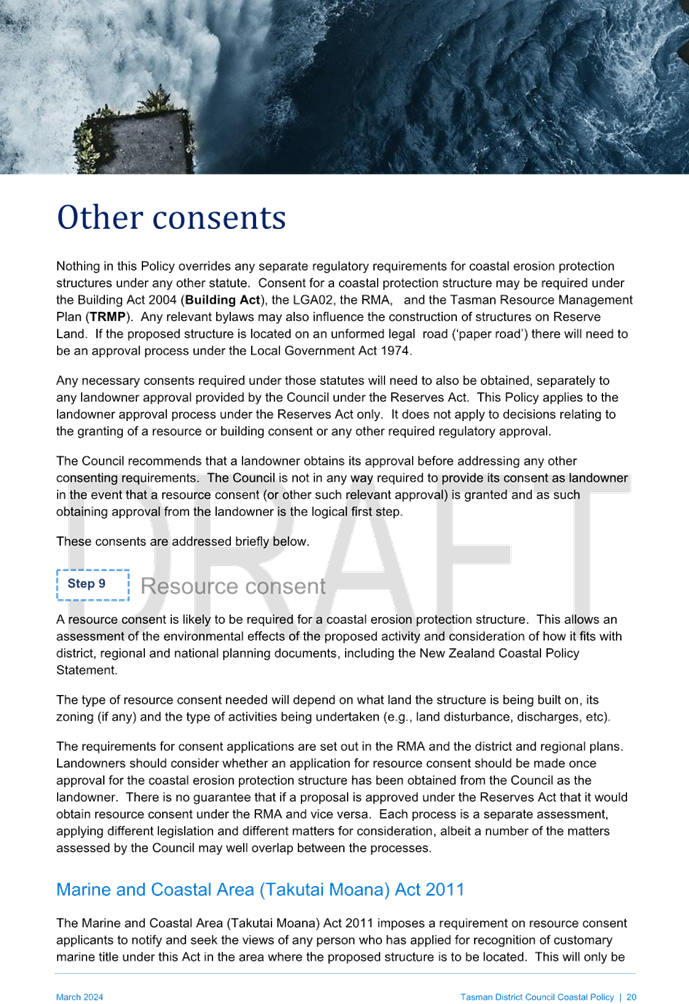
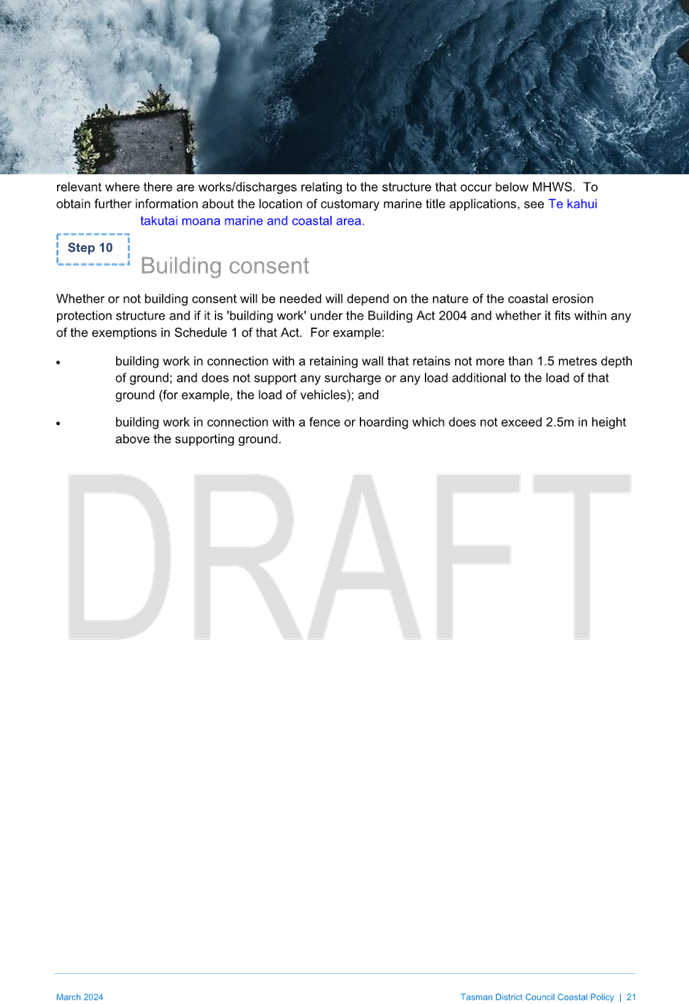

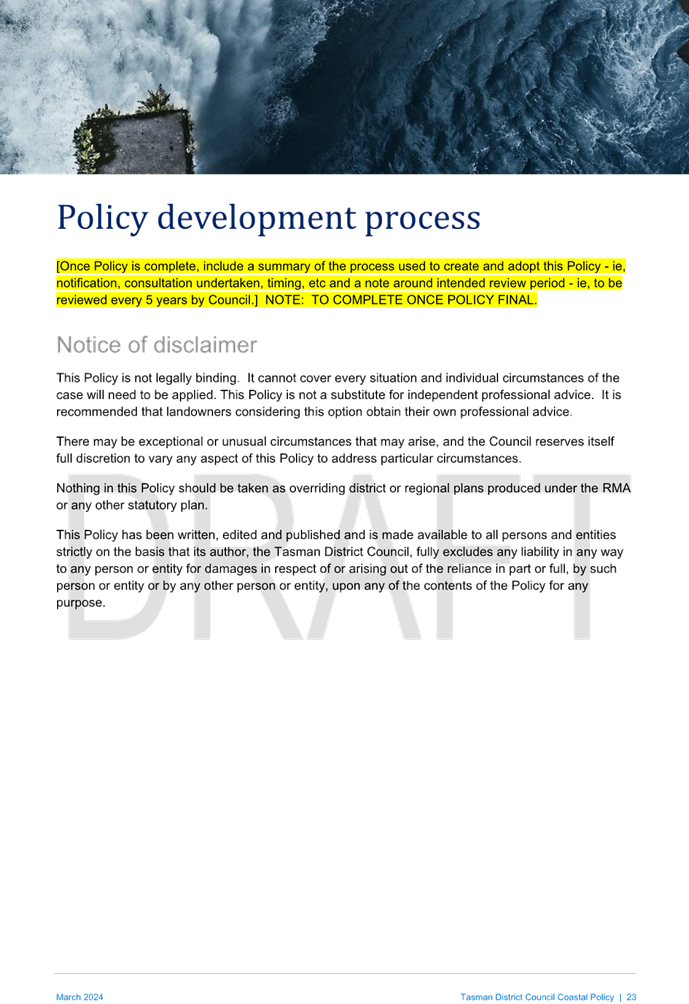
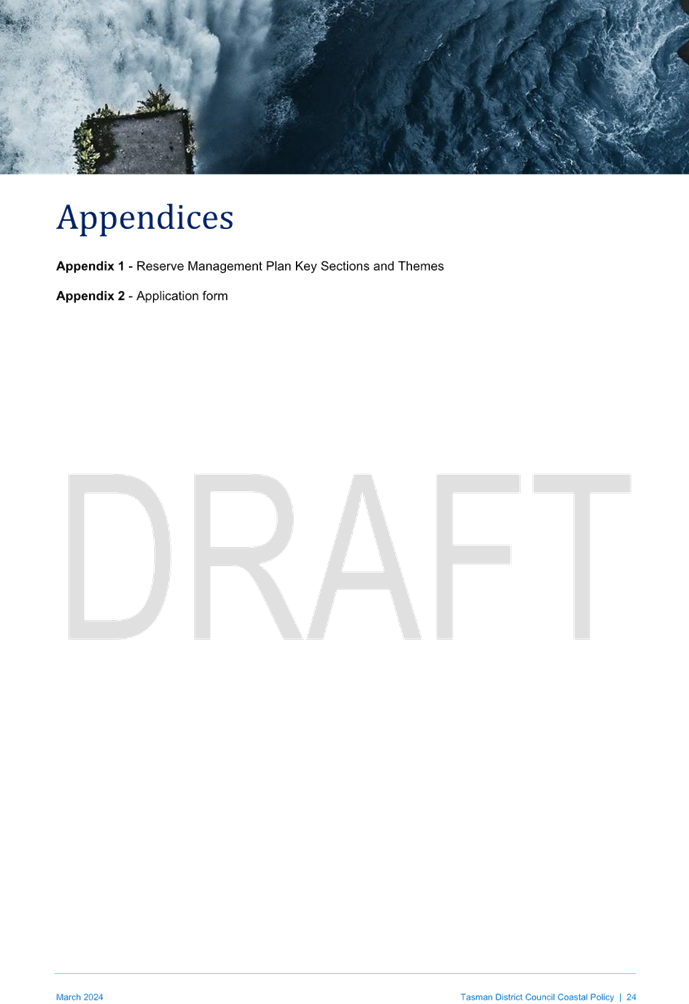
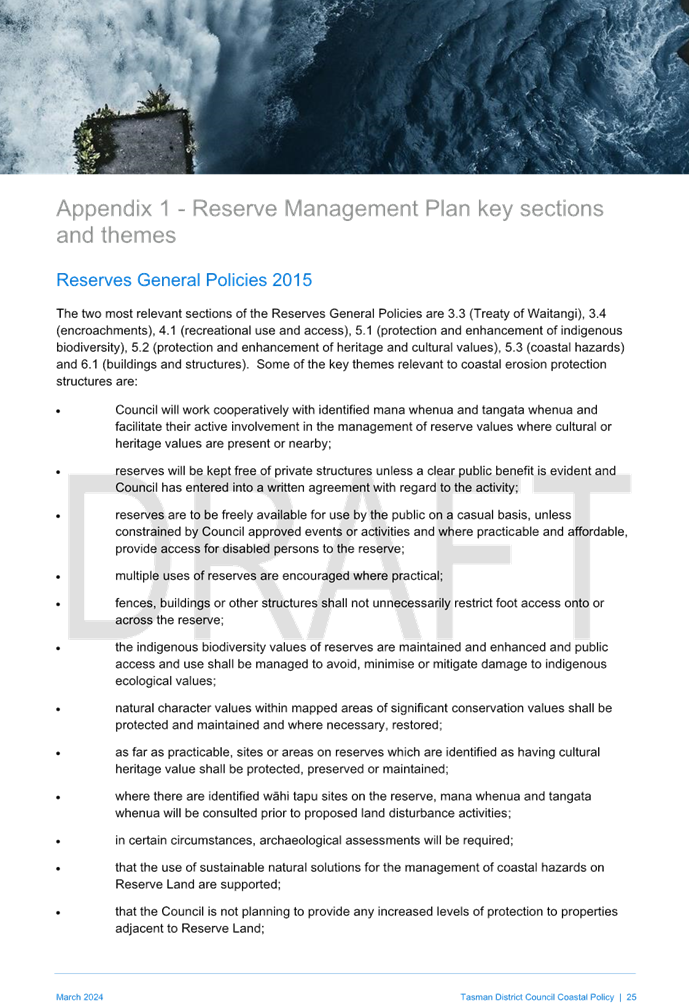
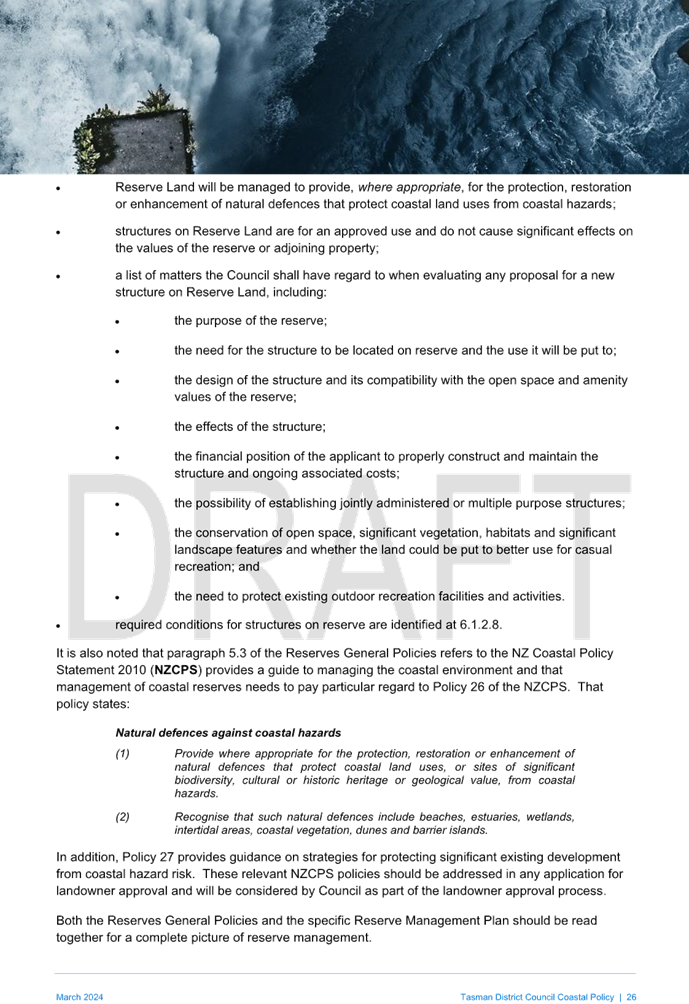
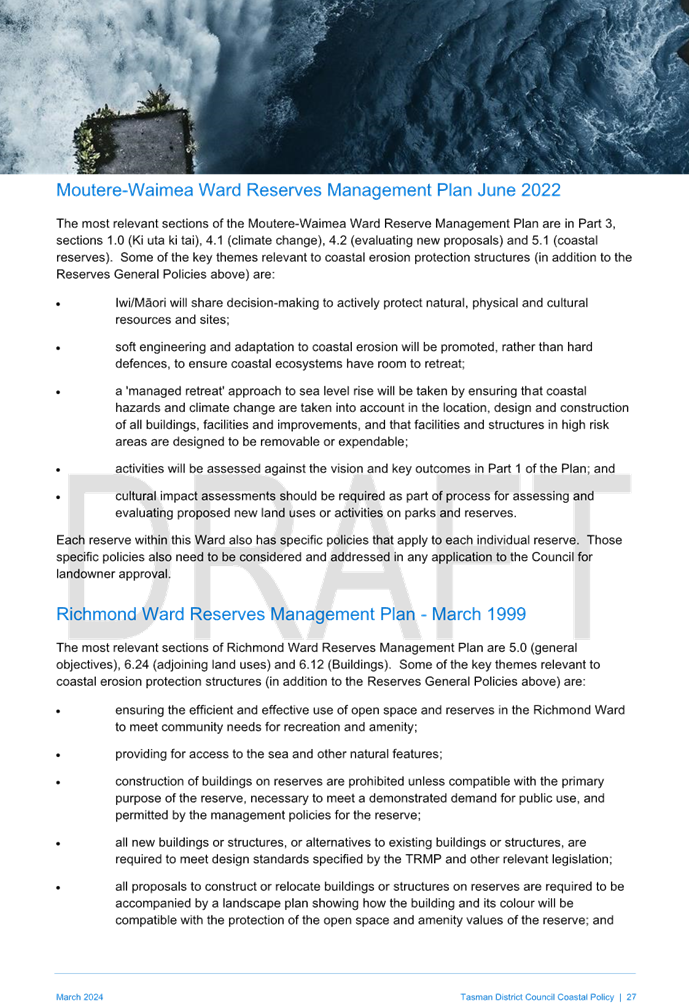
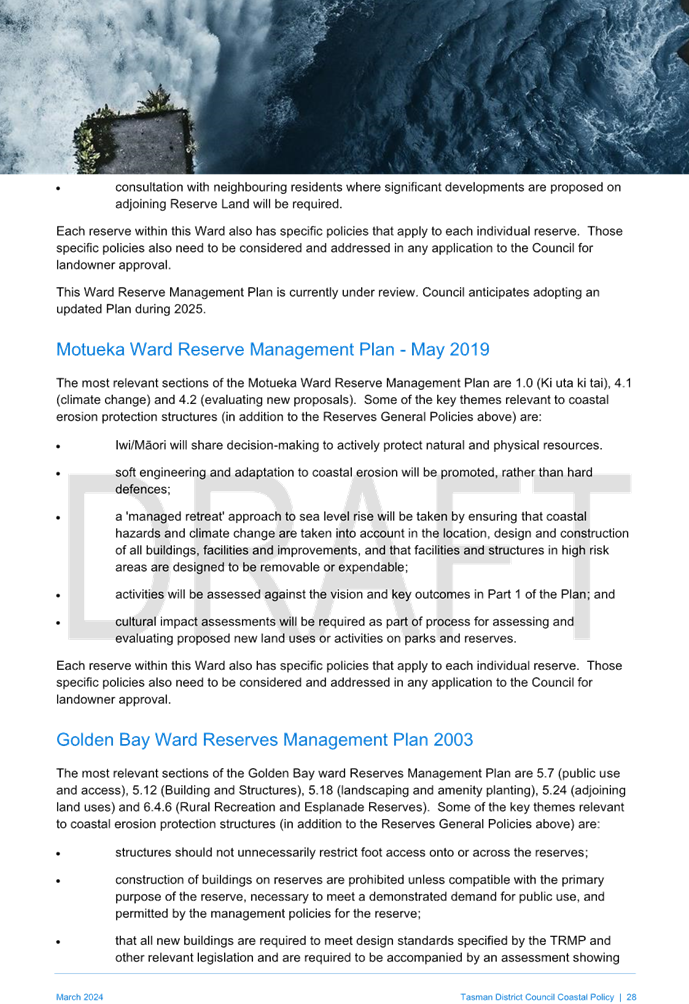
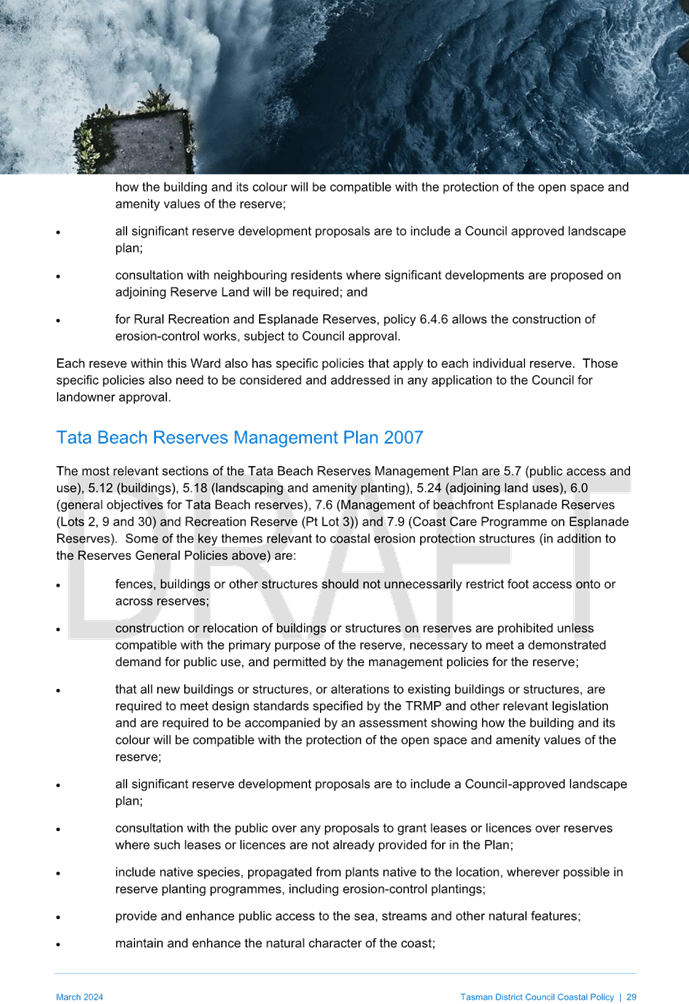
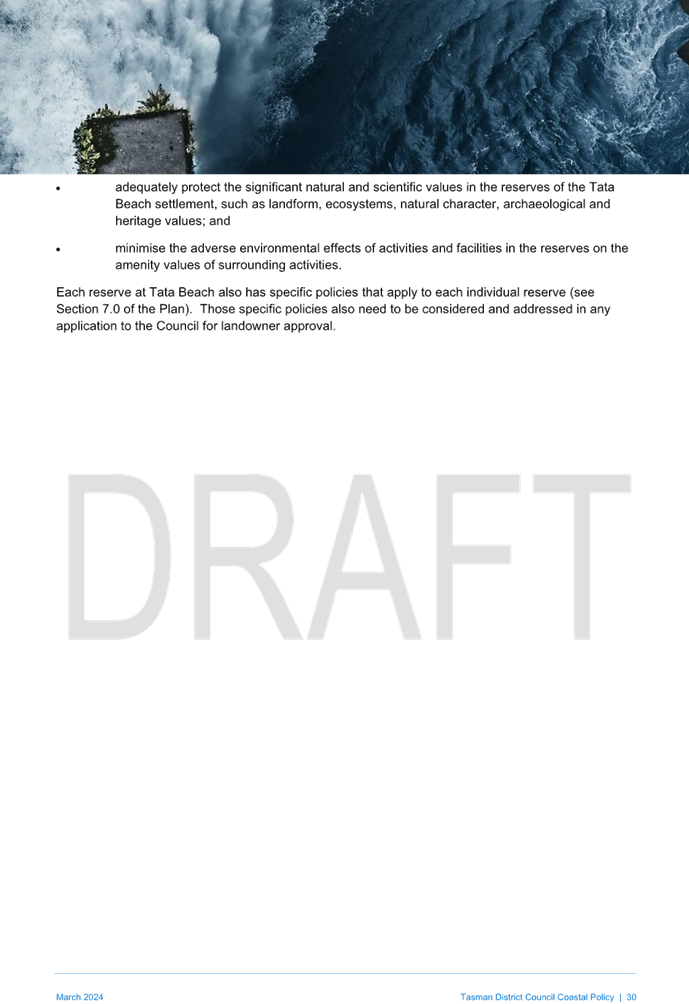

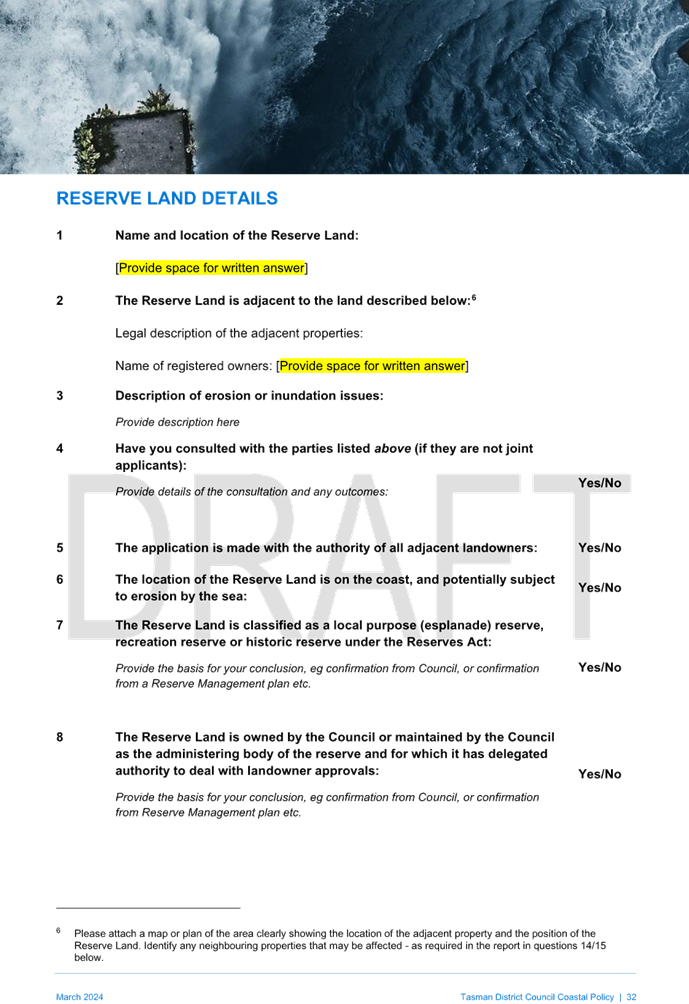
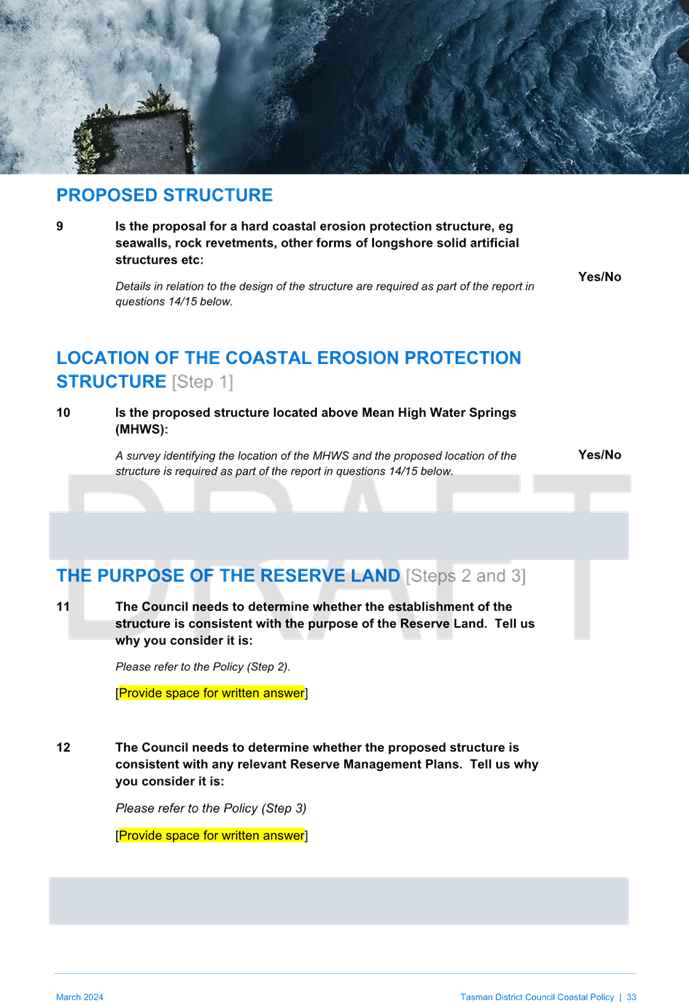
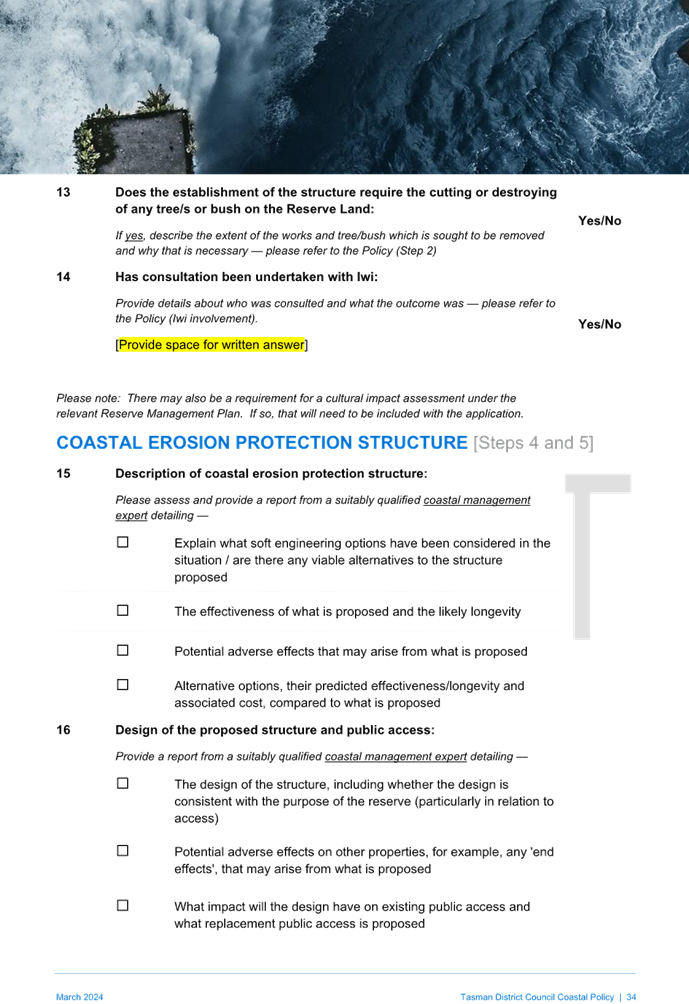
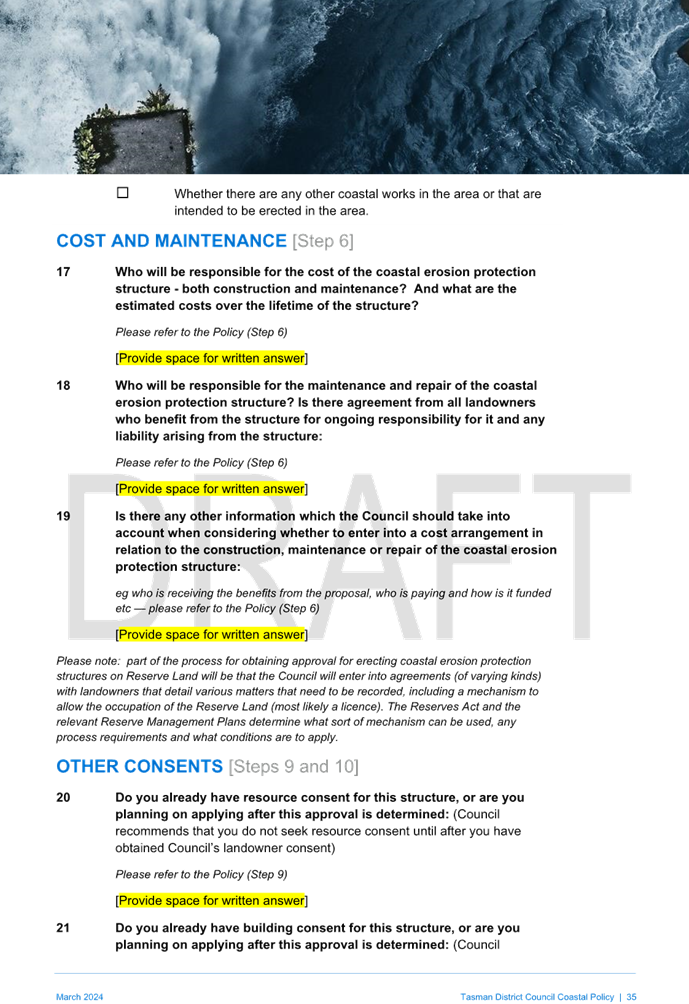
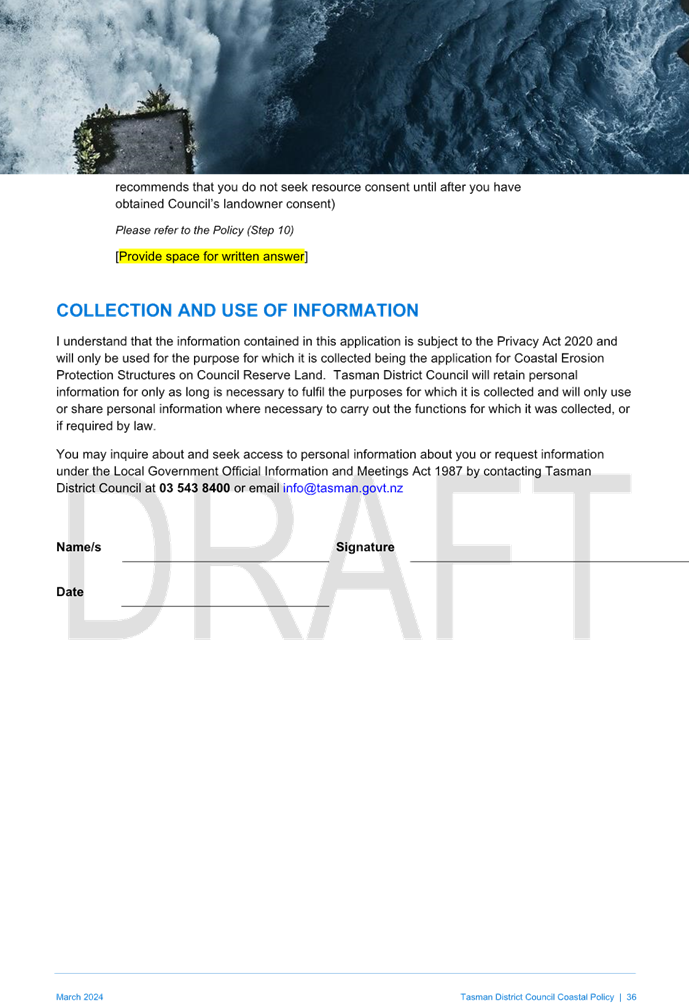
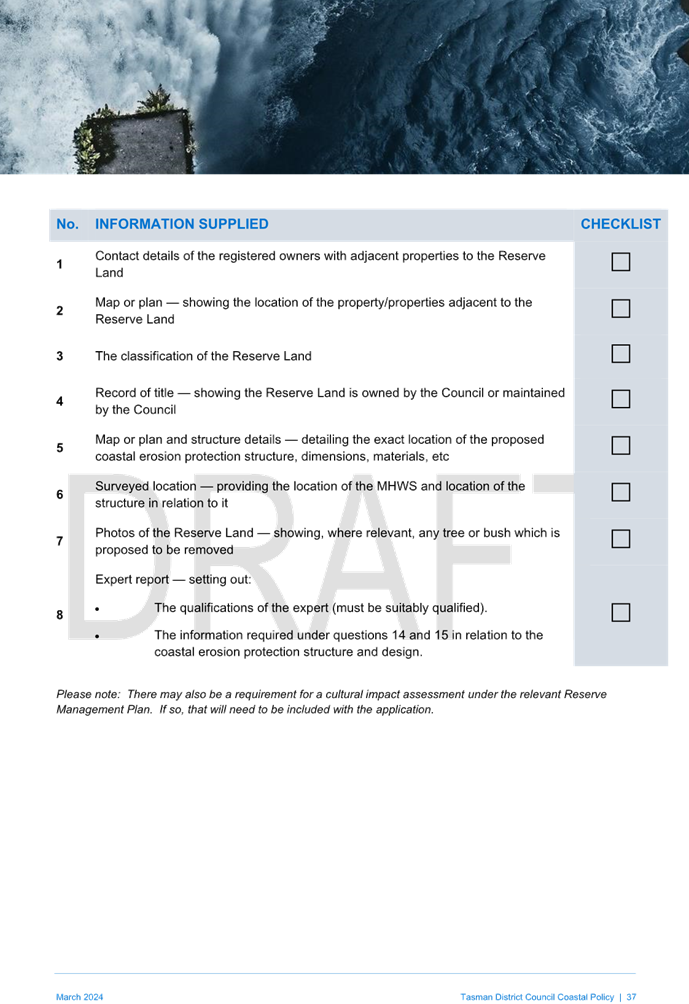
Tasman District Council Agenda – 28 March 2024
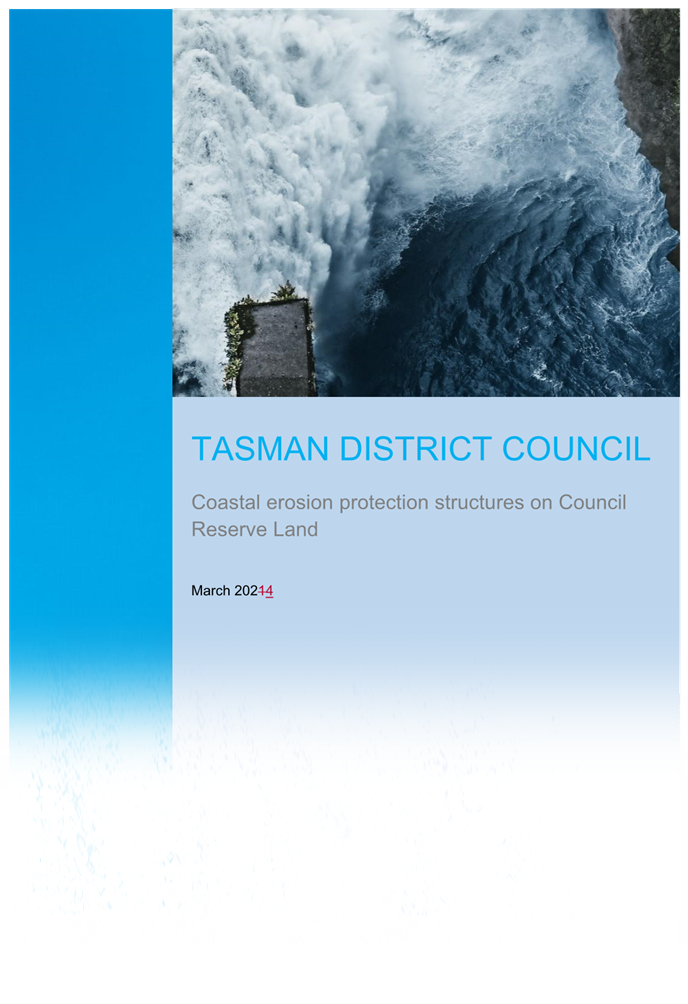
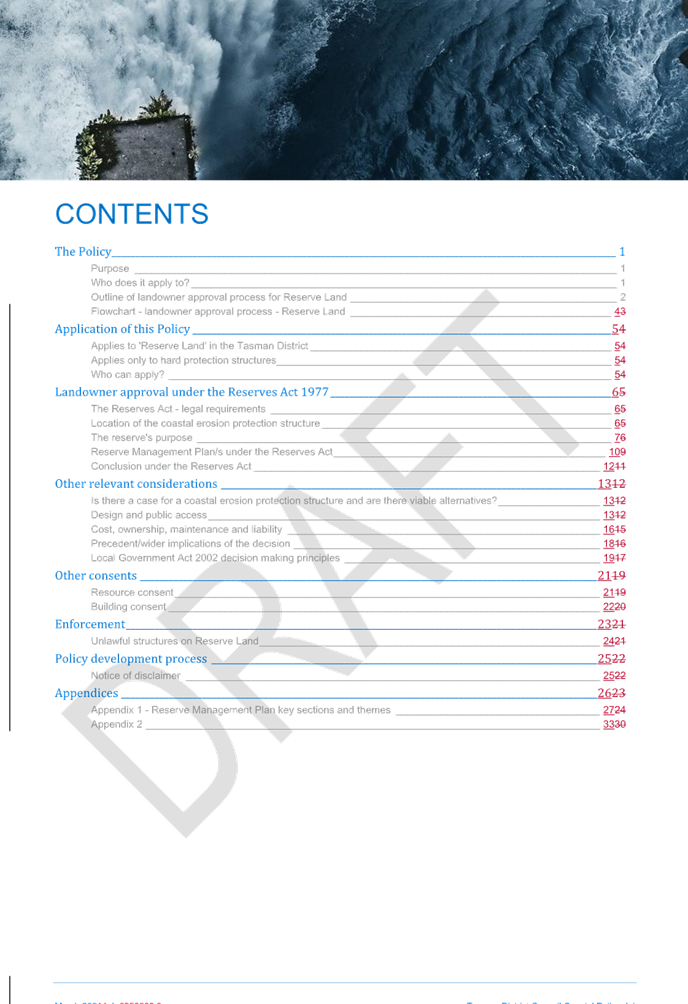
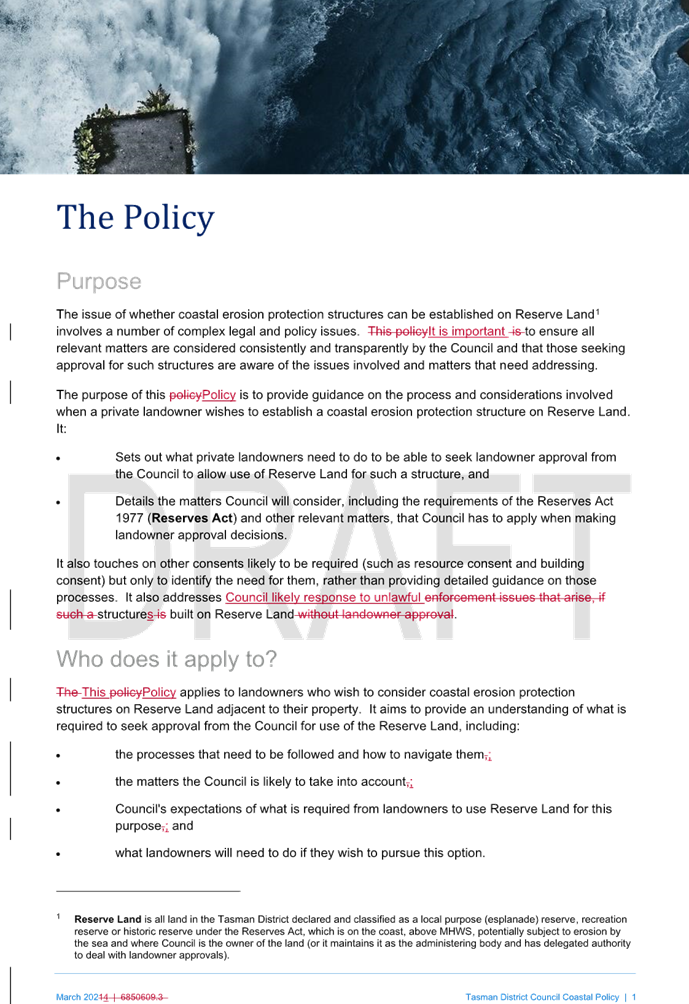
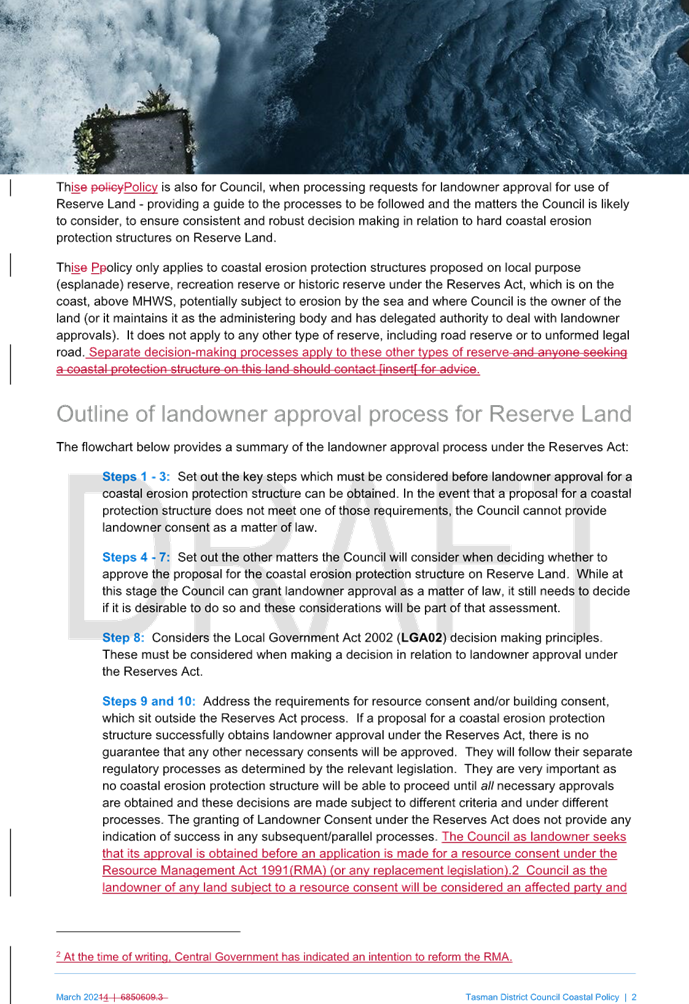
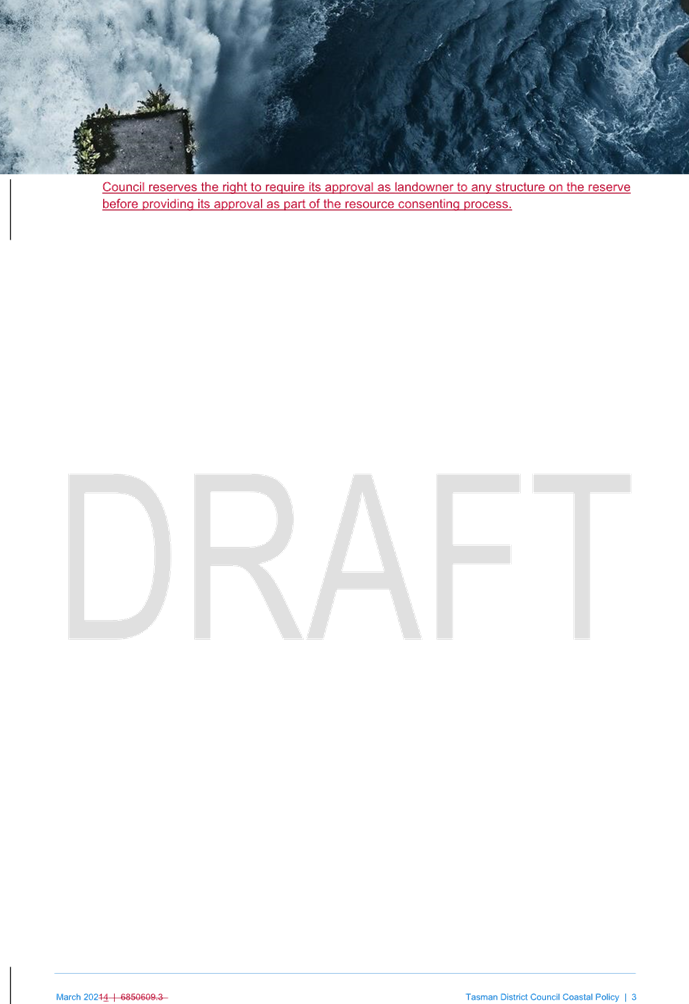
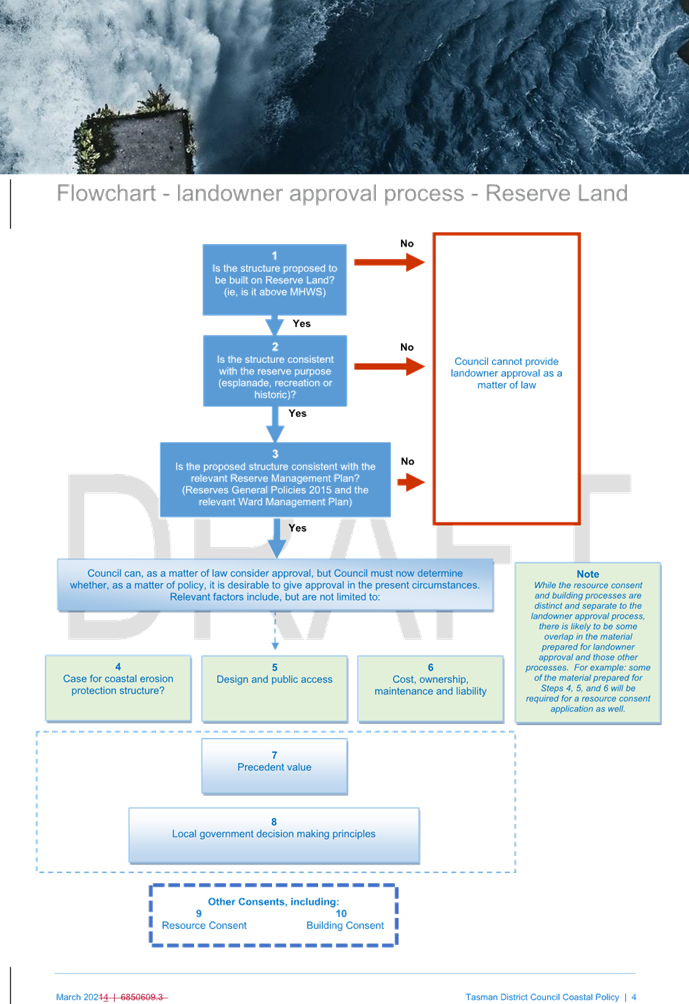
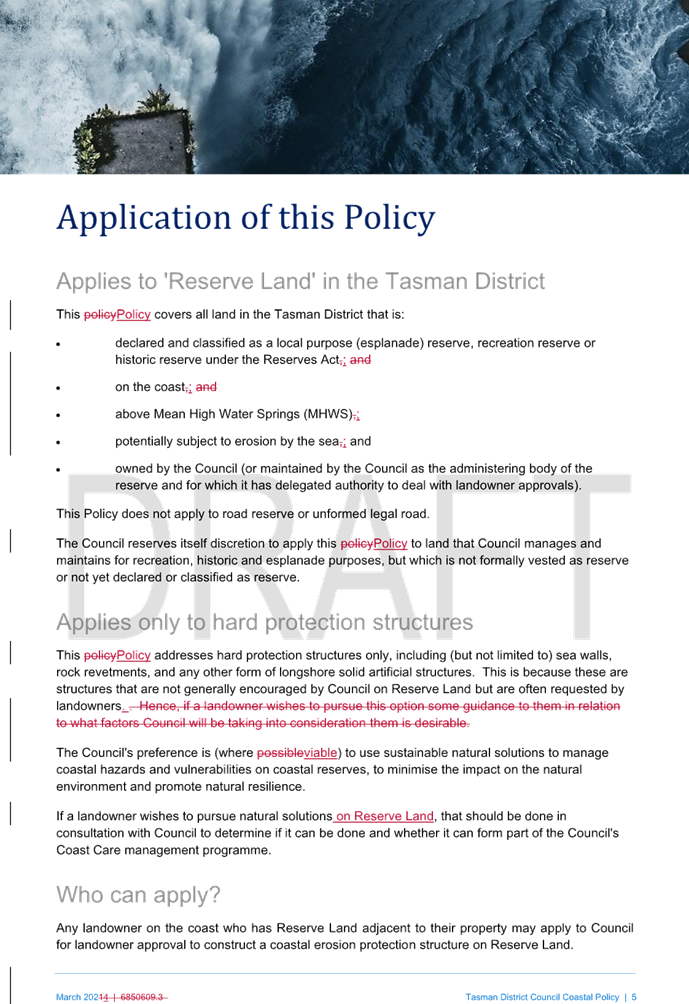

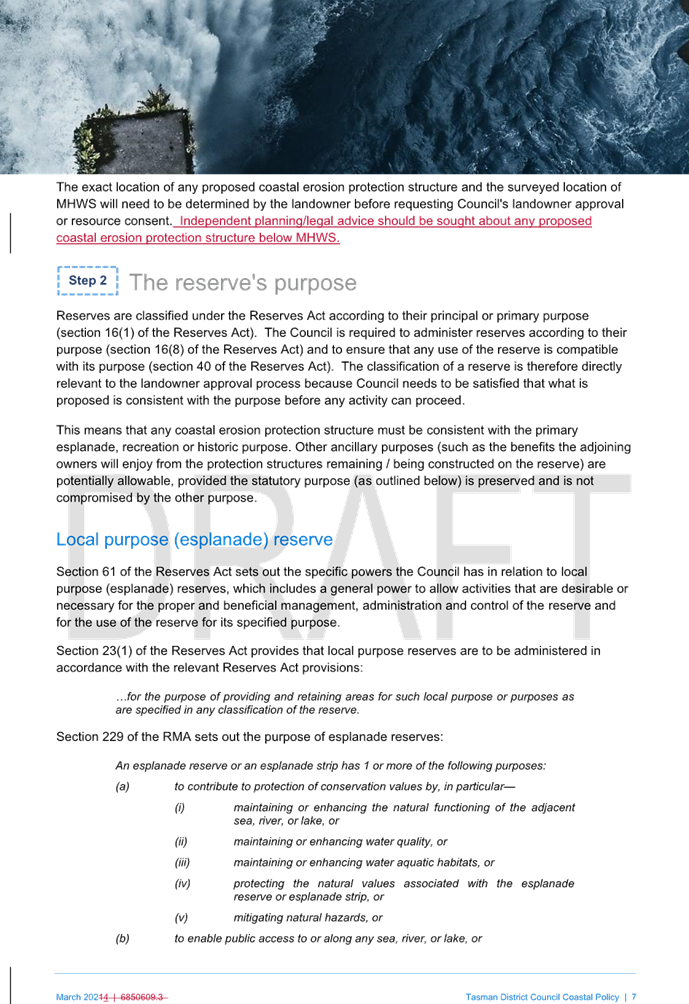
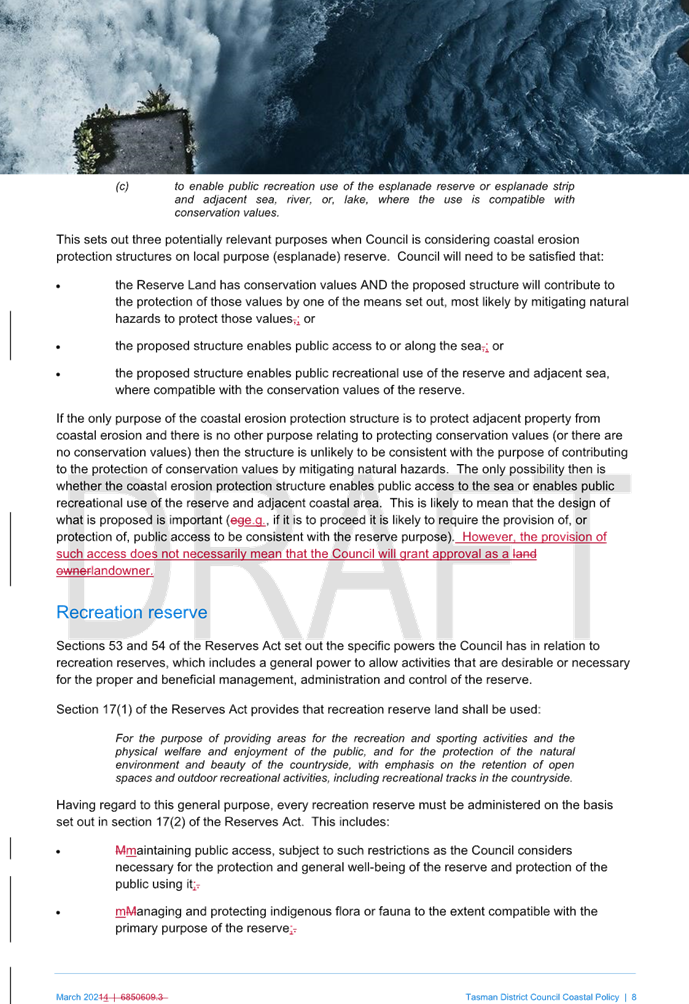

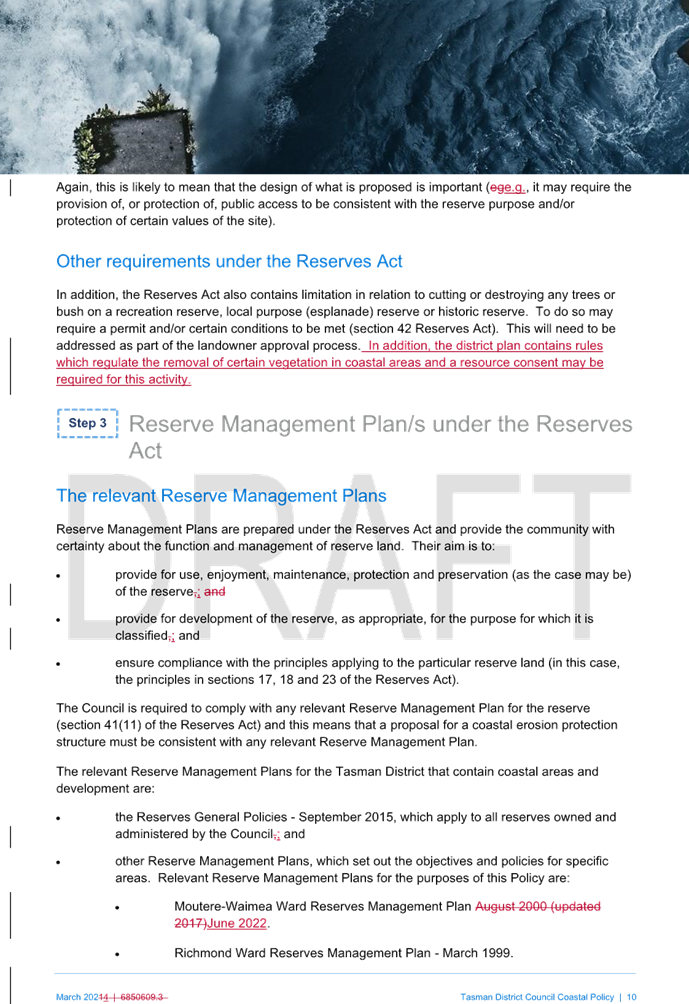
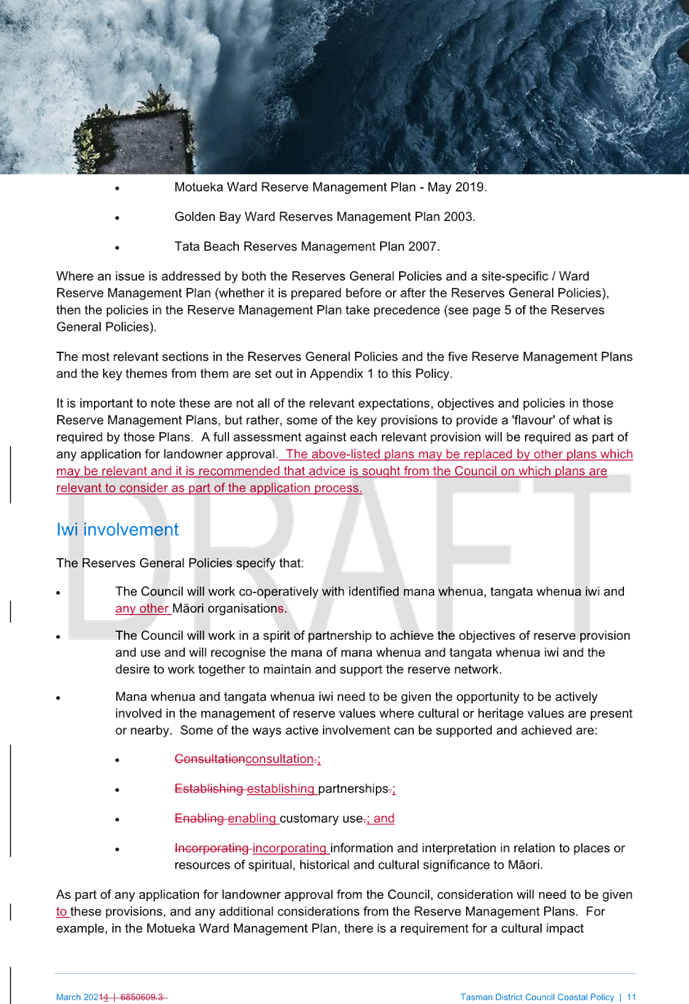


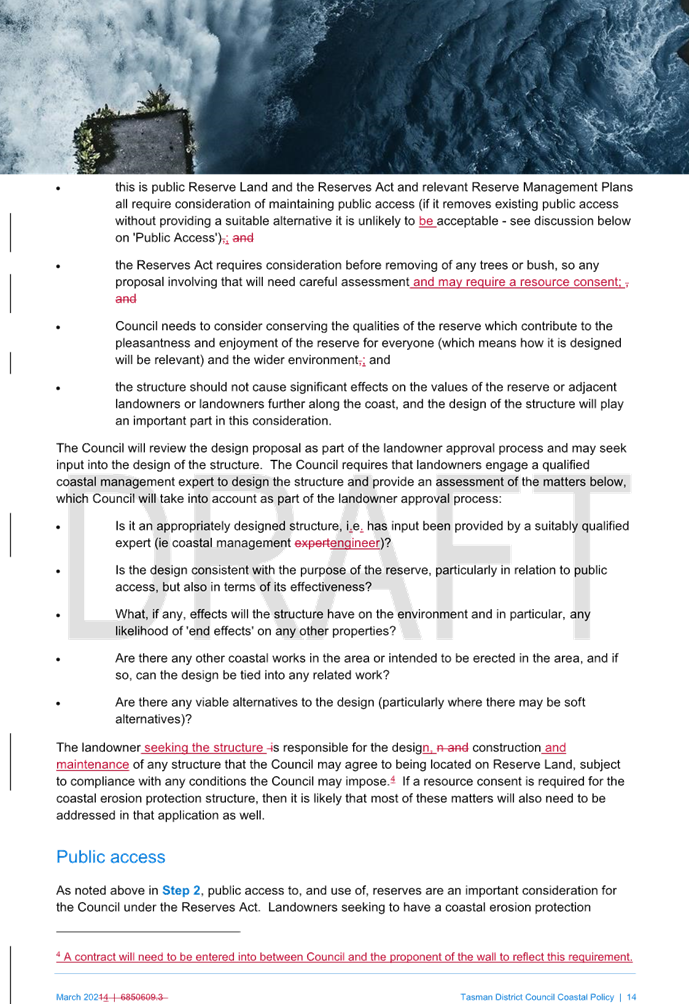
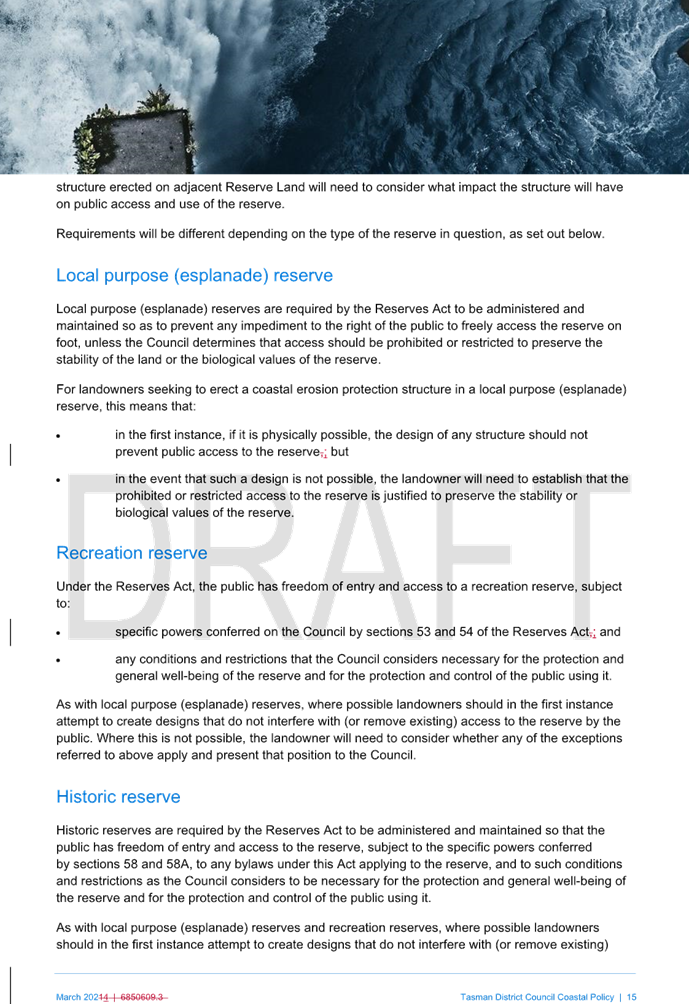
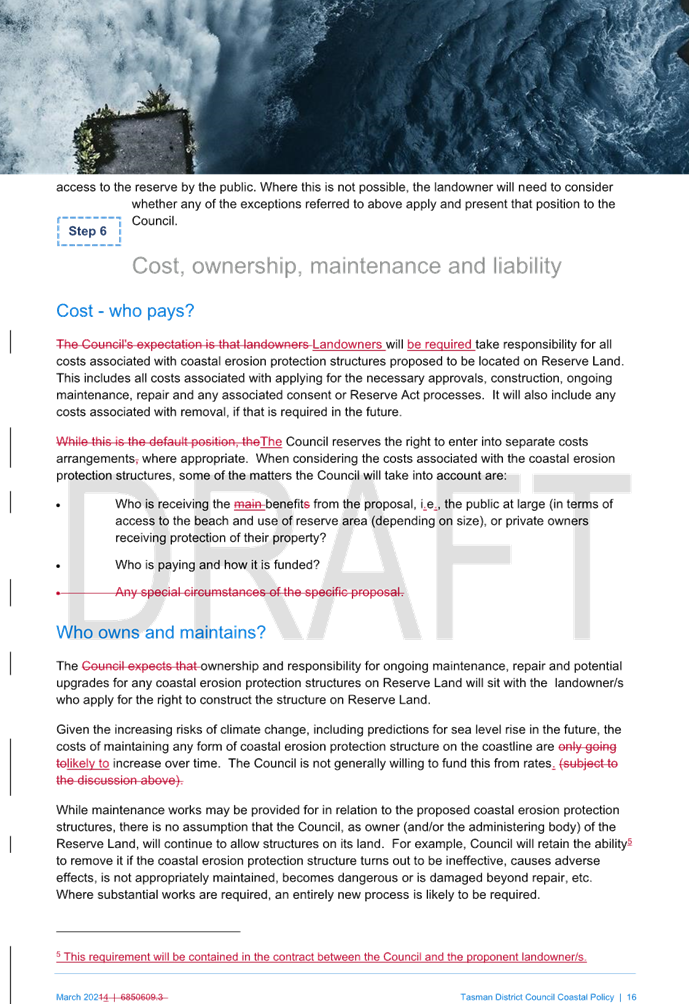
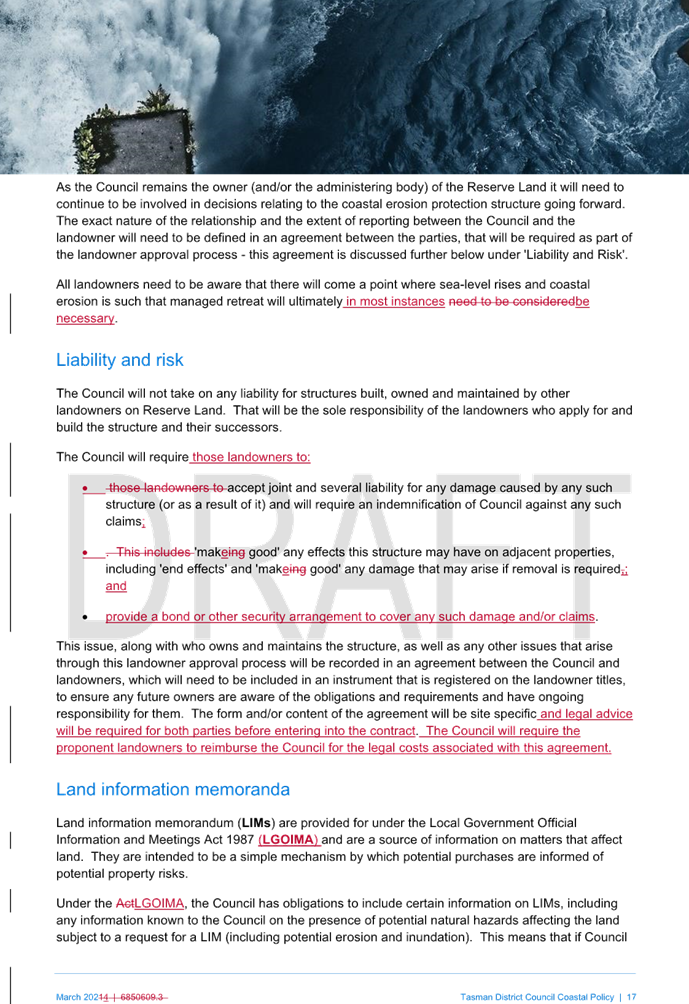
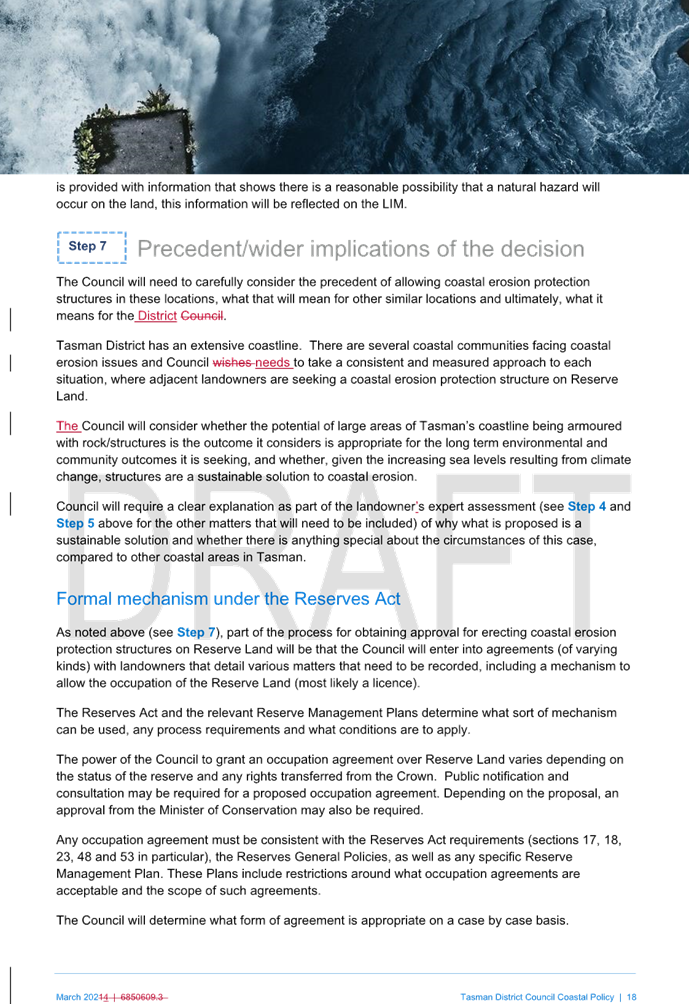
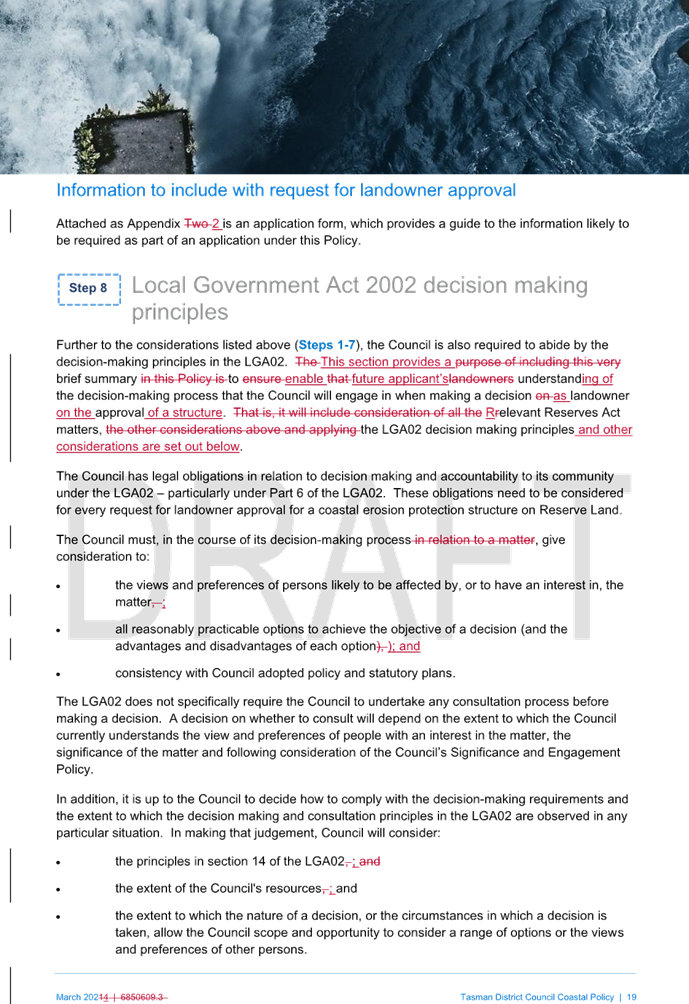
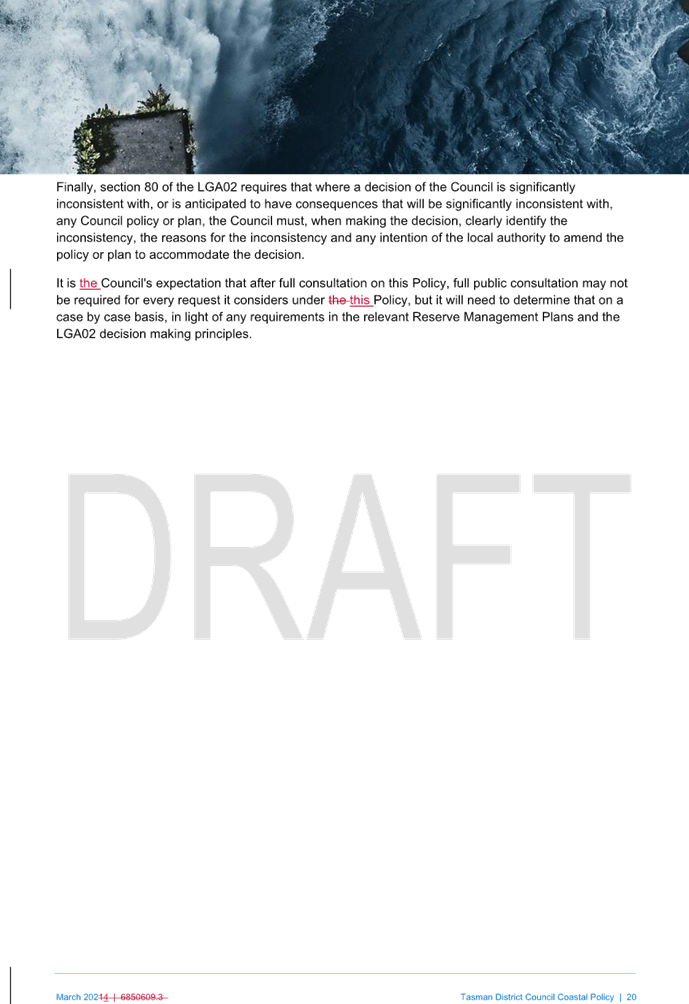
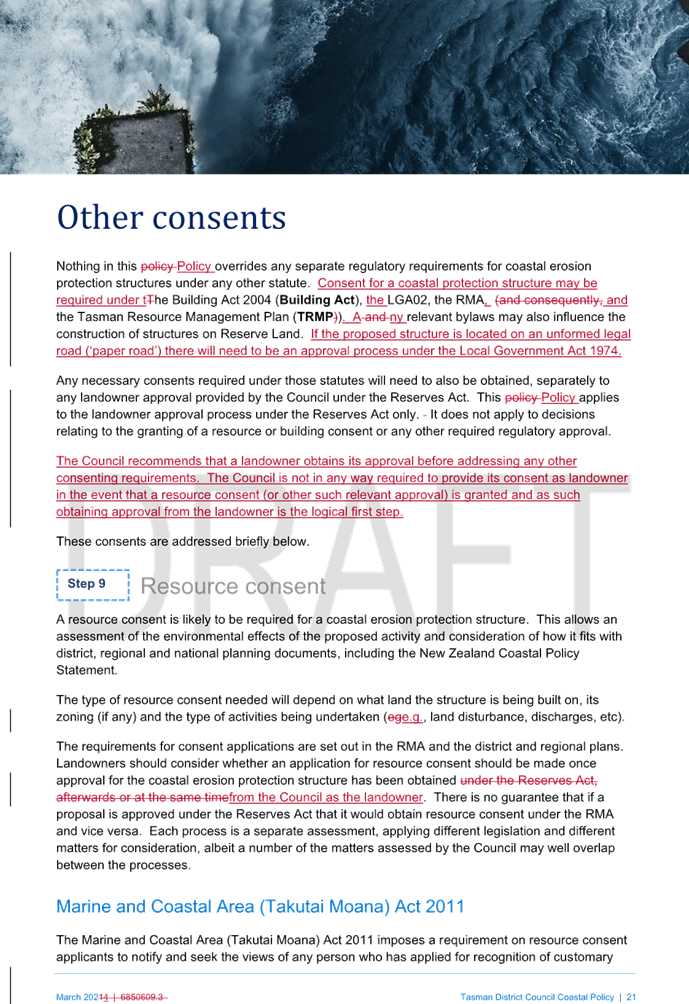

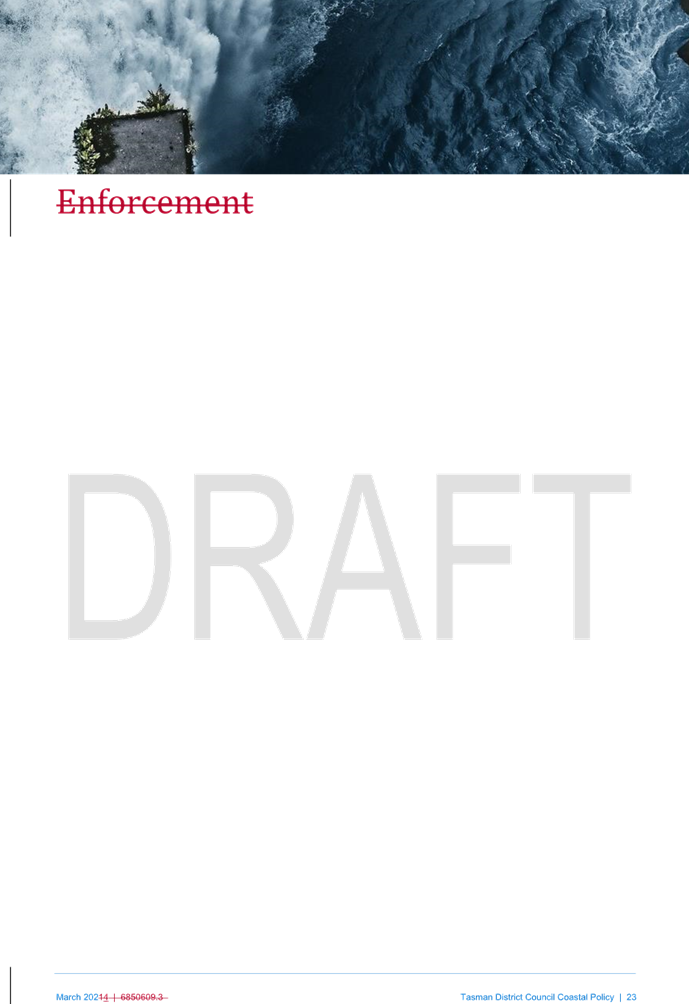
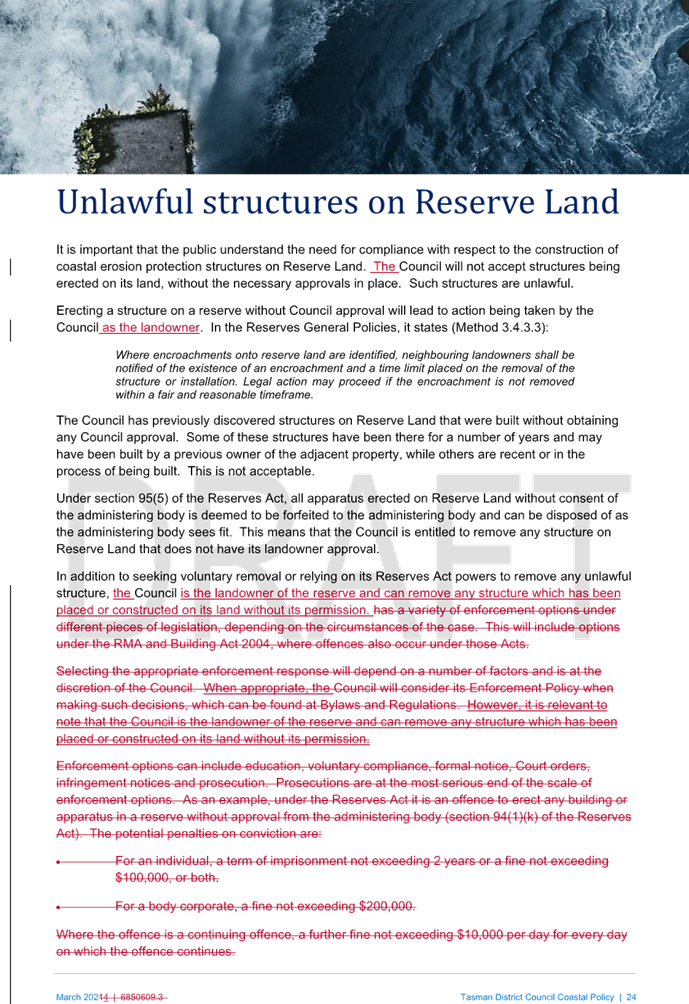
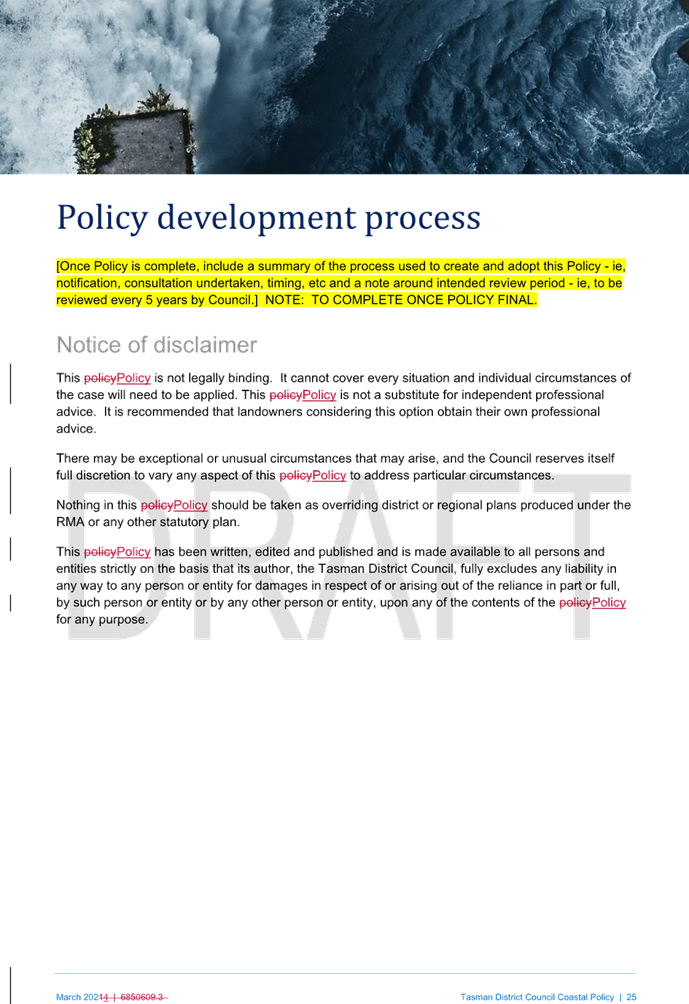
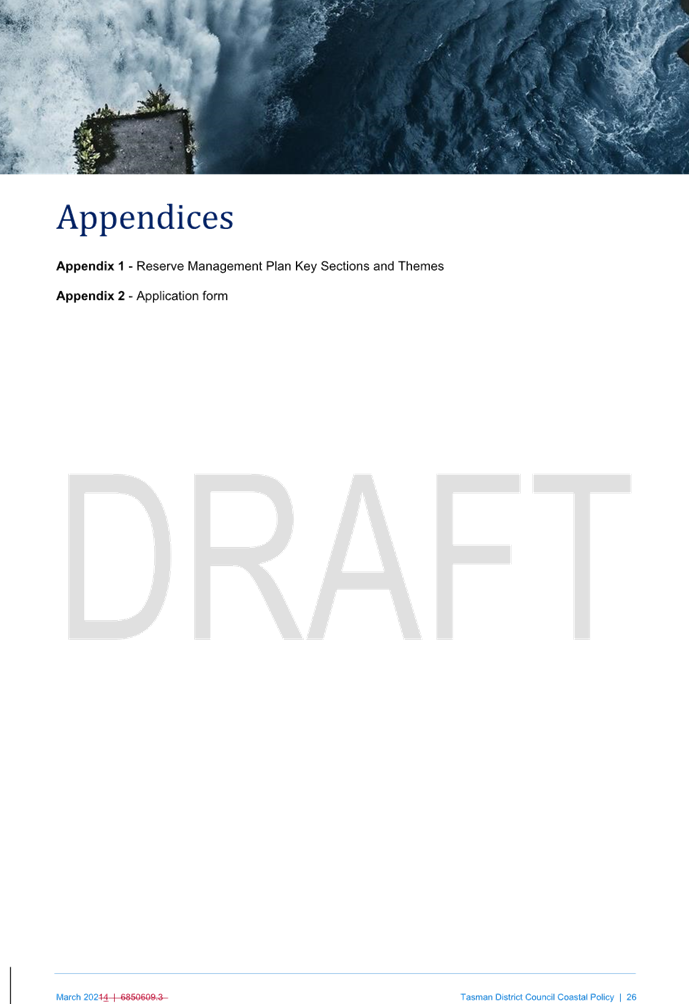
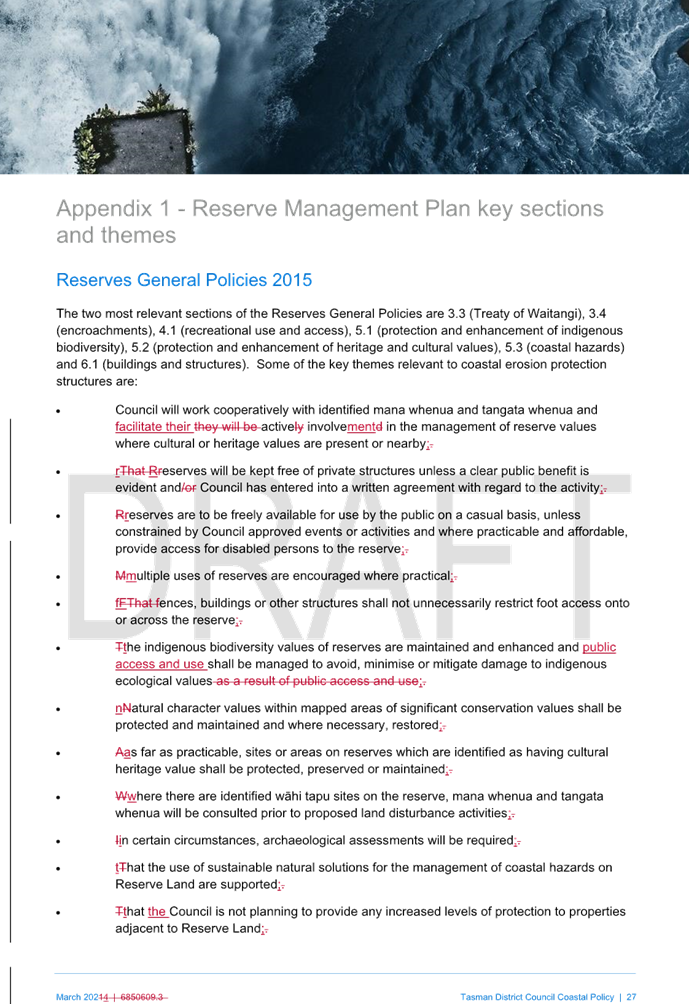
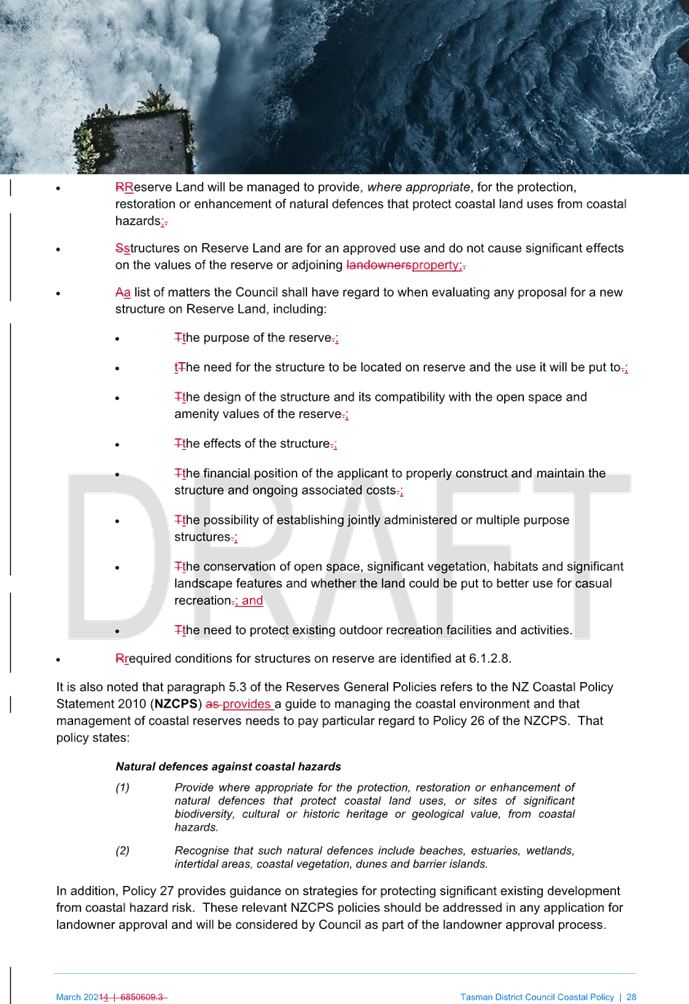

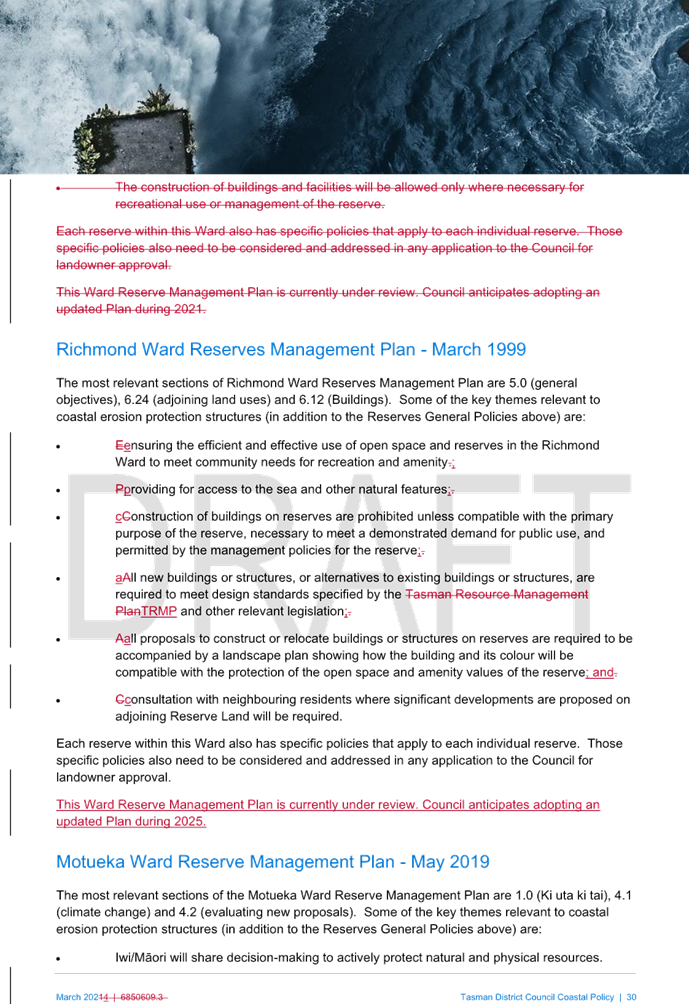
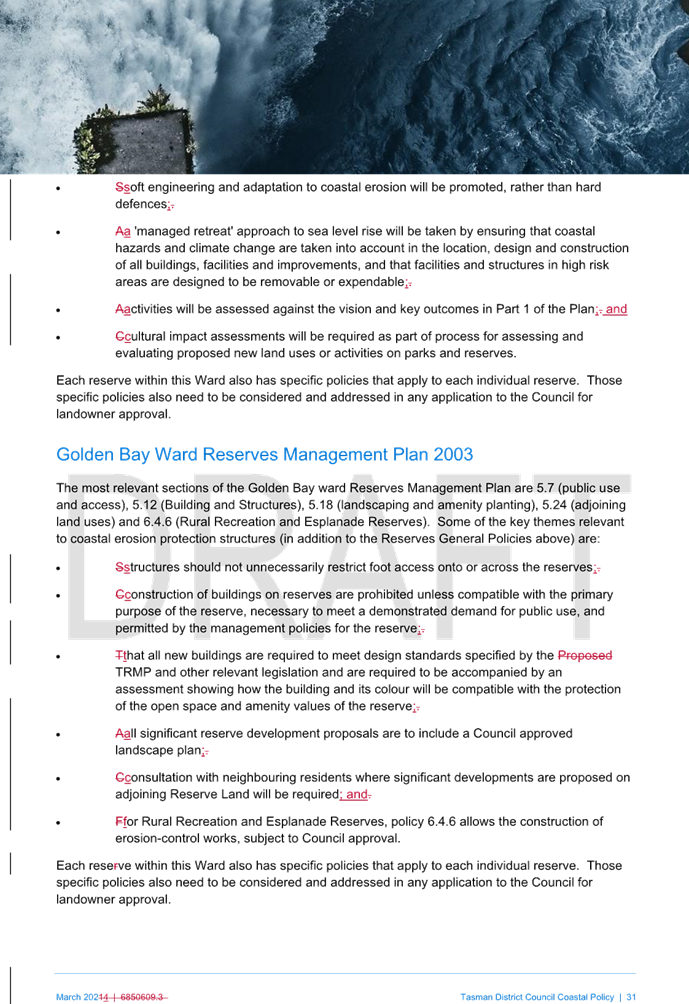


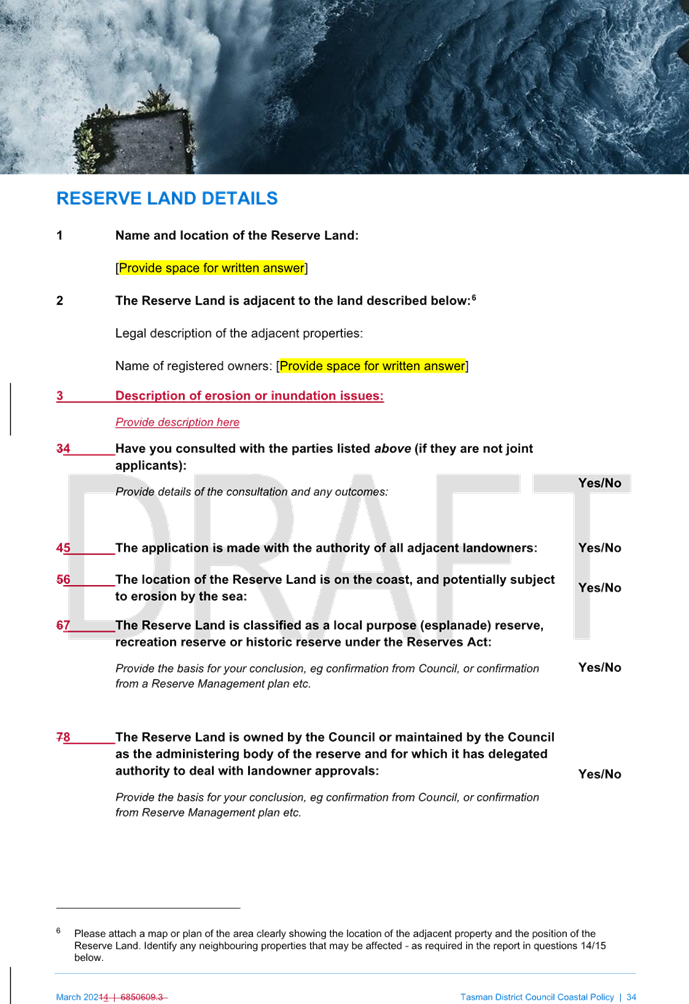

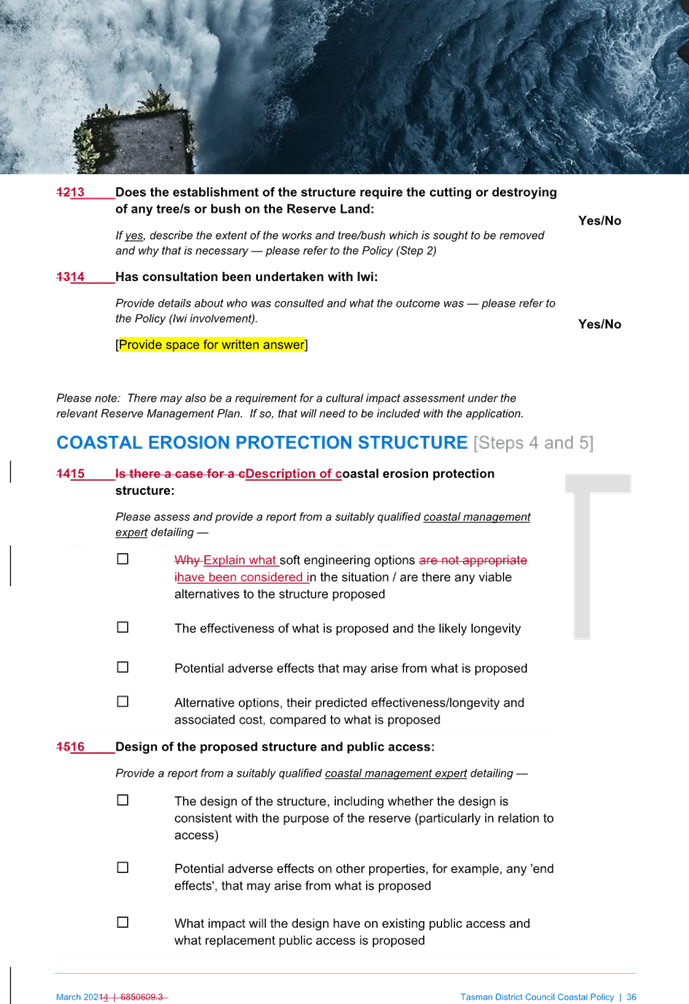
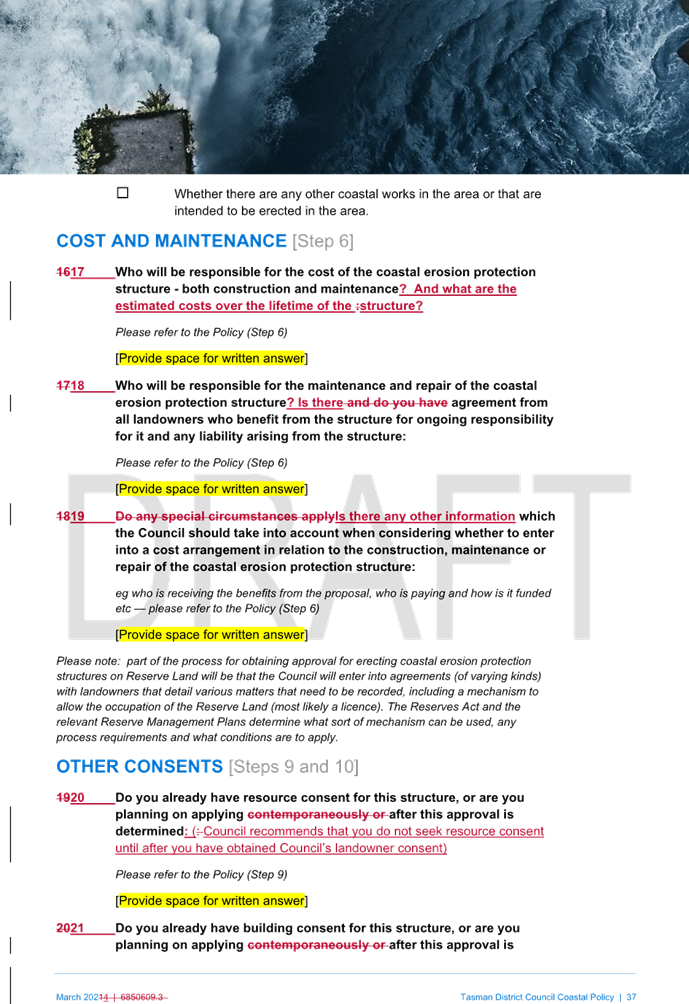
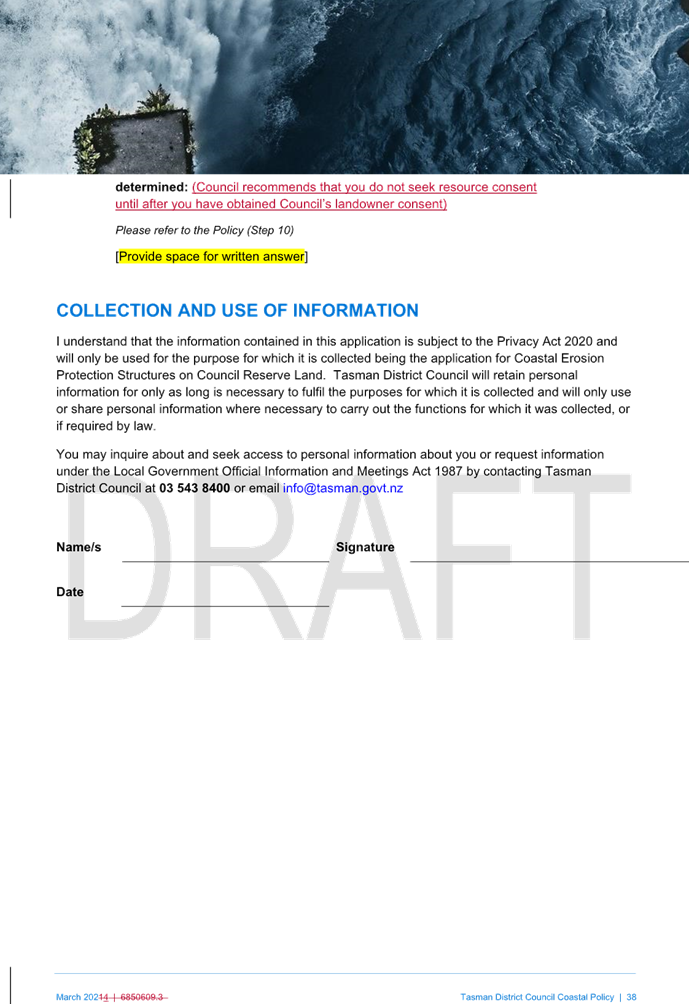

Tasman District Council Agenda – 28 March 2024
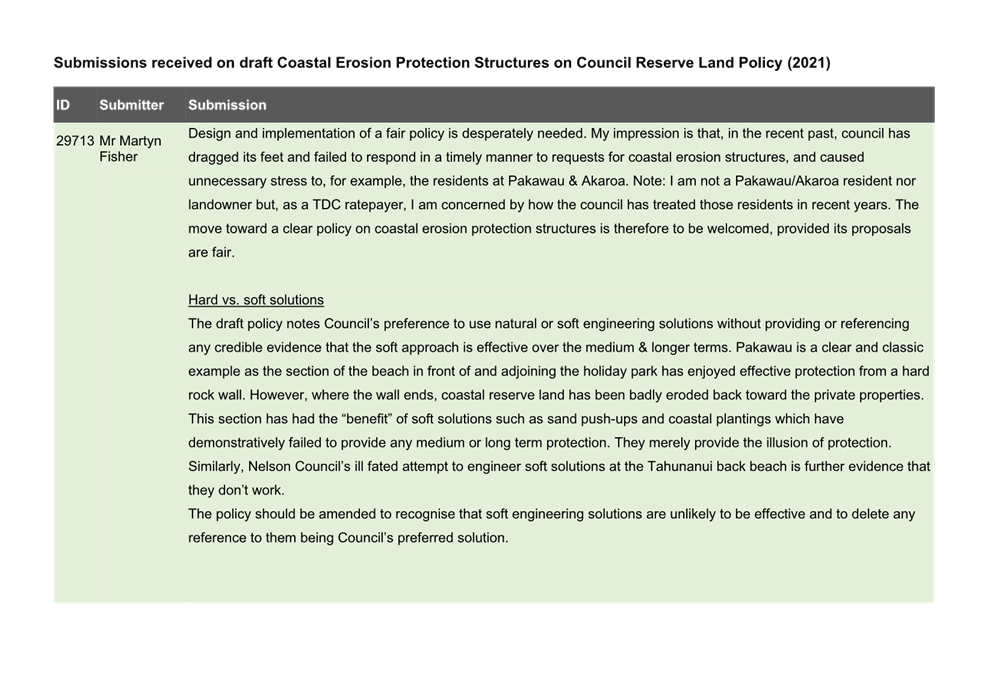
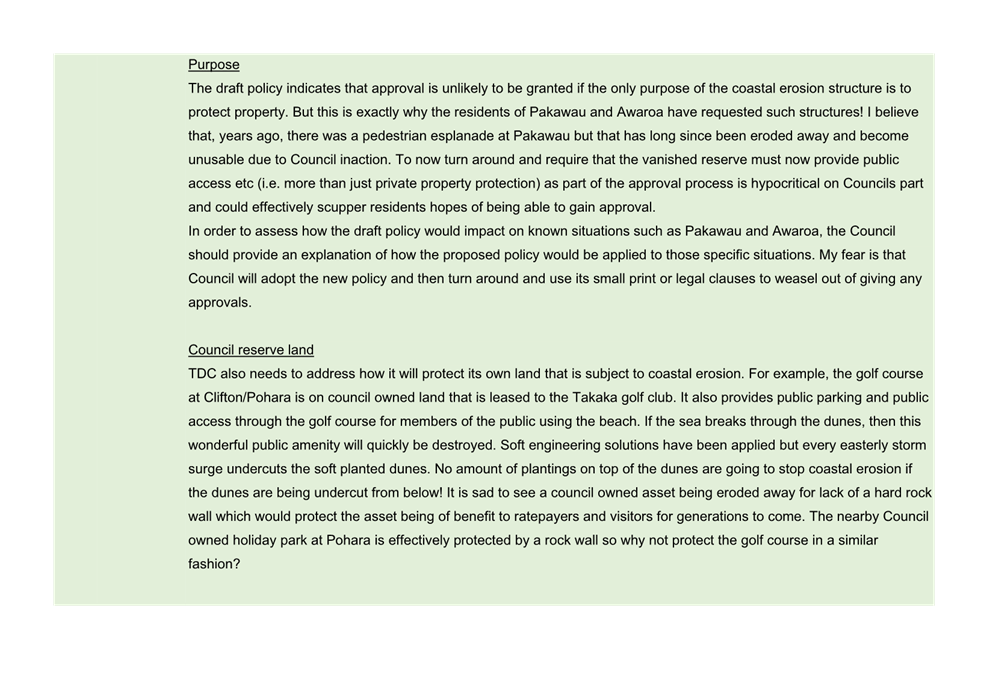
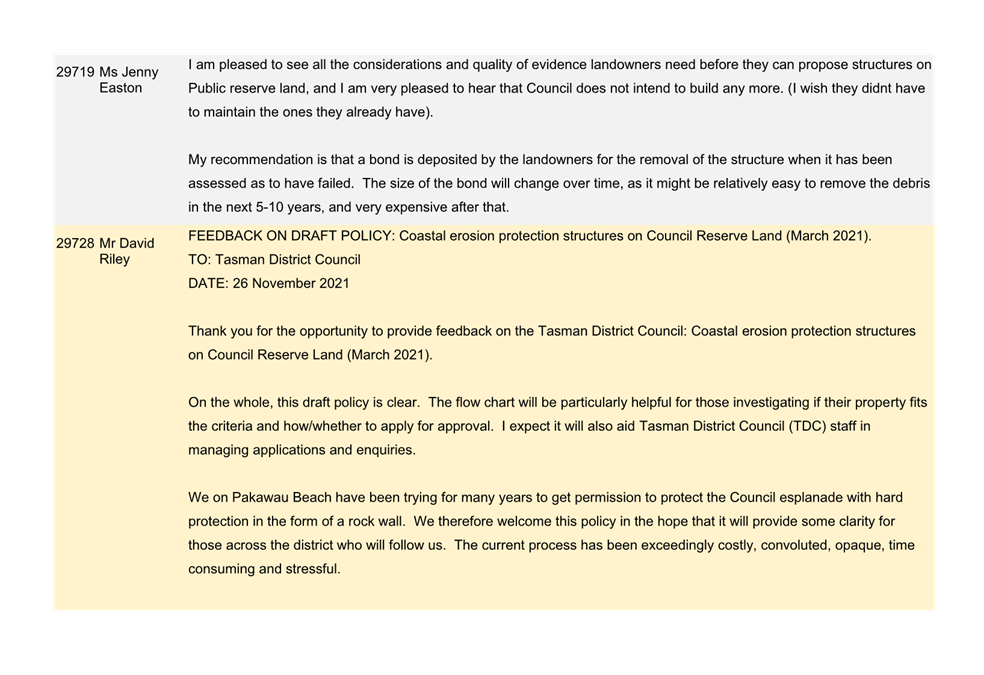
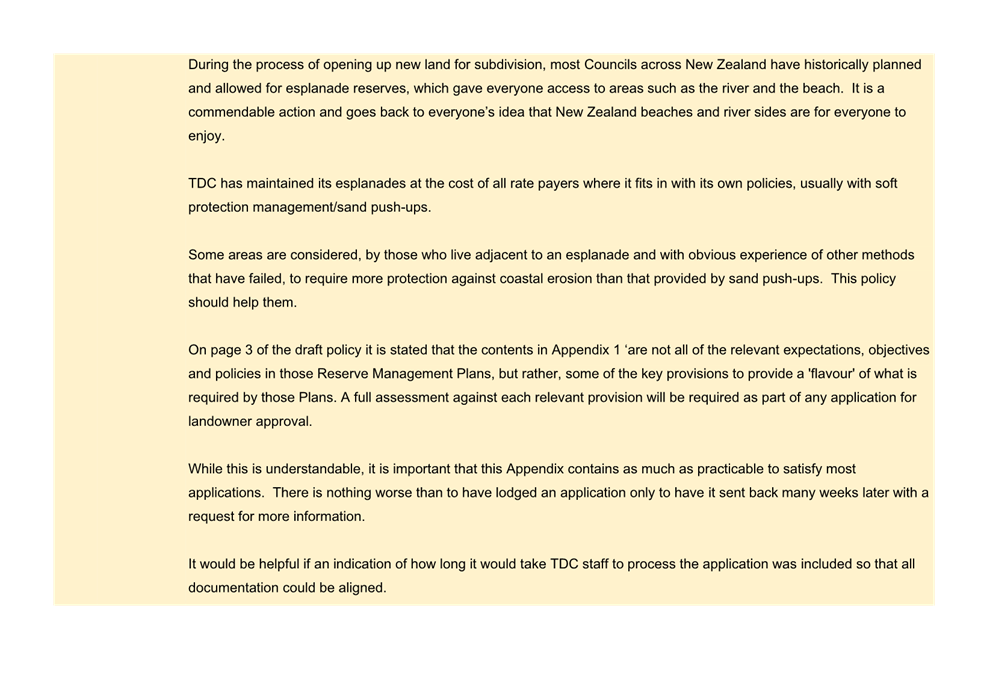

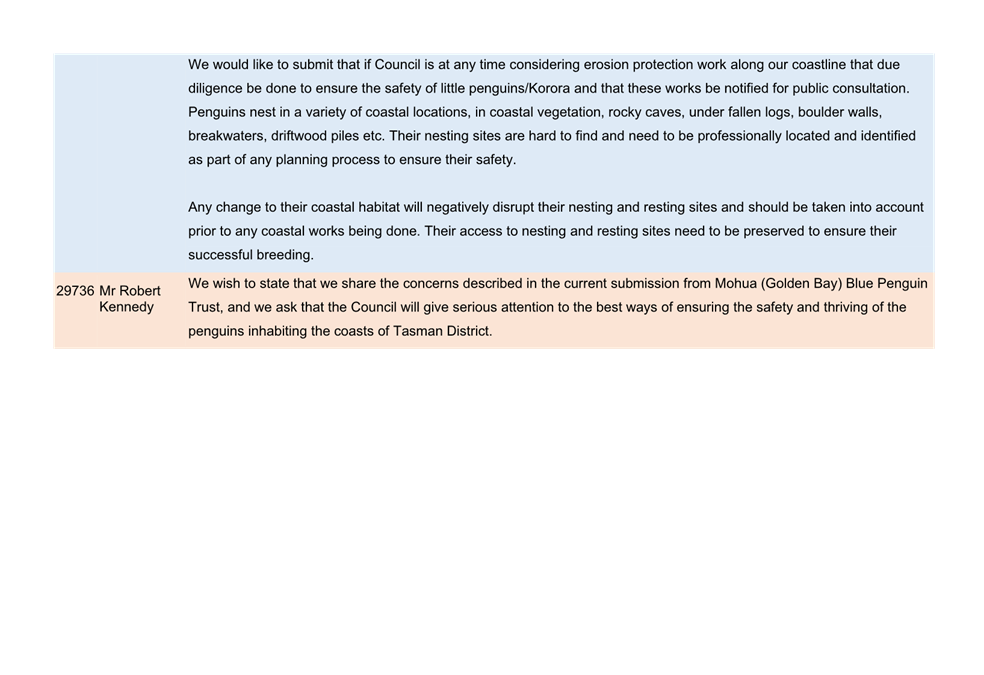
Tasman District Council Agenda – 28 March 2024
7.8
Coastal Protection
Policy Confirmation
Decision Required
|
Report
To:
|
Tasman
District Council
|
|
Meeting
Date:
|
28
March 2024
|
|
Report
Author:
|
Ian
McComb, Senior Infrastructure Planning Advisor
|
|
Report
Authorisers:
|
Dwayne
Fletcher, Strategic Policy Manager
|
|
Report
Number:
|
RCN24-03-12
|
1. Purpose
of the Report / Te Take mō te Pūrongo
1.1 To
seek the Council’s approval for the Interim Coastal Protection Policy of
2014 to become the confirmed overarching Coastal Protection Policy and approve
a supplementary policy/process that considers privately initiated coastal
protection works within Tasman District Council’s controlled roads.
2. Summary
/ Te Tuhinga Whakarāpoto
2.1 In
response to increasing pressure from private landholders to spend public money
to protect their private coastal lands from erosion and inundation, the Council
adopted the Interim Coastal Protection Policy in 2014. This policy, in summary,
said that the Council would:
2.1.1 only
maintain Council-owned costal protection structures (CPS);
2.1.2 only
invest in new CPS to protect Council owned assets;
2.1.3 not
fund or maintain CPS that protect private property; and
2.1.4 only
consider privately funded CPS on Council land where these complied with all
relevant rules and policies.
2.2 Since
2014, the interim policy has successfully guided staff on response to public
enquiries and works planning and no substantial changes are required.
2.3 To
supplement this overarching policy a new policy/process related to privately
initiated works in Council controlled road reserves has been prepared and is
ready for adoption.
2.4 Similarly,
a new detailed policy/process for consideration of privately initiated CPS on
Council reserve land managed under the Reserves Act has been prepared and is
the subject of a separate report to this meeting.
3. Recommendation/s
/ Ngā Tūtohunga
That the Tasman District Council
1. receives
the Coastal Protection Policy Confirmation Report RCN24-03-12; and
2. adopts the Coastal Protection Policy;
and
3. adopts the Coastal Protection Works
within Road Reserves Policy.
4.1 During
preparation of the Coastal Assets Activity Management Plan 2024-2054, a staff
decision was made to seek confirmation of the interim Coastal Protection Policy
of 2014. Concurrently, the Reserves team were also finalising their process to
recommend adoption of a Coastal Protection Policy Confirmation. An opportunity
was identified during the collaboration on this policy to also include a policy
that related to Council road reserves and thereby have comprehensive coverage
of coastal protection policy and the associated process to deal with privately
initiated requests to utilise Council land.
Proposed
overarching Coastal Protection Policy
4.2 The
Council will maintain or repair only existing Council-owned coastal protection
structures (CPS) (subject to a review of economic benefit and affordability and
compliance with New Zealand Coastal Policy Statement (NZCPS) and the Tasman
Resource Management Plan (TRMP)).
4.3 The Council will consider new
investment in coastal protection works only where there are substantial
Council-owned capital works, assets, or infrastructure at risk, and it is
impracticable to relocate the Council assets (subject to compliance with the NZCPS
and the TRMP. This Coastal Protection Policy relates to the protection of all
vulnerable Council-owned assets regardless of which activity management plan is
responsible for the structure except for the Council-administered reserve land.
4.4 The Council will not invest
in or maintain any new Council-owned coastal structures or works to protect
private property, nor will it accept responsibility for repair or maintenance
of existing private coastal works.
4.5 The Council will only give
consideration to allow any privately funded construction of shoreline
protection structures on the Council-owned land, for the purposes of protecting
the Council-owned land or private property, where a proposal is substantially
compliant with the objectives and policies of the NZCPS and objectives,
policies and rules of the TRMP, and the Council’s Reserves General
Policies document. In any event, the Council retains complete discretion
regarding authorisation of private structures on the Council-owned land.
4.6 This overarching policy is
supported by the following two polices that outline the process details to
manage privately initiated proposals that impact reserves and roads:
· Coastal Erosion Protection Structures on Council Reserve Land Policy
· Draft Coastal Protection Works with
Road Reserve Policy
Proposed
Draft Coastal Protection Works with Road Reserve Policy
Introduction
4.7 Due
to increasing weather events, there is rising pressure from the public for the
Council to allow coastal protection works within Council road reserve to
protect private land and assets. This policy outlines the process and
considerations for approving privately initiated coastal protection works
within a road reserve managed by Tasman District Council. It aims to balance
the need to protect infrastructure and property from erosion and inundation
with the preservation of the precious natural coastal environment and public
access for future generations.
4.8 Generally, policy relating to
approving works within a road is covered by the Council’s Transportation
Policies and Procedures Manual (TPPM). The TPPM outlines the management of
roads including the approval process for structures and activities within the
road reserve. A chapter will be added to the TPPM at its next update to
specifically address privately initiated coastal protection works based on this
policy.
4.9 This policy requires that any
privately initiated coastal protection works within a road reserve be assessed
on a case-by-case basis as generally, road reserve is not an appropriate
location for private coastal protection structures.
4.10 The assessment shall consider the
potential impact of the coastal protection works (including installation and maintenance) on the current and future environment,
compliance with regulations, tangata whenua input and the potential impact on the
public’s use of the road.
4.11 Depending
on the proposal, other Council policies and legislative requirements may be
triggered and hence this policy should be read in conjunction with the:
4.11.1 Tasman
District Council Policy on Coastal Protection Works;
4.11.2 Tasman
District Coastal Protection Structures on Council Reserves Land Policy;
4.11.3 Tasman
Resource Management Plan;
4.11.4 New Zealand
Coastal Policy Statement 2010 (NZCPS);
4.11.5 Building Act
2004 and Building Code; and
4.11.6 Utilities
Access Act 2010
Definitions:
4.12 “Coastal Protection Works” means structures,
measures, or actions designed to reduce the impact of coastal hazards on land
adjacent to tidal waters, including, but not limited to, seawalls, revetments,
groynes, beach nourishment, dune
restoration, and planting native vegetation.
4.13 The
TRMP definition for Coastal Protection Structures is: Coastal protection
structure - means a seawall, rock revetment, groyne, breakwater, stopbank,
retaining wall or comparable structure or modification to the seabed, foreshore
or land adjacent to the coast that has a purpose or effect of protecting land
from a coastal hazard, including seawater inundation or erosion.
Objectives
4.14 To prioritise the
protection of life while minimising adverse effects on the coastal environment.
4.15 To encourage the use
of natural and non-structural solutions where practicable.
4.16 To ensure
consistency and transparency in the decision-making process when privately
initiated coastal protection works are proposed on Council road reserve.
4.17 Incorporate
cultural considerations.
4.18 Allow
for emergency response procedures.
4.19 To
complement but not override any consents required under the Tasman Resource
Management Plan.
4.20 Establish
an approval pathway for coastal protection works.
4.21 Coastal
protection works can be built by private landowners and public authorities,
with appropriate approvals.
Pre-assessment
4.22 Applicants
considering private coastal protection works within Council road reserve should
consult with the Council planning staff regarding potential resource consent
requirements, building staff regarding any building consent requirements, and
the Transportation Manager considering the following:
4.22.1 the
ownership/control of the road is the Council’s and not the New Zealand
Transport Agency; and
4.22.2 existing
or planned Council use of the land for roading, public access or services.
Landowner
Approval Process
4.23 All
proposals seeking landowner approval for coastal protection works within a road
reserve must be submitted to Tasman District Council’s Transportation
Manager along with detailed plans, technical specifications, and environmental
assessments:
4.23.1 where works are required as an emergency
response, Council’s engineering staff will endeavour to facilitate an
urgent site visit and if appropriate, interim works approval as a
landowner. This is separate to any approvals required for emergency works
under the Resource Management Act 1991 or the Building Act 2004.
4.24 In seeking landowner approval, as the
landowner the Council will assess proposals based on the following criteria:
4.24.1 need and justification: demonstrating the
immediate or imminent threat to life, property, or infrastructure;
4.24.2 suitability of the solution: considering
the effectiveness, potential impact on existing or proposed Council
infrastructure, cost-effectiveness, design and long-term sustainability of the
proposed works including experience of the proposed contractors, maintenance or
improvement of all forms of public access;
4.24.3 environmental impact: minimising adverse
effects on coastal ecosystems, natural processes, and amenity;
4.24.4 compliance with regulations: meeting the
requirements of the Resource Management Act, NZCPS relevant regional and
district plans, and coastal permits; and
4.24.5 consultation: consulting with other
affected landowners, iwi, community groups, and relevant government agencies.
4.25 Under this policy, permission may be
granted in the form of a permit, Licence to Occupy Road or by another form of
written approval. In many cases a Road Opening Notice Form and Traffic
Management Plan shall need to be completed as part of the approval. More
information is contained in the document: Agreement to occupy a road | Tasman District Council
4.26 The Group Manager – Community
Infrastructure is delegated by the Council to make a decision on the proposal
as the representative of the Council as landowner based on the assessment
against the criteria in this policy and any public feedback received.
4.27 Landowners
must obtain all relevant formal written permission(s) from the Council
(Resource Consent, Building Consent, Community Infrastructure Group Manager,
Reserves and Facilities Manager) before commencing work.
Funding
and Maintenance
4.28 The
Council will assess the funding responsibility for approved works on a
case-by-case basis, considering the nature of the threat, any public benefit,
and potential impacts.
4.29 Applicants will be required to
contribute up to 100% of the construction and ongoing maintenance, and/or
insurance costs of the works.
4.30 The
Council will rarely assume ownership and responsibility for privately funded
coastal protection works constructed within the road reserve. However, where
public benefit is demonstrated a proportion of the initial and ongoing costs
may be approved by the Council via the Long Term Plan process.
Review
and Monitoring
4.31 This
draft policy will be reviewed two yearly before it is incorporated into the
TPPM to ensure its effectiveness and alignment with best practices and changing
coastal hazards.
4.32 The
Council will monitor the performance of approved coastal protection works and
the surrounding environment.
https://environment.govt.nz/acts-and-regulations/national-policy-statements/new-zealand-coastal-policy-statement/
5. Analysis
and Advice / Tātaritanga me ngā tohutohu
Drivers
5.1 The
primary drivers for both the overarching and specific road policies are that
increased coastal erosion and inundation is expected to occur. This will likely
impact all coastal land within the District and has the potential to create
significant financial, administrative and emotional burden on multiple
stakeholders.
Response
5.2 As
the interim policy outlines, the Council will need to strategically consider
when to protect and when to relocate its assets on behalf of the community.
5.3 Private
landholders are likely to continue to expect Council support either through
financial means or access to Council land to assist them to defend their
private land and assets. However, to do so would be inappropriate for the
Council from both a ratepayer equity perspective and under the NZCPS.
5.4 The
overarching policy confirms that approach adopted by the Council in 2014 and
the road specific policy introduces process detail that is applicable to
considering privately-initiated proposals that relate with Council roads. The
adoption of these policies combined with the similar Reserves related policy
will create a comprehensive set of aligned responses to the question of coastal
protection works and structures.
6.1 The options are outlined in the
following table:
|
Option
|
Advantage
|
Disadvantage
|
|
1.
|
Adopt overarching policy
|
Confirms long standing Council position.
Provides clear guidance to private
landholders and staff.
Reduces financial risk to the Council.
|
May upset landholders of vulnerable
lands.
|
|
2.
|
Adopt the draft specific road policy
|
Provides clear guidance to private
landholders and staff.
Reduces financial risk to the Council.
|
May upset landholders of vulnerable
lands.
Absence of specific consultation may
upset some stakeholders.
|
|
3
|
Adopt both policies
|
Provides comprehensive policy coverage.
|
Some stakeholders may be upset.
|
|
4
|
Adopt neither policy
|
Avoids risk of upsetting stakeholders.
|
May expose the Council to increased
pressure to use Council land and expend public money to protect private land
and assets.
Fails to provide staff with agreed policy
and process to manage requests for coastal protection works approval on
Council road.
|
6.2 Option 3 is recommended.
7.1 The overarching policy has numerous
legal linkages but no firm requirements.
7.2 As the overarching policy has been in
place with interim status for over a decade, no further consultation is deemed
necessary as all elements of the community have had ample time to raise any
concerns or objections.
7.3 The Local Government Act 2002 requires
local authorities to consult on proposed policies in some cases. An allowable
exception is when Council considers “on reasonable grounds” that it
has sufficient information about community interests and preferences to enable
the purpose of the policy to be achieved.
7.4 Although the specific draft Road Policy
has not been consulted upon, it is consistent with the interim overarching
Coastal Protection Policy, other road policies in the TPPM and is very similar
in coverage to the Draft Reserves Policy that has been consulted upon without
any submissions opposing the original draft of that policy.
7.5 The
draft Road Policy has been prepared with the assistance of AI as covered by the
IS23 Policy on Generative Artificial Intelligence use. AI was used to create a
base document that was then edited by Council staff.
8. Iwi
Engagement / Whakawhitiwhiti ā-Hapori Māori
8.1 As the content of these policies are not
presenting significant new material, no specific iwi consultation has occurred
to date. However, the ability to review and comment on the policies during the
LTP consultation period will be highlighted with iwi at the scheduled April
hui.
9. Significance
and Engagement / Hiranga me te Whakawhitiwhiti ā-Hapori Whānui
9.1 The significance of this overarching
policy confirmation and roading specific policy is low as they confirm an
existing level of service.
9.2 For residents who own vulnerable land
within the District these policies are likely to be of high specific concern.
|
|
Issue
|
Level of
Significance
|
Explanation of
Assessment
|
|
1.
|
Is there a high level
of public interest, or is decision likely to be controversial?
|
Low
|
General public low,
high to coastal residents with vulnerable property.
|
|
2.
|
Are there impacts on
the social, economic, environmental or cultural aspects of well-being of the
community in the present or future?
|
Low
|
Whilst the overall
context has high potential significance, this policy detail is administrative
detail.
|
|
3.
|
Is there a
significant impact arising from duration of the effects from the decision?
|
Low
|
The policies can be
reviewed on a two-yearly basis or more often if needed.
|
|
4.
|
Does the decision
relate to a strategic asset? (refer Significance and Engagement Policy for
list of strategic assets)
|
Medium
|
Potentially,
strategic assets will be considered as part of this policy, however these
would be subject to more extensive investigations and reporting.
|
|
5.
|
Does the decision
create a substantial change in the level of service provided by Council?
|
Low
|
Continuation of
current Level of Service.
|
|
6.
|
Does the proposal,
activity or decision substantially affect debt, rates or Council finances in
any one year or more of the LTP?
|
Low
|
Adoption of the
policies is designed to minimise costs to the Council.
|
|
7.
|
Does the decision
involve the sale of a substantial proportion or controlling interest in a CCO
or CCTO?
|
Low
|
Not Applicable
|
|
8.
|
Does the proposal or
decision involve entry into a private sector partnership or contract to carry
out the deliver on any Council group of activities?
|
Low
|
Not Applicable
|
|
9.
|
Does the proposal or
decision involve Council exiting from or entering into a group of
activities?
|
Low
|
Not Applicable
|
|
10.
|
Does the proposal
require particular consideration of the obligations of Te Mana O Te Wai
(TMOTW) relating to freshwater and Affordable Waters services?
|
Low
|
Not Applicable
|
10. Communication
/ Whakawhitiwhiti Kōrero
10.1 Internal communication has occurred within the
Council relating to Activity Management, Transportation, Reserves and
Legal.
10.2 If confirmed, both the overarching policy and
specific draft road policy will be included in the Coastal Assets AMP as part
of the Long Term Plan process.
11. Financial
or Budgetary Implications / Ngā Ritenga ā-Pūtea
11.1 The overall financial impacts of these polices is
low as that is a primary driver for their adoption. By managing community
expectations the Council is seeking to avoid or minimise future financial
commitments.
11.2 Processing of any applications for privately
initiated works within roads is not expected to be a significant cost to the
Council as most applications will also require resource or building consents
that will trigger cost-recovery charging.
12.1 Adopting
these overarching and road policies is a low-risk decision which will assist in
mitigating the financial risks posed for the Council due to sea level rise.
12.2 Whilst
there is some risk that landholders of vulnerable lands will dislike the
Council’s position, this vested interest is regarded as less important
than the wider community interest.
12.3 Tasman
District’s extensive coastline means that without a policy in place
around coastal erosion protection works on Council roads:
12.3.1 if the Council makes any decision not to
give its landowner consent to undertake coastal protection works or to impose
conditions on such consent that the applicants find unacceptable, the Council
is more likely to be exposed to challenges from landowners; and
12.3.2 if any landowner challenged a Council
involved judicial review proceedings, the Council would be in a much safer
position if it has a policy in place and it can show that it has followed that
policy in its decision-making.
13. Climate
Change Considerations / Whakaaro Whakaaweawe Āhuarangi
13.1 Climate change considerations are driving the need
for these policies as sea level rise is expected to increase coastal inundation
and erosion and related proposals to protect properties and assets at risk.
14. Alignment
with Policy and Strategic Plans / Te Hangai ki ngā aupapa Here me ngā
Mahere Rautaki Tūraru
14.1 These proposed overarching Coastal Protection and
specific Draft Road polices have been driven by Council strategic decisions
made for the Coastal Activity Management Plan (AMP) originally as part of the
2014 Long Term Plan process but now the 2024 Long Term Plan process.
14.2 Through these policies the Council has determined
to specifically manage community expectations to avoid excess financial burdens
in the future.
14.3 Where coastal protection works are pursued, the
policies will ensure that appropriate legal processes are followed.
15. Conclusion
/ Kupu Whakatepe
15.1 Confirmation of the proposed policies will reduce
financial and reputational risk to the Council by having clear information that
manages expectations and controls processes related to Coastal Protection
works.
15.2 Adequate consultation and opportunity for public
feedback has occurred on the subject matter of the policies to allow adoption
of both the overarching policy and the specific road policy.
16. Next
Steps and Timeline / Ngā Mahi Whai Ake
16.1 If confirmed, the overarching policy will be included in the Coastal
Assets AMP for consultation.
16.2 If confirmed, the specific draft road policy will be included in the
Coastal Assets AMP for consultation and thereafter move to the TTPM when next
updated.
Nil
Tasman District
Council
Agenda – 28 March 2024
7.9
Draft Policy for
Consultation - Dangerous Dams, Earthquake-prone Dams and Flood-prone Dams
Decision Required
|
Report
To:
|
Tasman
District Council
|
|
Meeting
Date:
|
28
March 2024
|
|
Report
Author:
|
Amy
Smith, Community Policy Advisor
|
|
Report
Authorisers:
|
Matt
Feely, Building Assurance Manager; Dwayne Fletcher, Strategic Policy Manager;
Kim Drummond, Group Manager - Environmental Assurance
|
|
Report
Number:
|
RCN24-03-13
|
1. Purpose
of the Report / Te Take mō te Pūrongo
1.1 This
report seeks the Council’s approval to:
1.1.1 commence a special consultative
procedure (SCP) on the proposed Policy on Dangerous Dams, Earthquake-prone Dams
and Flood-prone Dams (“Dangerous Dams Policy”), as required
by section
161 of the Building Act 2004 (“Building Act”); and
1.1.2 approve the draft Dangerous Dams
Policy and the Statement of Proposal for that consultation; and
1.1.3 appoint a Hearings and
Deliberations Panel to hear and deliberate on any submissions received and to
make recommendations to the Environment and Regulatory Committee; and
1.1.4 delegate to the Environment and
Regulatory Committee the authority to receive and consider the recommendations
of the Hearings and Deliberations Panel and to make a decision on whether to
adopt a policy.
2. Summary
/ Te Tuhinga Whakarāpoto
2.1 Section
161 of the Building Act 2004 requires a regional authority to adopt a policy on
dangerous dams, earthquake-prone dams and flood-prone dams within their region.
2.2 The
Building (Dam Safety) Regulations 2022 (“Regulations”)
come into effect in May 2024 introducing further responsibilities on regional
authorities and dam owners.
2.3 Staff
have prepared a new policy that aligns with the dam safety requirements created
by central government. The Building Act requires that this policy is adopted in
accordance with the special consultative procedure (SCP) in section 83 of the Local Government Act 2002
(“LGA”).
2.4 Staff
seek the Council’s approval to commence consultation on the draft
Dangerous Dams Policy using the SCP.
3. Recommendation/s
/ Ngā Tūtohunga
That the Tasman District Council
1. receives
the Draft Policy for Consultation - Dangerous Dams, Earthquake-prone Dams and
Flood-prone Dams RCN24-03-13 report and its attachments; and
2. notes that the Building Act 2004 requires the use of
the special consultative procedure for community consultation of the Draft
Policy on Dangerous Dams, Earthquake-prone Dams and Flood-prone Dams
(Attachment 1 to the agenda report); and
3. approves consultation, using the special
consultative procedure, for the Draft Policy on Dangerous Dams,
Earthquake-prone Dams and Flood-prone Dams (Attachment 1 to the agenda report)
and the Statement of Proposal (Attachment 2 to the agenda report); and
4. approves the consultation approach (set out in section
0) and agrees:
4.1 the approach includes sufficient steps to ensure the
Statement of Proposal will be reasonably accessible to the public and will be
publicised in a manner appropriate to its purpose and significance; and
4.2 the approach will result in the Statement of Proposal
being widely publicised as is reasonably practicable as a basis for
consultation; and
5. agrees that a Summary of Information as part of the
consultation is not necessary to enable public understanding of the proposal;
and
6. appoints Councillor XXX, Councillor XXX and Councillor
XXX to a Hearings and Deliberations Panel to hear and deliberate on any
submissions received on the draft policy and make recommendations back to the
Environmental and Regulatory Committee; and
7. delegates to the Environmental and
Regulatory Committee, pursuant to clause 32 Schedule 7 Local Government Act
2002, authority to:
7.3 receive
and consider the recommendations of the Hearings and Deliberations Panel; and
7.4 decide
on the adoption of a Council Policy on
Dangerous Dams, Earthquake-prone Dams and Flood-prone Dams, as
required under section 161 of the Building Act 2004.
The Building Act 2004
4.1 Section 161 of the Building Act 2004 requires all regional councils to adopt a policy on dangerous dams,
earthquake-prone dams, and flood-prone dams. This policy must set out
the regional council’s approach to fulfilling and prioritising its
functions in relation to these dams and how the policy will apply to heritage
dams. The policy was required to have been adopted in 2007.
4.2 The purpose of the policy is to help
prevent the catastrophic failure of a potentially dangerous dam and to ensure
any deficiencies in an earthquake-prone or flood-prone dam are addressed.
4.3 The Building Act also requires the
Council to act, if necessary, if any dam poses an immediate danger to the
safety of persons, property or the environment, and to provide building consent
processing and inspections service for large dams.
The Building (Dam Safety) Regulations
2022
4.4 Since 1960, there have been 25 known dam
incidents in New Zealand, with at least 14 being considered serious. There have
been no recorded fatalities to date. The North Island weather events in early
2023 also reinforced the need for a regulatory dam safety framework, in order
to ensure that classifiable dams are well
operated, maintained, and regularly monitored.
4.5 The regulations were made by central
government to improve the safety and resilience of New Zealand’s dams.
The regulations aim to ensure that classifiable dams are well operated,
maintained and regularly monitored. Improving the regulatory framework will
mean that potential impacts of dam incidents and failures are reduced,
protecting people, property, and the environment.
4.6 The regulations come into effect in May
2024 and set a minimum requirement for dam safety with a post-construction
risk-based nationwide regulatory framework.
4.7 Owners[1] of dams that meet the height and volume requirements of the regulations
will need to confirm the potential risk their dam poses, put in place safety
plans and undertake regular dam inspections.
4.8 The Council has responsibilities for
administering and monitoring implementation of the regulations. This involves
approving or refusing dam classifications and dam safety assurance programmes,
receiving annual dam compliance certificates, and establishing and maintaining
a register of dams in the Tasman District.
5. Analysis
and Advice / Tātaritanga me ngā tohutohu
The Policy on Dangerous Dams, Earthquake-prone Dams and Flood-prone
Dams
5.1 In the past, each regional council
developed their own dangerous dams policy. Regional councils have been working
together since the introduction of the regulations to produce a policy that is
fit for purpose nationwide. The policy presented is a result of this
collaborative work.
5.2 The Dangerous Dams Policy aligns with
the dam safety requirements created by central government. This policy sets out
what the Council will do in relation to a dangerous,
earthquake-prone, or flood-prone dam in the Tasman region. It covers our
regulatory and legislative responsibilities under the Building Act in relation
to these types of dams.
5.3 The policy has three key sections:
5.3.1 How we will perform our legislative functions in relation to dangerous,
earthquake-prone, or flood-prone dams.
The Council has
a variety of functions under the Act, and our approach is explained in more
detail in the policy. An example of an action we may take is, we may put up
fencing or hoarding around the dangerous dam to stop people approaching the
dam.
5.3.2 Our priorities when performing these functions.
The Council will
always prioritise safety, following a risk-based approach. We will also protect the health and wellbeing of the environment and
have regard to cultural and heritage values when undertaking our functions.
5.3.3 How the policy will apply to heritage dams
If a dangerous
dam is also a heritage dam, we will account for the
need to facilitate the preservation of significant heritage values.
5.4 The policy does not classify dams. Dam
owners are required to assess their dam as either low, medium, or high
potential impact. If it is assessed as a medium or high potential impact dam,
the owner is required to prepare a dam safety assurance programme. However, the
dam owner must immediately notify the Council if they believe their dam is
dangerous. We will then respond in accordance with the Dangerous Dams Policy.
5.5 The policy also does not cover
consenting matters under the Resource Management Act 1991 or the Building Act
2004.
Consultation and decision making process
5.6 The Building Act states that a policy on
dangerous dams must be adopted in accordance with the special consultative
procedure (“SCP”) in the LGA.
5.7 When carrying out the SCP (as outlined
in sections 83 and 87 of the LGA) the Council must:
5.7.1 prepare and adopt a statement of proposal (Attachment
2); and
5.7.2 consider whether a summary of the statement of proposal
is necessary to enable public understanding of the proposal; and
5.7.3 make the statement of proposal publicly available for at
least one month and invite written submissions; and
5.7.4 provide an opportunity for people to present their views
to the local authority (or its delegated representatives) in a manner that
enables spoken (or sign language) interaction.
5.8 Staff
consider that a summary of Information on the proposed policy, under section 83(1)(a)(ii) of the LGA, is not
necessary to enable public understanding. The draft Dangerous Dams Policy is
only five pages, and it will be made available to the public for feedback
during the consultation period.
5.9 It
is proposed that the consultation period runs from 1 April 2024 to 5 May 2024.
An overview of the planned consultation engagement is set out in section 0.
5.10 Submissions
will be heard by the Hearings and Deliberations Panel in May 2024 and its
report provided to the Environment and Regulatory Committee in June 2024.
5.11 Staff request that the Council appoints a Hearings
and Deliberations Panel to hear and deliberate on any submissions received on
the proposed policy and make recommendations to the Environment and
Regulatory Committee.
6.1 Consulting on a policy on dangerous dams
is required by the Building Act. The Council has two options to consider in
this report, as outlined in the following table:
|
Option
|
Advantage
|
Disadvantage
|
|
1.
|
Commence
consultation on the draft Dangerous Dams Policy.
|
· Complies with the
requirements of the Building Act 2004.
· If a dangerous dam were
to occur, the Council will have an appropriate policy in place to manage the
situation.
|
· No disadvantages
identified.
|
|
2.
|
Do
not commence consultation on the draft Dangerous Dams Policy.
|
· No advantages
identified.
|
· The Council would be in
breach of its statutory requirements under the Building Act 2004.
· If a dangerous dam were
to occur, there would be no current policy.
|
6.2 Staff recommend Option 1.
7.1 The
Building Act 2004 requires the Council to establish and maintain a register of
dams in the district.
7.2 Dangerous
dams are defined as:
s153
Meaning of dangerous dam
(1) A dam is dangerous for the
purposes of this Act if the dam—
(a) is a high potential impact dam or a medium
potential impact dam; and
(b) is likely to fail —
(i) in the ordinary course of events; or
(ii) in a moderate earthquake (as defined in the
regulations); or
(iii) in
a moderate flood (as defined in the regulations).
7.3 Earthquake
prone and flood prone dams are defined as:
s153A Meaning of
earthquake-prone dam and flood-prone dam
(1) A dam is an earthquake-prone dam for the purposes of this Act
if the dam—
(a) is a high potential impact dam or a medium potential impact
dam; and
(b) is
likely to fail in an earthquake threshold event (as defined in the
regulations).
(2) A
dam is a flood-prone dam for the purposes of this Act if the dam—
(a) is
a high potential impact dam or a medium potential impact dam; and
(b) is
likely to fail in a flood threshold event (as defined in the regulations).
7.4 The
adoption of a policy on dangerous dams is required under section 161 of the
Building Act. The Act required that the policy be in place within 18 months of
the commencement of the part which was on 31 March 2005. The Council has
therefore been in breach of its statutory obligations since 2007.
7.5 The
section states that:
s161
Regional authority must adopt policy on dangerous dams, earthquake-prone dams,
and flood-prone dams
(1) A regional authority must, within 18 months
after the commencement of this Part, adopt a policy on dangerous dams,
earthquake-prone dams, and flood-prone dams within its region.
(2) The policy
must state —
(a) the
approach that the regional authority will take in performing its functions
under this Part; and
(b) the
regional authority’s priorities in performing those functions; and
(c) how
the policy will apply to heritage dams.
7.6 Section
162 states that the policy must be adopted, amended or replaced only in
accordance with the SCP in the LGA 2002.
7.7 A
copy of the adopted policy must be provided to the Chief Executive of the
Ministry for Business, Innovation and Employment (“MBIE”).
7.8 The
draft Dangerous Dams Policy is based on a template policy developed by a
collective of regional authorities. A legal consultant was engaged by one of
the regional authorities to comment on whether the policy template addressed
the issues required by the Building Act to be included in a dangerous dams
policy. The legal advice was that the template policy addressed these issues.
No comment was made on whether the content was appropriate.
7.9 The
Council must complete a review of the policy within five years after the policy
is adopted and then at intervals of not more than five years. A policy does not
cease to have effect because it is due for review or being reviewed.
8. Iwi
Engagement / Whakawhitiwhiti ā-Hapori Māori
8.1 Te Tauihu iwi have been informed of this
work by staff at face-to-face hui and project information has been provided on
Whakawhitiwhiti Whakaaro – the iwi engagement platform. Iwi will have the
opportunity to make submissions during the SCP and will be advised once the
consultation starts.
9. Significance
and Engagement / Hiranga me te Whakawhitiwhiti ā-Hapori Whānui
9.1 Staff have considered the significance
of this decision in accordance with the Council’s Significance and
Engagement Policy. The decision is whether to commence consultation under a SCP
on a draft Dangerous Dams Policy.
9.2 There will be limited interest in this
policy, as it only directly affects dam owners and their engineers. There may
be general interest from the community on this policy, as it relates to dams
already constructed in the Tasman District and is a matter that has had recent
heightened public interest.
9.3 It is planned to follow the requirement
of the Act to undertake a SCP in accordance with section 83 of the LGA.
|
|
Issue
|
Level of
Significance
|
Explanation of
Assessment
|
|
1.
|
Is there a high level
of public interest, or is decision likely to be controversial?
|
Moderate
|
While the decision to
consult is of low significance it is noted that the policy itself may attract
significant interest from the community.
|
|
2.
|
Are there impacts on
the social, economic, environmental or cultural aspects of well-being of the
community in the present or future?
|
Yes
|
This proposal
contributes to social and environmental well-being, through the
implementation of a policy for dangerous dams.
|
|
3.
|
Is there a
significant impact arising from duration of the effects from the decision?
|
No
|
|
|
4.
|
Does the decision
relate to a strategic asset? (refer Significance and Engagement Policy for
list of strategic assets)
|
No
|
|
|
5.
|
Does the decision
create a substantial change in the level of service provided by Council?
|
No
|
This proposal expands
the Council’s current compliance activities.
|
|
6.
|
Does the proposal,
activity or decision substantially affect debt, rates or Council finances in
any one year or more of the LTP?
|
No
|
|
|
7.
|
Does the decision
involve the sale of a substantial proportion or controlling interest in a CCO
or CCTO?
|
No
|
|
|
8.
|
Does the
proposal or decision involve entry into a private sector partnership or
contract to carry out the deliver on any Council group of activities?
|
No
|
|
|
9.
|
Does the proposal or
decision involve Council exiting from or entering into a group of
activities?
|
No
|
|
|
10.
|
Does the proposal
require particular consideration of the obligations of Te Mana O Te Wai
(TMOTW) relating to freshwater and Affordable Waters services?
|
No
|
The Council’s
priorities under the policy include to protect the health and well-being of
the environment, which will more specifically be addressed through the Tasman
Resource Management Plan and the guiding principle of TMOTW
|
10.1 We have recently contacted approximately 50 owners
of larger dams in Tasman by email to let them know we are preparing a policy on
dangerous dams. We also provided them with a copy of MBIE’s dam safety
guidance, which supports understanding of the regulations for dam owners to
help them prepare and fulfil the new requirements.
10.2 The consultation period for the Dangerous Dams
Policy is proposed to be Monday
1 April 2024 until 5pm Sunday 5 May 2024.
10.3 Copies of the statement of proposal and draft
policy will be available for reference at all public libraries and Council
service centres in Tasman and for downloading from Shape Tasman. The community
will also be informed through the Council’s normal communication channels
including media release, Newsline, Facebook and the website.
10.4 The statement of proposal and draft policy will be
sent via email to key stakeholders including dam owners of larger dams in the
district, iwi partners, the Nelson Tasman CDEM Group and Heritage New Zealand Pouhere Taonga. Other interested parties
will also be emailed, including the Department of Conservation, key lifeline
utility providers, local and national irrigator groups, and Federated Farmers.
10.5 Anyone wishing to speak to their submission will be
provided an opportunity to attend a hearing in May 2024. All submitters will be
notified of the Council’s decision on adopting a policy. All submissions
will be publicly available on the Council’s website.
11. Financial
or Budgetary Implications / Ngā Ritenga ā-Pūtea
11.1 The planned consultation is funded from the
existing Environmental Assurance budgets.
12.1 Not approving the draft Dangerous Dams Policy for
consultation will leave the Council without a policy to manage a dangerous dam,
if that situation were to occur, and is a failure to meet the requirements of
the Building Act. This is a risk that the Council is currently facing as it has
not previously adopted a Dangerous Dams Policy.
12.2 For a short period of time, the regulations will be
in effect and the Council will not have an adopted policy to manage a dangerous
dam if that situation were to occur. If the Council is informed of a dangerous
dam before a policy is adopted, the processes set out in the draft Dangerous
Dams Policy will be followed.
13. Climate
Change Considerations / Whakaaro
Whakaaweawe Āhuarangi
13.1 There are no known climate change impacts to the
decision to consult on the draft policy.
13.2 The Building Act requires the policy, once adopted,
to be reviewed every five years. Dam owners are also required to review their
dams against flood performance criteria every five years, as part of a
comprehensive safety review.
13.3 The intent is that these requirements help ensure
the new safety provisions remain fit for purposes in a changing environment and
as our understanding of the effects of climate change continues to improve over
time.
14. Alignment
with Policy and Strategic Plans / Te Hangai ki ngā aupapa Here me ngā
Mahere Rautaki Tūraru
14.1 The adoption and consultation requirements for a
policy on dangerous dams are set out in the Building Act. Staff request that
the Council delegates to the Environmental and Regulatory Committee
authority to:
14.1.1 receive and
consider the recommendations of the Hearings and Deliberation Panel;
and
14.1.2 decide on the
adoption of a Council Policy on Dangerous Dams, Earthquake- prone
Dams and Flood-prone Dams, as required under section 161 of the Building
Act 2004.
15. Conclusion
/ Kupu Whakatepe
15.1 The Building Act requires the Council to adopt a
policy on dangerous dams, earthquake-prone dams, and flood-prone dams in the
Tasman District. The Council must do so in accordance with the SCP in the LGA.
15.2 The draft Dangerous Dams Policy is based on a
template developed collaboratively by regional councils to provide a fit for
purpose nationwide policy. The policy aligns with the dam safety requirements
created by central government and sets out what the Council will do in relation
to dangerous, earthquake-prone, or flood-prone dams in Tasman.
15.3 It is recommended that the Council adopt the draft
Dangerous Dams Policy and Statement of Proposal for the purposes of a SCP and
approve that consultation can commence on
1 April 2024 and close on 5 May 2024.
16. Next
Steps and Timeline / Ngā Mahi Whai Ake
16.1 Once
consultation has closed, submissions will be heard by the appointed Panel at a
meeting in May 2024. The Panel will consider all the submissions received and
deliberate on any amendments to the policy as a result.
16.2 The
recommendations of the Panel will be received and considered by the Environment
and Regulatory Committee in June 2024 and decisions made on the adoption of a
policy on dangerous dams.
|
1.⇩
|
Draft
Dangerous Dams Policy for SCP
|
233
|
|
2.⇩
|
Statement
of Proposal for SCP
|
238
|
Tasman District
Council
Agenda – 28 March 2024
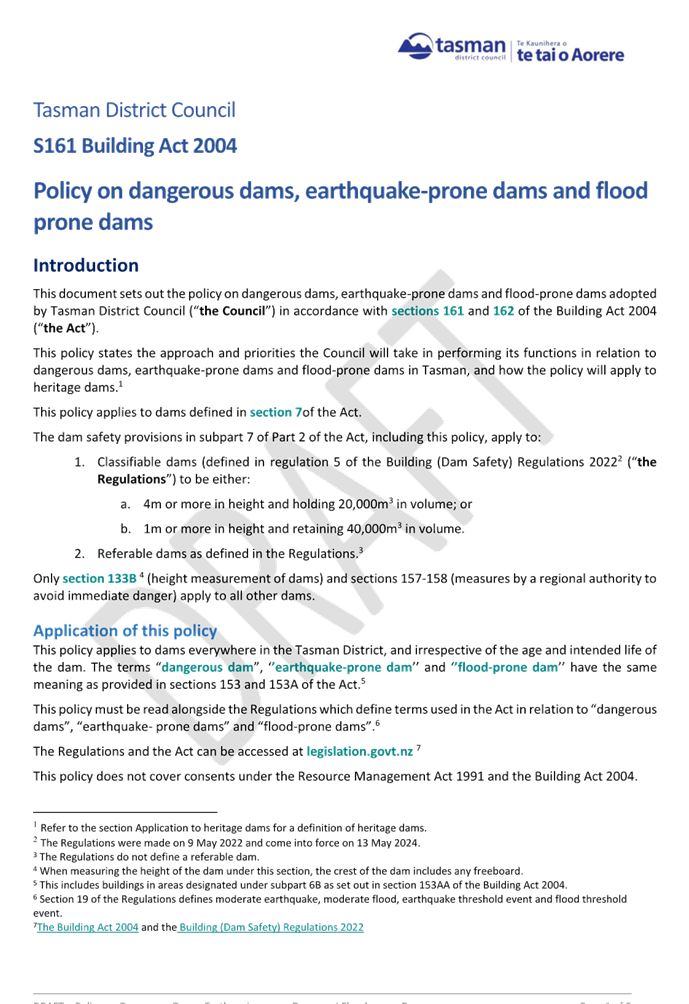
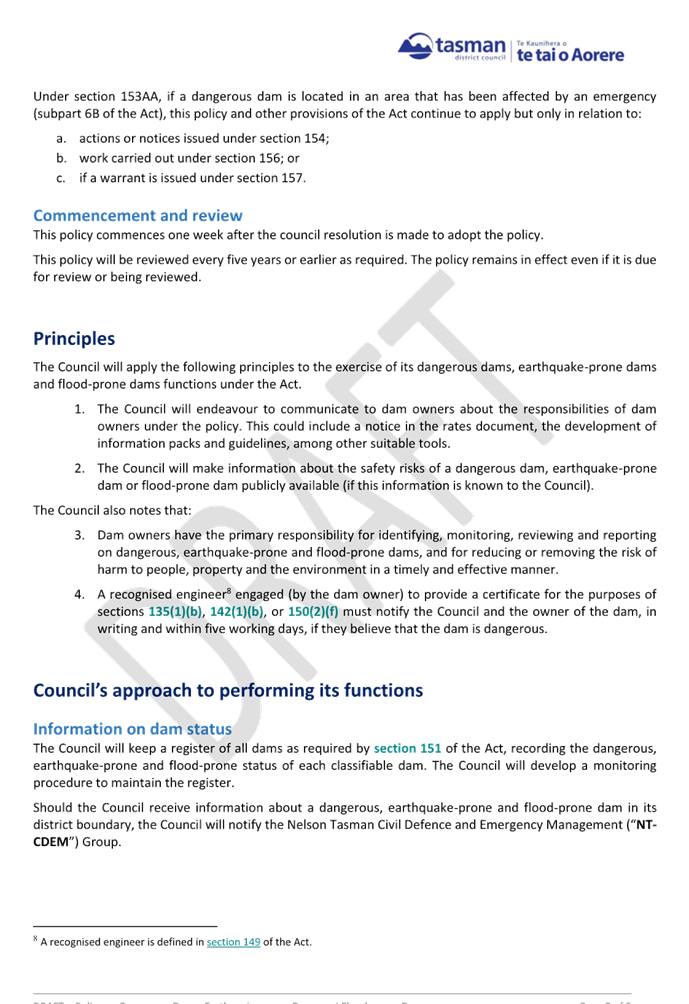
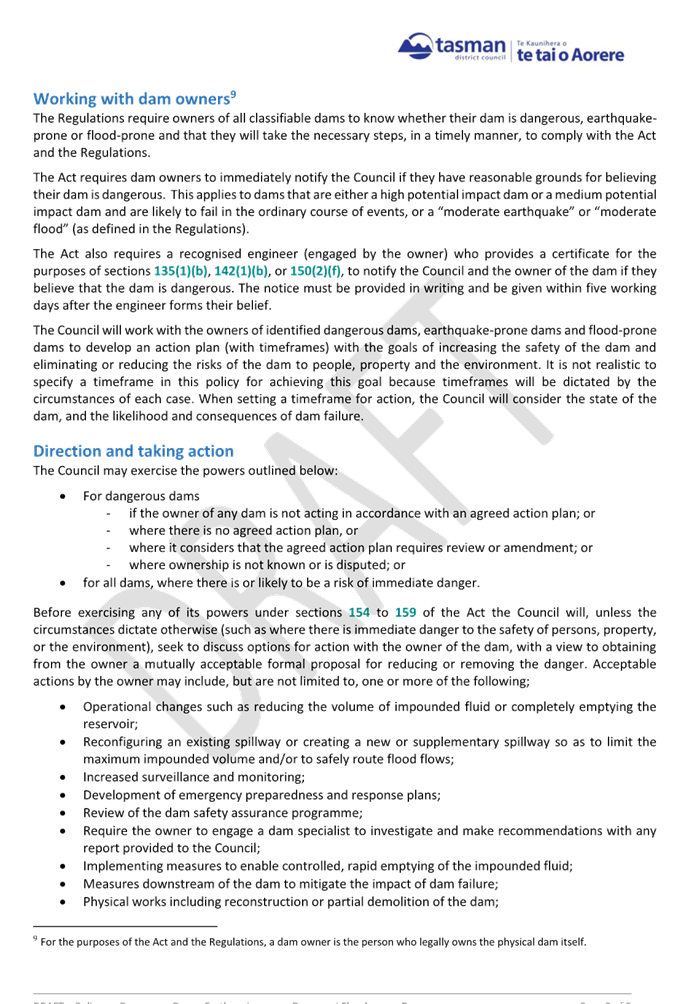
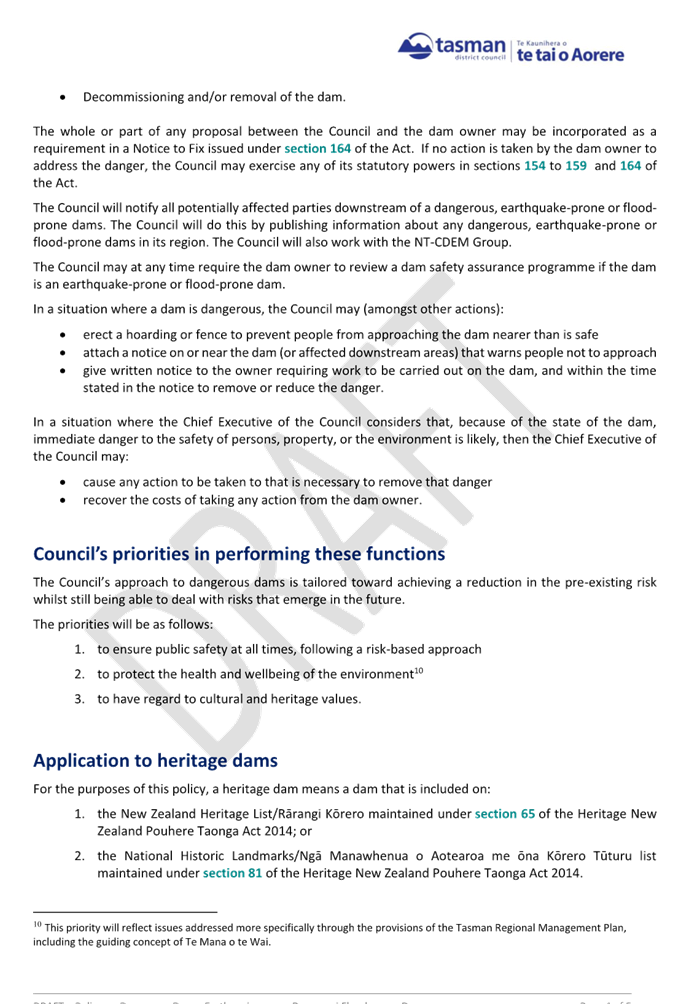

Tasman District Council Agenda – 28 March 2024
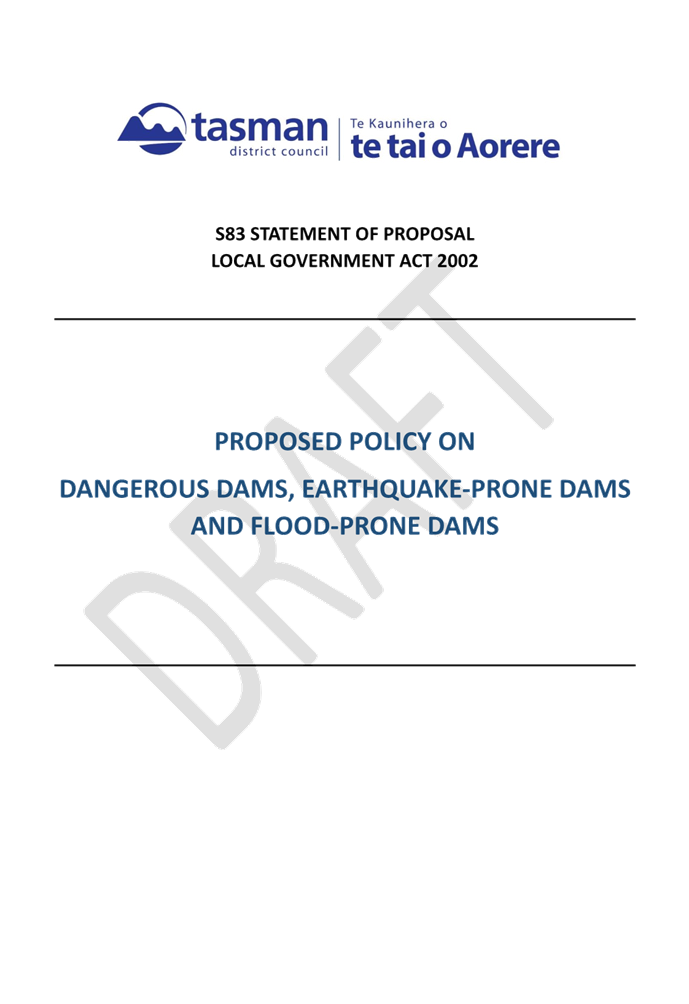
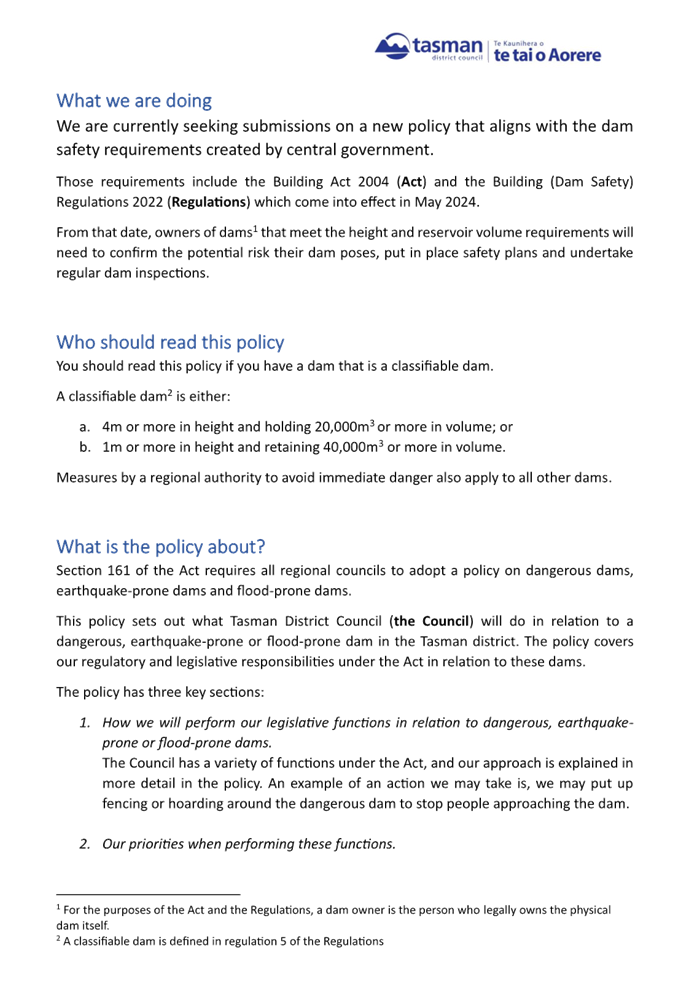
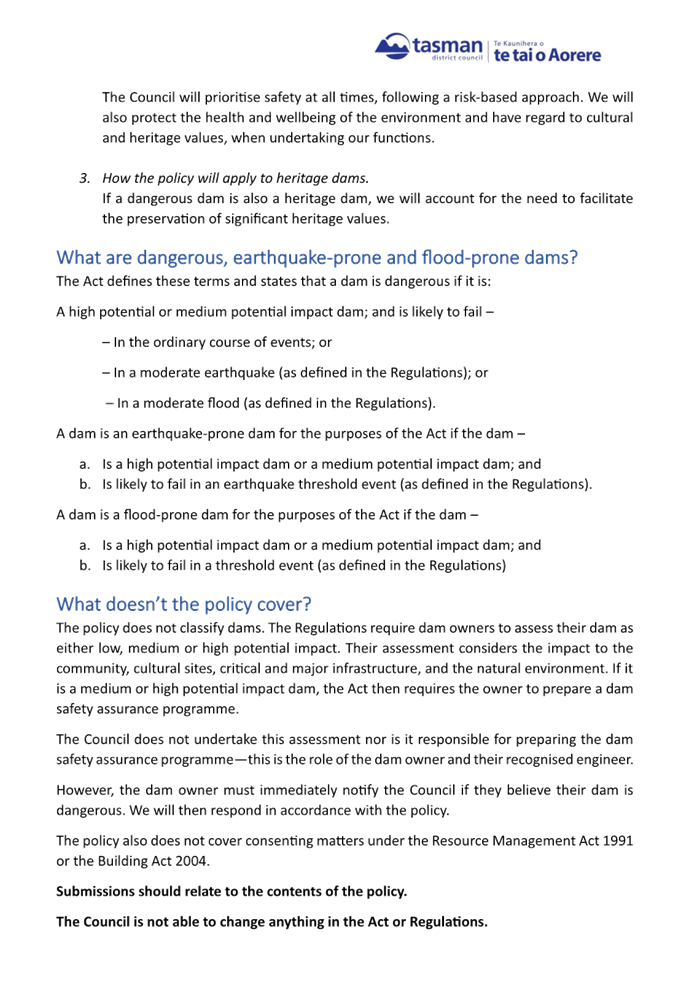
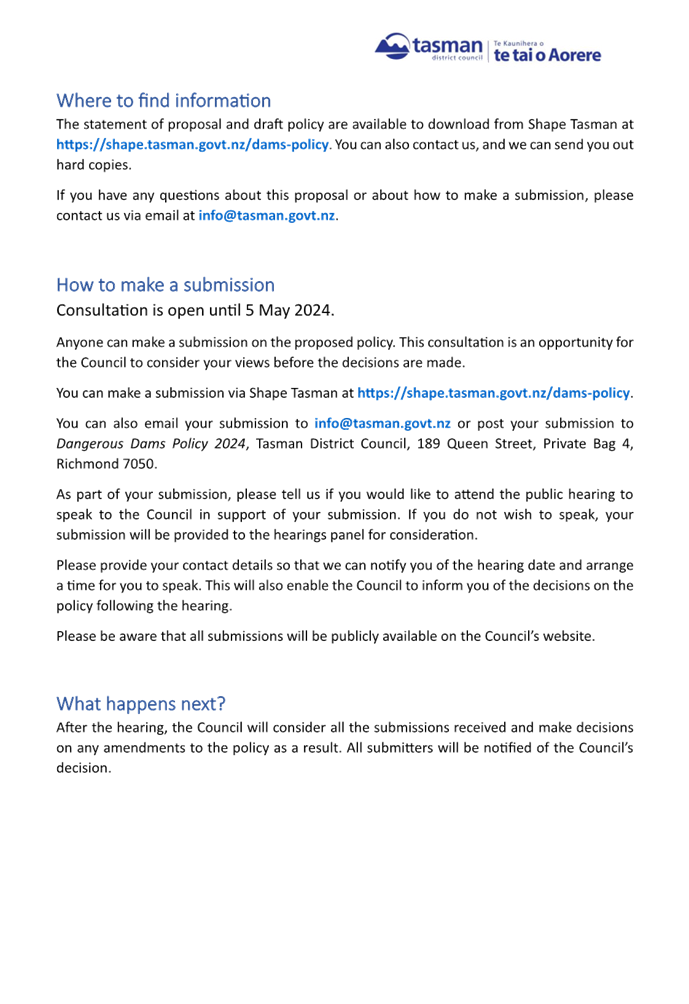
Tasman District Council Agenda – 28 March 2024
7.10 Delegations to the Chief Executive Officer and Staff
Decision Required
|
Report
To:
|
Tasman
District Council
|
|
Meeting
Date:
|
28
March 2024
|
|
Report
Author:
|
Jennie
McFarlane, Legal & Democracy Services Manager; Leith Townshend, Team
Leader - Legal
|
|
Report
Authorisers:
|
Joanna
Cranness, People, Safety & Wellbeing Manager
|
|
Report
Number:
|
RCN24-03-14
|
1. Purpose
of the Report / Te Take mō te Pūrongo
1.1 To
authorise and amend delegations to the Environment and Regulatory Committee, to
the Chief Executive Officer and to staff. This is to ensure that there are
appropriate delegations in place for decision making and the efficient
operation of Council business.
2. Summary
/ Te Tuhinga Whakarāpoto
2.1 This
report seeks to ensure that Council committees, the Chief Executive Officer and
staff have appropriate delegations which they require for their roles. Staff
have recently identified the need for some additional or amended delegations.
2.2 The
amendments to the delegations are for the purposes of:
2.2.1 Authorising and amending delegations to the Environment
and Regulatory Committee, to the Chief Executive Officer and to staff in
relation to powers under the Local Government Act 1974 (LGA 1974) and the Local
Government Act 2002 (LGA 2002). The powers relate to transport shelters and
roads under the LGA 1974 and to bylaws and s17A reviews under the LGA 2002.
2.2.2 Amending the existing delegation in relation to the
naming of streets under the Council’s Street Naming Policy to cover
existing as well as new streets and to ensure that the Chief Executive Officer
has the delegation as well as the Group Manager – Environmental
Assurance.
2.2.3 Providing general property delegations, including those
under the Land Transfer Act 2017, to Council staff in relation to easements,
caveats, encumbrances, covenants, and other similar property instruments to
ensure staff have clear delegations to act and also respond to requests for the
removal of historic instruments.
3. Recommendation/s
/ Ngā Tūtohunga
That the Tasman District Council
1. receives the
Delegations to the Chief Executive Officer and Staff report RCN24-03-14; and
2. delegates the Council’s powers under s339
(Transport shelters) of the Local Government Act 1974 in Attachment 1 to the
agenda report, to the Environment and Regulatory Committee, pursuant to clause
32 Schedule 7 of the Local Government Act 2002; and
3. delegates, pursuant to clause 32 Schedule 7 of the
Local Government Act 2002, the Council’s powers under section 353
(General safety provisions as to roads), section 356 (Removal of abandoned
vehicles from roads) and section 356A (Further provision in relation to removal
of vehicles from roads) of the Local Government Act 1974 in Attachment 1 to the
agenda report, to the following staff:
· Chief Executive Officer (includes Acting Chief
Executive Officer)
· Group Manager - Community Infrastructure
· Group Manager - Environmental Assurance
· Transportation Manager
· Regulatory Manager
· Reserves and Facilities Manager
· Team Leader Compliance and Investigations –
(Land and Air)
· Team Leader Compliance and Investigations –
(Water and Waste)
· Senior Compliance and Investigations Officer
· Compliance and Investigations Officer
· Council contractors acting under contract and the
Council’s authority; and
4. revokes the Council’s delegation to the
Environment and Regulatory Committee of its powers under Part 8 of the Local
Government Act 2002 in relation to the making of bylaws, pursuant to clause 32
Schedule 7 Local Government Act 2002, noting that the Committee has delegated
authority to undertake bylaw preparation processes but only the Council can
make a bylaw; and
5. delegates
to the Chief Executive Officer the Council’s powers under section 17A of
the Local Government Act 2002 in
Attachment 1 to the agenda report, pursuant to clause 32 Schedule 7 of the Local Government Act 2002,
in relation to:
5.1 the provision of Electoral
Services by the Council; and
5.2 the
provision of Legal Services by the Council, due to the expiry of contracts
providing some of these services; and
6. notes
that staff are preparing a proposed Council policy on section 17A of the Local
Government Act 2002 covering its requirements and which functions and decisions
could be delegated, a report with the draft Policy will be presented to the
Council at a later date; and
7. amends
the delegation set out in section 5.6 Part Three Management of the
Council’s Delegations Register, pursuant
to clause 32 Schedule 7 of the Local Government Act 2002,
FROM:
Authority delegated to the Group Manager
Environmental Assurance to decide on
street names for new sub divisional roads in accordance with the Council and in
consultation with a Ward Councillor or the Community Board
TO:
Delegates authority to the
Chief Executive Officer and to the Group Manager – Environmental
Assurance to decide on street names for new and existing roads in accordance
with the Council’s Street Naming Policy and in consultation with the Councillors
or the Community Board (if any) for the Ward where the roads are located; and
8. delegates to the Chief Executive Officer, to the Tier
Two Group Managers and to the Enterprise and Property Services Manager, the
Council’s powers under sections 109, 112, 138, 142, 143, 144 and 145 of
the Land Transfer Act 2017 and the following property delegations (to be added
to the delegation in the Council’s Delegations Register – Part
Three Management – cl5.3 e)), pursuant clause 32 Schedule 7 of the Local
Government Act 2002:
8.1 Authority
to approve the granting, removal or providing consent in relation to property
instruments on land titles in favour of the Council (such as easements,
caveats, encumbrances, or covenants) other than where the approval of the
Council or a Committee is required by legislation; and
8.2 Authority
to authorise the removal of historic or redundant instruments registered on
land titles, provided that staff investigations confirm either (a) the reason
for registering the instrument is no longer valid, or (b) the property is now
compliant with current legislation / planning rules, or (c) the agreement which
supports the instrument is unable to be located and thus the instrument cannot
be enforced.
Delegations
4.1 The
Council has the power under local government legislation, particularly the LGA
2002, to delegate certain powers, functions and duties to committees,
sub-committees, sub-ordinate decision-making bodies, to the Chief Executive
Officer and to staff.
4.2 The
nature of local government involves decisions at both governance and
operational levels. Governance decisions and activities are exercised by
members of the Council, committee, sub-committee, or subordinate
decision-making bodies. The governance role includes (but is not limited to)
setting the strategic and overall direction of the Council and approving the
Long-Term Plan/annual plan, key planning documents and policies. Most councils
operate on a policy of delegating authority to the lowest level possible, to
ensure efficiency.
4.3 Staff
have recently identified the need for certain additional or amended delegations
to be given to the Environment and Regulatory Committee, to the Chief Executive
Officer and to staff.
5. Analysis
and Advice / Tātaritanga me ngā tohutohu
Local Government Act 1974 (LGA 1974) and Local Government Act
2002 (LGA 2002)
5.1 It
appears that powers in relation to transport (bus) shelters have been given to
the Environment and Regulatory Committee under s374 which is now repealed, and
which related to regional motorways. The powers in relation to transport
shelters are contained in s339 of the LGA 1974
and require to be delegated to the Committee.
5.2 Council staff have
recently identified that some but not all powers which relate to the safety of
roads have been delegated to staff. Powers such as the power to remove
abandoned vehicles have not been specifically delegated to staff. Exercising
the power requires a Council decision, for example, to authorise the removal
and sale of an abandoned vehicle.
5.3 This is not practical.
Making these decisions, which can require quick action is not considered an
efficient use of the Council or a committee’s time. In addition, the
storage of vehicles removed incurs costs which may have to be borne by the
Council if unrecovered, so it is important that decision making is as efficient
as possible. There are some existing roading powers under the LGA 1974
delegated to staff, and the proposed additional delegations should be delegated
to the same staff.
5.4 An amendment to
delegations is also required in relation to the Council’s bylaw powers
under Part 8 of the LGA 2002 as only the Council can make a bylaw, this power
cannot be subdelegated. The current delegations give powers to the Environment
and Regulatory Committee which has authority to undertake bylaw preparation
processes but the decision to make law in the form of a bylaw sits with the
Council.
Section 17A reviews
5.5 The report seeks authority for
the Chief Executive to exercise the Council’s powers under s17A of the
LGA 2002. A change made to the LGA 2002 in 2014 means that
local authorities are under an obligation to review the cost-effectiveness of
current arrangements for meeting community needs for good quality
infrastructure, local public services, and local regulation. This ensures that
councils regularly review long standing contracts and arrangements for how they
deliver services. This supports good procurement practice. The LGA 2002
provides for exemptions from this requirement in certain circumstances.
5.6 Where a review is undertaken, local
authorities must consider options for the governance, funding and delivery of
infrastructure, local public services and local regulation that include, but
are not limited to:
· in-house delivery;
· delivery by a CCO, whether wholly owned by the local authority, or a
CCO where the local authority is a part owner;
· another local authority;
· another person or agency (for example central government, a private
sector organisation or a community group).
5.7 Conducting regular section 17A
reviews is a good way of demonstrating that a council is delivering activities
in a cost-effective manner for the local authority (and therefore ultimately
households and businesses).
5.8 The
Council can delegate its powers under s17A LGA 2002, but the Council has not
done this as yet. Other councils have delegated authority to the Chief
Executive Officer to exercise the powers in certain circumstances. Council
staff are preparing a policy on s17A reviews and where decisions should be made
which will be brought to the Council later this year, but an interim delegation
is required in relation to two activities being the provision of electoral
services and the provision of legal services, due to contracts expiring.
Provision of
electoral services
5.9 For
the 2022 triennial elections, the Council contracted the provision of certain
electoral services. These services are primarily used to produce the voting
papers and candidate booklets as well as to process the votes. Most councils do
not provide these services in-house now due to the specialist knowledge,
technology and additional resourcing required. It is not cost-effective to do
so for a process that usually only occurs every three years (noting that many
other elections tasks are still undertaken by staff, it is a significant
district wide project).
5.10 The
contract for electoral services in 2021/2022 was for the purpose of those
elections and has expired. The Council needs to go to the market for a provider
of electoral services, with a procurement process planned this year for the
2025 local government elections. Year 1 of the Long-Term Plan includes
provision for an elections budget to commence from 1 July 2024 for the 2025
elections,
5.11 Prior to going to the market, a s17A review
should be undertaken by the Council. However, the LGA makes provision for
exemptions from a s17A review, where ‘the local
authority is satisfied that the potential benefits of undertaking a review in
relation to that infrastructure, service, or regulatory function do not justify
the costs of undertaking the review’.
5.12 Staff believe that this applies to the provision of
electoral services. There are only two electoral services providers in
the market. It would not be cost-effective for the Council to obtain and
provide the resources and technology required to be able to deliver the
elections fully in-house. The two providers offer considerable expertise and
have invested significantly in resources and technology as they undertake
elections for a variety of organisations all year round, most of these being
electronic processes.
5.13 In the view of staff, it is considered that
the costs of a s17A review do not outweigh the benefits of undertaking the
review and that authority can be delegated to the Chief Executive Officer to
exercise the Council’s powers in relation to s17A for these services. If
authority is approved, a report will be prepared for the Executive Leadership
Team and the Chief Executive Officer to consider prior to any decision being
made by the Chief Executive Officer.
5.14 The reasons for the Chief Executive Officer
to be given delegated authority to exercise the Council’s s17A powers
relate to the value of the contract which is likely to be less than $500,000
(for the 2025 elections) and well within the financial authority of the Chief
Executive Officer to approve. This is a similar approach taken by other
councils. If there is provision in the contract for review and further
elections, increasing the overall value of the contract, decisions for renewal
can come to the Council and the Tenders Procurement Panel if required.
Provision of Legal Services
5.15 The Council has a shared panel of external
legal providers with Nelson City Council. The umbrella contract with the
providers expires in late 2024. The Council’s Legal Team is working with
the Legal Team at Nelson City Council to prepare for a joint procurement
process. Nearing the end of a contract is one of the triggers for a s17A
review.
5.16 In 2023 the Legal and Democracy Services
Team commissioned an independent review of the Council’s legal function
to inform decisions on how legal services should be provided in the future. The
key finding of the review is that the current mix of in-house and external
legal advisors delivering legal services is working, with legal spend reducing
over the last few years. A full copy of the review report was provided to the
Audit and Risk Committee at its meeting on 21 March 2024.
5.17 If authority is delegated to the Chief
Executive Officer to exercise the Council’s powers in relation to s17A
for this service, a report including a copy of the independent review, will be
prepared for the Executive Leadership Team and the Chief Executive Officer to
consider prior to any decision being made by the Chief Executive Officer.
5.18 The reasons for the Chief Executive Officer
to be given delegated authority to exercise the Council’s s17A powers in
this case relate more to the nature of the services. The provision of legal
services is internal to the Council, its committees and community boards, to
the Chief Executive Officer and to staff. The Council’s solicitors cannot
provide legal advice to any other parties or to the public.
5.19 The general focus of s17A relates to
services the Council provides to its communities in the form of infrastructure,
public services, and local regulation. The provision of legal services assists
the Council in delivering those services. However, as there are contracts in
place with legal providers, it is still appropriate to undertake a review of
the legal services function, but any decisions can sit at a Chief Executive
Officer level as they are more operational in nature.
Delegations Register Part Three Management s5.6 Street names
5.20 The Council has previously made the
following delegation to the Group Manager – Environmental Assurance:
Power to decide on street names for new sub
divisional roads in accordance with the Council and in consultation with a Ward
Councillor or the Community Board
5.21 A situation has arisen in relation to
the change of an existing road name in accordance with the Council’s
Street Naming Policy. This is not explicitly covered in the delegation so
before any decision is made it is prudent to ensure that the correct delegation
is in place.
5.22 The amendment to the delegation also
makes it clear that the decision is made by the delegated staff in consultation
with the ward members or Community Boards.
5.23 Finally, it is considered prudent
that the Chief Executive Officer also be delegated this authority. Where
possible there should always be more than one officer holding a delegation, to
ensure there should be at least one available to act.
Land Transfer Act 2017/ property delegations
Delegation to remove or consent to amendments or changes to historic
instruments
5.24 On occasion, lawyers acting for
clients approach the Council in relation to historical instruments registered
on their clients’ land titles in favour of the Council. They typically
pre-date the Resource Management Act 1991 (RMA) and Building Act 2004 and were
often put in place under legislation which has now been repealed.
5.25 The two most recent requests were
received in late 2023 and early 2024. One request asks that the Council remove
a historic and unnecessary caveat and the other seeks the Council’s
consent in relation to another instrument to be registered on the title.
5.26 The most common reason for these
caveats being placed on a title seems to be the establishment of a
“Granny Flat” in the 1980s which required the building to be
removed after “Granny” is no longer living there. However, there
are also situations where caveats are put in place to ensure that two separate
parcels of land are sold together (which would now be managed under the
RMA).
5.27 On occasion the Council has been
forced to agree to remove the caveat because a copy of the original agreement
cannot be found.
5.28 Where legislation has been repealed
under which the instrument has been created, there is uncertainty in relation
to authority to deal with the instrument. At present there are some limited
operational property delegations held by staff but no delegations under the
Land Transfer Act 2017 (LTA 2017) which contains powers in relation to property
instruments such as easements, caveats, and encumbrances.
5.29 It is important for the Council to be
able to respond to these requests quickly and pragmatically as often the
caveats are only noticed at the time that a property is in the process of being
sold and ownership transferred. Any delay at the Council’s end could
cause the sale to either fall through or be delayed which may expose the
Council to risk.
5.30 The additions and amendments to
delegations proposed in the recommendations in section three of the report are
for the purpose of reducing risk by ensuring that appropriate delegations are
in place. This also increases the efficiency and effectiveness of Council
processes. Approving them would mean that decisions can be made quickly and at
the correct level.
5.31 The specific delegations to the Chief
Executive Officer and staff are considered to be operational powers suitable
for delegation.
5.32 The amendment to the street naming
delegation is considered low risk and clarifying the decision-making powers in
accordance with the Council’s policy.
6.1 The options are outlined
in the following table:
|
Option
|
Advantage
|
Disadvantage
|
|
1.
|
Approve the additional and amended delegations
|
Addresses potential risk of decisions being made without
authority.
Means fewer reports to the Council on low level matters or issues.
|
As with any delegation there is a risk that staff will make a
decision that the Council feels should have been made at a governance level.
However, it is aways an option for staff to refer the decision-making to the
Council if they believe that the decision relates to governance.
|
|
2.
|
Decline to approve the amended/additional delegations
|
The Council retains control over decision making.
|
Increased administrative burden on staff and the Council as more
decision reports will need to be drafted and considered.
Increased time for decision making.
Potential risk to the Council that decisions can be challenged due
to being made without authority.
|
6.2 Option one is
recommended.
Clause 32 Schedule 7 of the LGA 2002
7.1 There are some powers that
cannot be delegated by the Council. These powers are:
(a) the power to make a rate;
or
(b) the power to make a bylaw;
or
(c) the power to borrow money,
or purchase or dispose of assets, other than in accordance with the
long-term plan; or
(d) the power to adopt a
long-term plan, annual plan, or annual report; or
(e) the power to appoint a
chief executive; or
(f) the power to adopt
policies required to be adopted and consulted on under this Act in association
with the long-term plan or developed for the purpose of the local
governance statement; or
(g) [Repealed]
(h) the power to adopt a
remuneration and employment policy.
7.2 Staff are encouraged to
engage with members of the Council’s Legal and Democracy Services team if
there are any concerns about whether they have the delegated authority to make
decisions.
7.3 A function or power can
generally be sub-delegated, subject to any conditions imposed by the person or
entity that made the original delegation. At this time, it is not proposed to
put any limits on sub-delegation.
7.4 With all the proposed
delegations if either a committee or staff member considers that because of the
nature of the decision that it would be preferable for the Council to make the
decision then it is appropriate for the staff member to put the decision before
the Council.
Section 17 A
LGA 2002
7.5 Section 17A Delivery of
services is set out below:
(1) A local authority must review the cost-effectiveness of
current arrangements for meeting the needs of communities within its district
or region for good-quality local infrastructure, local public services, and
performance of regulatory functions.
(2) Subject to subsection (3), a review under subsection (1)
must be undertaken—
(a) in conjunction with consideration of any significant
change to relevant service levels; and
(b) within 2 years before the expiry of any contract or other
binding agreement relating to the delivery of that infrastructure, service, or
regulatory function; and
(c) at such other times as the local authority considers
desirable, but not later than 6 years following the last review under
subsection (1).
(3) Despite subsection (2)(c), a
local authority is not required to undertake a review under subsection (1) in
relation to the governance, funding, and delivery of any infrastructure,
service, or regulatory function—
(a) to the extent that the delivery of that infrastructure,
service, or regulatory function is governed by legislation, contract, or other
binding agreement such that it cannot reasonably be altered within the
following 2 years; or
(b) if the local authority is satisfied that the potential
benefits of undertaking a review in relation to that infrastructure, service,
or regulatory function do not justify the costs of undertaking the review.
(4) A review under subsection (1) must consider options for
the governance, funding, and delivery of infrastructure, services, and
regulatory functions, including, but not limited to, the following options:
(a) responsibility for governance, funding, and delivery is
exercised by the local authority:
(b) responsibility for governance and funding is exercised by
the local authority, and responsibility for delivery is exercised by—
(i) a
council-controlled organisation of the local authority; or
(ii) a
council-controlled organisation in which the local authority is one of several
shareholders; or
(iii) another
local authority; or
(iv)another
person or agency:
(c) responsibility for governance and funding is delegated to
a joint committee or other shared governance arrangement, and responsibility
for delivery is exercised by an entity or a person listed in paragraph (b)(i) to (iv).
(5) If responsibility for delivery of infrastructure,
services, or regulatory functions is to be undertaken by a different entity
from that responsible for governance, the entity that is responsible for
governance must ensure that there is a contract or other binding agreement that
clearly specifies—
(a) the required service levels; and
(b) the performance measures and targets to be used to assess
compliance with the required service levels; and
(c) how performance is to be assessed and reported; and
(d) how the costs of delivery are to be met; and
(e) how any risks are to be managed; and
(f) what penalties for non-performance may be applied; and
(g) how accountability is to be enforced.
(6) Subsection (5) does not apply to an arrangement to the
extent that any of the matters specified in paragraphs (a) to (g) are—
(a) governed by any provision in an enactment; or
(b) specified in the constitution or statement of intent of a
council-controlled organisation.
(7) Subsection (5) does not apply to an arrangement if the
entity that is responsible for governance is satisfied that—
(a) the entity responsible for delivery is a community group
or a not-for-profit organisation; and
(b) the arrangement does not involve significant cost or risk
to any local authority.
(8) The entity that is responsible for governance must ensure
that any agreement under subsection (5) is made publicly available.
(9) Nothing in this section requires the entity that is
responsible for governance to make publicly accessible any information that may
be properly withheld if a request for that information were made under the
Local Government Official Information and Meetings Act 1987.
8. Iwi
Engagement / Whakawhitiwhiti ā-Hapori Māori
8.1 Iwi have not been engaged
in relation to this report.
9. Significance
and Engagement / Hiranga me te Whakawhitiwhiti ā-Hapori Whānui
9.1 Overall, the significance
of these delegations is considered low.
|
|
Issue
|
Level of Significance
|
Explanation of Assessment
|
|
1.
|
Is there a high level of public interest, or is decision
likely to be controversial?
|
Low
|
However, the effect is simply to approve administrative
efficiency at the Council, and it is considered there is a low level of
interest in staff delegations.
|
|
2.
|
Are there impacts on the social, economic, environmental
or cultural aspects of well-being of the community in the present or future?
|
Low
|
|
|
3.
|
Is there a significant impact arising from duration of
the effects from the decision?
|
NA
|
|
|
4.
|
Does the decision relate to a strategic asset? (refer
Significance and Engagement Policy for list of strategic assets)
|
NA
|
|
|
5.
|
Does the decision create a substantial change in the
level of service provided by Council?
|
NA
|
|
|
6.
|
Does the proposal, activity or decision substantially
affect debt, rates or Council finances in any one year or more of the LTP?
|
NA
|
|
|
7.
|
Does the decision involve the sale of a substantial
proportion or controlling interest in a CCO or CCTO?
|
NA
|
|
|
8.
|
Does the proposal or decision involve entry into a
private sector partnership or contract to carry out the deliver on any
Council group of activities?
|
NA
|
|
|
9.
|
Does the proposal or decision involve Council exiting
from or entering into a group of activities?
|
NA
|
|
|
10.
|
Does the proposal require particular consideration of the
obligations of Te Mana O Te Wai (TMOTW) relating to freshwater and Affordable
Waters services?
|
NA
|
|
10. Communication
/ Whakawhitiwhiti Kōrero
10.1 No communications plan is required in
relation to this decision.
11. Financial
or Budgetary Implications / Ngā Ritenga ā-Pūtea
11.1 It is not
considered that any of the delegations will have a financial or budgetary
impact. There are potential benefits as staff will spend less time bringing
decision reports to the Council where decisions are better made at an
operational level.
12.1 One of the
purposes of checking and reviewing delegations regularly is to address risk and
ensure decisions are being made under the correct delegated authority.
12.2 The risks
associated with these delegations are considered low and they will reduce risk
to the Council by ensuring prompt action by the Council where required. In any
event, if staff or a committee member feel that for whatever reason they should
not exercise their delegation, they do not have to exercise it and can always
elevate the decisions to their manager or to the Council.
12.3 It is important
that the decisions staff need to make are well documented and supported by the
appropriate delegations.
13. Conclusion
/ Kupu Whakatepe
13.1 The delegations proposed are designed
to increase the efficiency of the management of Council business and ensure
delegations are correct.
14. Next
Steps and Timeline / Ngā Mahi Whai Ake
14.1 If approved the Delegations Register
will be updated and republished.
|
1.⇩
|
List of
Legislation to be delegated
|
253
|
Tasman District
Council
Agenda – 28 March 2024
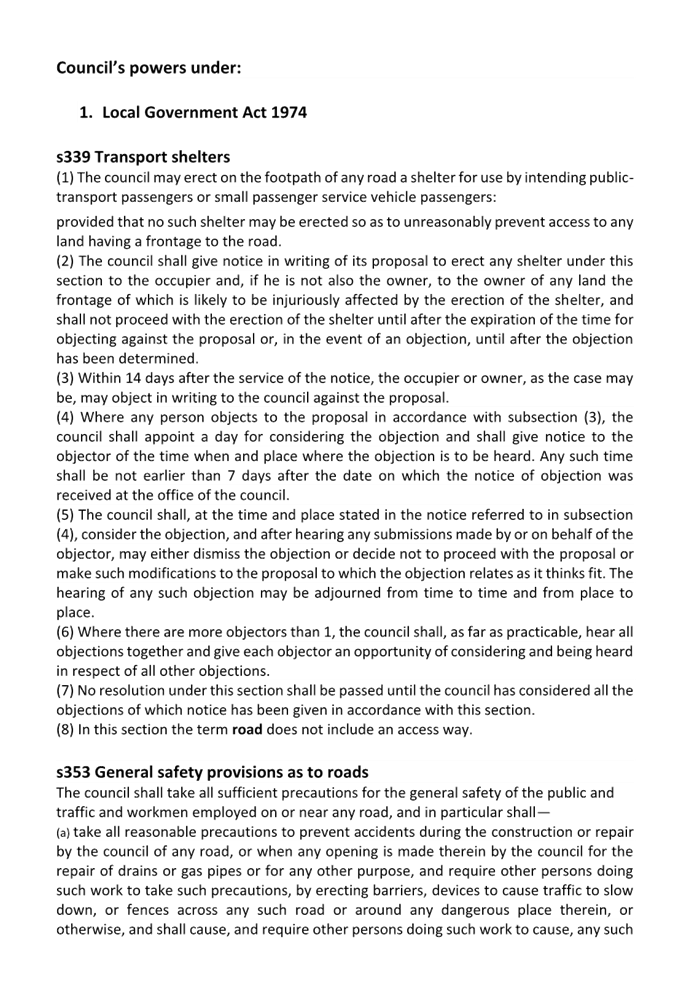
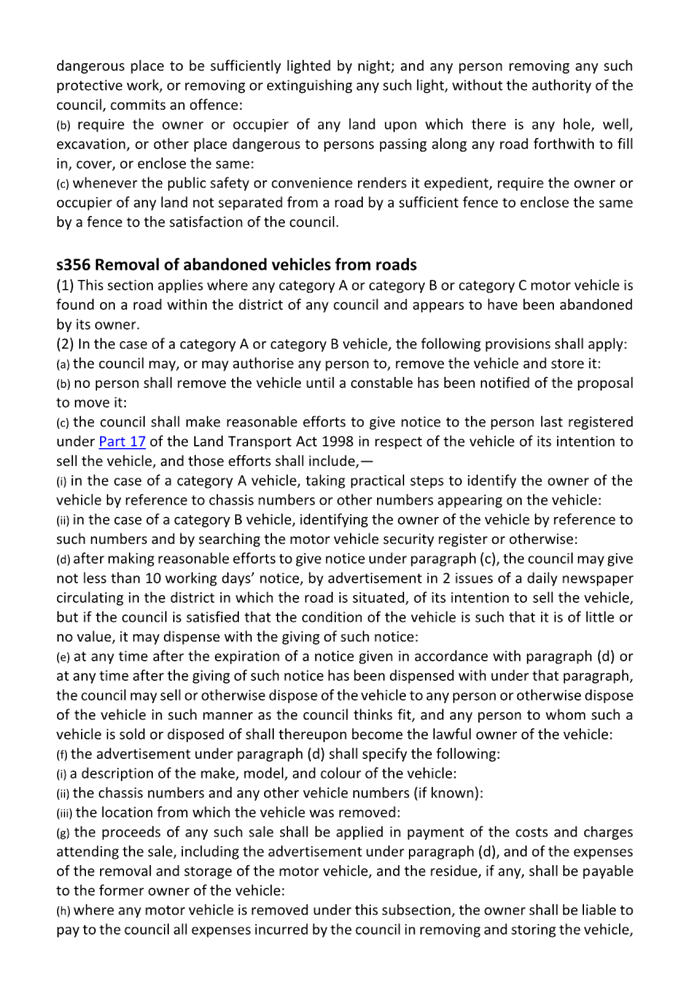
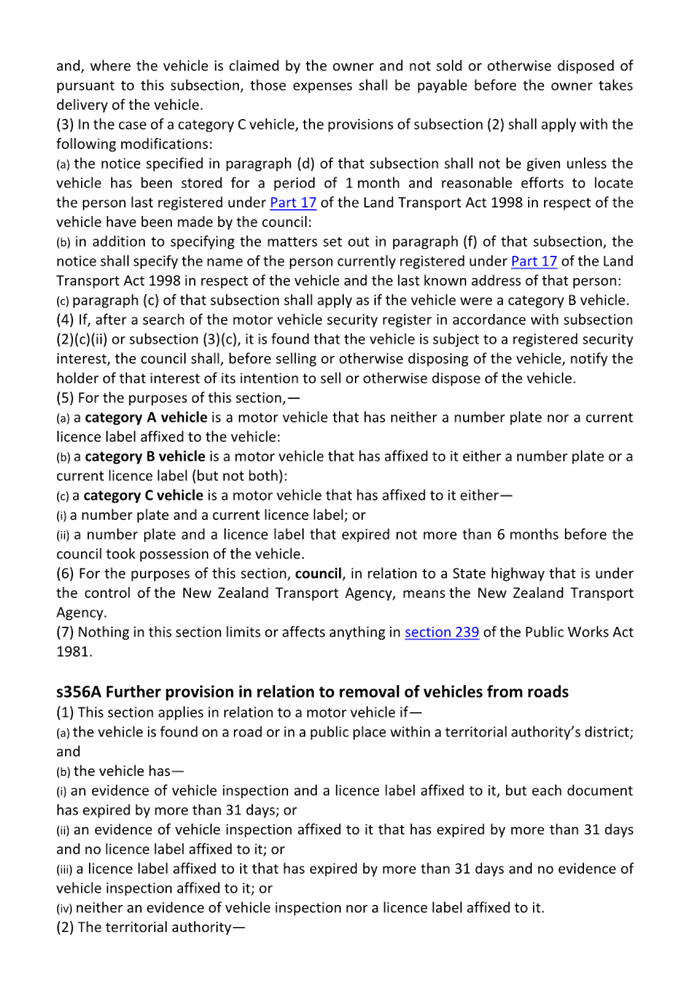
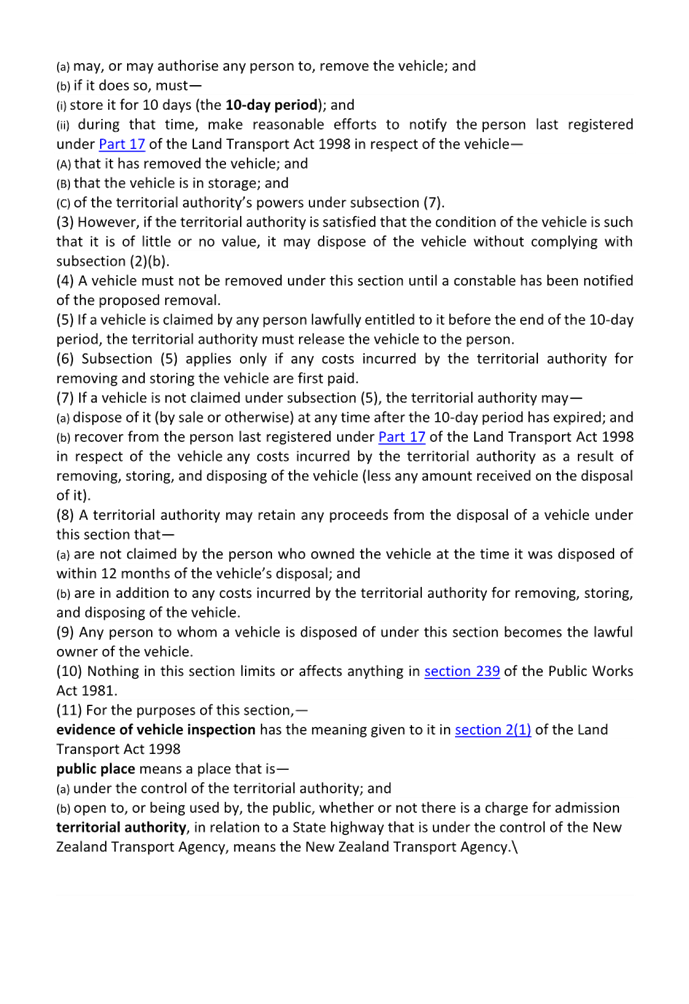
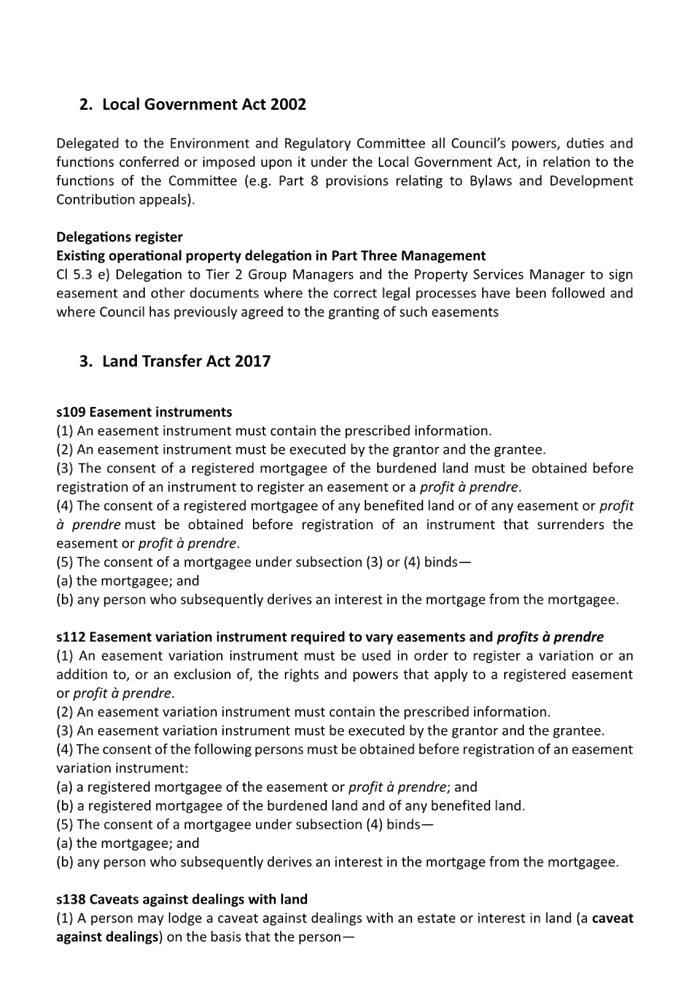
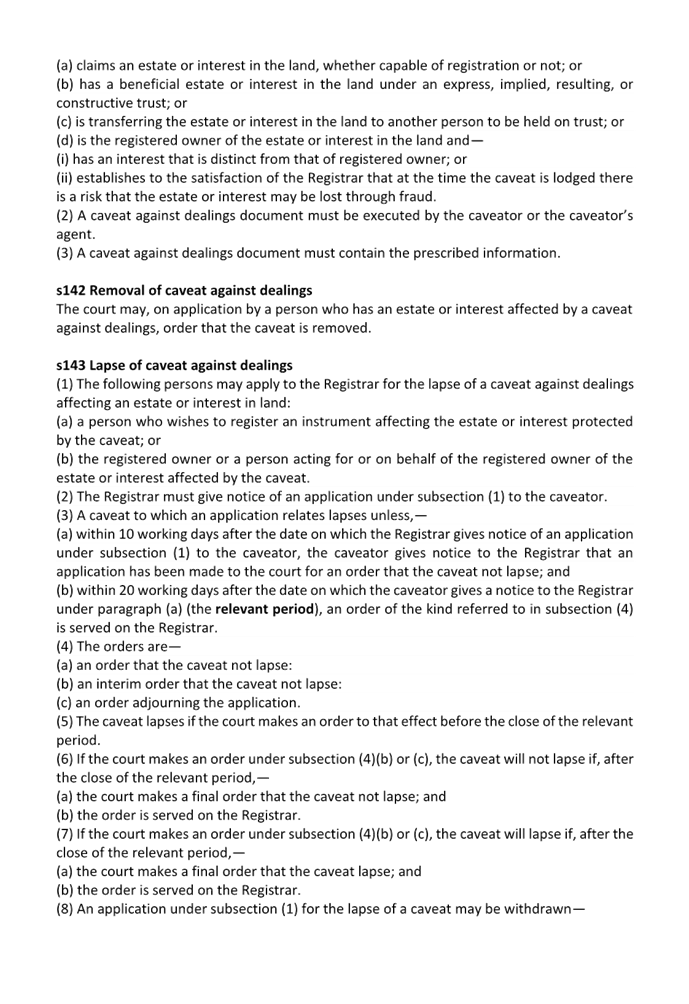
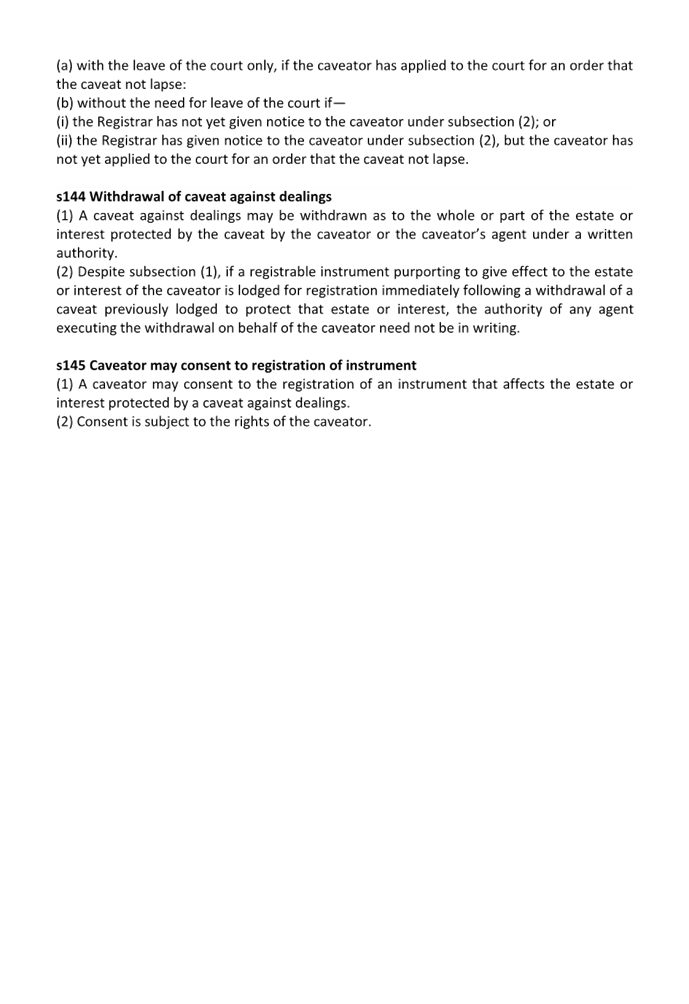
Tasman District Council Agenda – 28 March 2024
7.11 Local Government Funding Agency - Draft Statement of Intent
2024-2027
Decision Required
|
Report
To:
|
Tasman
District Council
|
|
Meeting
Date:
|
28
March 2024
|
|
Report
Author:
|
Mike
Drummond, Group Manager - Finance
|
|
Report
Authorisers:
|
Leonie
Rae, Acting Chief Executive Officer
|
|
Report
Number:
|
RCN24-03-15
|
1. Summary
/ Te Tuhinga Whakarāpoto
1.1 In
November 2023, the Local Government Shareholder Council sent its Letter of
Expectations to the Local Government Funding Agency (LGFA) (Attachment 1).
1.2 The
draft Statement of Intent (SOI) for 2024-2027 has now been received (Attachment
2) with a letter from Mark Butcher, Chief Executive, LGFA dated 28 February
2024, addressing Shareholder Expectations and the draft SOI (Attachment 3).
1.3 The
draft SOI continues the LGFA transition to providing a more flexible and
sustainable lending programme to councils.
1.4 This
draft SOI, including financial forecasts, assumes that there are no
implications for LGFA from the Local Water Done Well Programme. The LGFA is
awaiting further information as the enabling legislation is due to be
introduced in June and December 2024 but are assuming in the meantime a
business-as-usual approach to council and CCO borrowing. The final SOI due in
June 2024 will be updated from this draft to incorporate any future
announcements and will include a statement if there have been any material
changes to the LGFA forecast assumptions.
1.5 Key
points from the draft SOI are set out in Section 4 of this report.
1.6 The
Shareholders’ Council will meet prior to the final Statement of Intent
being adopted to provide feedback to the LGFA. As a member of the
Shareholders’ Council, our participation in this process is encouraged.
Any Council feedback can be provided to the Group Manager – Finance who
is the Council’s representative on the LGFA Shareholders’ Council.
1.7 Comments
and feedback on the draft SOI are due by 1 May 2024. The final SOI will be
provided to Shareholders by 30 June 2024.
1.8 Staff
recommend that the Council agrees to the draft Statement of Intent and
acknowledges that the Local Government Funding Agency Shareholders’
Council will provide feedback (if any) on the draft Statement of Intent on
behalf of all the Shareholding Councils.
2. Recommendation/s
/ Ngā Tūtohunga
That the Tasman District Council
1. receives the Local Government Funding Agency - Draft Statement of
Intent 2024-2027 Report, RCN23-03-15; and
2. receives
the Local Government Funding Agency draft Statement of Intent 2024/27 (Attachment
2 to the agenda report); and
3. agrees
to the draft Statement of Intent (Attachment 2 to the agenda report) and
acknowledges that the Local Government Funding Agency Shareholders’
Council will provide feedback (if any) on the draft Statement of Intent on
behalf of Shareholding Councils; and
4. receives
the letter from the Chief Executive, Local Government Funding Agency, dated 28
February 2024 (Attachment 3 to the agenda report).
3.1 To
provide an update on the Local Government Funding Agency draft Statement of
Intent 2024-2027 and receive any feedback from the Council on this draft.
4. Background
and Discussion
4.1 This
is a routine report on the LGFA draft statement of intent. The Group Manager
Finance engages regularly with the LGFA and participates on the shareholders
council.
4.2 The
LGFA Shareholders Council on behalf of shareholders presented a Statement of
Expectations to the Company in November 2023 (Attachment 1). The
statement of Expectations covers areas of focus the council wishes the company
to consider in developing its draft SOI.
4.3 We
have received the LGFA draft Statement of Intent (SOI) for the 2024-2027 years (Attachment
2) and accompanying letter from the Chief Executive (Attachment 3).
4.4 The
Shareholders’ Council (SC) will meet again prior to the final SOI being
received and will provide further feedback if necessary. We are encouraged, as
a Council member of the Shareholder Council, to participate in this process.
4.5 This
Council is a Foundation Shareholder in the LGFA and has repaid the loans used
to fund its shares in the LGFA. We are also a party to the Cross Guarantee.
Being a party to the Guarantee is a requirement for councils borrowing more
than $20 million from the LGFA.
4.6 The
LGFA continues to focus on delivering strong results for shareholders and other
council borrowers.
4.7 Staff
concur with the following points regarding the draft 2024/2027 SOI that have
been provided by the LGFA.
“For our borrowing councils we seek
to optimise funding terms and conditions by
· Achieving savings in borrowing costs
· Providing longer dated funding and
· Providing certainty of access to markets
For our shareholders we are focused on
· Delivering a strong financial performance
· Monitoring asset quality
· Enhancing our approach to treasury and risk management, and
· Ensuring we have the correct governance framework and
capital structure in place.
For our guarantors we are focused on
· Minimising the risk of a call upon the guarantee through
actively monitoring and managing the business risks faced by LGFA including
operational, credit, liquidity, interest rate and funding risk.
The following points regarding the draft
SOI 2024-27 are worth noting:
· This draft SOI, including financial forecasts, assumes that
there are no implications for LGFA from the Local Waters Done Well Programme.
We are awaiting further information as the enabling legislation is introduced
in June and December 2024 but will assume in the meantime a business-as-usual
approach to council and CCO borrowing. The final SOI in June 2024 will be
updated from this draft to incorporate any future announcements and will
include a statement if there have been any material changes to our forecast
assumptions.
· Profitability is forecast to remain strong with projections
for Net Operating Gain of $15.1 million, $13.1 million, and $10.1 million for
the next three years. However, we remain cautious in placing too much emphasis
on the year two (2025-26) and three (2026-27) forecasts given we have $7.1
billion of LGFA bonds and $7.5 billion of council and CCO loans maturing over
the three-year SOI forecast period. This is because assumptions regarding the
amount and timing of refinancing and interest rates have a material impact on
financial projections.
· We have increased our forecast for council loans (short and
long term) outstanding as at June 2025 to $22.08 billion and to $24.45 billion
as at June 2026 (from $20.03 billion and $21.50 billion in the previous SOI).
This increase reflects a higher starting position as at 30 June 2024 and
councils undertaking further capex and continued high utilisation of short-term
borrowing from LGFA.
· We are assuming gross bond issuance of $5.25 billion
(2024-25), $5.04 billion (2025-26) and $4.72 billion (2026-27) based on council
gross lending of $4.60 billion (2024-25), $4.86 billion (2025-26) and $5.08
billion (2026-27).
· Net interest income is expected to gradually reduce over
the forecast period as the balance sheet grows from increased council lending
but is offset by a larger holding of liquid assets and slightly lower forecast
interest rates.
· We have assumed a modest narrowing in lending margins as
more councils and CCOs take up our Climate Action Loan (CAL) product and we
undertake more Green, Social and Sustainability (GSS) lending to councils and
CCOs. Given the recent announcement from S&P Global Ratings regarding the
lowering of the trend within the local government sector institutional
framework, we have assumed no further improvement in the credit quality of the
sector.
· Compared to the previous SOI, issuance and operating
expenses, excluding Approved Issuer Levy are forecast to be approximately $700k
higher in the 2024-25 and $600k in 2025-26 financial years. This is due to
forecast higher IT, HR and legal costs associated with increased foreign
currency issuance, water reforms and increased staffing.
· The proposed SOI performance targets are similar to the
previous SOI. The focus remains on sustainability, assisting councils with
greenhouse gas (GHG) emission reporting, monitoring the credit quality of the
sector, and assisting with the implementation of Local Water Done Well
Programme.
· As noted above, there is some timing uncertainty within the
SOI forecast relating to council loans and LGFA bonds outstanding as we need to
project both the repayment amount and repayment timing of the council loans
that are due to mature in April 2025, April 2026 and April 2027. Decisions made
by our council members regarding early refinancing will have a phasing impact
across all three years in the SOI forecast.”
4.8 Provision
of questions or comments to the LGFA or the Shareholder Council are required by
1 May 2024 and the LGFA Board will consider any feedback received and provide a
final version of the SOI to Shareholders by 30 June 2024.
5.1 The
options are outlined in the following table.
|
|
Option
|
Advantage
|
Disadvantage
|
|
1.
|
Option 1 (recommended) – to accept the draft SOI and advise the LGFA
(and the LGFA Shareholders Council) that the Council has no specific changes
it wishes them to consider in drafting the final SOI.
|
The Council,
through its representation by the Group Manager – Finance on the LGFA
Shareholders Council, already has input into the draft SOI process.
|
There may be matters of
concern or emphasis that the Council wishes to pursue with the LGFA board and
management.
|
|
2.
|
Option 2 - to refer matters of concern regarding the draft SOI to the LGFA
Shareholders Council with commentary on areas of the SOI that the Council
believes need attention, prior to reconsideration of the final SOI by the
Council.
|
The Council,
through its representation by the Group Manager – Finance on the LGFA
Shareholders Council, already has input into the draft SOI process.
By itself,
the Council cannot effect any change to the draft SOI.
Providing
feedback would allow that to be considered alongside other Shareholding
Councils views.
|
A decision
not to support the draft SOI, as negotiated between the Shareholders Council
and the LGFA, would result in some difficulties given the role of the
Shareholders Council.
Changes would
be managed through the Shareholders Council, and they would require the
agreement of both the LGFA and the majority of shareholders
|
|
|
Option 3 - To formally refer the SOI back to the LGFA Board with comments
on the areas of the SOI that need attention prior to reconsideration of the
final SOI by the Council.
|
This is a legal option, and
the Council may choose to engage directly with the Board.
|
By itself,
the Council cannot effect any change to the draft SOI.
Any changes
would still need to be managed through the Shareholders Council as they would
require the agreement of both the LGFA and the majority of shareholders
|
5.2 Option
1, to accept the draft SOI and advise the LGFA (and the LGFA
Shareholders Council) that the Council has no specific changes it wishes them
to consider in drafting the final SOI, is recommended.
6.1 There
is no identified change in risks or benefits associated with the LGFA
operations and this draft SOI. The company has provided the half yearly report
to the Council. This covered financial, and non-financial performance measures.
There are no matters that require the attention of the Council. The Half Year
Report is covered in a separate staff report to this meeting.
6.2 There
is a risk that the relationship between the Shareholder
Councils and the LGFA could be significantly damaged if there is a failure of
this Council and the LGFA Shareholders Council to agree on the 2024-2027 LGFA
SOI.
6.3 As the LGFA has the Crown and other councils as shareholders, the
shareholder interactions are managed through the LGFA Shareholders Council. The
Council will need to consider the views and preferences of the LGFA
Shareholders Council and its members in any decision to provide direct feedback
to the LGFA.
7. Policy
/ Legal Requirements / Plan
.7.1 The LGFA must have an SOI that complies with
Clauses 7 to 10 of schedule 8 of the Local Government Act 2002 (LGA). The draft
SOI complies with these legal requirements.
7.2 The Statement of Intent must not be
inconsistent with the Company’s (LGFA) constitution.
7.3 Draft SOIs must be delivered to
Shareholding Councils on or before 1 March each year. Shareholders may extend
this deadline for a period or periods up to one calendar month.
7.4 The LGA Schedule 8(2) requires the Board
to consider any comments on the draft SOI that are made to it by the first of
May and deliver a completed SOI to Shareholders on or before 30 June each year.
This is managed through the LGFA Shareholders’ Council.
7.5 Section 65 (2) of the LGA requires the
Council (as a Shareholder) as soon as practicable after receiving an SOI to
agree to the SOI, or if it does not agree to take all practicable steps under
Clause 6 of Schedule 8 of the LGA to require the SOI to be modified.
7.6 Clause 6 of Schedule 8 to the LGA allows
shareholders to impose certain SOI provisions on the company. Such a course of
action would require shareholders to agree on the changes to be imposed.
7.7 Section 64(9) of the LGA requires each Shareholding Local Authority
to publish the adopted Statement of Intent on an internet site
maintained by or on behalf of the local authority within one month of adopting
it and it must maintain the statement on that site for no less than seven
years.
8. Consideration
of Financial or Budgetary Implications
8.1 There
are no budgetary or financial implications in providing feedback on the draft
Statement of Intent. The cost of preparing this report and managing the SOI
process are provided for in existing budgets.
9. Significance
and Engagement
9.1 This
is a routine matter, and the significance of this report is assessed as low and
no special engagement with the community is required.
9.2 The
draft LGFA Statement of Intent is also available to the public on the LGFA
website (https://www.lgfa.co.nz)
for those members of the community with a particular interest.
|
|
Issue
|
Level of Significance
|
Explanation of Assessment
|
|
1.
|
Is there a high level
of public interest, or is decision likely to be controversial?
|
No - low
|
|
|
2.
|
Are there impacts on
the social, economic, environmental or cultural aspects of well-being of the
community in the present or future?
|
No - low
|
|
|
3.
|
Is there a
significant impact arising from duration of the effects from the decision?
|
No - low
|
|
|
4.
|
Does this activity
contribute or detract from one of the goals in the Tasman
Climate Action Plan 2019?
|
No low
|
|
|
5.
|
Does the decision
relate to a strategic asset? (refer Significance and Engagement Policy for
list of strategic assets)
|
Yes low
|
The Council’s
investment in the LGFA is considered a strategic asset. This decision does
not impact that investment.
|
|
6.
|
Does the decision
create a substantial change in the level of service provided by Council?
|
No - Low
|
|
|
7.
|
Does the proposal,
activity or decision substantially affect debt, rates or Council finances in
any one year or more of the LTP?
|
No – low
|
|
|
8.
|
Does the decision
involve the sale of a substantial proportion or controlling interest in a CCO
or CCTO?
|
No - low
|
|
|
9.
|
Does the
proposal or decision involve entry into a private sector partnership or
contract to carry out the deliver on any Council group of activities?
|
No - low
|
|
|
10.
|
Does the proposal or
decision involve Council exiting from or entering into a group of
activities?
|
No - low
|
|
|
11.
|
Does the proposal
require inclusion of Māori in the decision making process (consistent
with s81 of the LGA)?
|
No - low
|
|
10.1 The
draft SOI provides for the status quo in terms of direction and approach by the
LGFA. In the draft SOI, the LGFA has met the expectations of the
Shareholders’ Council. The staff recommendation is for Tasman District
Council to agree to the draft SOI.
11. Next
Steps / Timeline
11.1 The
members’ responses to the SOI will be reviewed by the LGFA
Shareholders’ Council at its next scheduled meeting.
11.2 The
final SOI will be received by Shareholders by 30 June 2024.
11.3 A
link to the draft SOI will be placed on the Tasman District Council’s
website.
|
1.⇩
|
LGFA
Shareholders Council 2023 Letter of Expectations to LGFA
|
267
|
|
2.⇩
|
Local Government
Funding Agency Draft Statement of Intent 2024-2027
|
269
|
|
3.⇩
|
LGFA
Letter to Shareholders to accompany Draft Statement of Intent
|
280
|
Tasman District
Council
Agenda – 28 March 2024

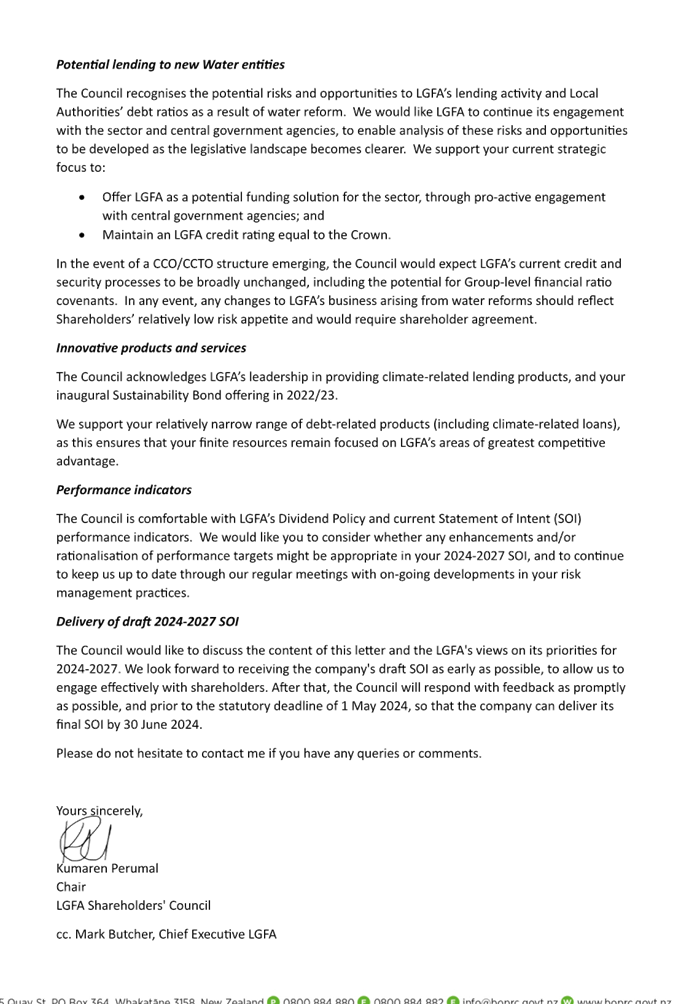
Tasman District Council Agenda – 28 March 2024

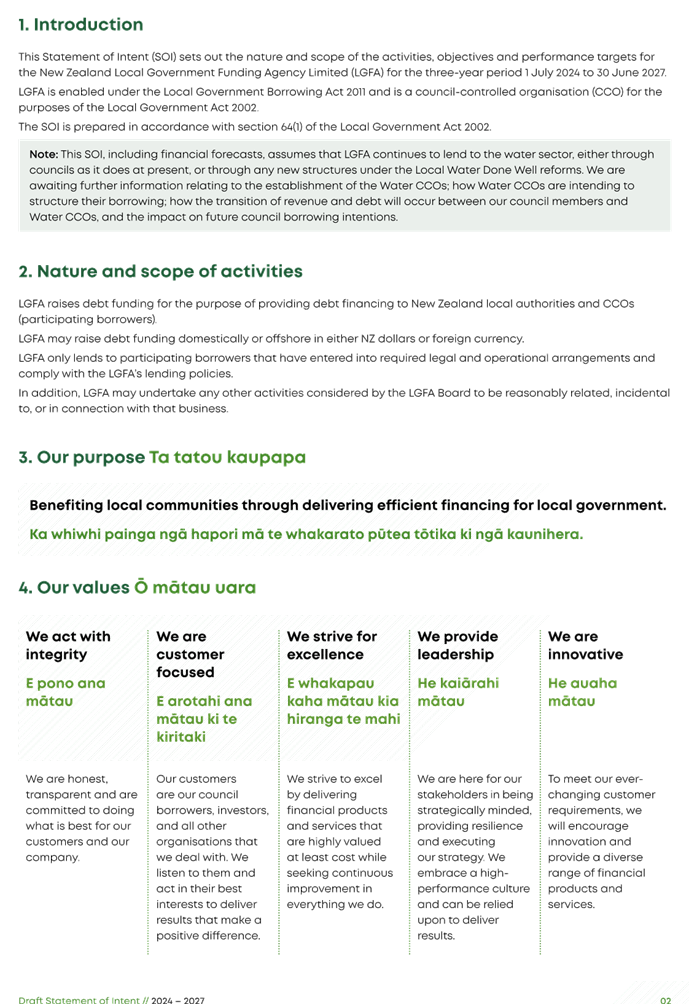

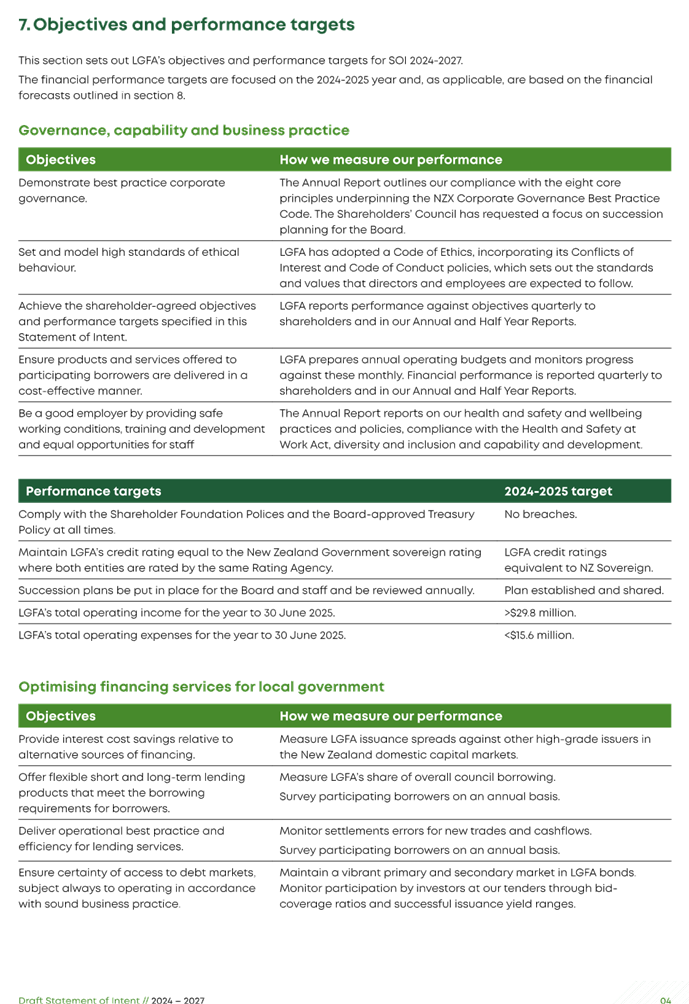
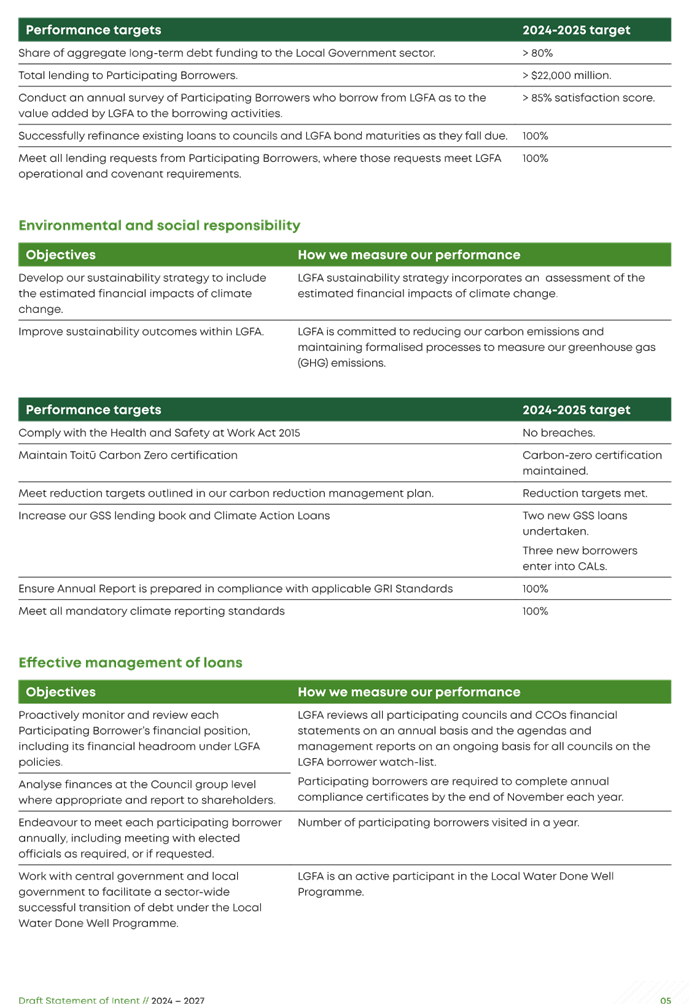
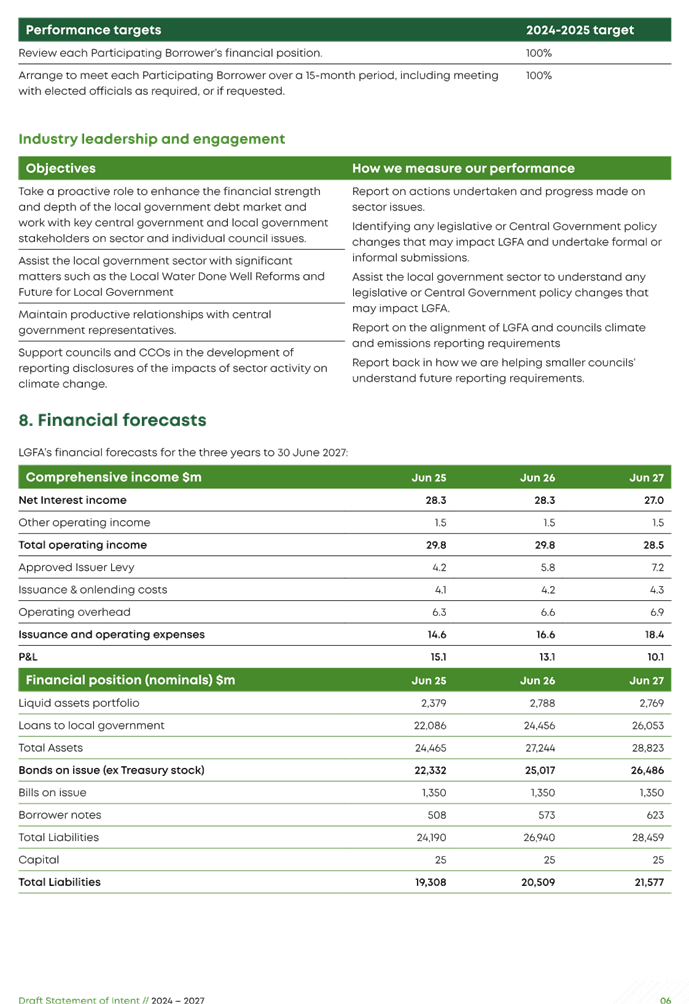
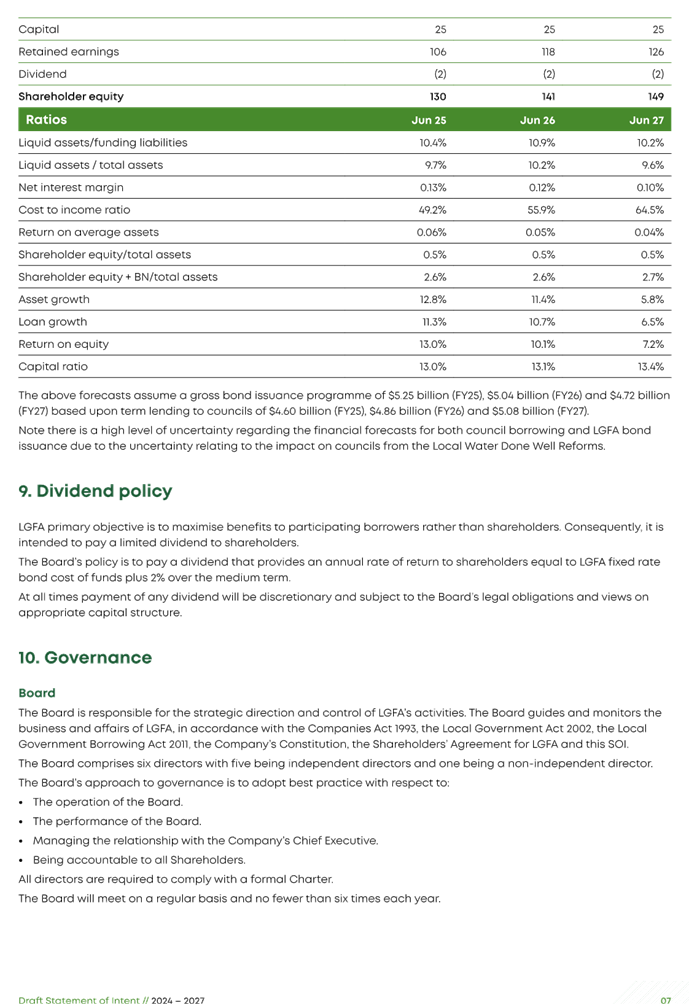
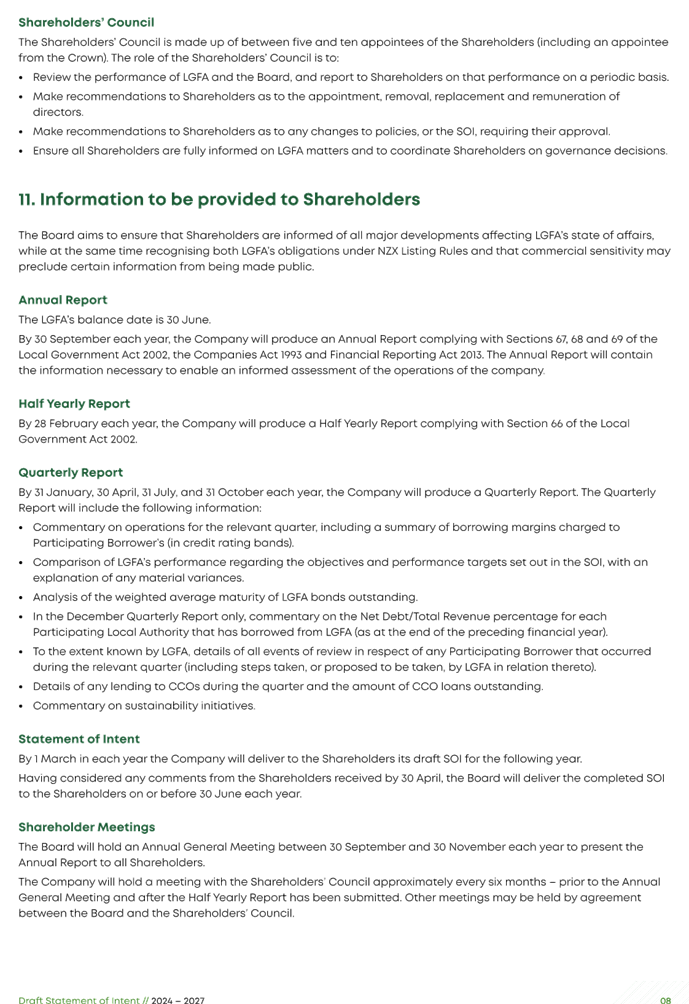
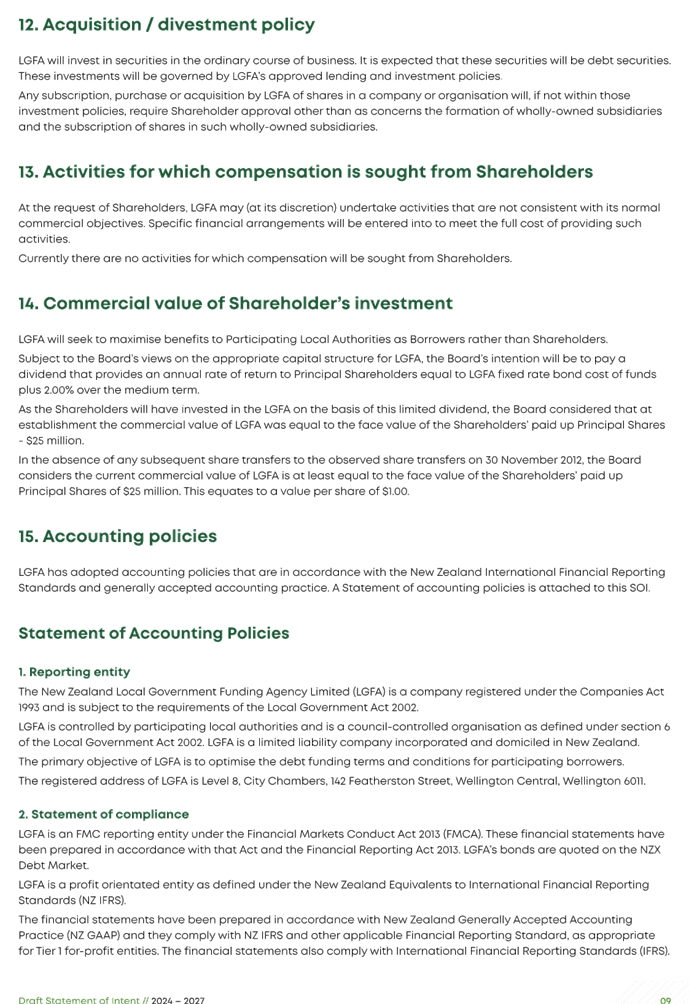
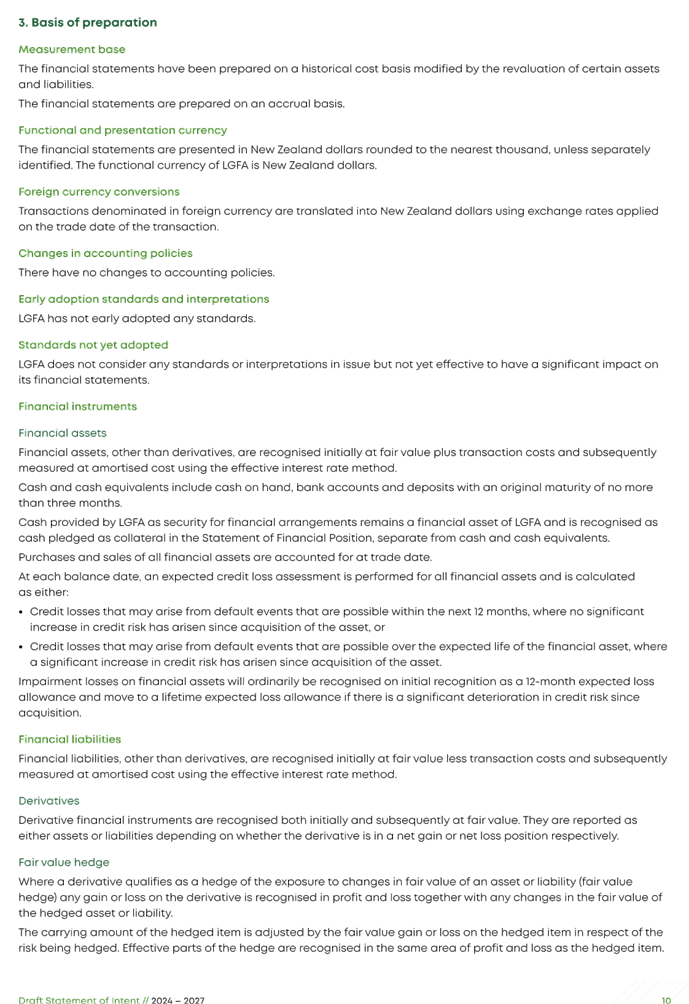
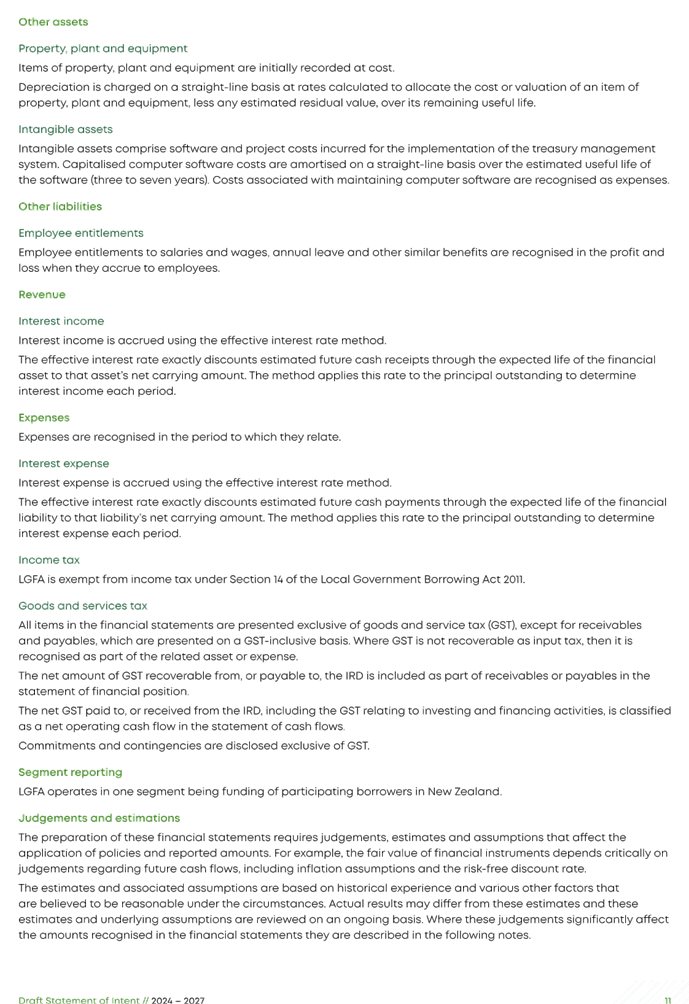
Tasman District Council Agenda – 28 March 2024

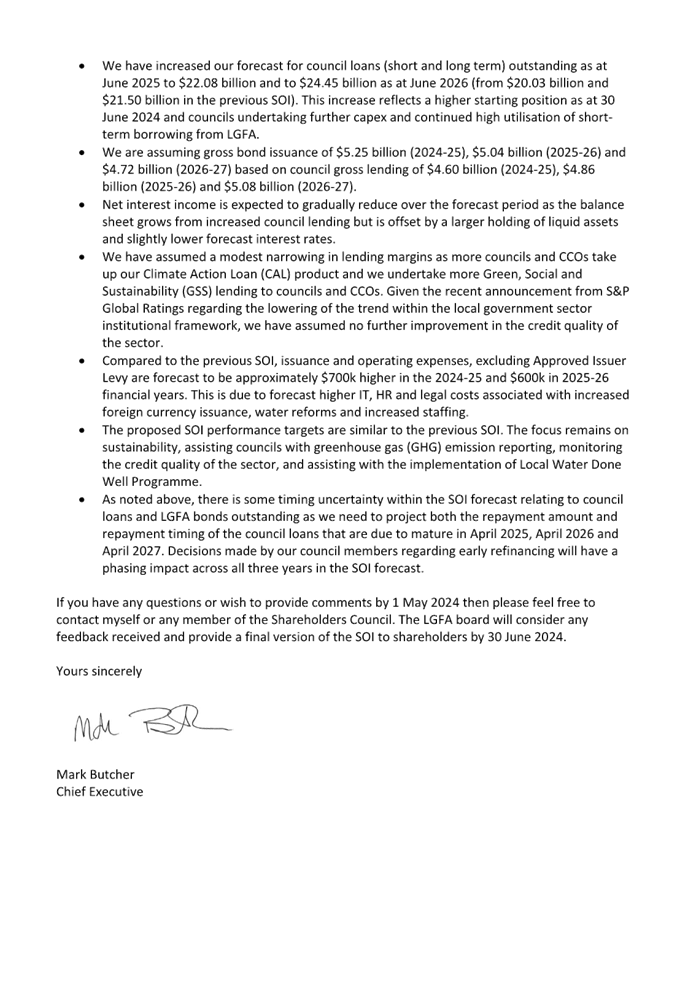
Tasman District Council Agenda – 28 March 2024
7.12 Local Government Funding Agency - Half Year Report 31 December 2023
Information Only - No Decision
Required
|
Report
To:
|
Tasman
District Council
|
|
Meeting
Date:
|
28
March 2024
|
|
Report
Author:
|
Mike
Drummond, Group Manager - Finance
|
|
Report
Authorisers:
|
Leonie
Rae, Acting Chief Executive Officer
|
|
Report
Number:
|
RCN24-03-16
|
1. Summary
/ Te Tuhinga Whakarāpoto
1.1 The
New Zealand Local Government Funding Agency (LGFA)
half year report to Shareholders was delivered on 28 February 2024. The half
year report is attached as Attachment 1.
1.2 The
report was accompanied by a covering letter from Mark Butcher, Chief Executive
LGFA and is attached as Attachment 2.
1.3 The
report has been provided to allow the Council to consider the Company’s
performance.
1.4 Oversight
of the Company and advice to Shareholders is carried out by the LGFA
Shareholders Council. Tasman District Council currently has a seat on the
Shareholders Council and is represented by the Group Manager – Finance.
1.5 The
LGFA continues to operate successfully, and staff have no further matters in
relation to the report that have not been included in the Chief
Executive’s covering letter to bring to the Council’s
attention.
2. Recommendation/s
/ Ngā Tūtohunga
That the Tasman District Council
1. receives the Local Government Funding Agency - Half Year Report 31
December 2023 report, RCN24-03-16; and
2. receives the
New Zealand Local Government Funding Agency covering letter dated 28 February
2024 referencing the Half Year Report (Attachment 2 to the agenda report); and
3. notes
a link to the New Zealand Local Government Funding Agency Half Year Report will
be published on the Council’s website within seven days of this meeting.
3.1 To formally
receive the LGFA half year report for the period ended 31 December 2023.
4. Background and Discussion
4.1 The
Company is required under the terms of its Statement of Intent to provide a
half year report to shareholders. These reports are also made available to the
public via both the LGFA website and the Council website.
4.2 Mr
Mark Butcher, Chief Executive LGFA provided commentary to shareholders which
included:
Increased lending to council and CCO
borrowers
4.3 At
31 December 2023, LGFA had a market value of loans outstanding of $18.8 billion
which followed record lending of $2.63 billion over the six-month period. It
added two new CCOs as members over the six months, bringing the number of
members to 72 councils and five CCOs.
A focus on sustainability
4.4 LGFA
launched its Climate Action Loan (CAL) product for council and CCO members in
December 2022 to incentivise borrowers through a lower loan margin if they have
an approved greenhouse gas (GHG) emission reduction plan in place and are
meeting their reduction targets. At December, CALs total $1.2 billion across
four councils.
4.5 Their
Green, Social and Sustainable (GSS) loans provide a discounted borrowing margin
to councils and CCOs for eligible projects. Over the six-month period they
approved a further project as eligible for GSS lending, bringing the number of
eligible projects to six across six councils.
4.6 LGFA
also published its first Annual Impact Review report for their NZX listed
Sustainable Financing Bond. They are having ongoing dialogue with councils
relating to GHG emission reporting and reduction and are currently preparing
for its first report under Climate Related Disclosure requirements for the 2024
Annual Report.
A financial position tracking to
forecast
4.7 Net
Operating Profit for the six-month period was $5.2 million, which is slightly
below their SOI forecast due to higher costs from increased issuance, and the
establishment and issuance under foreign currency programmes. However, LGFA
expects to meet the full year SOI forecast by June 2024. LGFA has assets of
$21.77 billion and Shareholder Equity of $109.4 million as at 31 December 2023.
Working with its stakeholders
4.8 LGFA
has been assisting Central and Local Government with the implementation of the
water reform programme and with councils and CCO members on promoting
sustainability.
4.9 A
further highlight was LGFA being voted by market participants for an
unprecedented five awards at the KangaNews Awards including New Zealand Debt
Issuer of the Year award for the second consecutive year.
4.10 Their
focus remains on adding value to the local government sector through:
· Providing cheaper loans.
· Enabling easier access to markets.
· Providing reliable financing.
· Underpinning confidence.
· Encouraging sustainability.
· Enhancing capital markets.
· Being a centre of expertise.
5.1 The company
continues to operate successfully with a range of new products being offered to
councils. The company has provided a comprehensive report as required under its
Statement of Intent.
6.1 The Council will
provide a link to the report on our website within seven days of this meeting.
6.2 The Group
Manager – Finance will provide any specific feedback to the company
through the next LGFA Shareholders Council meeting.
|
1.⇩
|
Local
Government Funding Agency - Half Year Report ended 31 December 2023
|
287
|
|
2.⇩
|
Local
Government Funding Agency Covering Letter to 31 December 2023
|
305
|
Tasman District
Council
Agenda – 28 March 2024
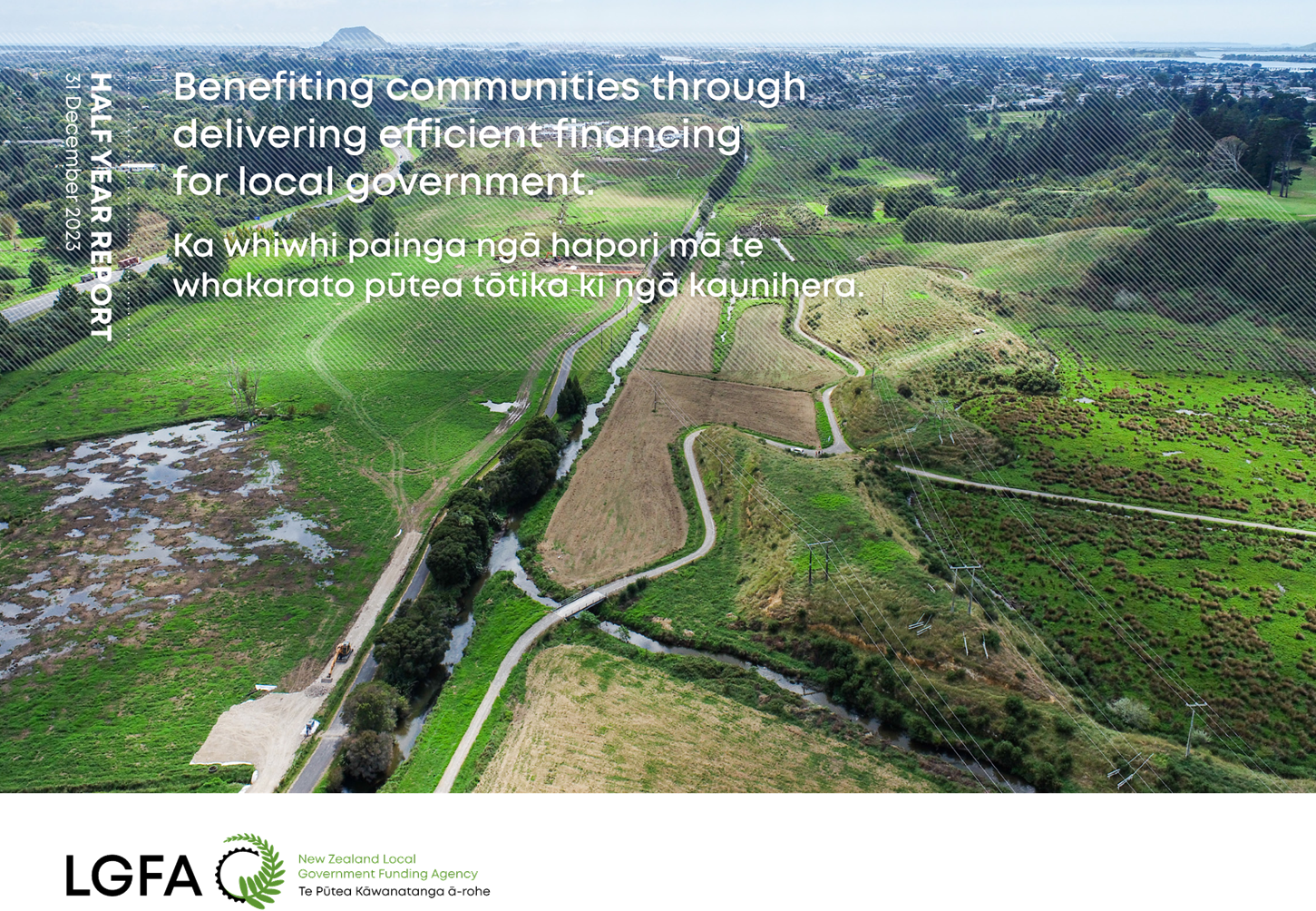


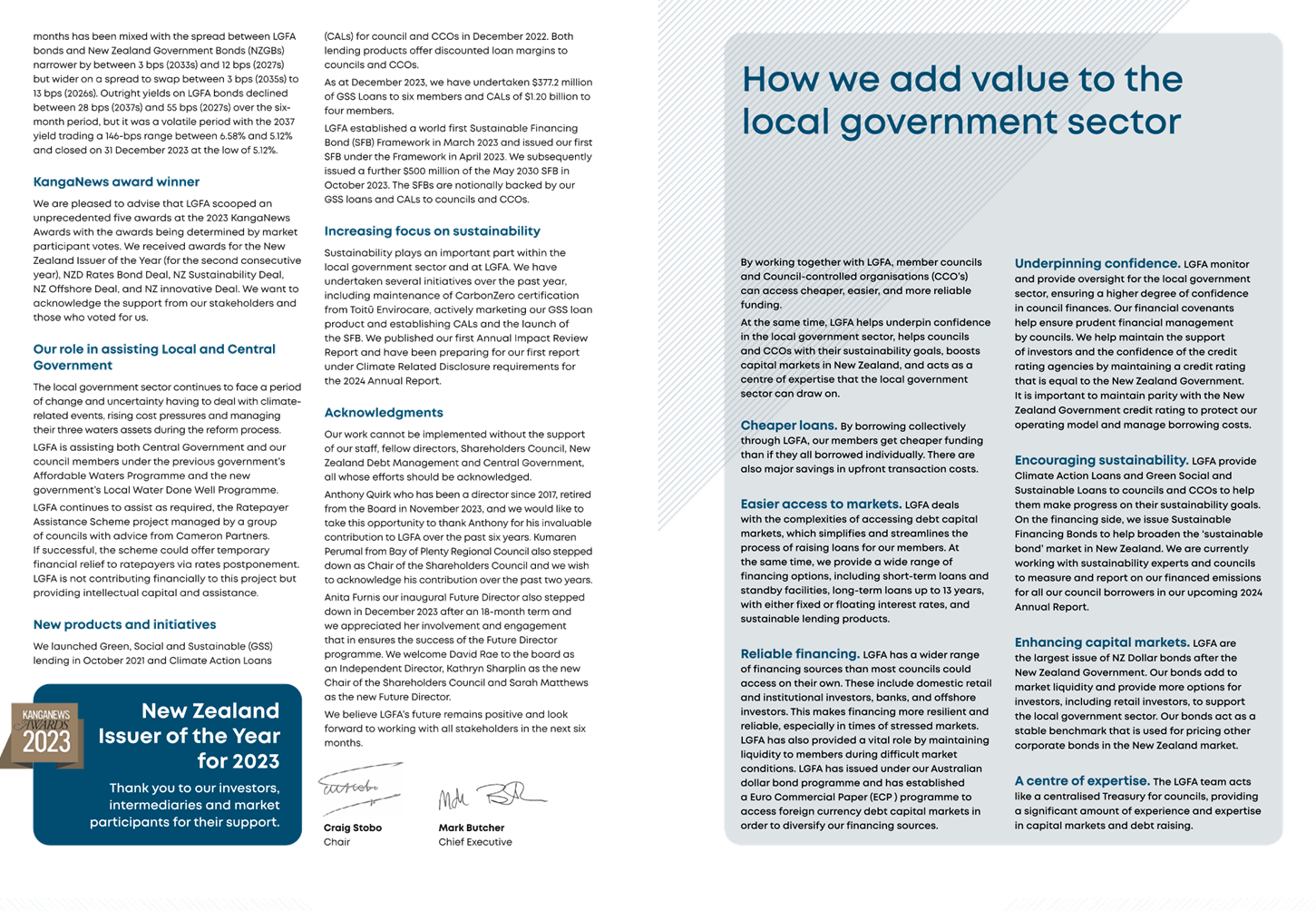

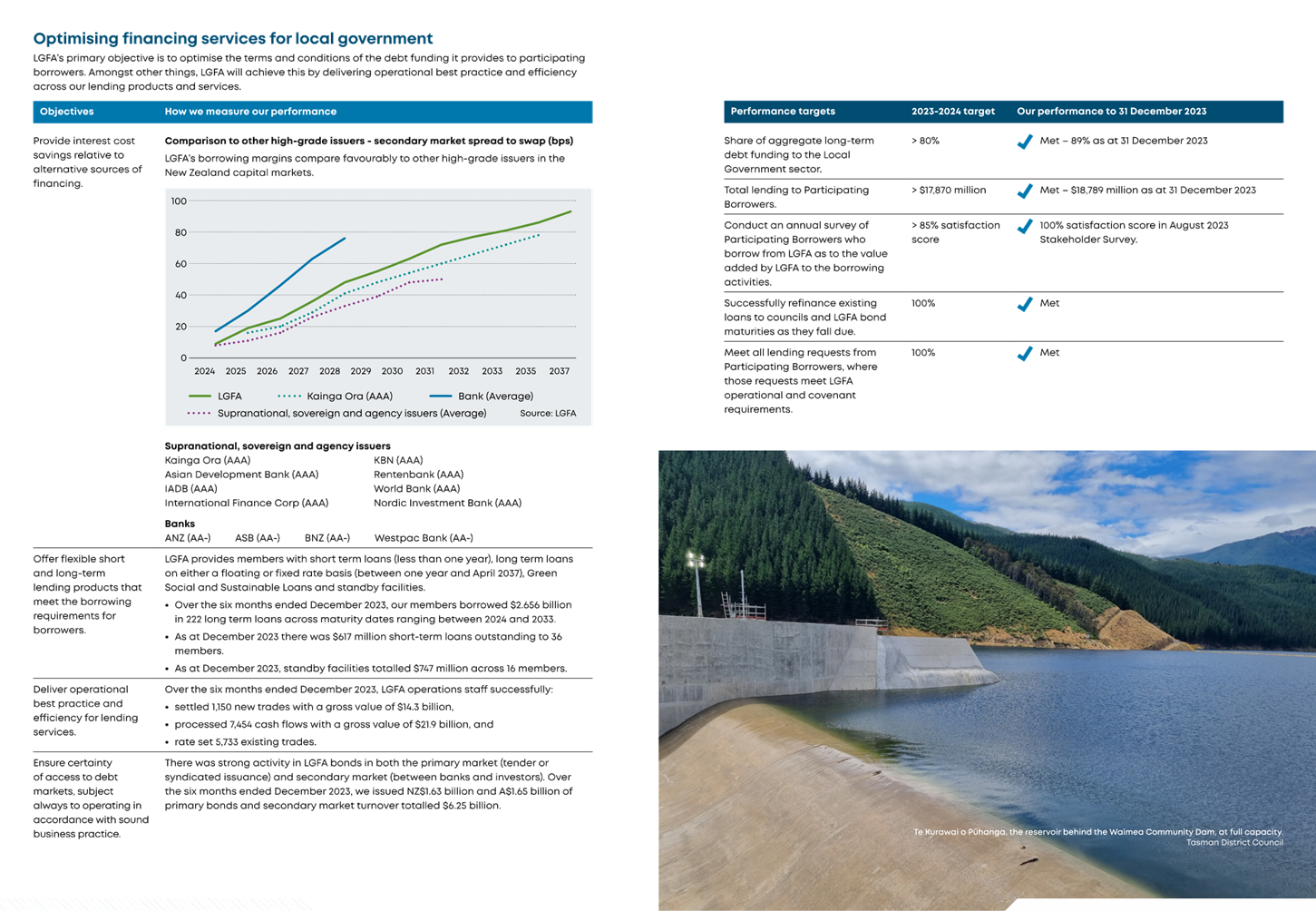
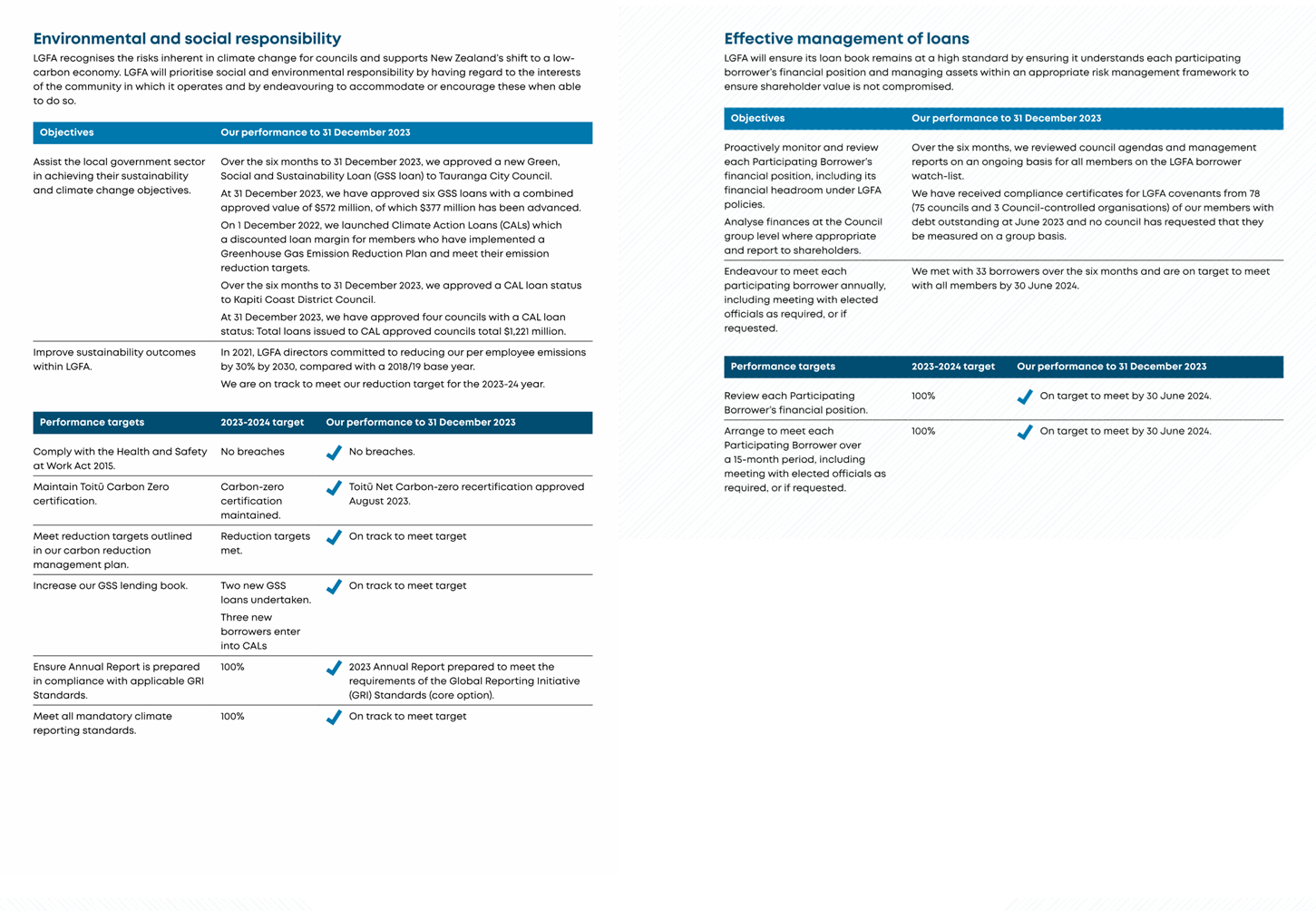
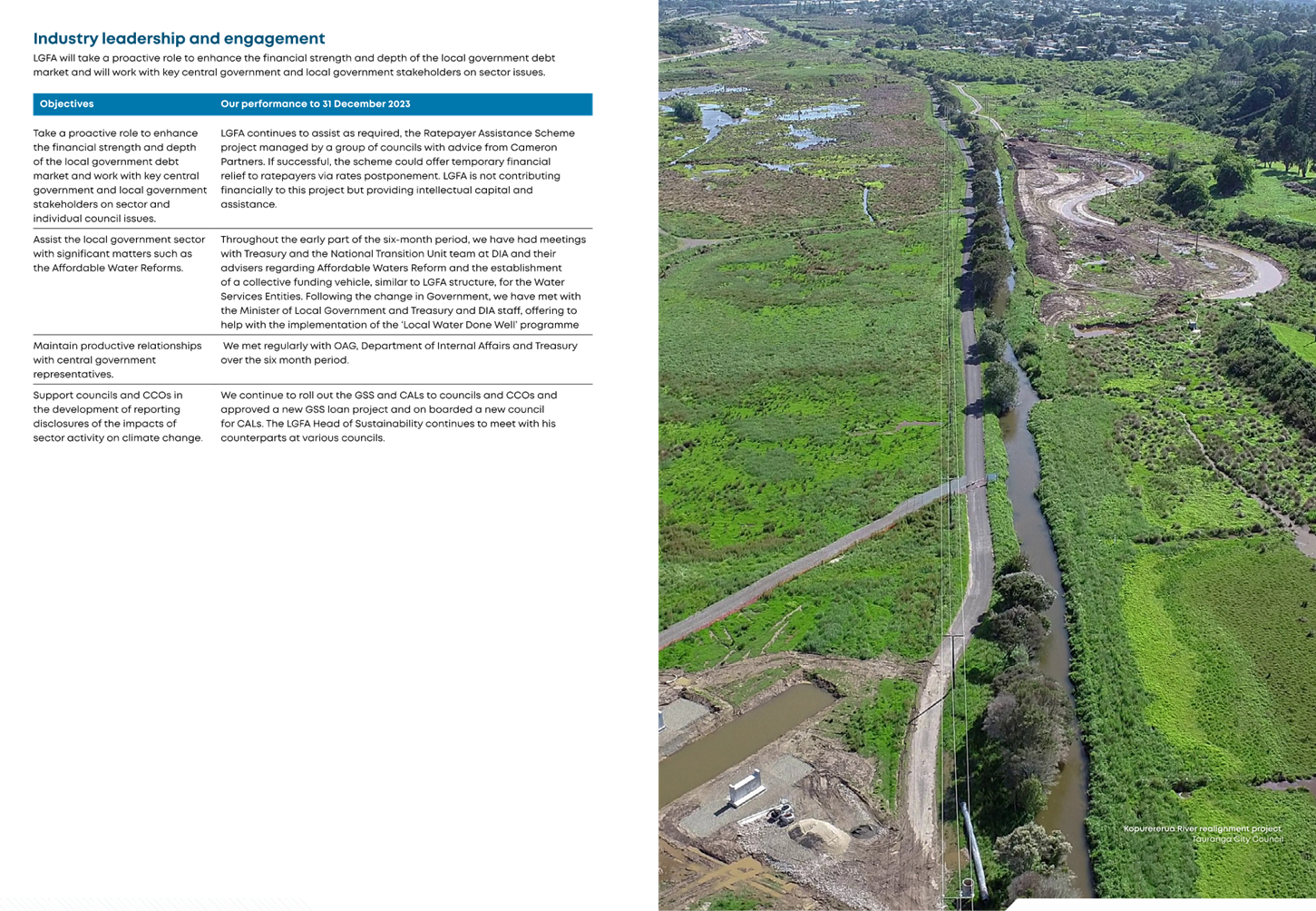
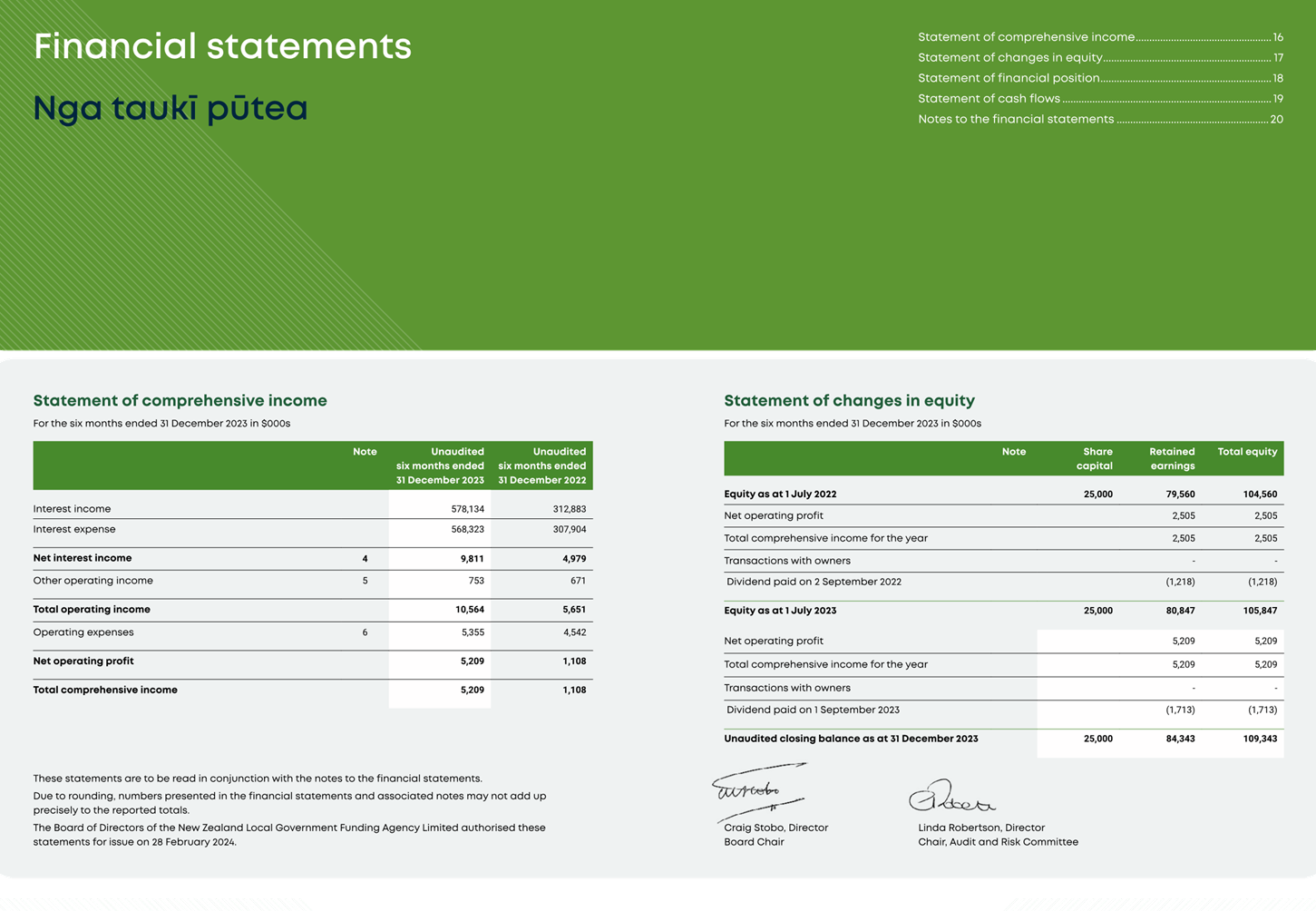

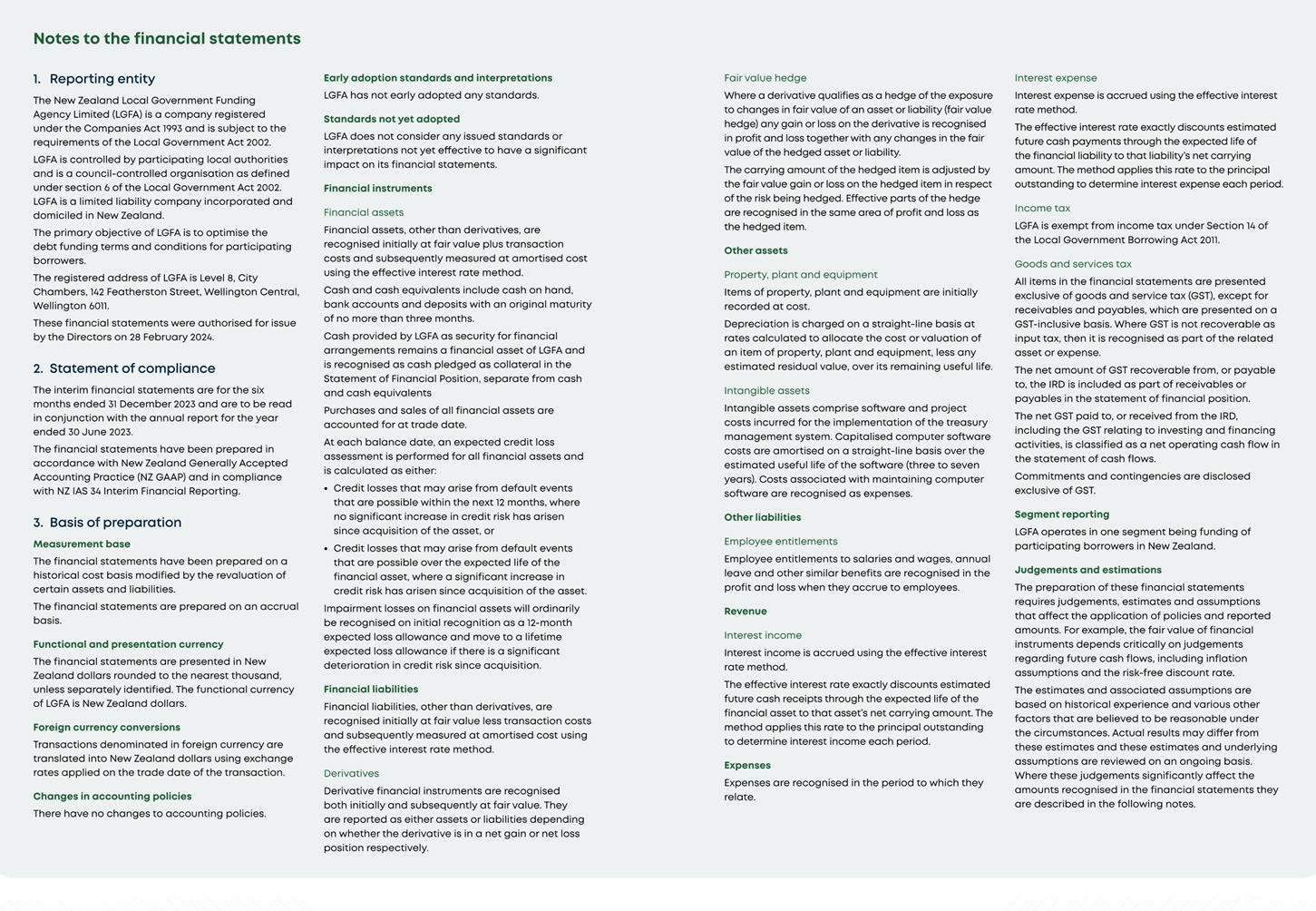
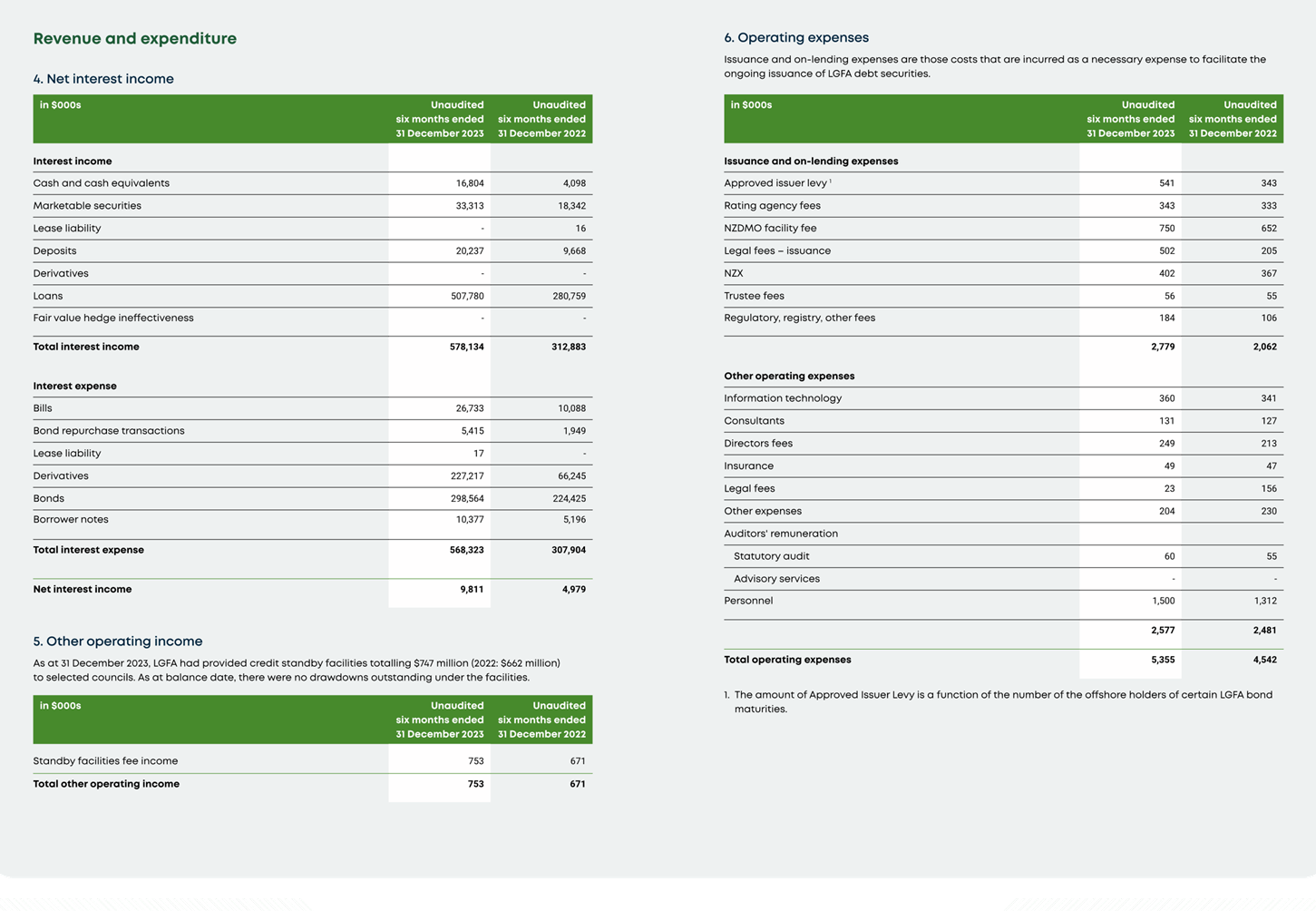
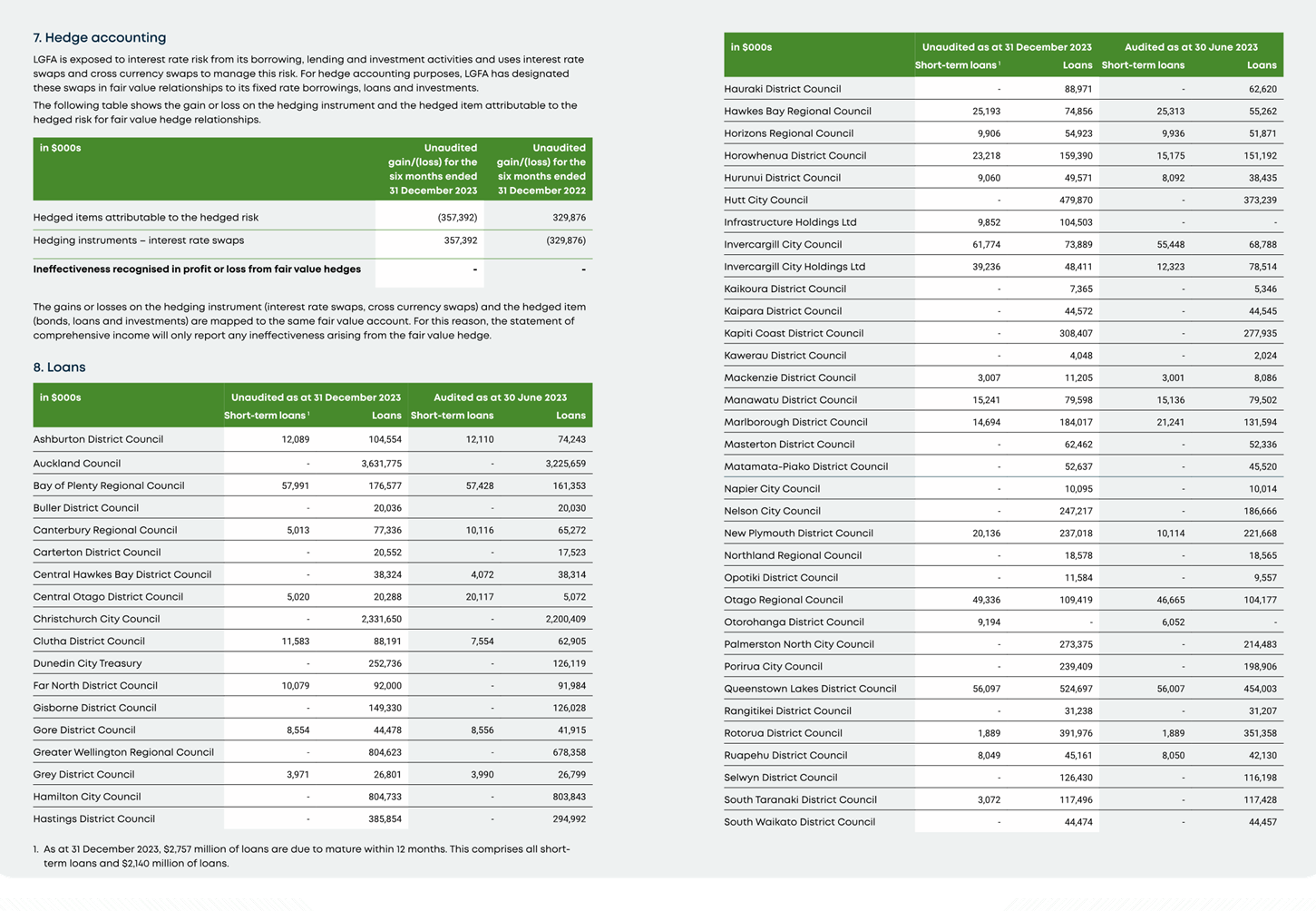
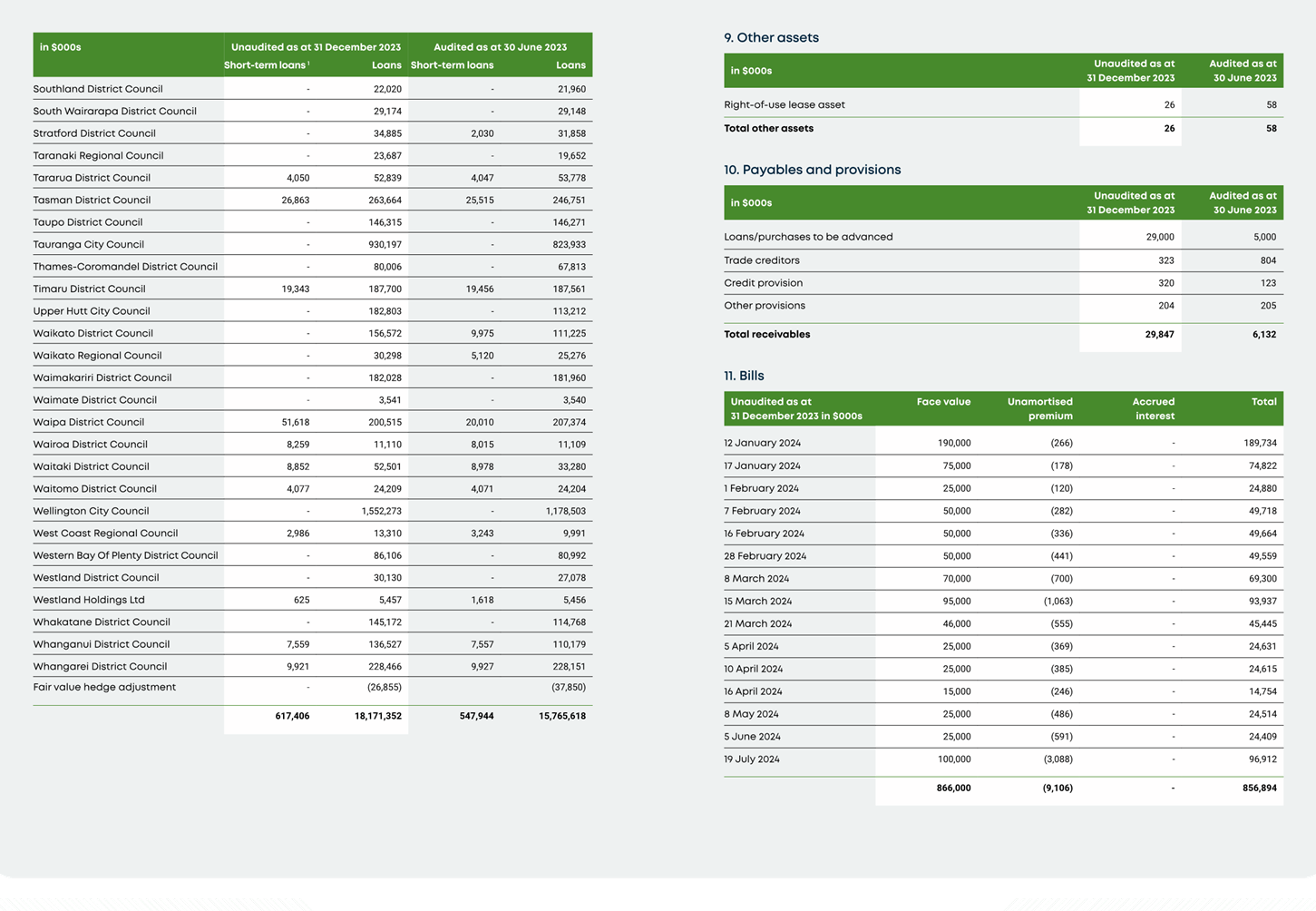


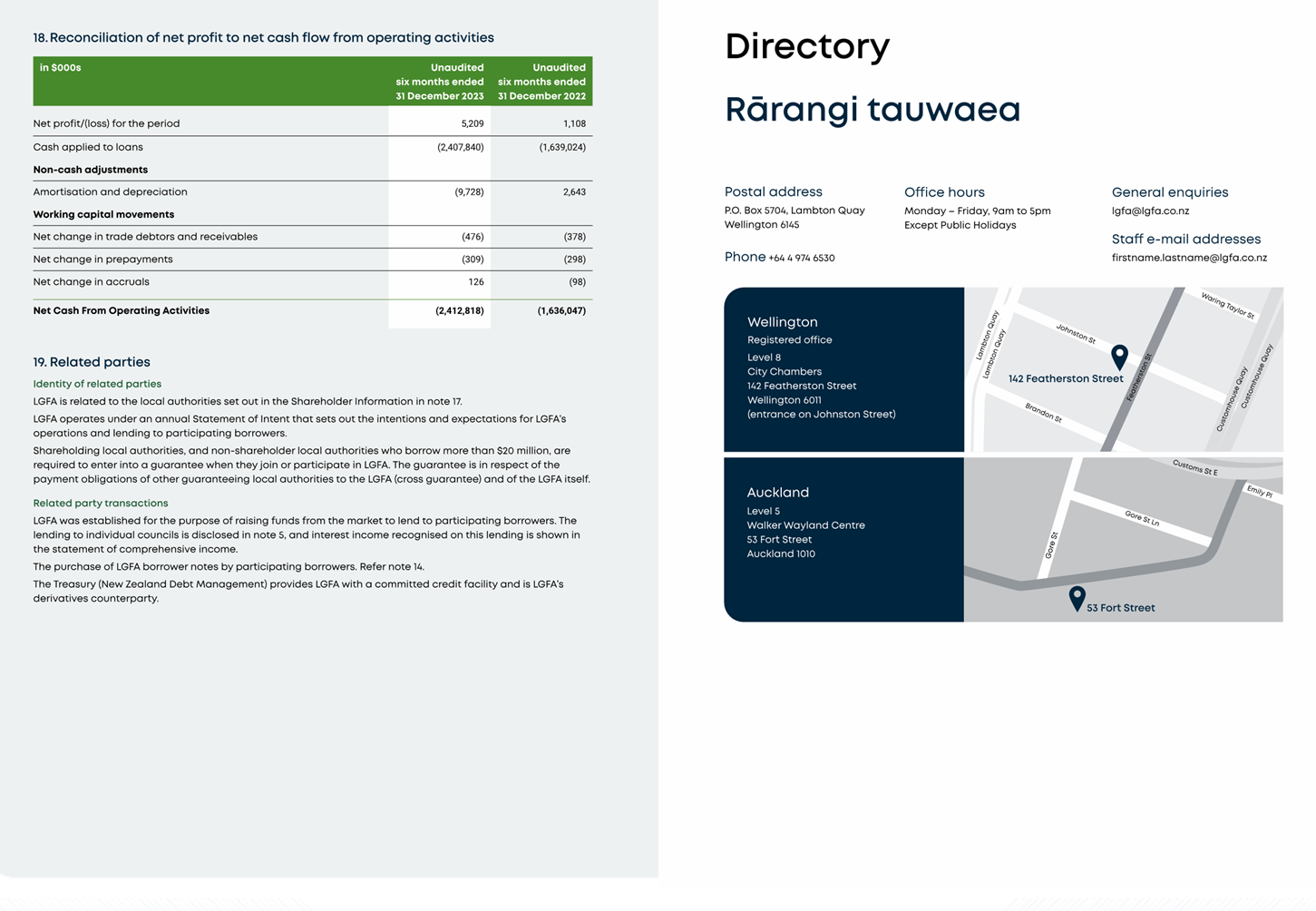

Tasman District Council Agenda – 28 March 2024

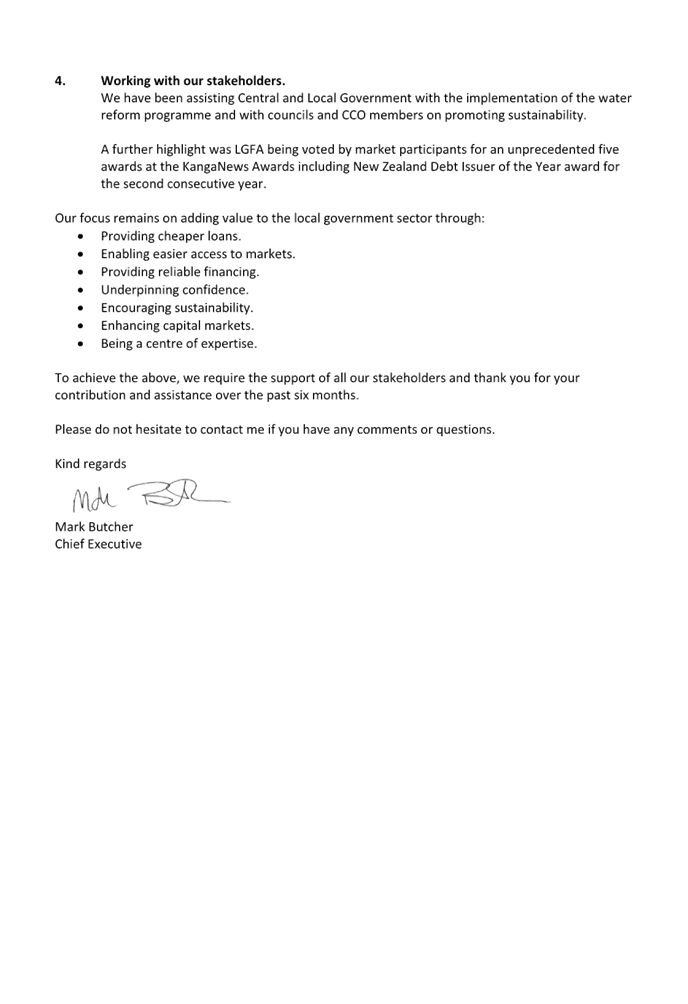
Tasman District Council Agenda – 28 March 2024
7.13 Machinery Resolutions Report
|
Report
To:
|
Tasman
District Council
|
|
Meeting
Date:
|
28
March 2024
|
|
Report
Author:
|
Alexis
Brough, Executive Support Officer, Chief Executive's Office
|
|
Report
Authorisers:
|
|
|
Report
Number:
|
RCN24-03-17
|
1. Summary
/ Te Tuhinga Whakarāpoto
1.1 The
execution of the following documents under Council Seal requires confirmation
by the Council.
2. Recommendation/s
/ Ngā Tūtohunga
That the Tasman District Council
1. receives the Machinery Resolutions report, RCN24-03-17 and that the execution of the
following documents under the Seal of Council be confirmed:
Deed of Novation
(Transfer of Lease terms and conditions) – Council Leases a radio
transmitter site at Sandmann Reserve off Lower Queen Street, Richmond to Sports
Entertainment Network NZ Limited (SENZ). SENZ are in the process of selling
their digital and audio business to TAB NZ who in turn will then novate
(transfer) some of their business interests to a third party Entain NZ Limited
(Entain).
SENZ have
provided an agreement that would allow the lease to pass on to first the TAB NZ
and then on to the final lease holder Entain. TAB NZ and Entain have both
agreed to take over the lease terms and conditions including the ongoing lease
payments to the Council.
Mohua Social
Services – Mohua Social Services approached the Council to formalise
their occupation of part of the Community Centre in Tākaka with a lease,
in order to assist in their applications for grants to continue their community
work.
Deed of
Assignment from Geoffrey Butterworth to Trewavas Developments Limited –
Council and Geoffrey Butterworth are parties to an Agreement dated 23 September
2021 under which Council and Mr Butterworth agreed to relocate a drainage ditch
situated on Mr Butterworth’s land at 44 Trewavas Street Motueka to
Council’s land at 27 Memorial Drive Motueka.
Deed of Renewal
between Fawdan Subdivision Limited (501014) and Nelson City Council and Tasman
District Council for the Emergency Operations Centre lease – Nelson City
Council and Tasman District Council are the joint tenants on the ground floor
of this building owned by Fawdan Industries at 28 Oxford Street, Richmond. The
Lease is for the Emergency Operations Centre, renewed for another 10 year term
from December 2023 to 2033 for a rental market fee of $70,700 + Gst per annum.
Tasman District
Council
Agenda – 28 March 2024
7.14 Chief Executive's Report
Information Only - No Decision
Required
|
Report
To:
|
Tasman
District Council
|
|
Meeting
Date:
|
28
March 2024
|
|
Report
Author:
|
Leonie
Rae, Chief Executive Officer
|
|
Report
Authorisers:
|
Leonie
Rae, Chief Executive Officer
|
|
Report
Number:
|
RCN24-03-18
|
1. Summary
/ Te Tuhinga Whakarāpoto
1.1 The purpose of
this report is to provide an update on some key activity since the Chief
Executive’s last report on 15 February 2024.
2. Recommendation/s
/ Ngā Tūtohunga
That the Tasman District Council receives the Chief Executive's
Report, RCN24-03-18.
3. Chief
Executive Update
3.1 Since the last report, I was welcomed as the new Chief Executive
with a Mihi Whakatau by Mayor Tim King, Councillors, Council partners, my
family and friends.
3.2 It has been a busy few weeks negotiating the challenges and
opportunities for the Council.
I am aware of the significant challenges that lie ahead, both internally and
externally, as we navigate the changing and complex landscape of local
government.
3.3 One
of the external challenges that I face as the new Chief Executive is to manage
the increasing and competing demands and expectations of our community and
stakeholders, in the context of limited and constrained resources. The Council
has a responsibility and a mandate to provide a range of services and
facilities to our community, and to ensure that they are of high quality,
accessible, and affordable. However, I also realise that we must balance this
with the fiscal and environmental sustainability of our organisation, and the
need to prioritise and allocate our resources wisely and efficiently. The Long
Term Plan (LTP) that will be going out for consultation on 28 March 2024
highlights what these challenges are and what options the community can consider.
3.4 I continue to be
the sponsor for the Digital Innovation Programme. We are in the final stages of
procurement for our partner to assist us with implementing a Customer
Relationship Management System (CRM) on the Microsoft Dynamics Platform.
3.5 The
CRM project will enable the Council to manage its interactions with customers
across multiple channels and touchpoints, such as phone, email, web, social
media, and face-to-face. The CRM system will provide a single source of truth
for customer data, requests, feedback,
and history. It will also automate workflows, streamline processes, and
generate insights to help the Council improve its performance and
responsiveness. The CRM project will benefit both the Council staff and the
customers, as it will make it easier to communicate, collaborate, and resolve
issues.
3.6 It has been a month of meeting
new people and connecting with stakeholders. I attended the Local Government
Regional Sector Meeting in Wellington in early March. We heard from Ministers
Todd McLay, Penny Simonds, and Chris Bishop. There is a bit of “hurry up
and wait” as the new government works through new legislation and policy.
3.7 I attended the Coordinated
Executive Group (CEG) at the Nelson Tasman Emergency Operations Centre. The CEG
is made up of agencies that have a leading role in delivering civil defence
emergency management in our region. This reflects the fact that, as required by
legislation, civil defence is a multi-agency responsibility. The CEG reports to
the Mayors and Deputy Mayors of Nelson City Council and Tasman District Council
(called the "Nelson Tasman Civil Defence Emergency Management
Group").
3.8 The group is made up of
representatives from, Nelson City Council iwi, Police, St John, Ministry of
Social Development, Public Health, Te Whatu Ora, Fire and Emergency, and the
National Emergency Management Agency.
4. Operational Highlights
Waimea Community Dam
4.1 The Waimea Community Dam project is
nearing completion and according to Waimea Water Limited it is intended to be
fully commissioned in late March 2024.
4.2 The storage behind the dam has been
filled in managed stages whilst monitoring the dam’s performance. It
first spilled on Sunday 21 January 2024.
4.3 In early February Waimea Water Limited
commenced the final stages of installing the mechanical and electrical
components in the diversion tunnel. The smaller outlet pipe, colloquially
called the ‘environmental’ pipe was opened and started discharging
up to 1.4m3/sec on Saturday 2 March 2024.
4.4 The ‘environmental’ pipe has
to be closed during working hours for a few days to enable further work to be
done on the other pipework within the diversion tunnel. Waimea Water Limited
staff installed temporary pumps in the spillway to pump water over the spillway
whilst the environmental pipe was closed. This has helped maintain minimum
flows in the river.
4.5 Even though the dam has not been
formally commissioned, the release of water has maintained an increased flow in
the Lee and Waimea Rivers. If this had not occurred, the Waimea Plains would
have been subjected to much more severe staged restrictions.
4.6 During the week of 11 March 2024,
without the water being released from the dam, the river flows would have been
sufficiently low that the urban supplies would have been in at least Phase D
rationing and probably into Phase E rationing. Phase E is when water is to be
used only for emergencies, human drinking, sanitation, medical purposes, and
stock wellbeing. This would have been the same situation we had in
2019/2020.
4.7 The urban community and the greater
Waimea Plains will be pleased that the dam has been able to release water to
counter the need for severe staged water restrictions.
4.8 Waimea Water Limited has indicated that
the two larger discharge pipes, which were concreted in during late February,
should be functional and able to release more water during the week of 18 March
2024.
5. Legal and Democracy Services
Local Government and Official
Information Meeting Act 1987 (LGOIMA) requests
5.1 The Council
continues to receive a large volume of LGOIMA requests. For context, in 2023
the Council received 510 LGOIMA requests, this is up from 295 in 2022.
5.2 Since the
beginning of 2024 there have been 202 formal LGOIMA requests (as of 12
March 2024). Ninety-three (93) of these requests have come from two
individuals. The Council is responding to these requests appropriately in line
with the Act. This includes bundling requests, seeking to charge for staff
time, and declining because the request is “frivolous or vexatious or
that the information requested is trivial”.
5.3 The Council
considers it has engaged appropriately in relation to the LGOIMA requests and
associated complaints.
Ombudsman investigations
5.4 As of 12 March
2024, the Council is responding to five Ombudsman investigations and two
preliminary inquiries.
5.5 It is noted that
Chief Ombudsman Peter Bushier is required to resign due to a legislative
requirement relating to the maximum age for the Ombudsman.
6. National Policy Statement on Freshwater
Management (NPS-FM)
6.1 As the Council
will be aware, the new Government announced the extension of notification
timelines for the National Policy Statement on Freshwater Management until
2027.
6.2 The Strategy and
Policy Committee debated the matter of the proposed plan change timeframes and
being cognisant of the requirements under the Water Conservation Order,
determined a six-month delay in notification would be appropriate to mid-2025.
6.3 Staff will be
providing further advice to the Council on the impact the Water Conservation
Order requirements will have on this timeframe.
7.1 Marlborough District, Nelson City
and Tasman District Councils, being the three councils who are party to the
Multi Employment Collective Agreement (MECA) with the PSA Union, have been
communicating with the PSA to confirm dates for this year’s mid-term
remuneration negotiations. Last year we negotiated for a two-year
agreement and these negotiations are covered by the variation clause in the
existing MECA, so this round of bargaining is not a full collective bargaining
process. Negotiations are expected to happen across late-April to mid-May.
7.2 The
Council has engaged Sarah Sidey, a local physiotherapist to deliver a series of
informative wellbeing-focused sessions to our staff. The sessions are 30
minutes long and are recorded so that we can make them available to all staff
via our intranet. Sarah delivered a similar series of wellbeing focused
sessions last year and the feedback from our staff was very positive.
7.3 Recruitment
continues to remain steady, and we are currently at various stages of
recruiting for approximately twenty vacancies which are a mix of existing and
new approved positions. Since my last report, another ten appointments have
been made with one of these being an internal promotion which then resulted in
another vacancy needing to be filled.
7.15 Mayor's Activity Update
Information Only - No Decision
Required
|
Report
To:
|
Tasman
District Council
|
|
Meeting
Date:
|
28
March 2024
|
|
Report
Author:
|
Tim
King, Mayor
|
|
Report
Authorisers:
|
|
|
Report
Number:
|
RCN24-03-19
|
1. Summary
/ Te Tuhinga Whakarāpoto
1.1 The ongoing dry weather is extremely
frustrating for everyone in our District. Unfortunately, the outlook for any
rain at all during the next few weeks is not promising.
1.2 While the Tasman Dry Weather Task Force
continues to meet weekly, the Ministry of Primary Industries has also convened
the Top of the South Drought Committee. Former Tasman District Mayor, Richard
Kempthorne is chairing this committee, and the Government has so far allocated
$20,000 to the Rural Support Trust (also chaired by Richard Kempthorne) to help
with assistance for farmers and rural water users. Locally, the Alliance Group
has commenced double shifts to help farmers who are destocking.
1.3 On Friday, 15 March 2024 the Minister of
Agriculture, Todd McClay formally classified drought conditions in Marlborough,
Tasman, and Nelson as a “medium-scale adverse event”. This decision
will unlock further support for farmers and growers, including tax support.
1.4 I am especially pleased that the Waimea
Dam is now providing water to augment the environmental flows in the Waimea
River. It has been great to receive several “well done and
congratulations” messages from residents who recognise the difference the
dam will make to our District.
1.5 Alongside the Richmond Friendly Town
Group, we recently hosted the Mayoral party from our sister city, Fujimi Machi.
their Secretary of Education and several students and their adult caregivers.
The welcoming pōwhiri was held at Te Āwhina marae, a new
experience for our visitors. This year marked the 30th anniversary
of the relationship between our two towns which was marked with the unveiling
of a park bench in Washbourn Gardens next to the cherry tree that had been
planted by a Fujimi Machi visiting group 20 years ago. The students spent
several days at Waimea College joining in normal classes and experiencing life
in a New Zealand educational setting. The group also visited Māpua and
Rabbit Island (via the Māpua ferry service), a local farming operation,
Kaiteriteri, Waimarama Brook Sanctuary and the Abel Tasman National Park.

The Fujimi Machi Mayoral delegation at the welcoming pōwhiri
2.1 I have regretfully accepted the
resignation of Margaret Devlin from the Waimea Water Limited Board. Margaret is
returning to the UK where she has been offered a new role.
2.2 Thank you to
Councillor Maling and Councillor Ellis who have both provided support by
attending a number of events in support of the Mayor’s office recently.
Your help is much appreciated.
2. Recommendation/s
/ Ngā Tūtohunga
That the Tasman District Council receives the Mayor's Activity
Update, RCN23-03-19.
3. Significant
Birthdays, Anniversaries
3.1 For the past year, Tasman District
Council, through my office, has subscribed to the Department of Internal
Affairs “Congratulatory Message Service”. This service advises when
a resident of Tasman District reaches a significant personal milestone, for
example 50th, 60th (and more years) wedding anniversaries
and significant birthdays (usually 100 years). The Executive Assistant and
Advisor to the Mayor sends greeting cards and/or flowers – cards for
wedding anniversaries and flowers for centenarians. This initiative has been
well received by the recipients.
4. Local Government New Zealand – Four
Monthly Update
4.1 The Local Government New Zealand Four
Monthly Update is attached for information (Attachment 1).
5.1 The Kaiteriteri
Recreation Reserve Board met on 13 February 2024.
5.2 The mihi whakatau for our new Chief
Executive Officer, Leonie Rae was held on
19 February 2024.
5.3 The Cawthron Institute Trust Board met
on 19 February 2024.
5.4 On 20 February 2024, I was invited to
speak to the Wellington Regional Police leadership team focusing on my
experience in a governance role.
5.5 The two-monthly catch up with our
Kaumatua Harvey Ruru and Whaea Jane de Feu was held on 22 February 2024.
5.6 It was good to see the large turnout at
Paul Sheldon’s retirement function on 22 February 2024. Paul has worked
for both Nelson City and Tasman District Councils and is well respected in the
community.
5.7 Fifty-three new
residents received their New Zealand citizenship at our first ceremony for the
year on 28 February 2024. It was great to see several people deliver their oath
or affirmation in te reo. The kapa hapa group from Richmond Primary School did a
great job leading everyone through the national anthem.
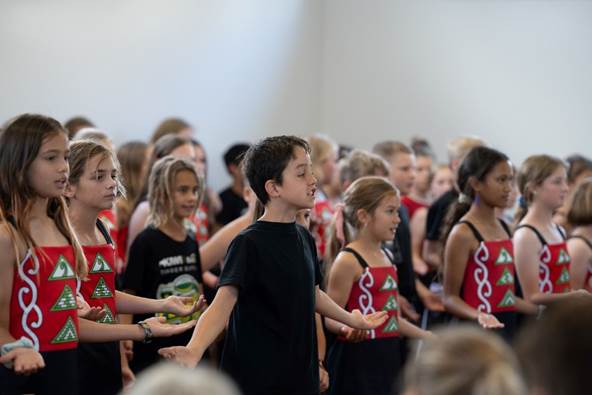
Richmond
Primary School Kapa Hapa Group
5.8 The Local Government Transport Reference
Group met in Wellington on 29 February 2024.
5.9 The Chief
Executive, Leonie Rae, Group Manager – Community Infrastructure, Richard
Kirby and I met with Graham Mitchell from Crown Infrastructure Partners and
Paul Barker from the Department of Internal Affairs on 6-7 March 2024.
Discussions focused on opportunities for the Council with the
Government’s “Local Water Done Well” programme and
infrastructure investment. Graham and Paul also visited the Waimea Dam site and
were very impressed.
5.10 The Local Government New
Zealand Regional Sector Group meeting was held in Wellington on 7-8 March 2024.
We heard from Todd McClay (Agriculture), Penny Simmonds (Environment), and
Chris Bishop (RM Reform and Infrastructure).
|
1.⇩
|
LGNZ Four
Monthly Update
|
316
|
Tasman District
Council
Agenda – 28 March 2024
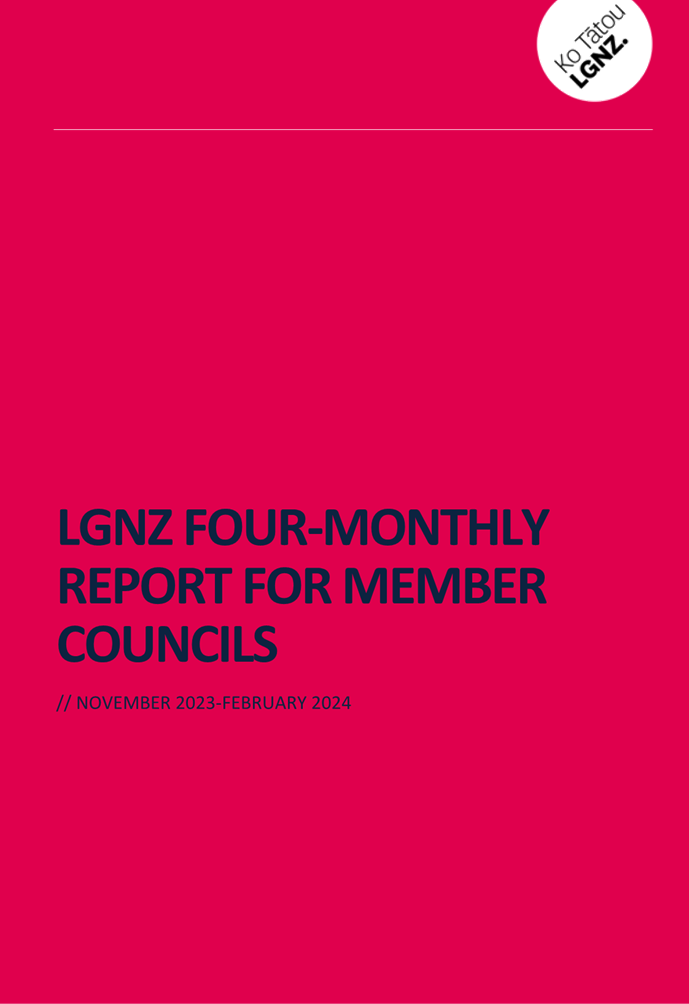
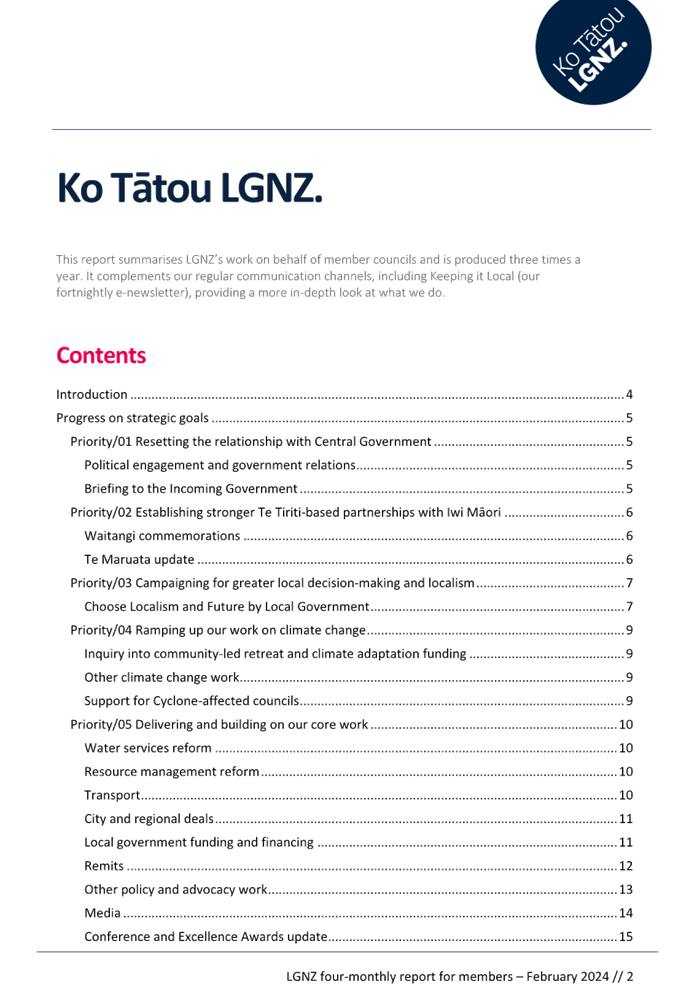
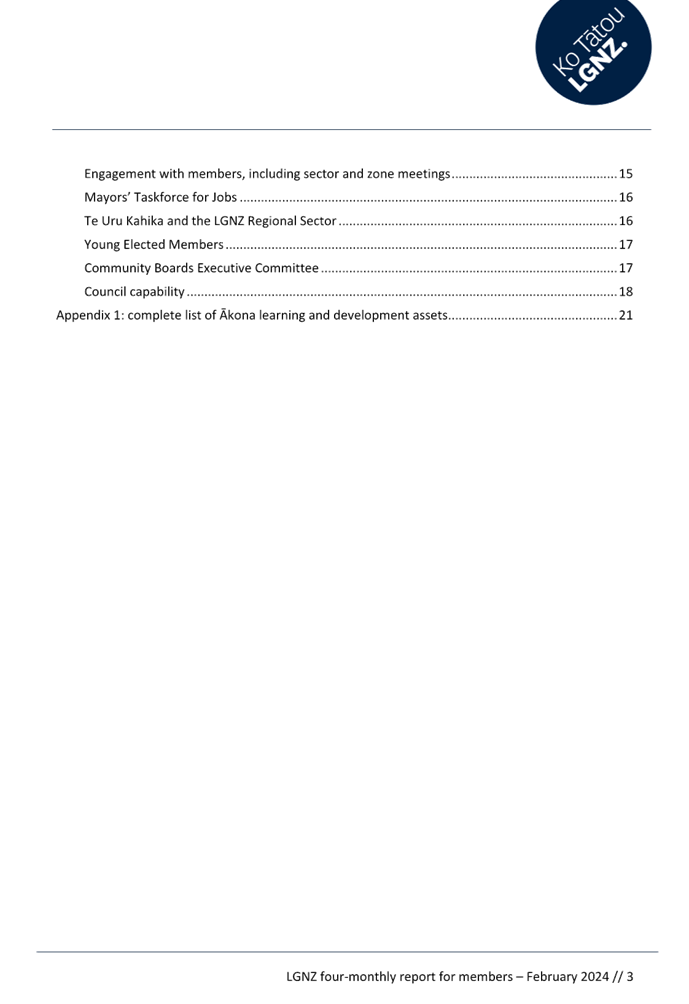
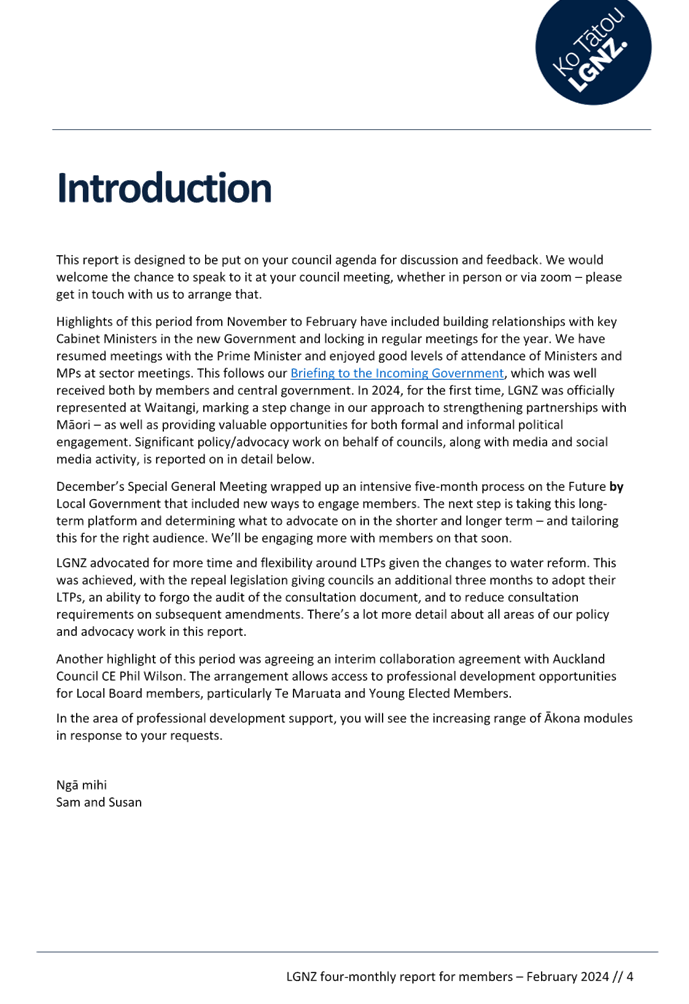





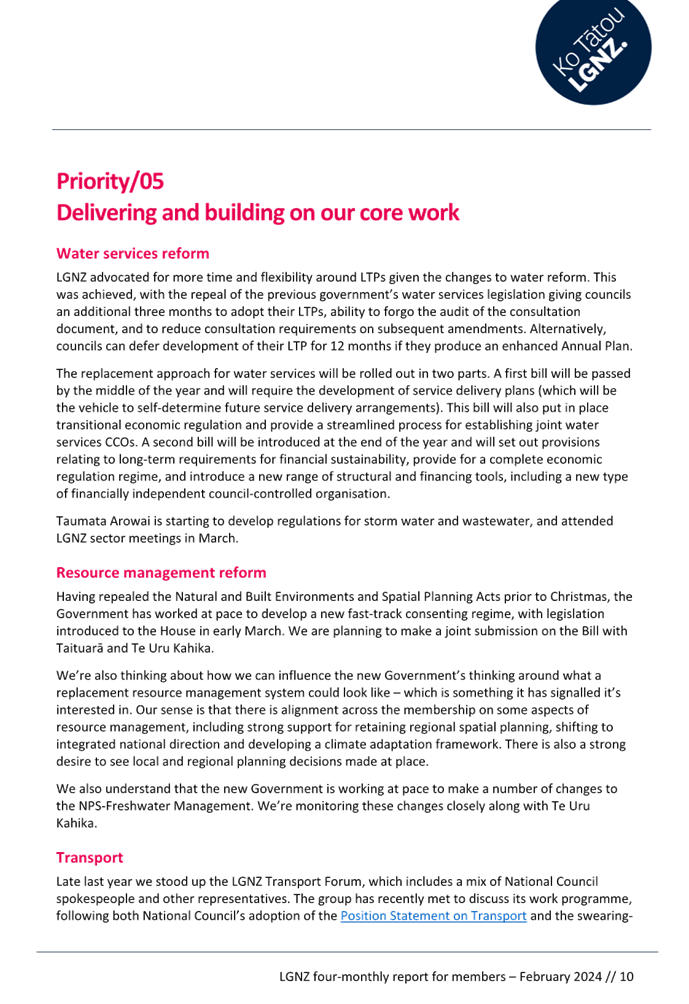
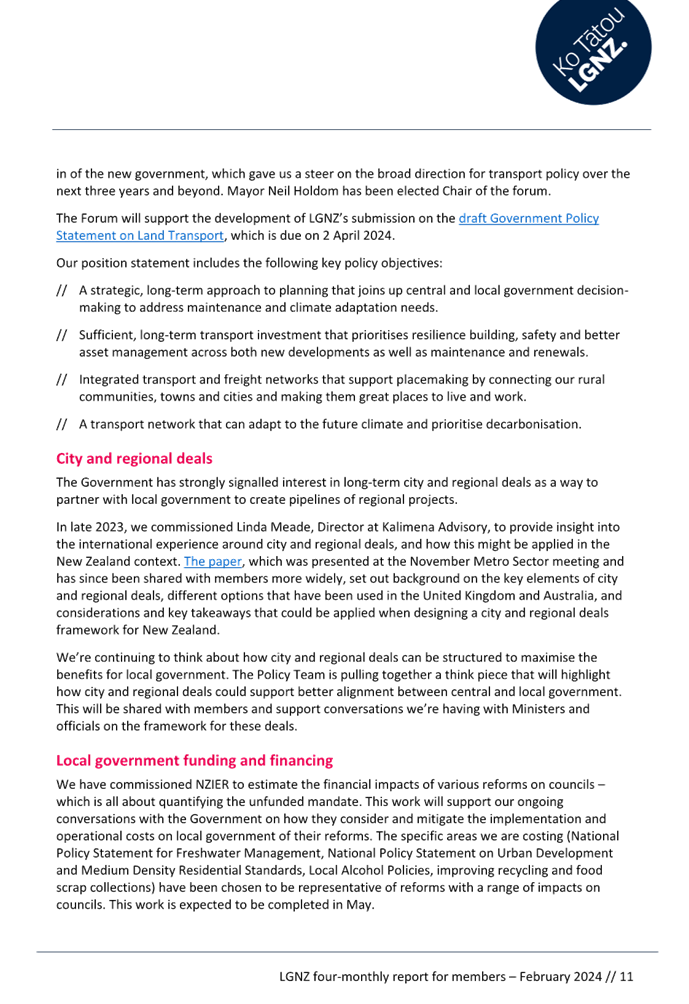



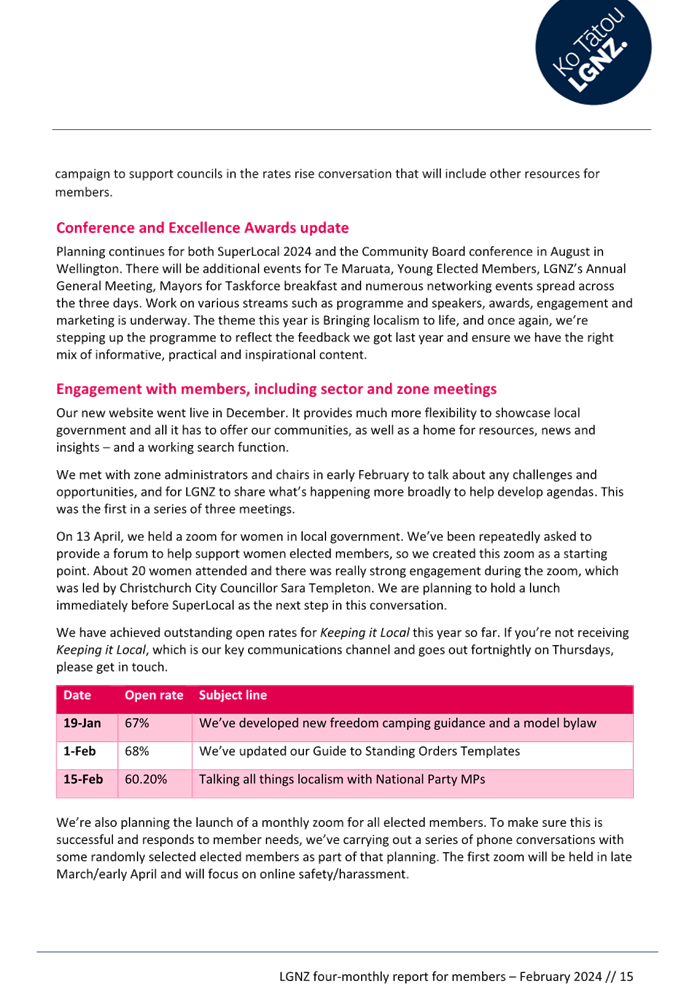

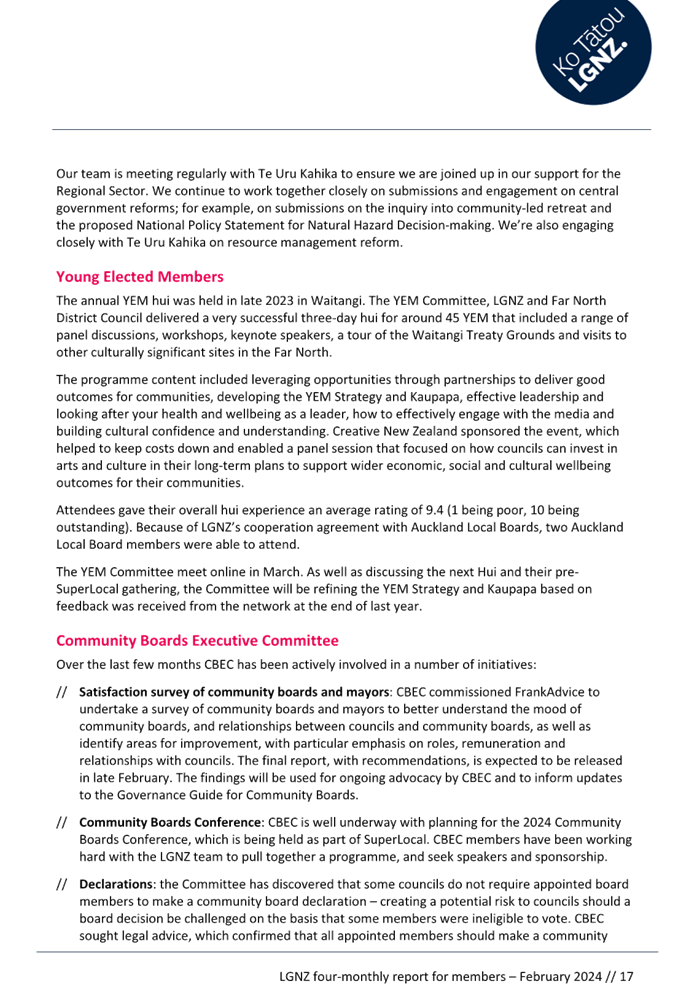
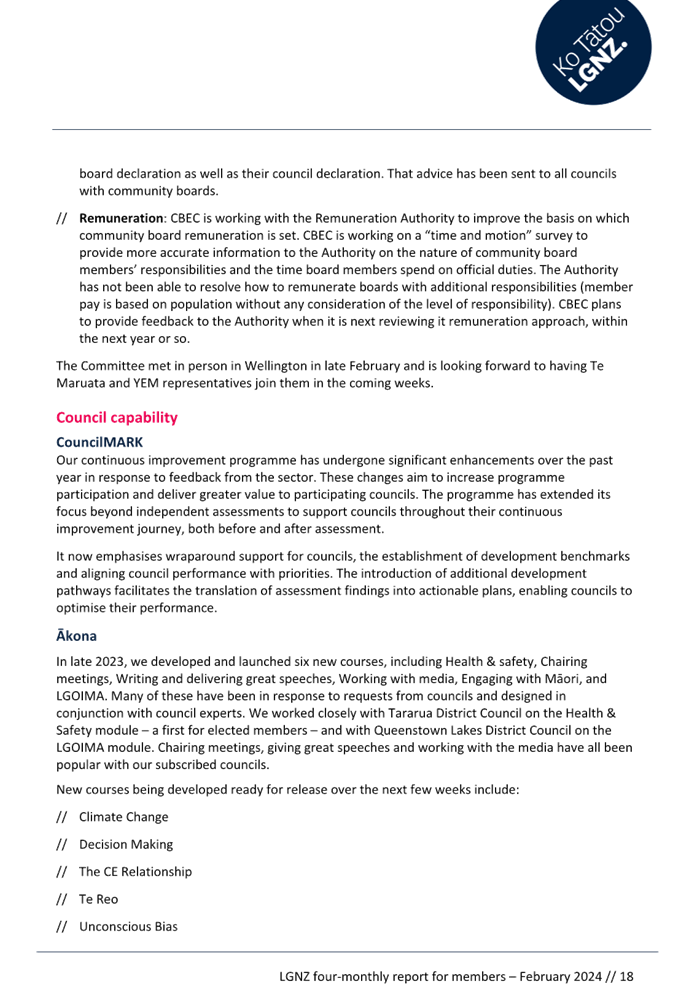
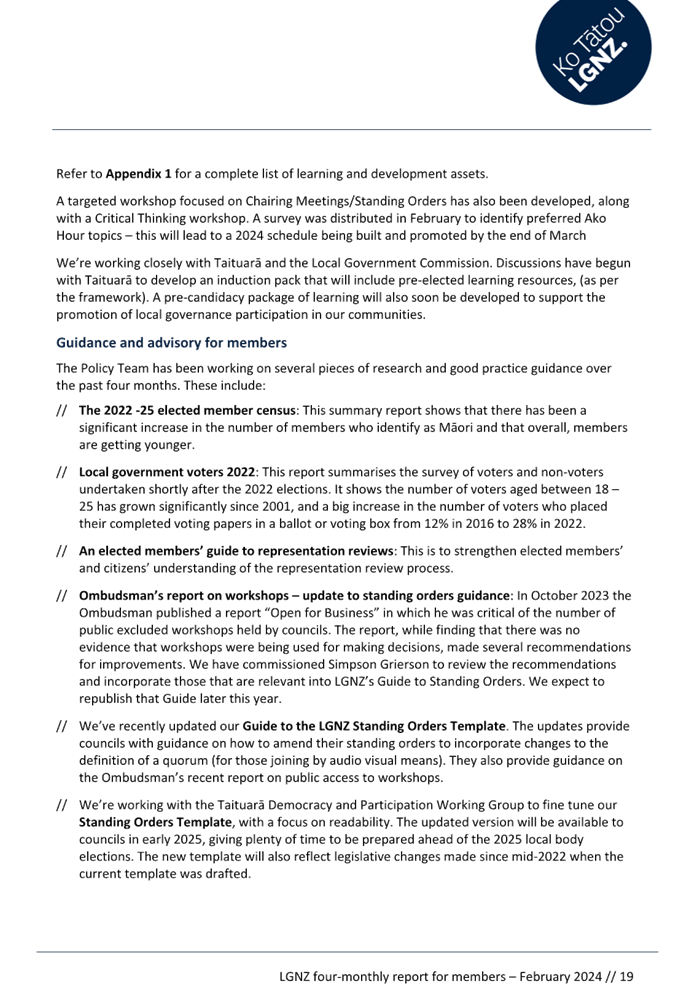
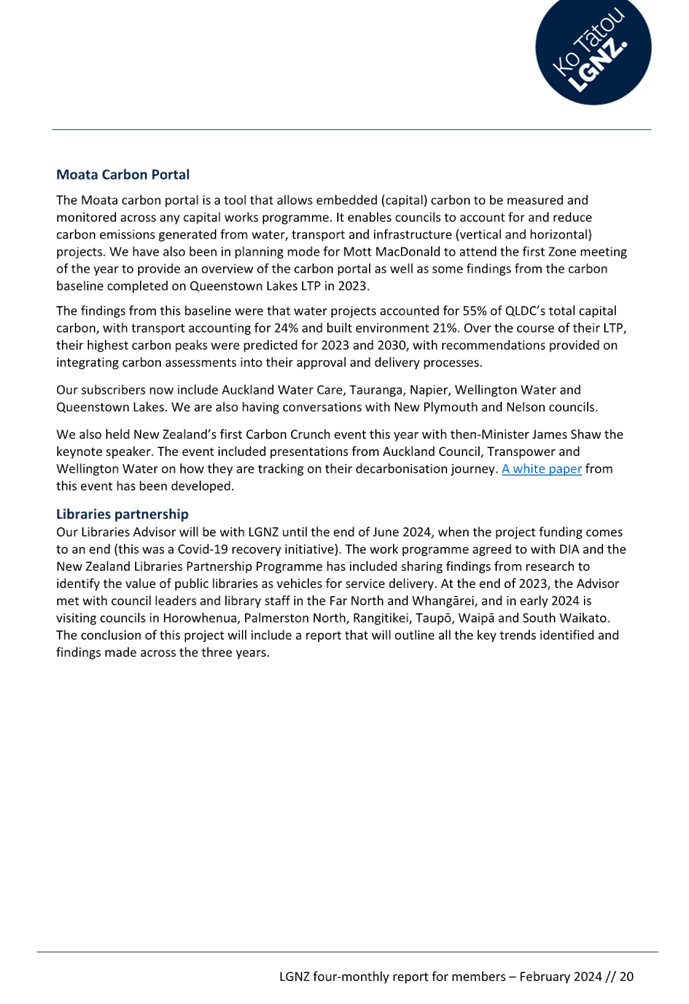
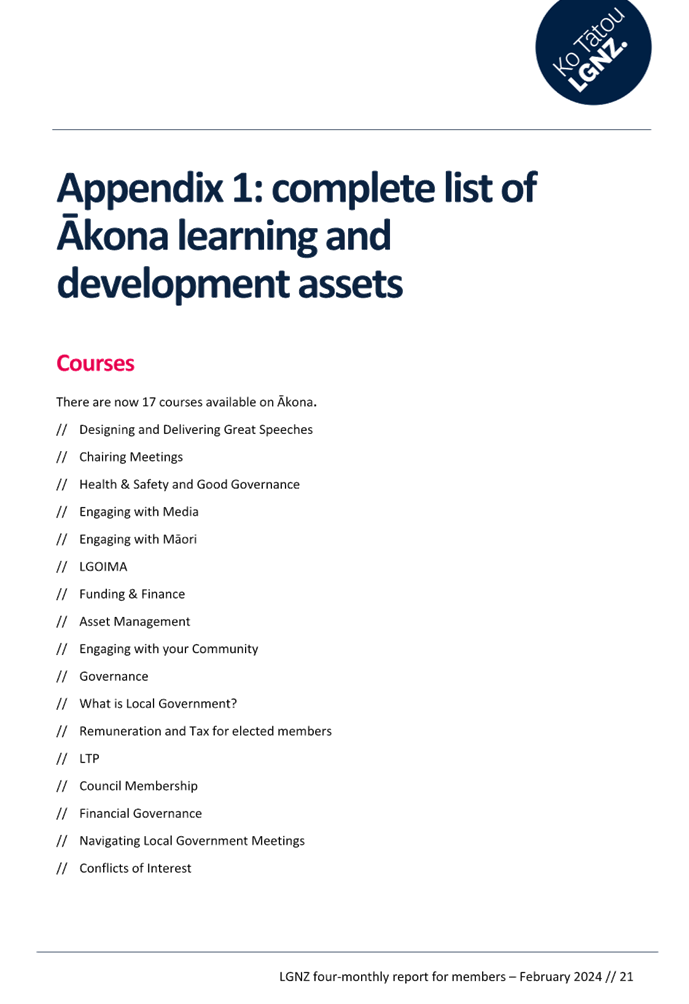
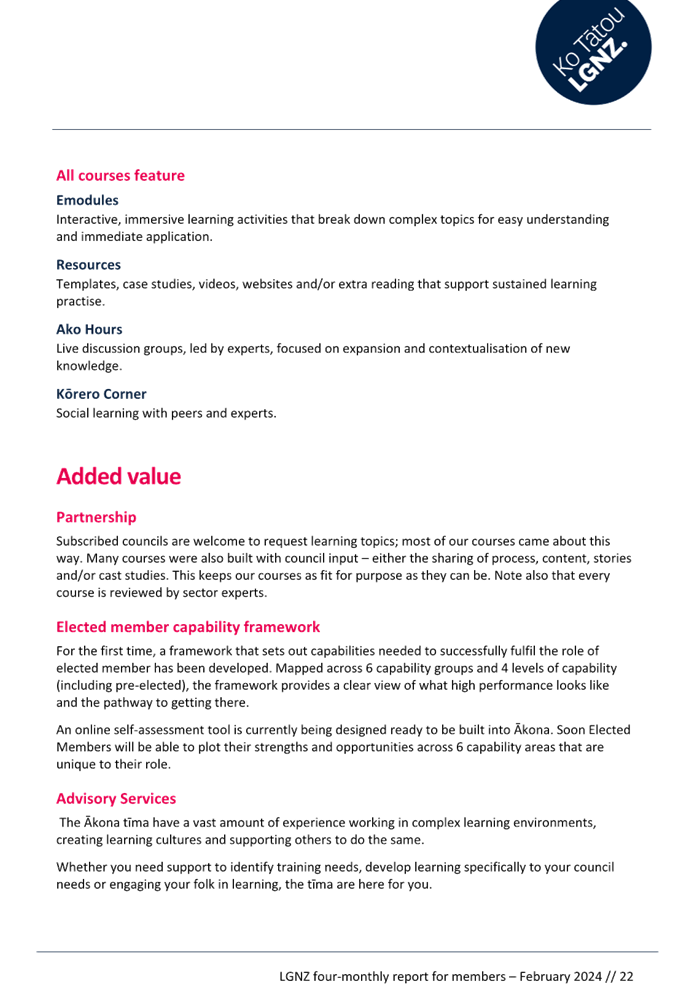

Tasman District Council Agenda – 28 March 2024
8 CONFIDENTIAL SESSION
8.1 Procedural
motion to exclude the public
The following
motion is submitted for consideration:
That the
public be excluded from the following part(s) of the proceedings of this
meeting. The general subject of each matter to be considered while the public
is excluded, the reason for passing this resolution in relation to each matter,
and the specific grounds under section 48(1) of the Local Government Official
Information and Meetings Act 1987 for the passing of this resolution follows.
This resolution is made in reliance on section 48(1)(a) of the Local
Government Official Information and Meetings Act 1987 and the particular
interest or interests protected by section 6 or section 7 of that Act which
would be prejudiced by the holding of the whole or relevant part of the
proceedings of the meeting in public, as follows:
8.2 Strategic Property Purchase for Reserve
|
Reason for passing this resolution in
relation to each matter
|
Particular interest(s) protected (where
applicable)
|
Ground(s) under section 48(1) for the
passing of this resolution
|
|
The public conduct of the part of the
meeting would be likely to result in the disclosure of information for which
good reason for withholding exists under section 7.
|
s7(2)(i) - The withholding of the
information is necessary to enable the local authority to carry on, without
prejudice or disadvantage, negotiations (including commercial and industrial
negotiations).
|
s48(1)(a)
The public conduct of the part of the
meeting would be likely to result in the disclosure of information for which
good reason for withholding exists under section 7.
|































